I like that Russian thing.
You are using an out of date browser. It may not display this or other websites correctly.
You should upgrade or use an alternative browser.
You should upgrade or use an alternative browser.
Custom Motorcycle Builds
- Thread starter DaveM
- Start date

Help Support Triumph Motorcycle Forum:
This site may earn a commission from merchant affiliate
links, including eBay, Amazon, and others.
Molto Veloce: A Monster S4RS built for a retired racer

The custom scene in Brazil doesn’t get much recognition on a global scale, which is surprising. Last year, a whopping 900,000 bikes were sold in South America’s largest country, mostly by Honda—which has over 75% of the market.
So when this Monster S4RS popped up we thought, ‘Finalmente!’ It comes from a Ducati specialist called SR Corse, based in Vila Madalena—the arts center of São Paulo. And it looks like one helluva ride.

“Since 2016 we’ve been building custom bikes, mostly Ducati,” says SR’s Rafael Pacheco. “We enjoy building vintage or ‘minimalist’ looking motorcycles that are also fun to ride.”
The ‘SR’ in the company name comes from supermoto racer (and accomplished race mechanic) Sebastian Rochon. The expat Uruguayan started SR Corse 12 years ago, and the business is now a leading independent Ducati specialist.
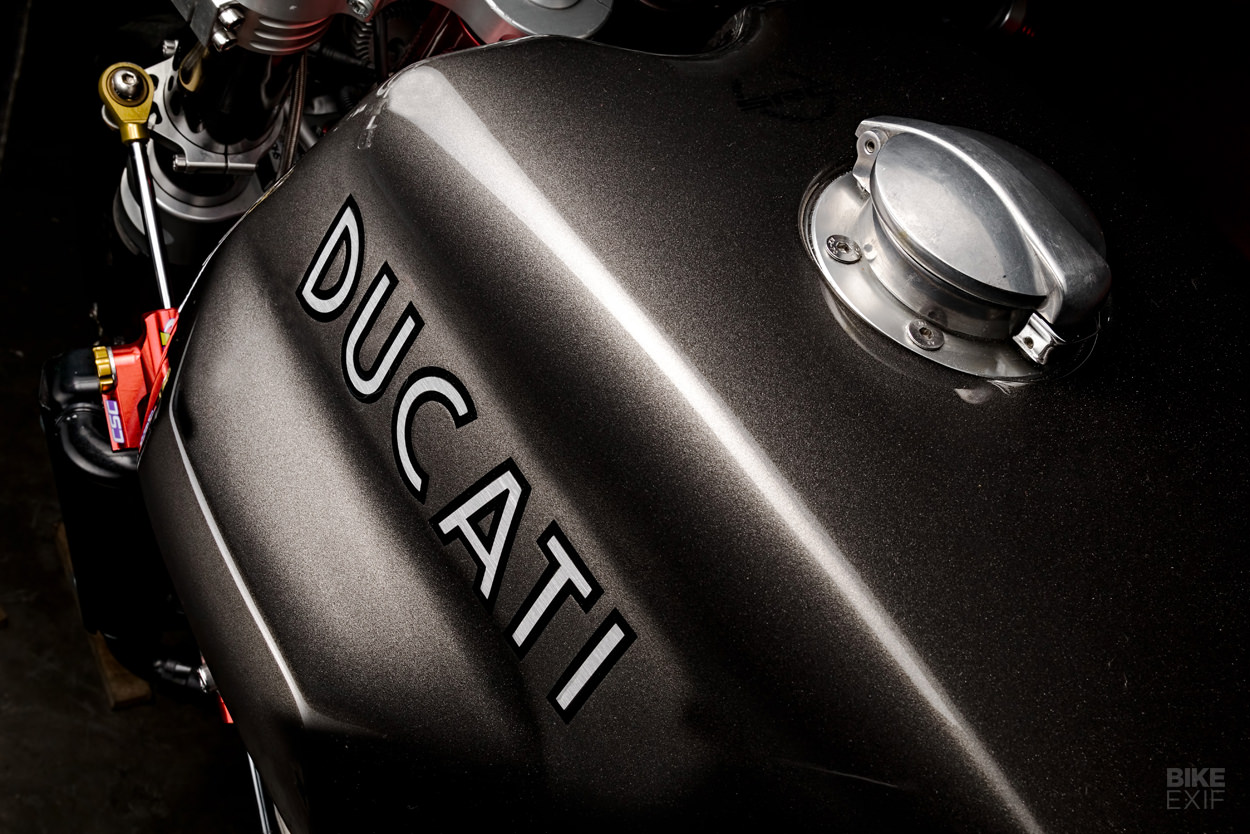
The Monster commission came from a client called Cayto, a long-time customer who got to know SR from their involvement in racing. “Cayto is not racing any more, but he keeps an interest in riding fast machines,” says Rafael.
And the S4RS is indeed fast: the 998cc ‘Testastretta’ L-twin pumps out a stonking 130 hp, and dry weight is just 177 kilos (390 lbs).
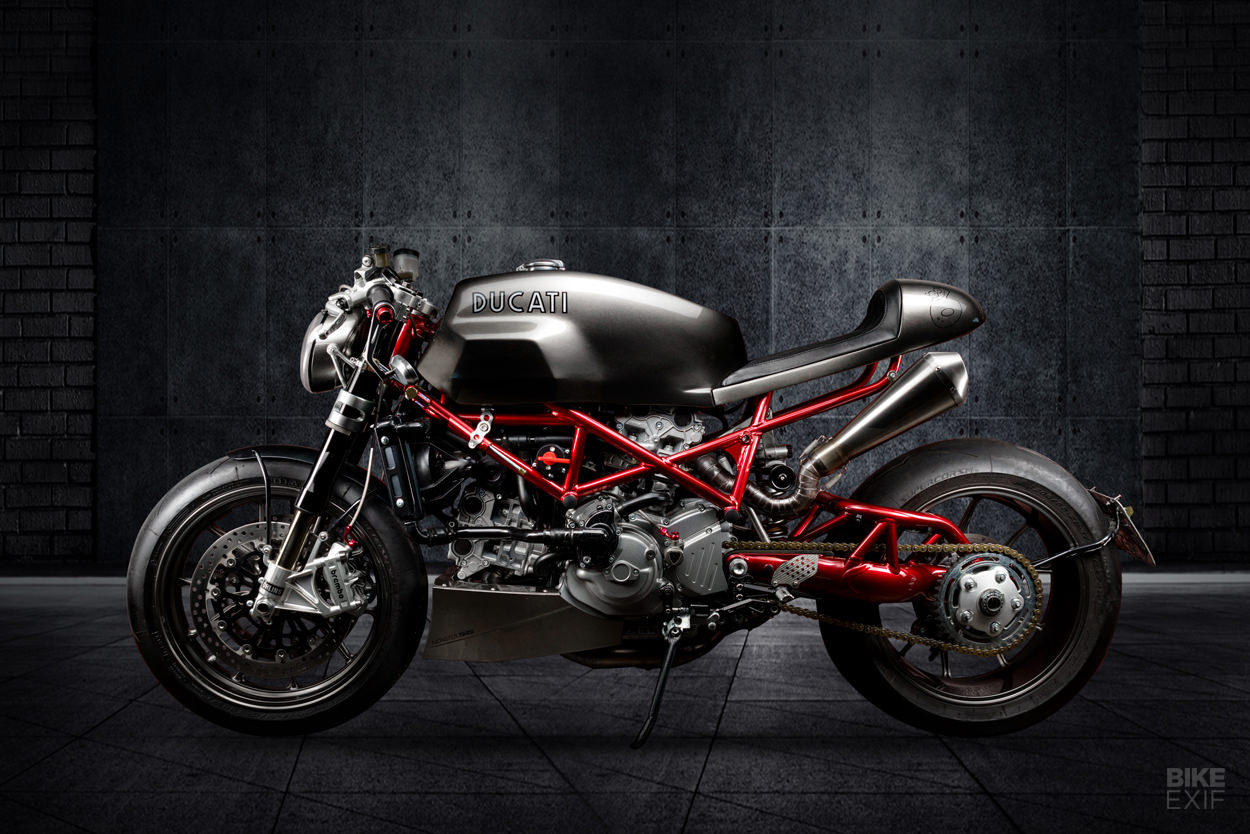
About two years ago, Cayto asked SR to build him a cafe racer. He had in mind a classic-looking cafe based on a Ducati Monster—capable of going fast, like a racer.
SR picked out a 2007 Monster S4RS for the project. “In our opinion, it’s one of the coolest Monsters ever made,” says Rafael. “There’s the trellis frame, superbike engine, Öhlins suspension, Marchesini wheels, and so on … a perfect fit for Cayto.”
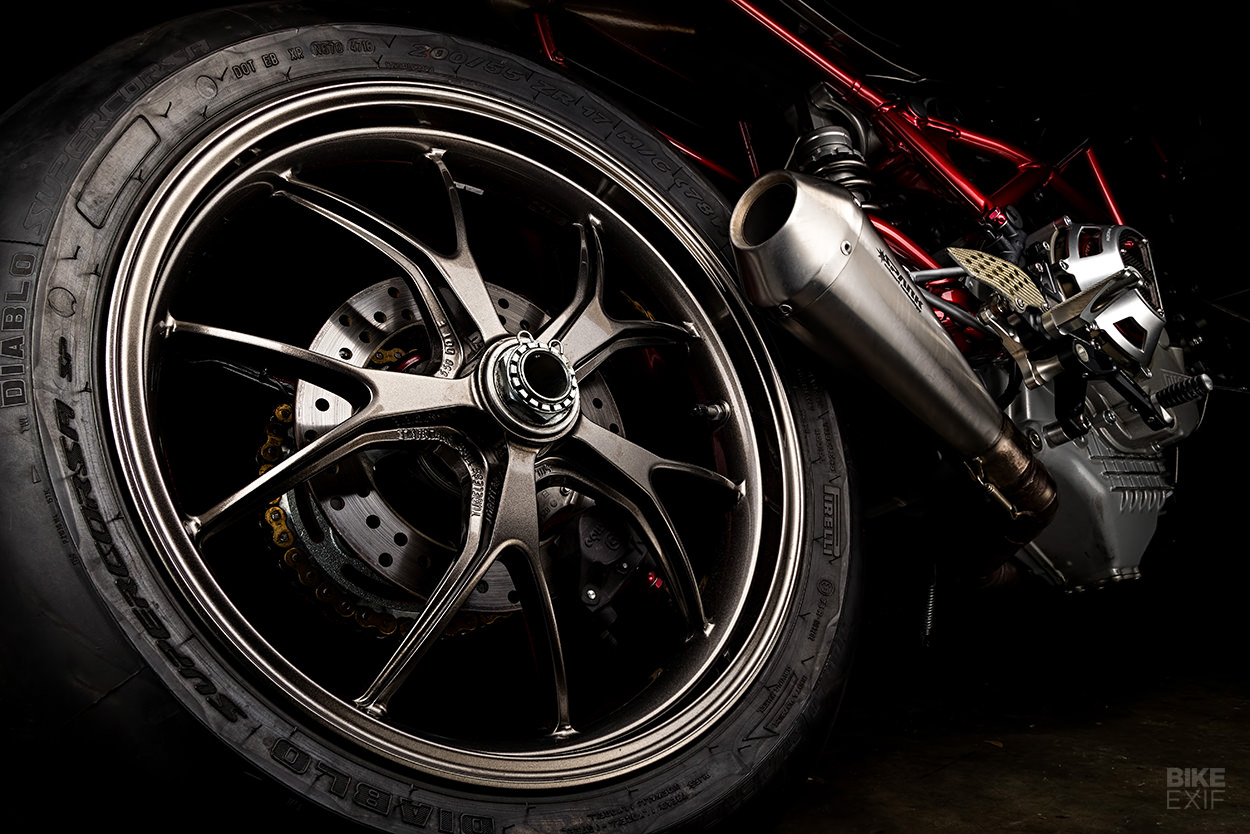
SR’s goal was to build a good-looking bike with vintage lines, but modern features and paint. The biggest visual change is the custom bodywork, with in-house fabricator and painter Milton Moretão helping Sebastian and Rafael get the right effect.
The fiberglass tank is based on the SportClassic design, but the tail unit is beaten out of aluminum. It sits on a custom subframe that hides the new lithium battery, and is topped off with a seat upholstered in leather and Alcantara.
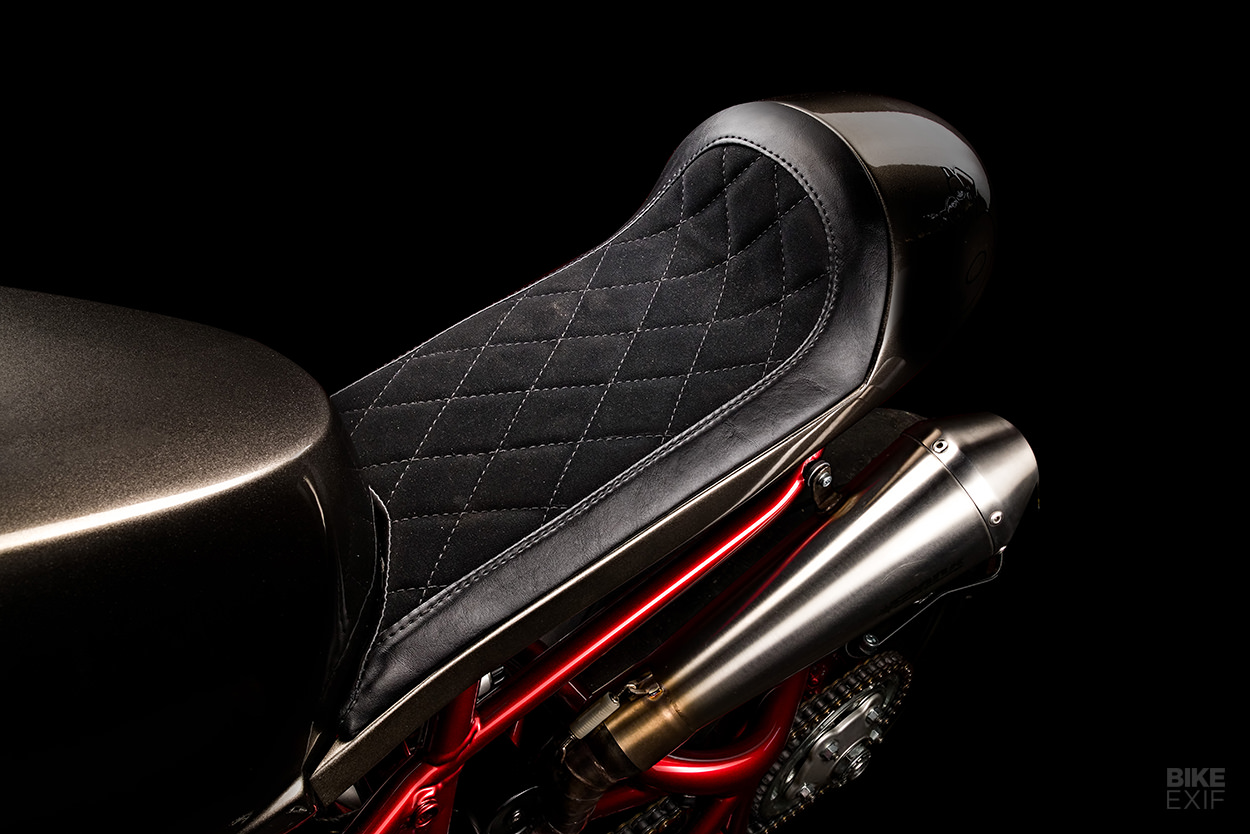
The S4RS had some of the best Öhlins kit offered on a production motorcycle, so SR Corse have left the suspension alone and just added a custom machined aluminum upper clamp, a Hyperpro steering damper and clip-ons. The starter button is now in the steering head nut.
They’ve paid attention to the engine though, giving it a full rebuild, and upgraded the drivetrain with a race-spec flywheel and a slipper clutch.
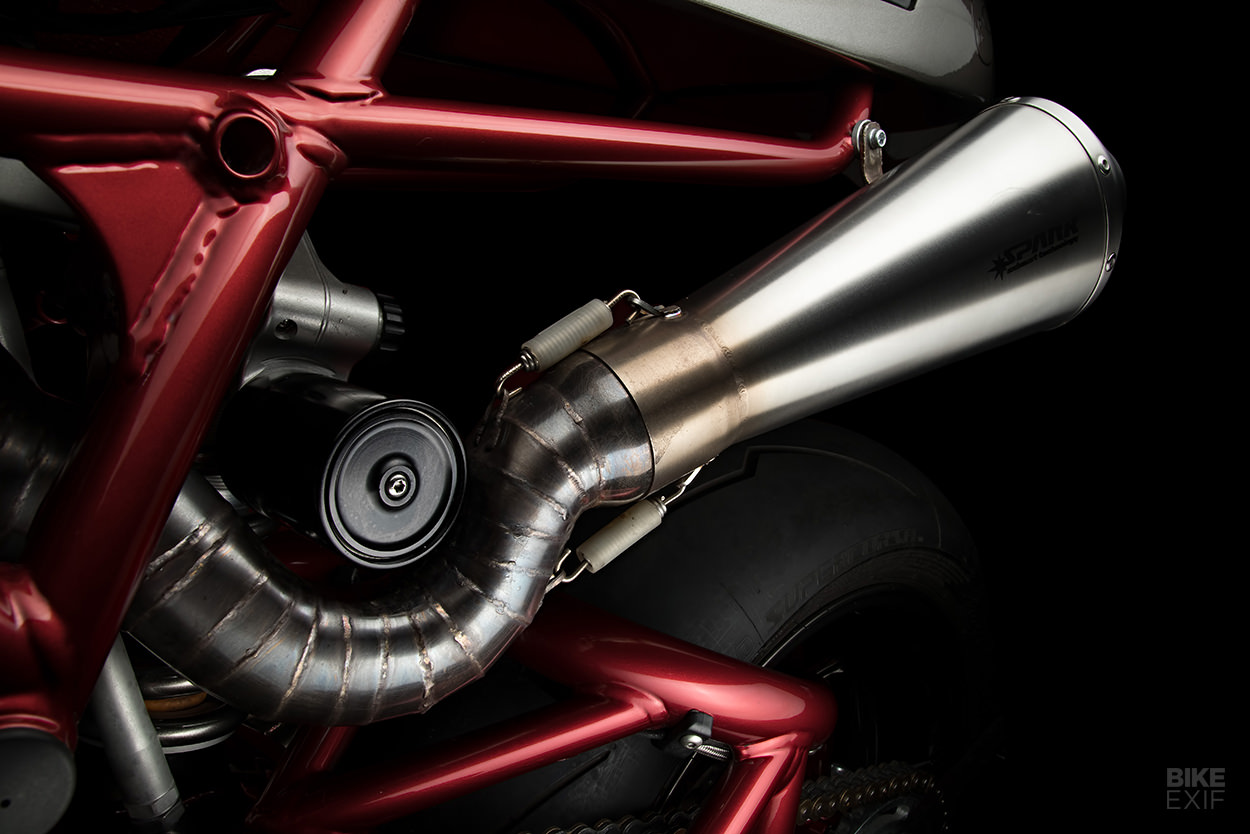
There’s a full custom 2-into-2 exhaust system too, terminated with stainless steel megaphone mufflers from Spark, which weigh just one kilo each. Fueling is now optimized by a MicroTech ECU for an added power boost.
The kill switch has been repositioned to underneath the tank, on a 3D-printed mount, and wired into a brand new electrical loom. This sends power to a new dash, switchgear and mo.unit control box from Motogadget.
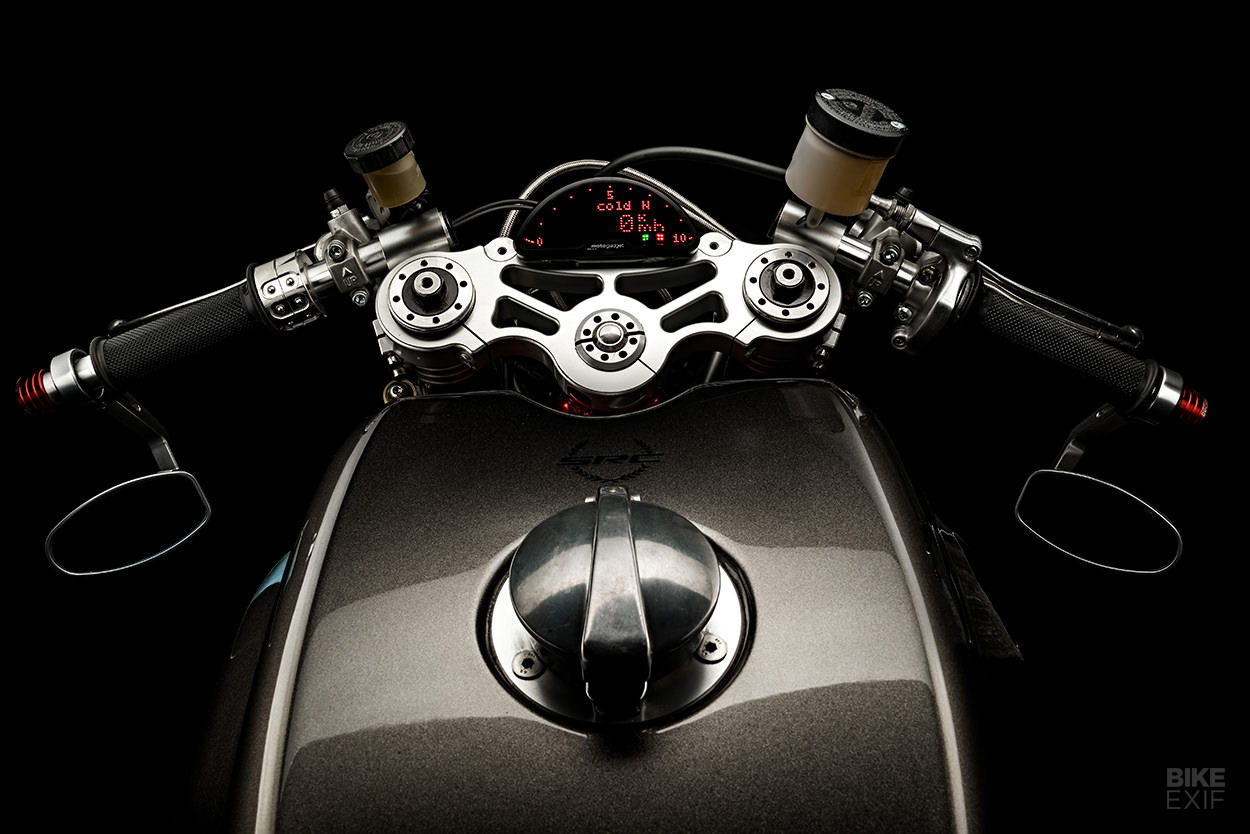
After installing new LED lighting, and swapping out as many plastic parts as possible for aluminum, SR Corse painted up the new bodywork in a cool metallic grey. It’s a subdued color that allows the trellis frame to steal the limelight—now refinished in a lustrous Candy Red.
Despite being a very 21st century build, this S4RS stays close to the original ethos of the café racer. We bet it’s as invigorating as an ice-cold caipirinha to ride.
SR Corse | Facebook | Instagram | Images by André Santos Fotografia Automotiva
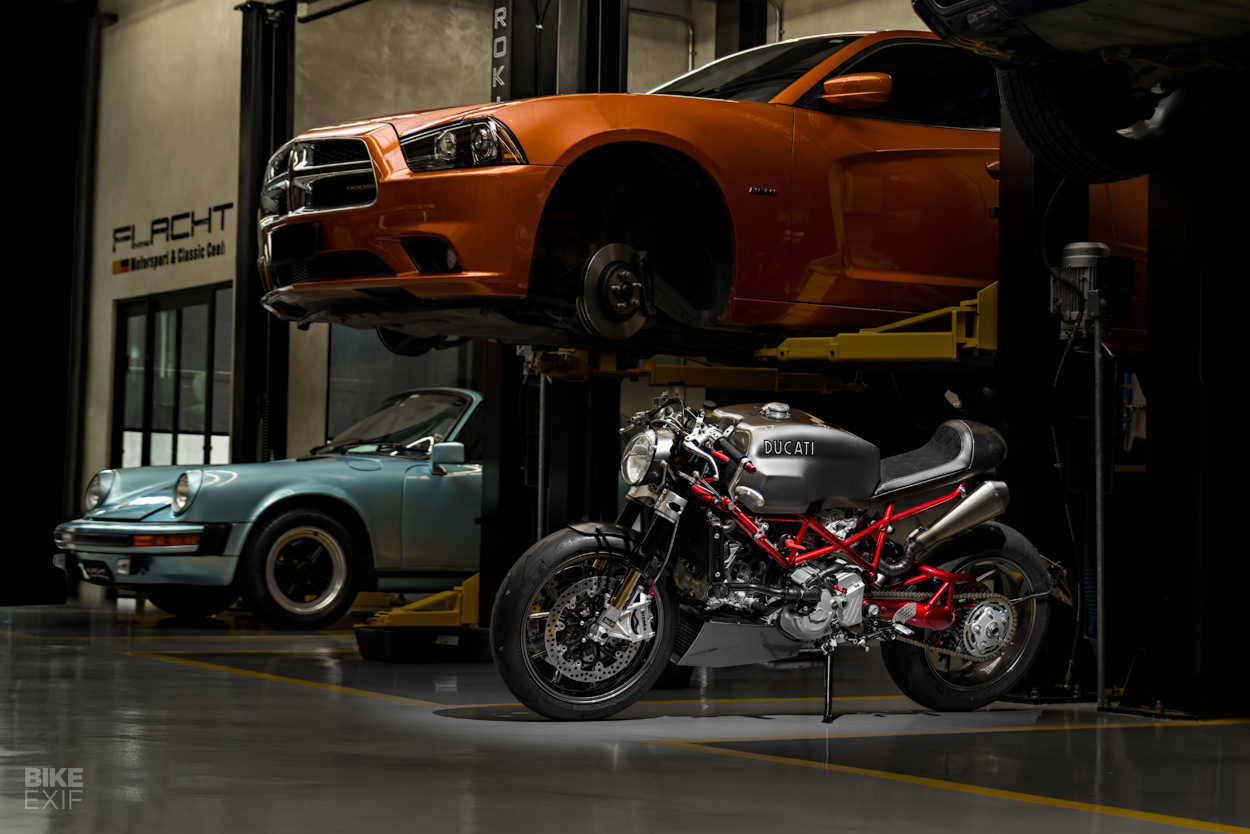
Continue reading...

The custom scene in Brazil doesn’t get much recognition on a global scale, which is surprising. Last year, a whopping 900,000 bikes were sold in South America’s largest country, mostly by Honda—which has over 75% of the market.
So when this Monster S4RS popped up we thought, ‘Finalmente!’ It comes from a Ducati specialist called SR Corse, based in Vila Madalena—the arts center of São Paulo. And it looks like one helluva ride.

“Since 2016 we’ve been building custom bikes, mostly Ducati,” says SR’s Rafael Pacheco. “We enjoy building vintage or ‘minimalist’ looking motorcycles that are also fun to ride.”
The ‘SR’ in the company name comes from supermoto racer (and accomplished race mechanic) Sebastian Rochon. The expat Uruguayan started SR Corse 12 years ago, and the business is now a leading independent Ducati specialist.

The Monster commission came from a client called Cayto, a long-time customer who got to know SR from their involvement in racing. “Cayto is not racing any more, but he keeps an interest in riding fast machines,” says Rafael.
And the S4RS is indeed fast: the 998cc ‘Testastretta’ L-twin pumps out a stonking 130 hp, and dry weight is just 177 kilos (390 lbs).

About two years ago, Cayto asked SR to build him a cafe racer. He had in mind a classic-looking cafe based on a Ducati Monster—capable of going fast, like a racer.
SR picked out a 2007 Monster S4RS for the project. “In our opinion, it’s one of the coolest Monsters ever made,” says Rafael. “There’s the trellis frame, superbike engine, Öhlins suspension, Marchesini wheels, and so on … a perfect fit for Cayto.”

SR’s goal was to build a good-looking bike with vintage lines, but modern features and paint. The biggest visual change is the custom bodywork, with in-house fabricator and painter Milton Moretão helping Sebastian and Rafael get the right effect.
The fiberglass tank is based on the SportClassic design, but the tail unit is beaten out of aluminum. It sits on a custom subframe that hides the new lithium battery, and is topped off with a seat upholstered in leather and Alcantara.

The S4RS had some of the best Öhlins kit offered on a production motorcycle, so SR Corse have left the suspension alone and just added a custom machined aluminum upper clamp, a Hyperpro steering damper and clip-ons. The starter button is now in the steering head nut.
They’ve paid attention to the engine though, giving it a full rebuild, and upgraded the drivetrain with a race-spec flywheel and a slipper clutch.

There’s a full custom 2-into-2 exhaust system too, terminated with stainless steel megaphone mufflers from Spark, which weigh just one kilo each. Fueling is now optimized by a MicroTech ECU for an added power boost.
The kill switch has been repositioned to underneath the tank, on a 3D-printed mount, and wired into a brand new electrical loom. This sends power to a new dash, switchgear and mo.unit control box from Motogadget.

After installing new LED lighting, and swapping out as many plastic parts as possible for aluminum, SR Corse painted up the new bodywork in a cool metallic grey. It’s a subdued color that allows the trellis frame to steal the limelight—now refinished in a lustrous Candy Red.
Despite being a very 21st century build, this S4RS stays close to the original ethos of the café racer. We bet it’s as invigorating as an ice-cold caipirinha to ride.
SR Corse | Facebook | Instagram | Images by André Santos Fotografia Automotiva

Continue reading...
Review: Riding the new Harley-Davidson Pan America
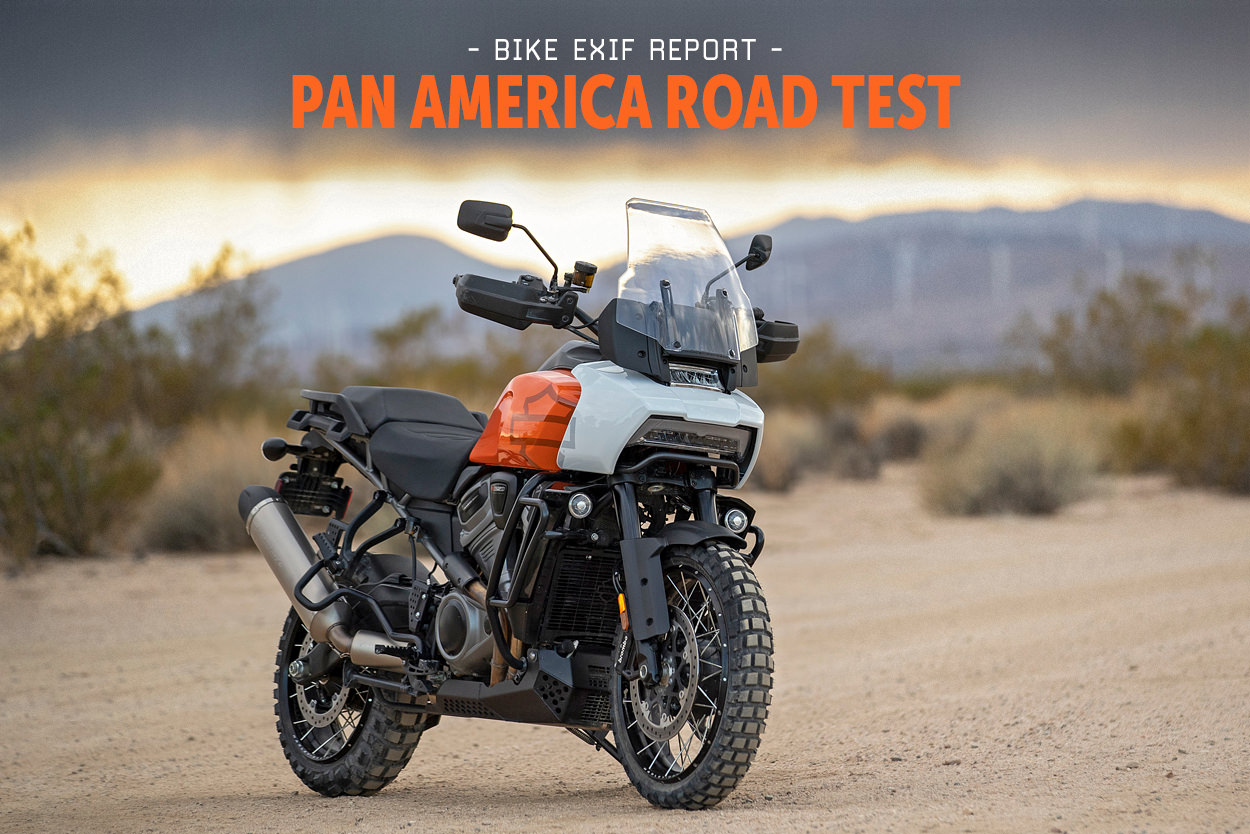
“I got to say, you’re looking older.”—Ellis
“I am older.”—Sheriff Ed Tom Bell
Amongst my Rushmore of cherished films, No Country For Old Men anoints the viewer with myriad lyrical gems and witticisms.
The above exchange percolated to the front when, not five minutes into my arrival at Harley-Davidson’s press launch of their new Pan America 1250, an affable employee offered two-inch “Tall Risers” and a “Tallboy” seat.
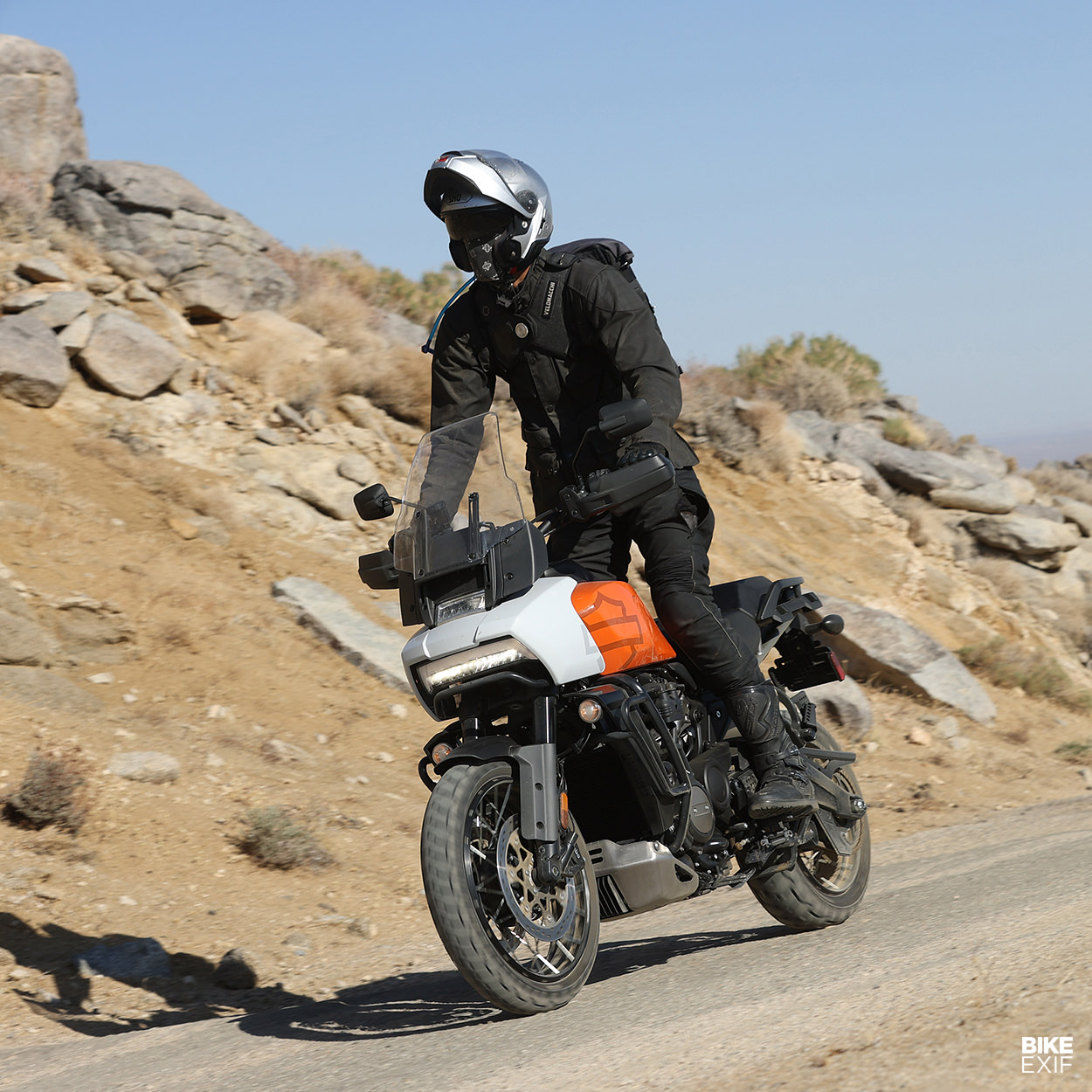
At 6’6” and having worked on the OEM side for numerous bike launches, this was a welcomed first. But this is Harley-Davidson, after all. They pitch a big tent. If you’re seven feet tall, they will find a way.
On this day, I was at RawHyde Adventures in Castaic, California, an hour north of Los Angeles and amidst the Mojave Desert. Over the next 48 hours, I would ride hundreds of miles through varied terrain and topography atop the 2021 Harley-Davidson Pan America Special—Milwaukee’s 150 horsepower, 92 ft/lbs torque, 559 pound (wet) and 100-percent beakless adventure-touring machine.
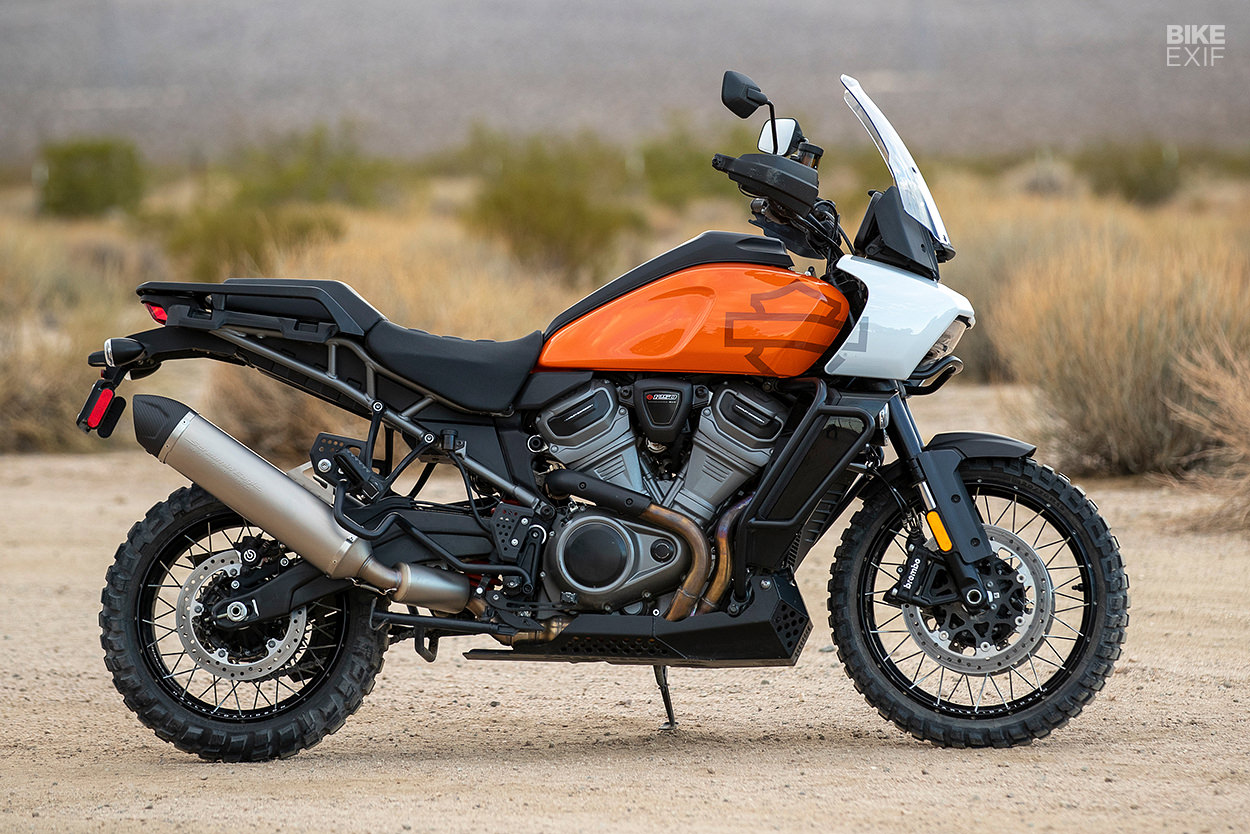
Arriving in dealerships this May, Harley will offer a base-model Pan America 1250 for $17,319 and a Pan America 1250 Special for $19,999.
In short, and with apologies to our friends from across the pond, it is the real deal.
We all know Harley’s challenge, so I won’t spend too many words dissecting it. They print money but their ridership has crested the hill. With new-ish CEO Jochen Zeitz canning the old-guard’s “More Roads to Harley” initiative and introducing the “Rewire” and “Hardwire” strategies, there is a definitive vision—but is it the right one?
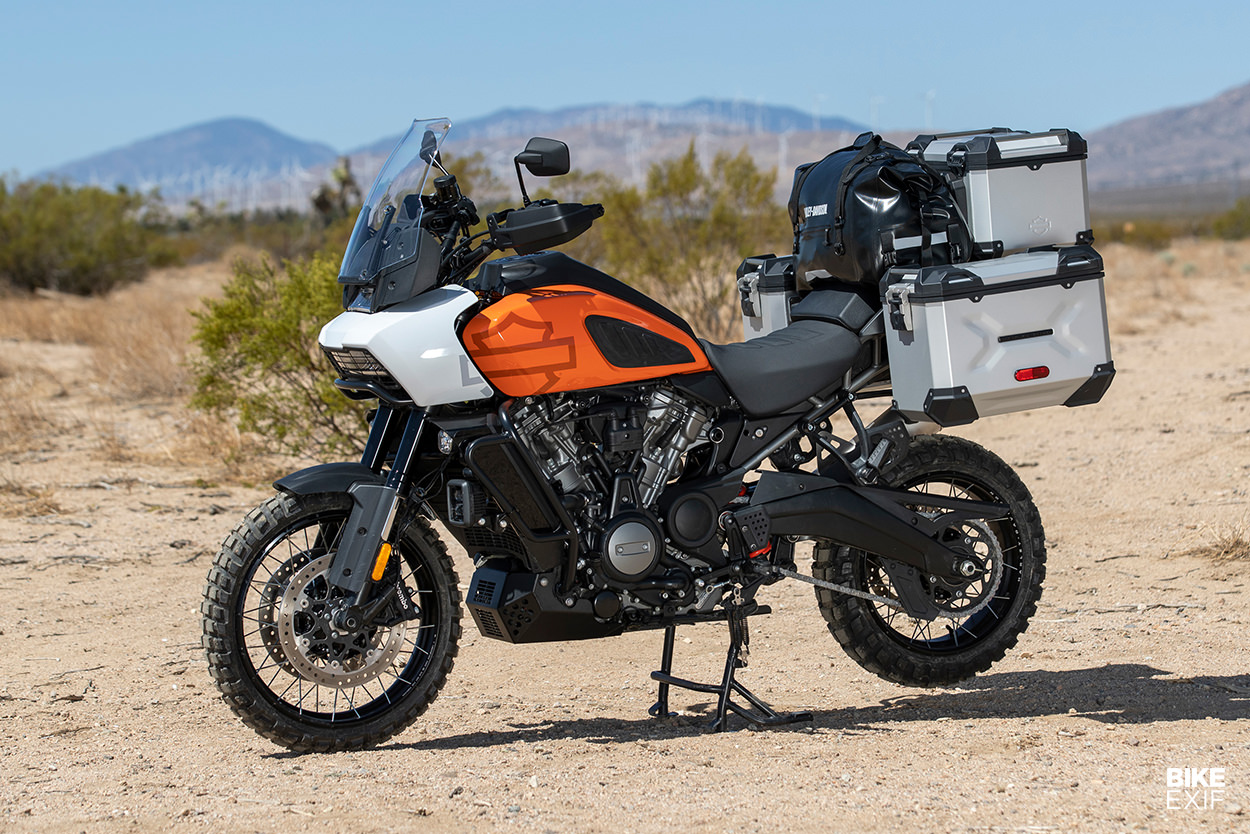
Reading tea leaves isn’t amongst my skillset. All I know is that the perhaps-axed Bronx streetfighter looked a brilliant choice to cultivate dollars from Millennials and unders.
Nevertheless, today we’re focusing on Harley’s foray into the ADV market. If you’d like some homework, feel free to dive into the Pan America’s alphabet soup of IMU, C-ELB ABS, C-TCS, DSCS, HHC, RLM, and TPMS.
Essentially, this bike has all the electrical nannies, protections, and components one would expect on a $20,000 motorcycle aiming to compete with Bavaria’s finest. Not to diminish the meticulous development of the machine, but it’s the least any discerning customer should expect.
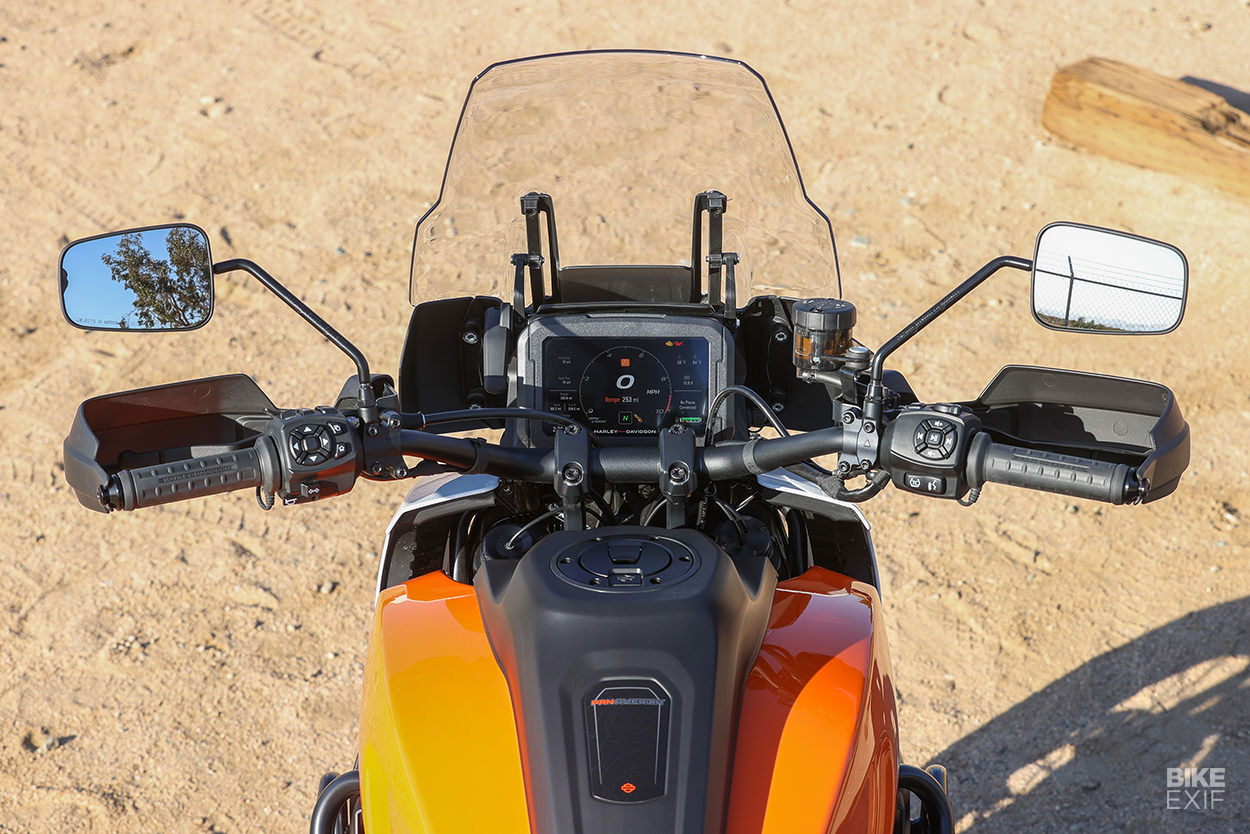
Another acronym, ARH or Adaptive Ride Height, does pique interest. A $1,000 option available only on the Special, it works with the semi-active Showa suspension (featuring 190mm/7.48 inches of front and rear suspension travel) to lower seat height by one to two inches (depending on rear pre-load) when the bike is stopped.
When the Special gets moving, ARH does its thing and returns the bike to optimal ride height. There’s a lot more there, such as Short and Long Delay modes, but credit where it’s due: the system works imperceptibly and as advertised.
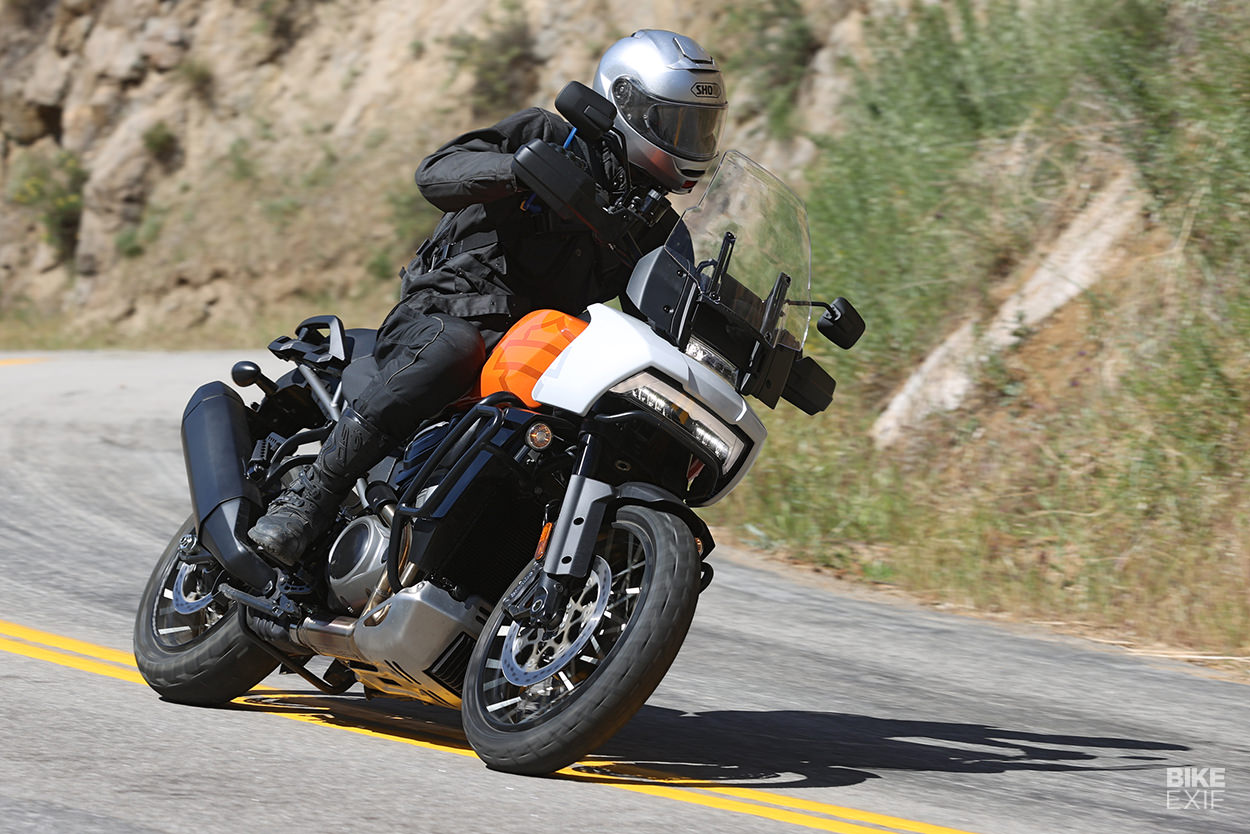
Human giraffe that I am, flatfooting is rarely an issue, even on the tallest of dirt bikes. For the vast majority of riders though, especially when perched on tenuous off-road ground, it’s a definite benefit.
FYI: the Pan America 1250 model features passive front and rear Showa suspension, retains the same suspension travel, but does not offer the Special’s five pre-programmed suspension modes.
The all-new liquid cooled 1250cc V-Twin engine, called the Revolution Max, is a central member of the chassis and thoroughly modern. It has double overhead camshafts, variable valve timing, reaches a peak 9500 rpm, and complies with Euro 5.
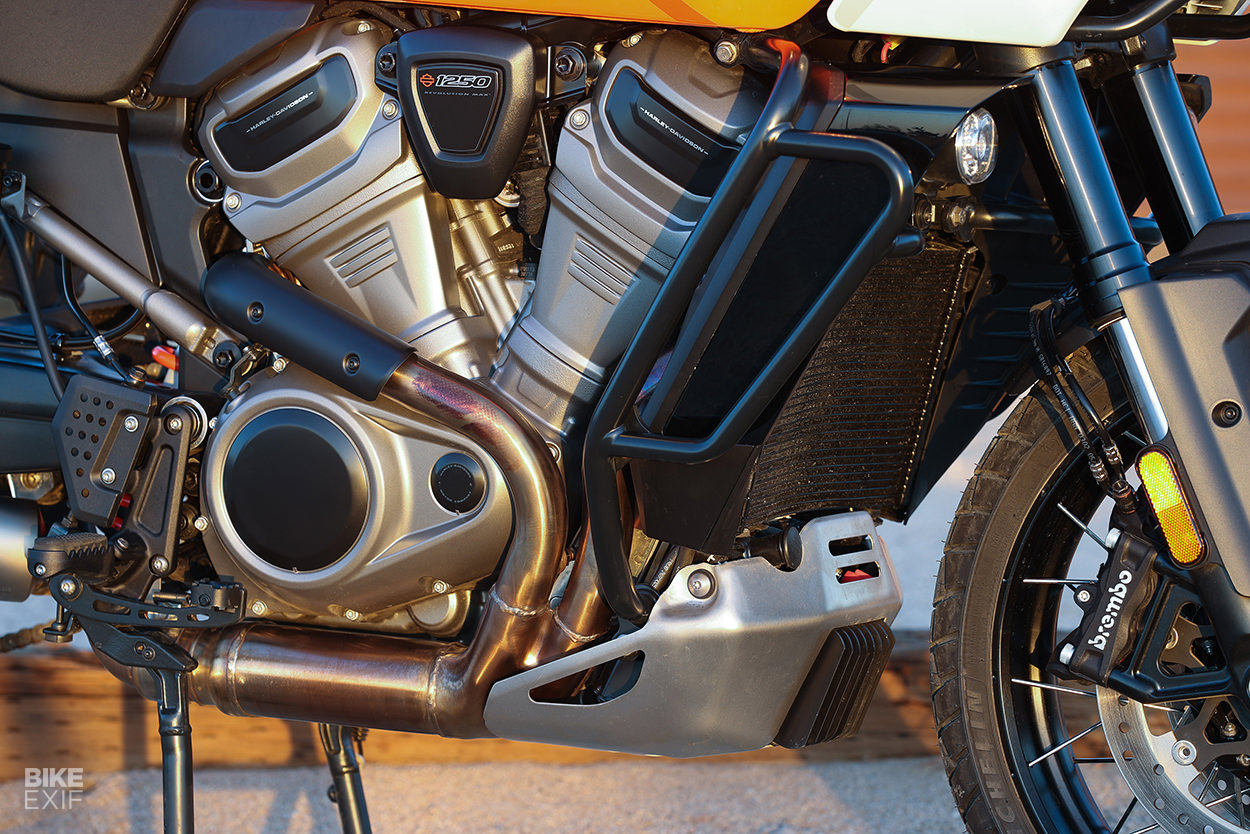
In the Mojave, engine or exhaust heat was never an issue. While operating best on 91 octane, it can run on lower octane—though with sacrifices to power and the EPA-confirmed 46 mpg fuel efficiency.
A chain, rather than belt, commands the final drive. The rider manipulates the six-speed transmission with a slipper clutch designed to smooth downshifts and prevent rear wheel slip or hop.
Both Pan America models hit the ground with a 19- and 17-inch front/rear wheel combination. Michelin Scorcher Adventure tires and cast aluminum wheels are stock, but Michelin Anakee Wild tires and off-road-friendly laced wheels (the latter, $500) are options on each bike.
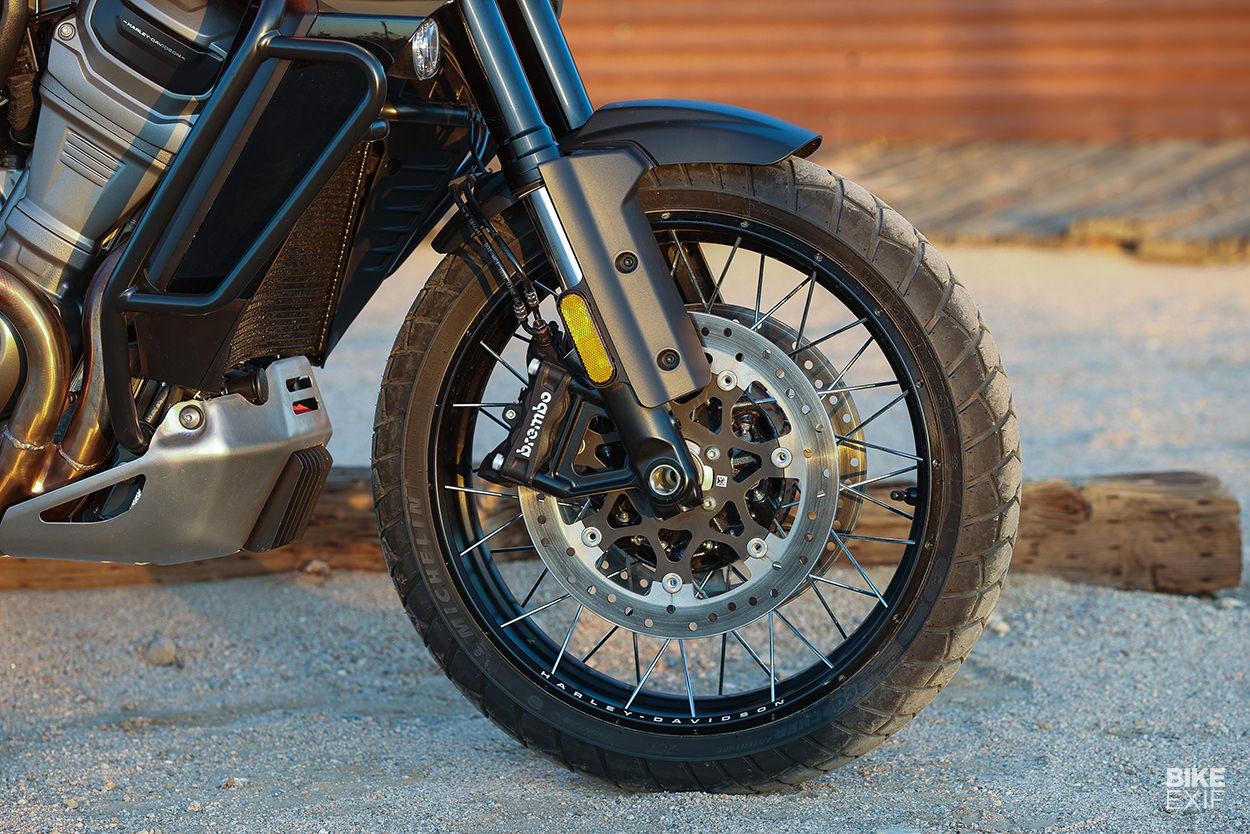
Most adventure rides involve pounding some pavement, and here the Pan America 1250 Special excels. Throttling to 5,000 or so rpm, the engine is smooth, efficient, and with a pair of Hearos, quiet.
Amidst 50 mph wind gusts and through tricky 18-wheeler crosswinds, the Harley was unfazed. But as a mini Manute Bol, I could do with a much taller or much shorter windscreen. (Harley, of course, offers both.)
The 6.8-inch TFT touchscreen is a tad busy, surrounding a digital speedo and tach with quadrants of customizable widgets. Though the font could be larger, even with my supposed 20/13 vision, sun glare did not exist.
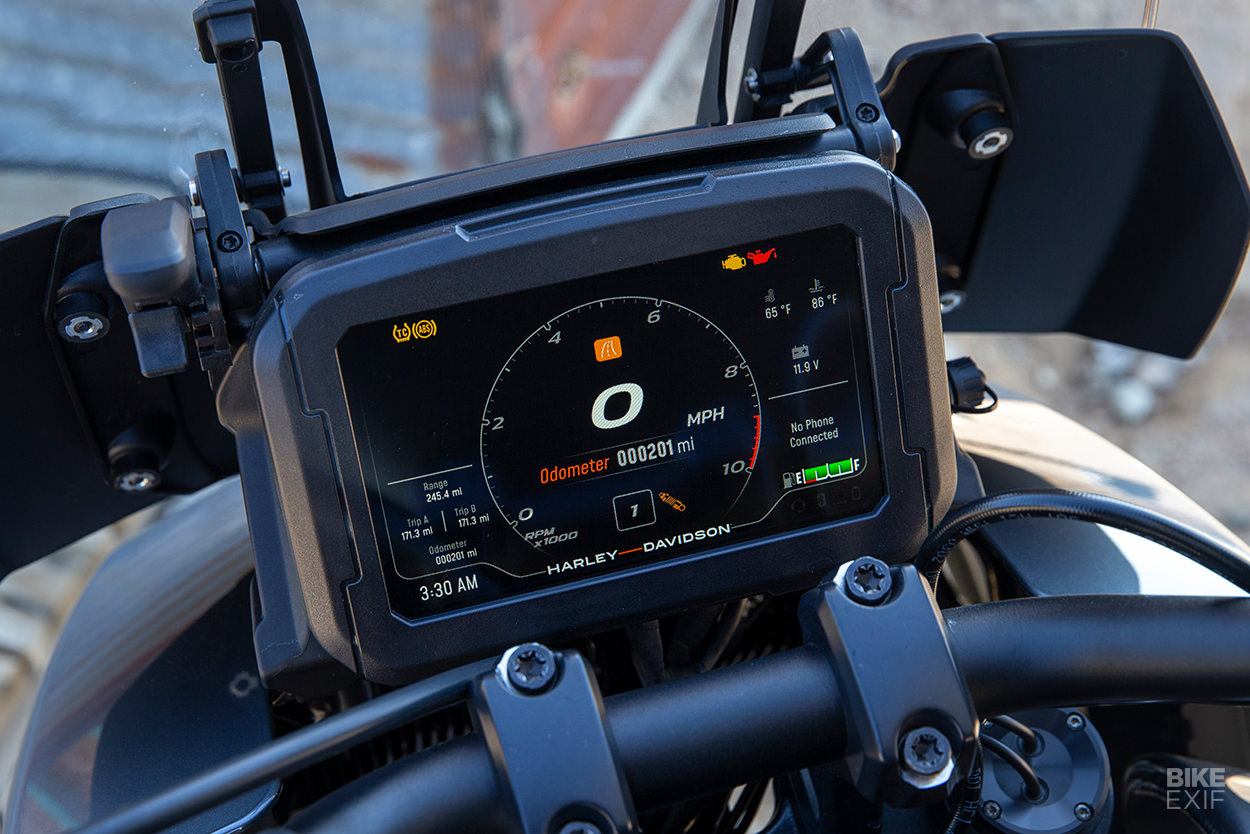
Phone pairing was simple enough. Download the Harley app (Android or iOS), click a few buttons, and voilà. In tandem with a Bluetooth headset, phone and music functions are controlled with a flick of the left thumb underway, as well as on the touchscreen, albeit when stationary.
I appreciated the screen’s ability to show a full screen of navigation, or display turn-by-turn on one of the aforementioned widgets. It wasn’t Google Maps or Waze, but it did the job.
We didn’t ride at night, but the time-tested Daymaker LED lighting and Advanced Daymaker Adaptive headlight (optional on the Standard) should do the trick. None of the above should surprise. Harley gon’ Harley.
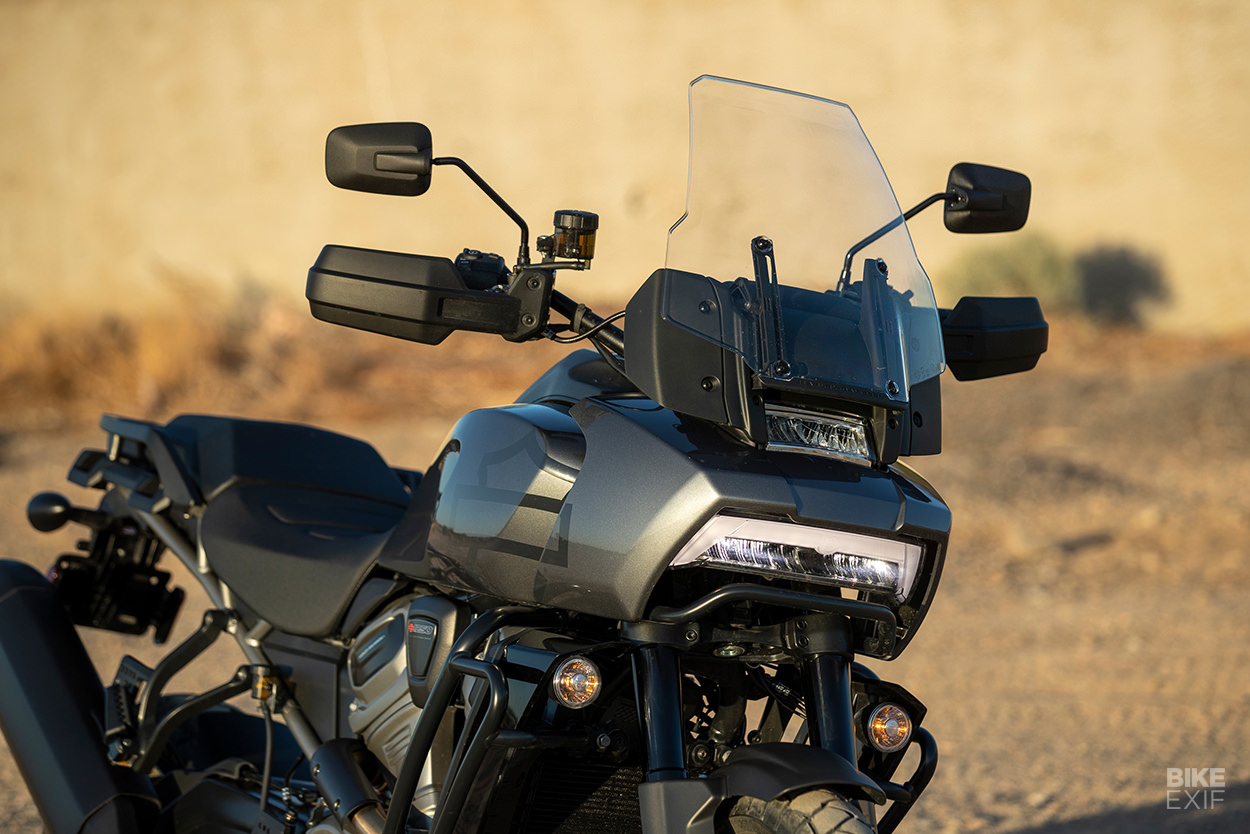
The big ‘Murican more than held its own when things got twisty and dynamic. Above 5,000 rpm, the engine awakens with a lovely combination of sound and feel, amplified by the accessory Screamin’ Eagle exhaust, which also saves six pounds. As one Harley engineer declared, they kept none of the bad vibrations and all of the good.
The engine revs freely and never wants for power, though tall-ish gearing hides a bit of the torque from the rider’s grasp. The on-road portion of our test did not faze the Scorcher Adventures, nor did the stock tires fall apart when we explored a bit off-road. Hard pack, gravel, and soft sand weren’t issues. There was plenty of range left in the 5.3-gallon tank.
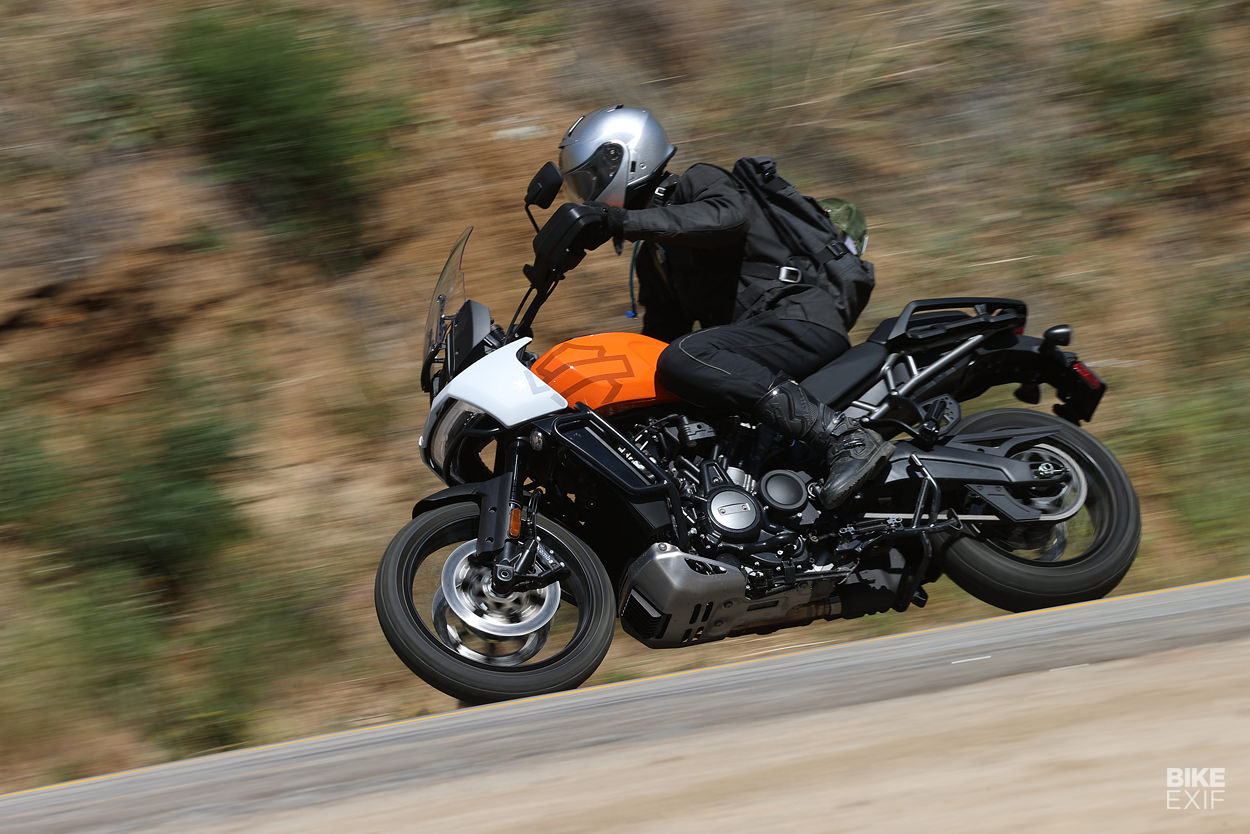
Ergonomically, the knee bend for my freakish self was a bit tight despite the Tallboy seat being placed in the tall setting. (Regardless of stock, Tallboy or Reach seat choice, the Pan America features high and low seat positions—giving or taking an inch).
My right wrist did protest after our on-road day. Perhaps the risers were a bit too tall, or perhaps it was the rake/angle of the bars themselves. I kept thinking how a rally-style seat would alleviate some of the trouble, as my ability to scoot back and forth was limited by the passenger seat.
It took the full two days to conform to the electronic turn signals, which depart from a century of precedent. Instead of that satisfying center click to cancel, any additional click, regardless of which way, cancels. Many a rider suffered from a rogue indicator. Cue Abe Simpson shaking his fist at the cloud.
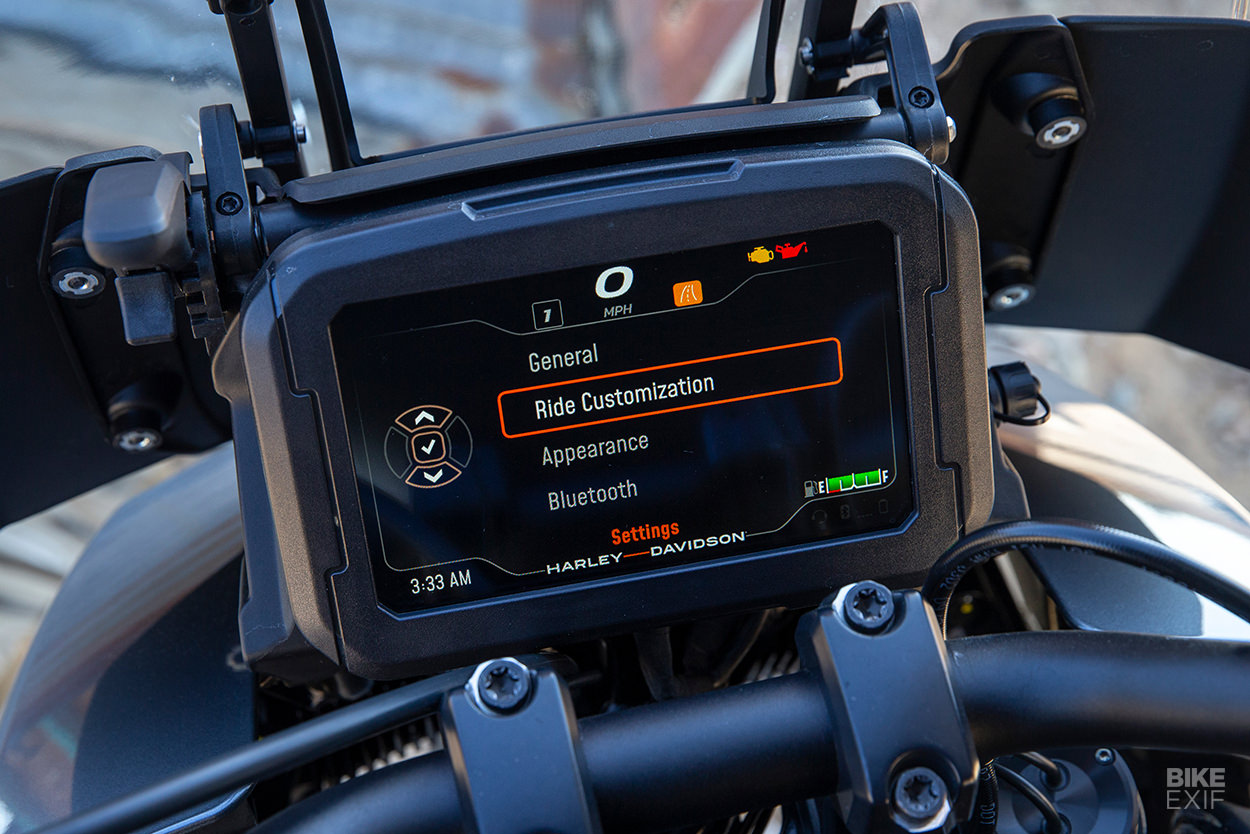
The Pan America offers five pre-programmed riding modes: Rain, Road, Sport, Off-Road, and Off-Road Plus. The Special adds three customizable modes, and the Standard model one. In keeping with the competition, they allow the rider to tinker.
If you’re familiar with any modern-day adventure bike, you’ll know how this works. The modes are as advertised. On-road, I generally stayed in Sport, which dialed back the nannies and allowed me to give the bike the beans in relative safety. At a high-level, Road is to Sport as Off-Road is to Off-Road Plus. Here, Harley got it right.
On to the proverbial elephant…
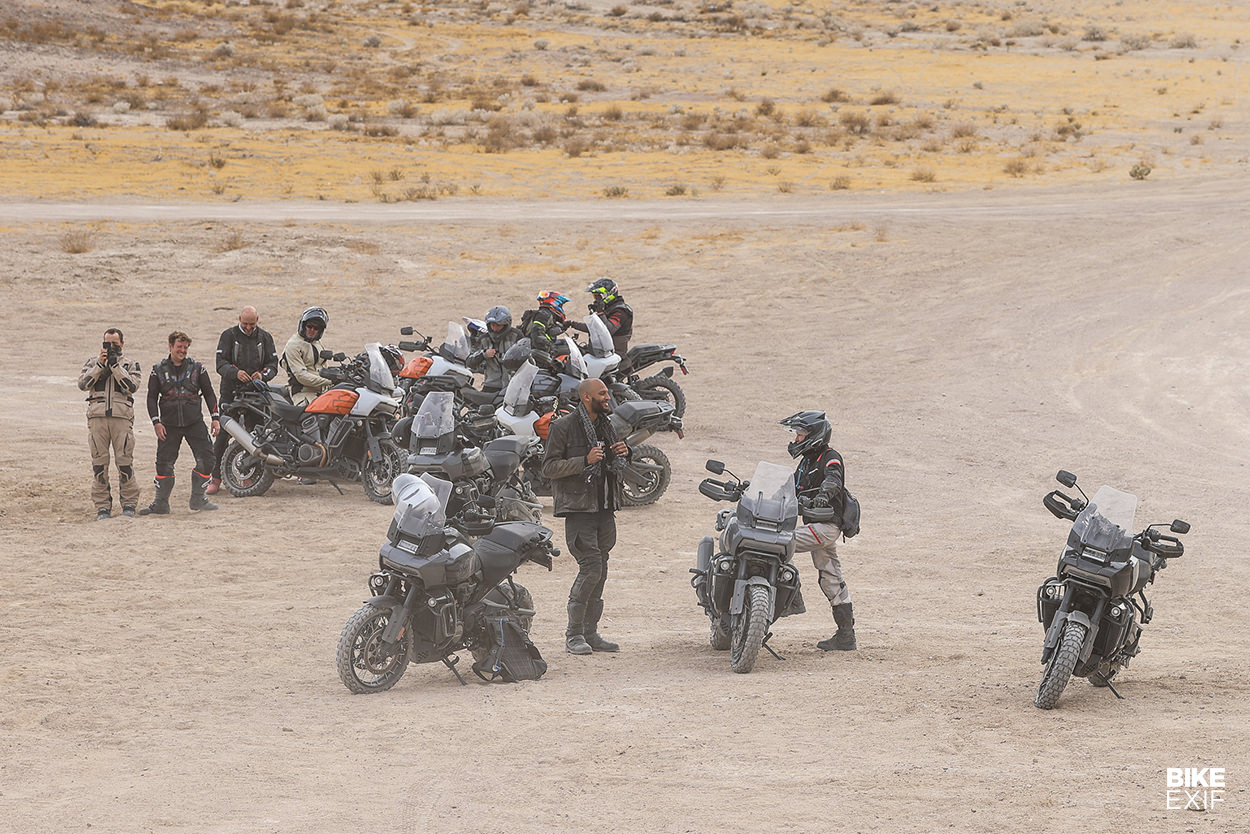
Our focus for the second day was off-road. I have a decent amount of experience, from the red clay of Georgia to the deserts of Southern California, Nevada, and even Morocco.
Still, I would not call myself anything but a dude trying not to bust his ass. I tend to impede the bike, rather than the other way around. In a lot of ways, I represent a segment of rider Harley is targeting with the Pan America.
Equipped with a used set of Anakee Wilds, we departed RawHyde at 9:45 am. Sweaty not from heat, but trepidation, I was in my own head. After a highway blast, on which the Anakees served just fine, we made the turn off-pavement and up I stood. I reminded myself of a piece of wisdom bestowed by Jim Hyde, RawHyde’s founder: How often do you have the chance to be nervous?
No problem there, Big Jim!
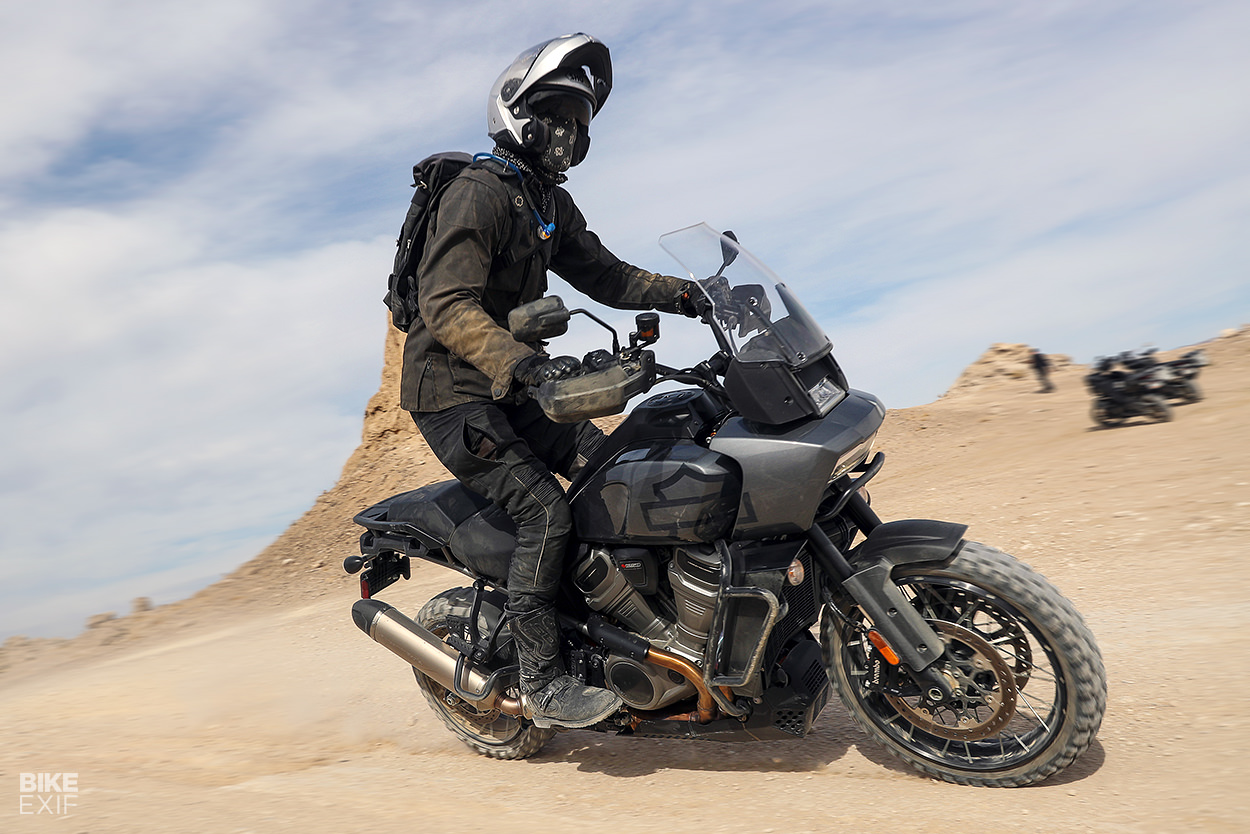
And off we went. Generally, second gear and Off-Road Plus mode were my tactics. I spent the early stages building up confidence in myself, rather than confidence in the bike. Not so deep down, I knew the bike could handle everything we would experience on this day. With the knowledge that over a million miles of development was split 50/50 on- and off-road, I was beginning to feel good.
I was getting out of my own way until I forgot a basic tenet of navigating the sand: keep your speed up! Instead, when I saw it my bowels clenched, I eased off the throttle, and down I went.
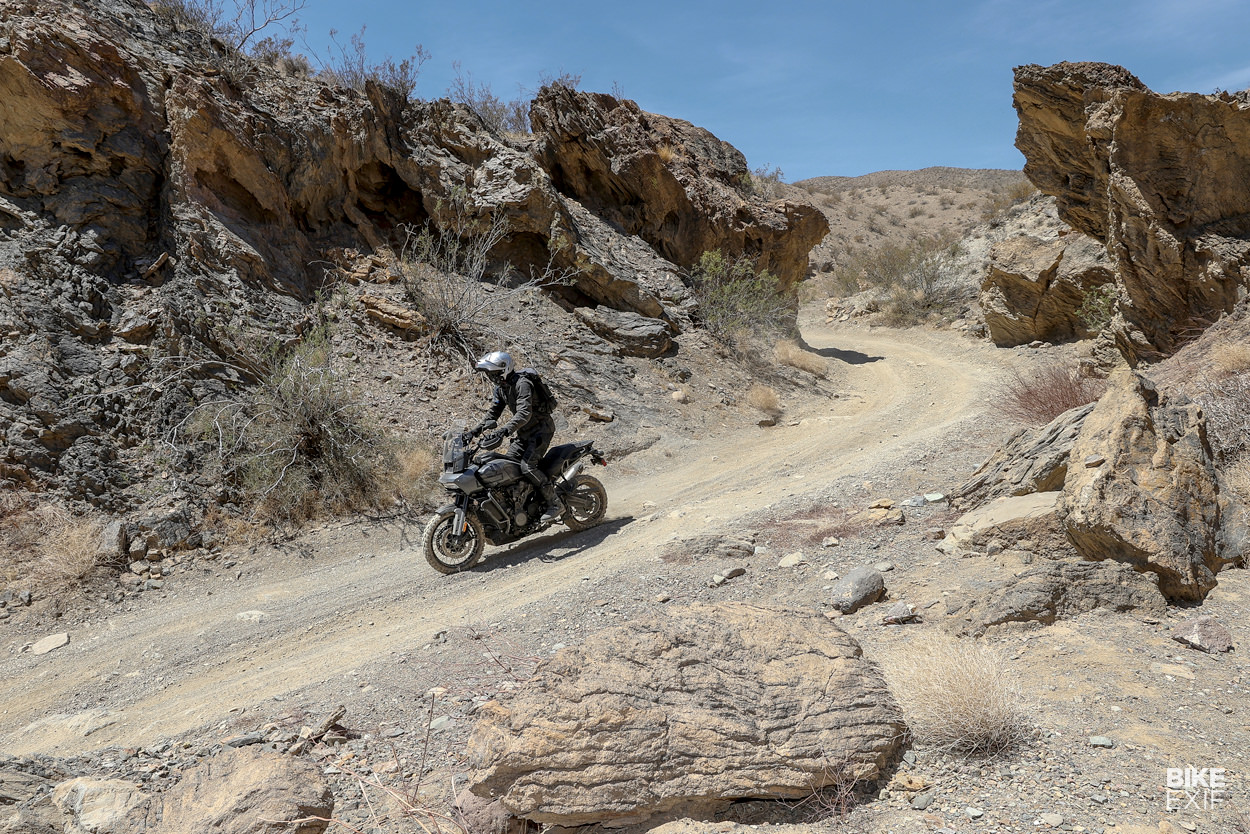
There I sat, first taking stock of my body, which appeared intact. Before Harley’s chase rider could catch up on his own Pan America (clad with the optional aluminum panniers developed with SW-Motech), I lifted the bike, peeped the damage, and breathed deep. It was ok.
The right mirror was askew and the right hand guard was detached. A screw here, a snap there and the only thing left to repair was my confidence. The Harley team asked me if I wanted to continue. There was no other choice. Once more unto the breach dear friends, once more…and off I went.
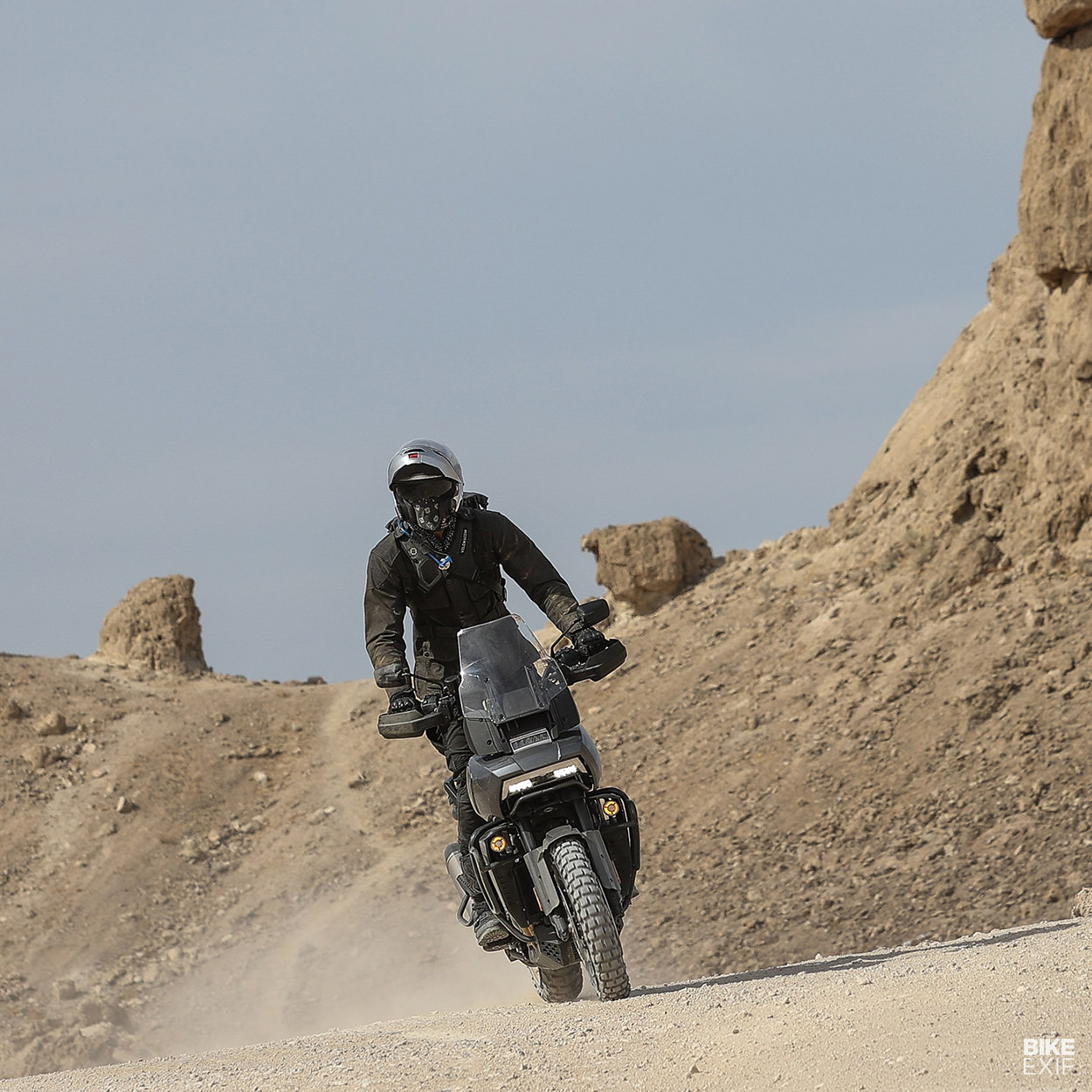
There was nary a protest from the Pan America. It took a bit for me to gain back any semblance of confidence. I dissected my error from all possible angles. I was stuck in my own head until I bossed a challenging climb, crested the hill, rounded a blind corner, and started to feel ok. An eighth of a mile or so ahead and down, I spied a smoking, smashed bike and motionless rider.
Fearing the worse, I completed the descent, dismounted, and ran to their side. They could not keep their feet. Through a roughed up helmet, their eyes were distant and glassy. The Harley team arrived soon thereafter. We tended to the rider as best we could, but a hospital trip was in their future. The rider was badly concussed. The bike was totaled. My heart was heavy and on ten.
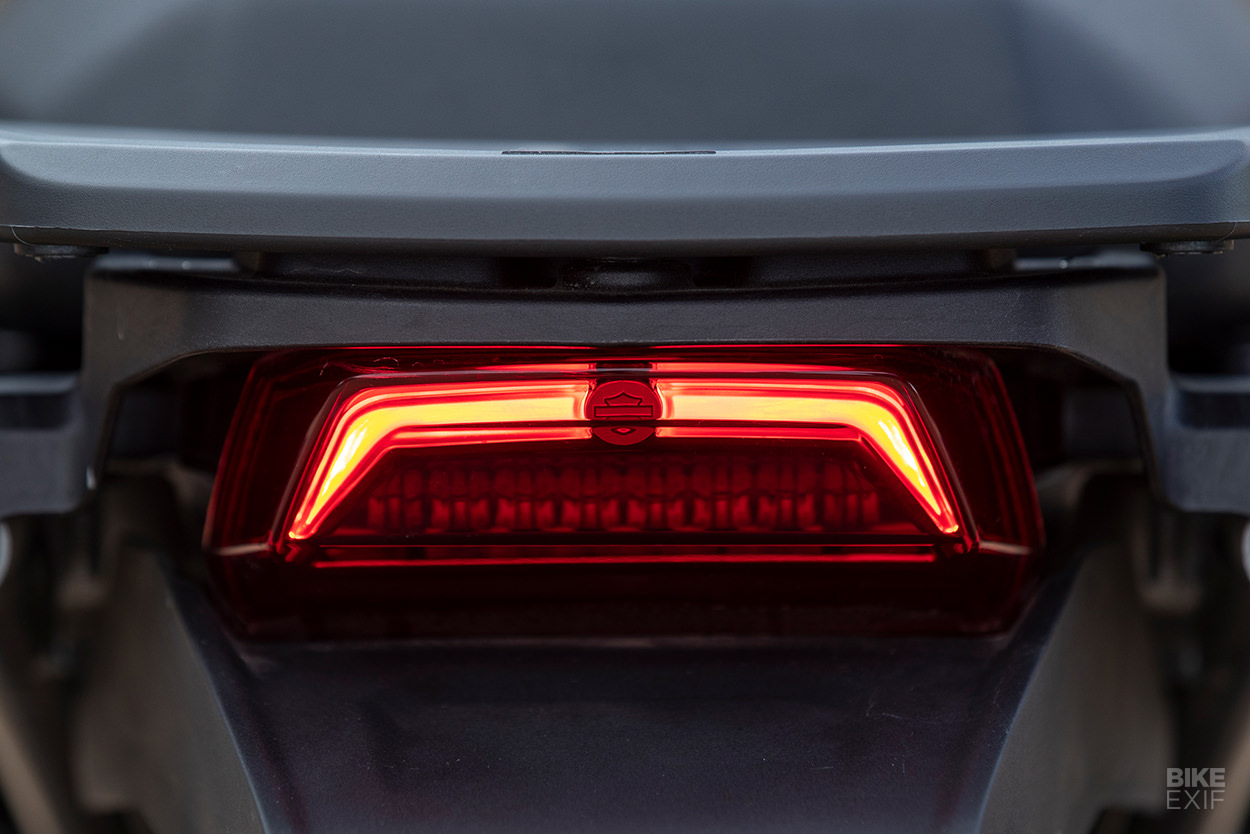
We hadn’t yet hit lunch.
“This country is hard on people. Can’t stop what’s comin’. It ain’t all waitin’ on you. That’s vanity.”—Ellis
The rest of the day was a bit more straightforward. There were a handful of drops from the other journalists, but no further injuries. There were rocks, sand, dry seabeds, ascents, descents, and more pavement.
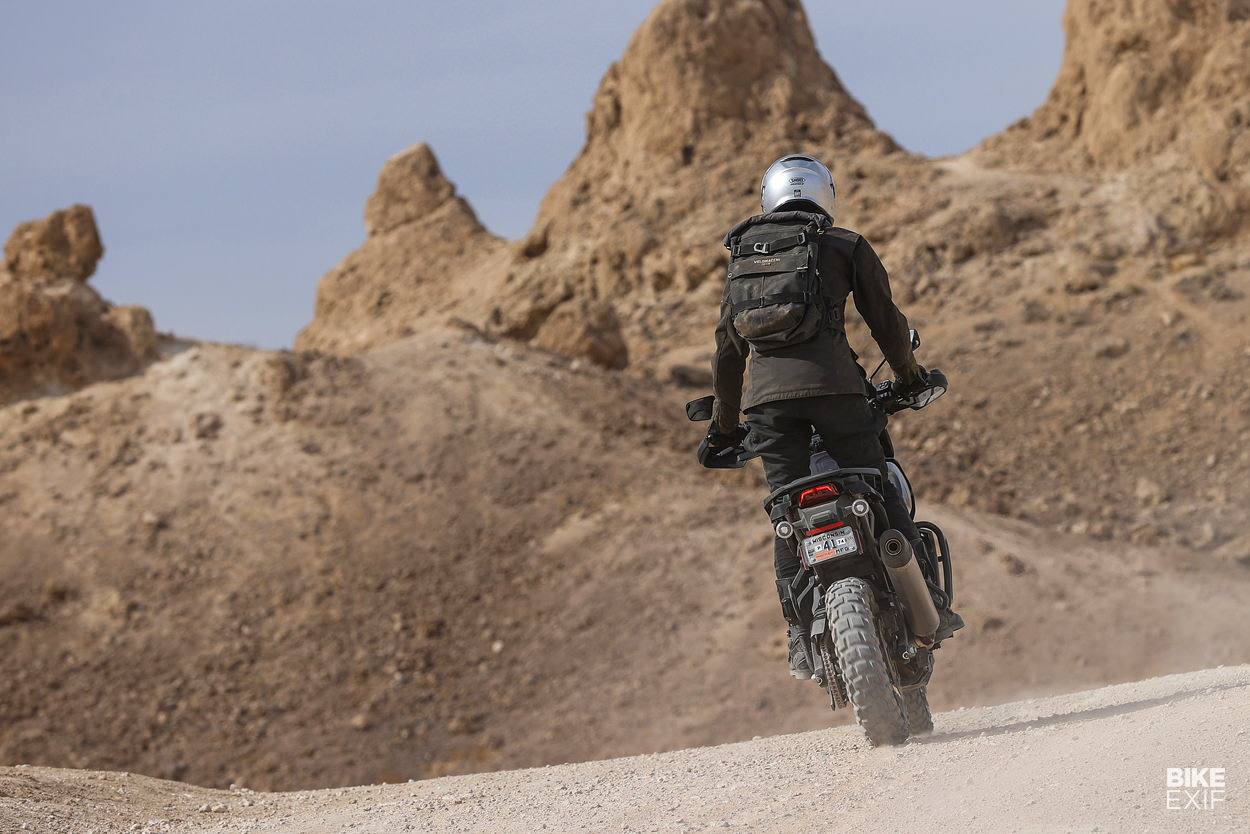
The Pan America’s electronic wizardry and specifications disappeared from mind. I eventually forgot about my own, comparatively benign spill. The bike disappeared from beneath me. There was nary a thought of the pandemic or current events. I found my flow.
As the sun descended, my confidence rose. The Pan America 1250 Special had successfully shepherded me through the ups and downs of a lifetime, in a day in the Mojave Desert. What more do we ask of an adventure-touring machine?
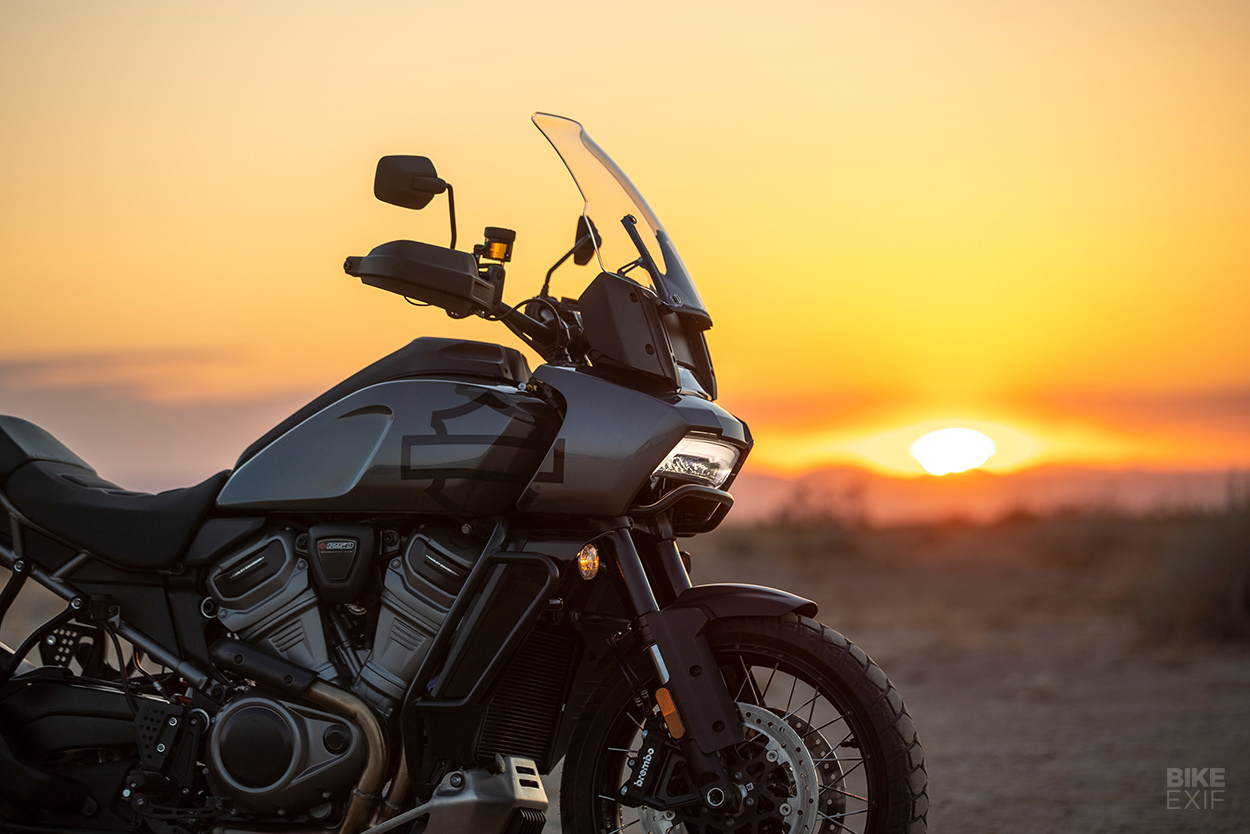
Disclosure from Lance Jones: Harley-Davidson paid for my flight, transportation to and from LAX (shoutout to David, my brilliant driver repping New Hampshire to the fullest), and room/board.
Continue reading...

“I got to say, you’re looking older.”—Ellis
“I am older.”—Sheriff Ed Tom Bell
Amongst my Rushmore of cherished films, No Country For Old Men anoints the viewer with myriad lyrical gems and witticisms.
The above exchange percolated to the front when, not five minutes into my arrival at Harley-Davidson’s press launch of their new Pan America 1250, an affable employee offered two-inch “Tall Risers” and a “Tallboy” seat.

At 6’6” and having worked on the OEM side for numerous bike launches, this was a welcomed first. But this is Harley-Davidson, after all. They pitch a big tent. If you’re seven feet tall, they will find a way.
On this day, I was at RawHyde Adventures in Castaic, California, an hour north of Los Angeles and amidst the Mojave Desert. Over the next 48 hours, I would ride hundreds of miles through varied terrain and topography atop the 2021 Harley-Davidson Pan America Special—Milwaukee’s 150 horsepower, 92 ft/lbs torque, 559 pound (wet) and 100-percent beakless adventure-touring machine.

Arriving in dealerships this May, Harley will offer a base-model Pan America 1250 for $17,319 and a Pan America 1250 Special for $19,999.
In short, and with apologies to our friends from across the pond, it is the real deal.
We all know Harley’s challenge, so I won’t spend too many words dissecting it. They print money but their ridership has crested the hill. With new-ish CEO Jochen Zeitz canning the old-guard’s “More Roads to Harley” initiative and introducing the “Rewire” and “Hardwire” strategies, there is a definitive vision—but is it the right one?

Reading tea leaves isn’t amongst my skillset. All I know is that the perhaps-axed Bronx streetfighter looked a brilliant choice to cultivate dollars from Millennials and unders.
Nevertheless, today we’re focusing on Harley’s foray into the ADV market. If you’d like some homework, feel free to dive into the Pan America’s alphabet soup of IMU, C-ELB ABS, C-TCS, DSCS, HHC, RLM, and TPMS.
Essentially, this bike has all the electrical nannies, protections, and components one would expect on a $20,000 motorcycle aiming to compete with Bavaria’s finest. Not to diminish the meticulous development of the machine, but it’s the least any discerning customer should expect.

Another acronym, ARH or Adaptive Ride Height, does pique interest. A $1,000 option available only on the Special, it works with the semi-active Showa suspension (featuring 190mm/7.48 inches of front and rear suspension travel) to lower seat height by one to two inches (depending on rear pre-load) when the bike is stopped.
When the Special gets moving, ARH does its thing and returns the bike to optimal ride height. There’s a lot more there, such as Short and Long Delay modes, but credit where it’s due: the system works imperceptibly and as advertised.

Human giraffe that I am, flatfooting is rarely an issue, even on the tallest of dirt bikes. For the vast majority of riders though, especially when perched on tenuous off-road ground, it’s a definite benefit.
FYI: the Pan America 1250 model features passive front and rear Showa suspension, retains the same suspension travel, but does not offer the Special’s five pre-programmed suspension modes.
The all-new liquid cooled 1250cc V-Twin engine, called the Revolution Max, is a central member of the chassis and thoroughly modern. It has double overhead camshafts, variable valve timing, reaches a peak 9500 rpm, and complies with Euro 5.

In the Mojave, engine or exhaust heat was never an issue. While operating best on 91 octane, it can run on lower octane—though with sacrifices to power and the EPA-confirmed 46 mpg fuel efficiency.
A chain, rather than belt, commands the final drive. The rider manipulates the six-speed transmission with a slipper clutch designed to smooth downshifts and prevent rear wheel slip or hop.
Both Pan America models hit the ground with a 19- and 17-inch front/rear wheel combination. Michelin Scorcher Adventure tires and cast aluminum wheels are stock, but Michelin Anakee Wild tires and off-road-friendly laced wheels (the latter, $500) are options on each bike.

Most adventure rides involve pounding some pavement, and here the Pan America 1250 Special excels. Throttling to 5,000 or so rpm, the engine is smooth, efficient, and with a pair of Hearos, quiet.
Amidst 50 mph wind gusts and through tricky 18-wheeler crosswinds, the Harley was unfazed. But as a mini Manute Bol, I could do with a much taller or much shorter windscreen. (Harley, of course, offers both.)
The 6.8-inch TFT touchscreen is a tad busy, surrounding a digital speedo and tach with quadrants of customizable widgets. Though the font could be larger, even with my supposed 20/13 vision, sun glare did not exist.

Phone pairing was simple enough. Download the Harley app (Android or iOS), click a few buttons, and voilà. In tandem with a Bluetooth headset, phone and music functions are controlled with a flick of the left thumb underway, as well as on the touchscreen, albeit when stationary.
I appreciated the screen’s ability to show a full screen of navigation, or display turn-by-turn on one of the aforementioned widgets. It wasn’t Google Maps or Waze, but it did the job.
We didn’t ride at night, but the time-tested Daymaker LED lighting and Advanced Daymaker Adaptive headlight (optional on the Standard) should do the trick. None of the above should surprise. Harley gon’ Harley.

The big ‘Murican more than held its own when things got twisty and dynamic. Above 5,000 rpm, the engine awakens with a lovely combination of sound and feel, amplified by the accessory Screamin’ Eagle exhaust, which also saves six pounds. As one Harley engineer declared, they kept none of the bad vibrations and all of the good.
The engine revs freely and never wants for power, though tall-ish gearing hides a bit of the torque from the rider’s grasp. The on-road portion of our test did not faze the Scorcher Adventures, nor did the stock tires fall apart when we explored a bit off-road. Hard pack, gravel, and soft sand weren’t issues. There was plenty of range left in the 5.3-gallon tank.

Ergonomically, the knee bend for my freakish self was a bit tight despite the Tallboy seat being placed in the tall setting. (Regardless of stock, Tallboy or Reach seat choice, the Pan America features high and low seat positions—giving or taking an inch).
My right wrist did protest after our on-road day. Perhaps the risers were a bit too tall, or perhaps it was the rake/angle of the bars themselves. I kept thinking how a rally-style seat would alleviate some of the trouble, as my ability to scoot back and forth was limited by the passenger seat.
It took the full two days to conform to the electronic turn signals, which depart from a century of precedent. Instead of that satisfying center click to cancel, any additional click, regardless of which way, cancels. Many a rider suffered from a rogue indicator. Cue Abe Simpson shaking his fist at the cloud.

The Pan America offers five pre-programmed riding modes: Rain, Road, Sport, Off-Road, and Off-Road Plus. The Special adds three customizable modes, and the Standard model one. In keeping with the competition, they allow the rider to tinker.
If you’re familiar with any modern-day adventure bike, you’ll know how this works. The modes are as advertised. On-road, I generally stayed in Sport, which dialed back the nannies and allowed me to give the bike the beans in relative safety. At a high-level, Road is to Sport as Off-Road is to Off-Road Plus. Here, Harley got it right.
On to the proverbial elephant…

Our focus for the second day was off-road. I have a decent amount of experience, from the red clay of Georgia to the deserts of Southern California, Nevada, and even Morocco.
Still, I would not call myself anything but a dude trying not to bust his ass. I tend to impede the bike, rather than the other way around. In a lot of ways, I represent a segment of rider Harley is targeting with the Pan America.
Equipped with a used set of Anakee Wilds, we departed RawHyde at 9:45 am. Sweaty not from heat, but trepidation, I was in my own head. After a highway blast, on which the Anakees served just fine, we made the turn off-pavement and up I stood. I reminded myself of a piece of wisdom bestowed by Jim Hyde, RawHyde’s founder: How often do you have the chance to be nervous?
No problem there, Big Jim!

And off we went. Generally, second gear and Off-Road Plus mode were my tactics. I spent the early stages building up confidence in myself, rather than confidence in the bike. Not so deep down, I knew the bike could handle everything we would experience on this day. With the knowledge that over a million miles of development was split 50/50 on- and off-road, I was beginning to feel good.
I was getting out of my own way until I forgot a basic tenet of navigating the sand: keep your speed up! Instead, when I saw it my bowels clenched, I eased off the throttle, and down I went.

There I sat, first taking stock of my body, which appeared intact. Before Harley’s chase rider could catch up on his own Pan America (clad with the optional aluminum panniers developed with SW-Motech), I lifted the bike, peeped the damage, and breathed deep. It was ok.
The right mirror was askew and the right hand guard was detached. A screw here, a snap there and the only thing left to repair was my confidence. The Harley team asked me if I wanted to continue. There was no other choice. Once more unto the breach dear friends, once more…and off I went.

There was nary a protest from the Pan America. It took a bit for me to gain back any semblance of confidence. I dissected my error from all possible angles. I was stuck in my own head until I bossed a challenging climb, crested the hill, rounded a blind corner, and started to feel ok. An eighth of a mile or so ahead and down, I spied a smoking, smashed bike and motionless rider.
Fearing the worse, I completed the descent, dismounted, and ran to their side. They could not keep their feet. Through a roughed up helmet, their eyes were distant and glassy. The Harley team arrived soon thereafter. We tended to the rider as best we could, but a hospital trip was in their future. The rider was badly concussed. The bike was totaled. My heart was heavy and on ten.

We hadn’t yet hit lunch.
“This country is hard on people. Can’t stop what’s comin’. It ain’t all waitin’ on you. That’s vanity.”—Ellis
The rest of the day was a bit more straightforward. There were a handful of drops from the other journalists, but no further injuries. There were rocks, sand, dry seabeds, ascents, descents, and more pavement.

The Pan America’s electronic wizardry and specifications disappeared from mind. I eventually forgot about my own, comparatively benign spill. The bike disappeared from beneath me. There was nary a thought of the pandemic or current events. I found my flow.
As the sun descended, my confidence rose. The Pan America 1250 Special had successfully shepherded me through the ups and downs of a lifetime, in a day in the Mojave Desert. What more do we ask of an adventure-touring machine?

Disclosure from Lance Jones: Harley-Davidson paid for my flight, transportation to and from LAX (shoutout to David, my brilliant driver repping New Hampshire to the fullest), and room/board.
Continue reading...
BLACK NICKEL BONNEVILLE: ‘Othar’ by Tamarit Motorcycles.
You have to hand it to Triumph, as many other manufacturers entered the millennium looking to reinvent the wheel to get sales back on track, the Hinckley factory opened their back catalogue and gave the Bonneville a modern make-over. Twenty years later and now with water-cooled engines and fancy electronics, the classic lines and simple motorcycling charm sees them continue to be a sales success.
Source
You have to hand it to Triumph, as many other manufacturers entered the millennium looking to reinvent the wheel to get sales back on track, the Hinckley factory opened their back catalogue and gave the Bonneville a modern make-over. Twenty years later and now with water-cooled engines and fancy electronics, the classic lines and simple motorcycling charm sees them continue to be a sales success.
Source
Dream Team: An eye-popping Ducati Scrambler flat tracker
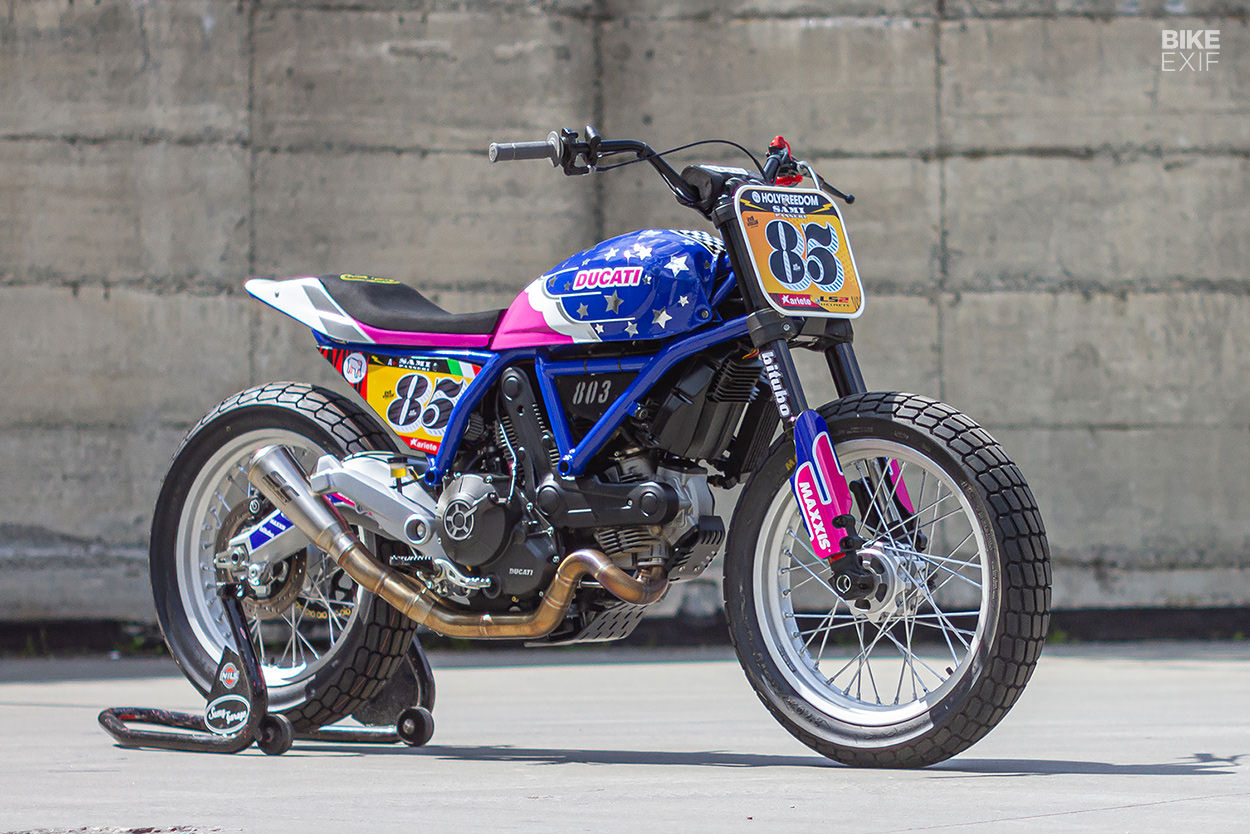
Paint is the last thing that happens on a custom job, but it’s the first thing that people notice. And the livery on this race-ready Ducati Scrambler is unmissable. A zany combination of blue, magenta and reflective silver, it’s about as subtle as a Tarantino flick.
Built in Italy, this Scrambler is the product of a collaboration between Samy Garage and Greaser Garage. Samy Garage is the moniker for flat track racer Sami Panseri, who spins spanners in his home garage about 25 miles outside Milan. And Greaser Garage is a full service custom shop based in Genoa.
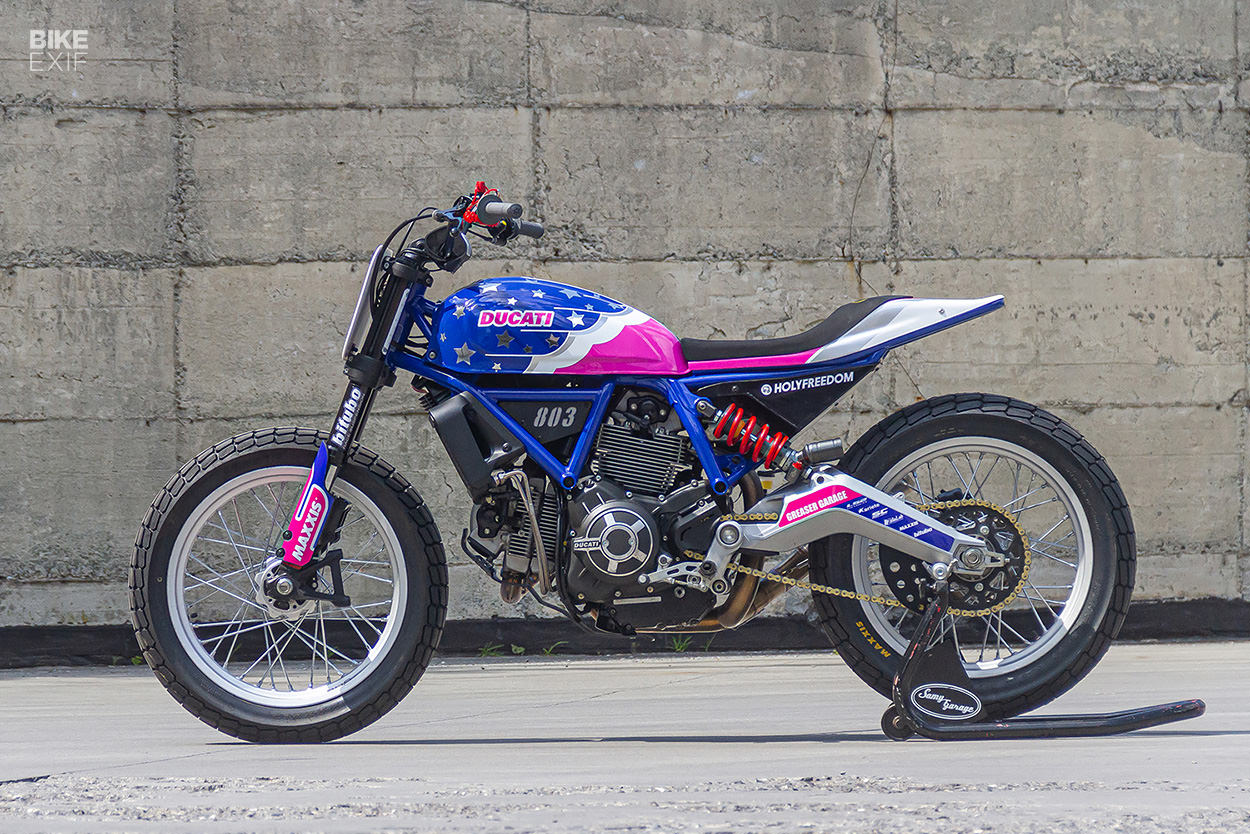
This is Sami’s personal race bike, so he needed it to go fast rather than to just look pretty. The Greaser guys got the call to come up with a race-worthy paint scheme, and Sami gave them free rein. So naturally, they went wild.
“We only told Sami that some blue would be involved in the process, but we kept our mouths shut about all the rest,” says Greaser team member and photographer, Matteo Scarsi. “So he had his frame painted in this blue tone, to match the work that was simultaneously going on in our workshop.”
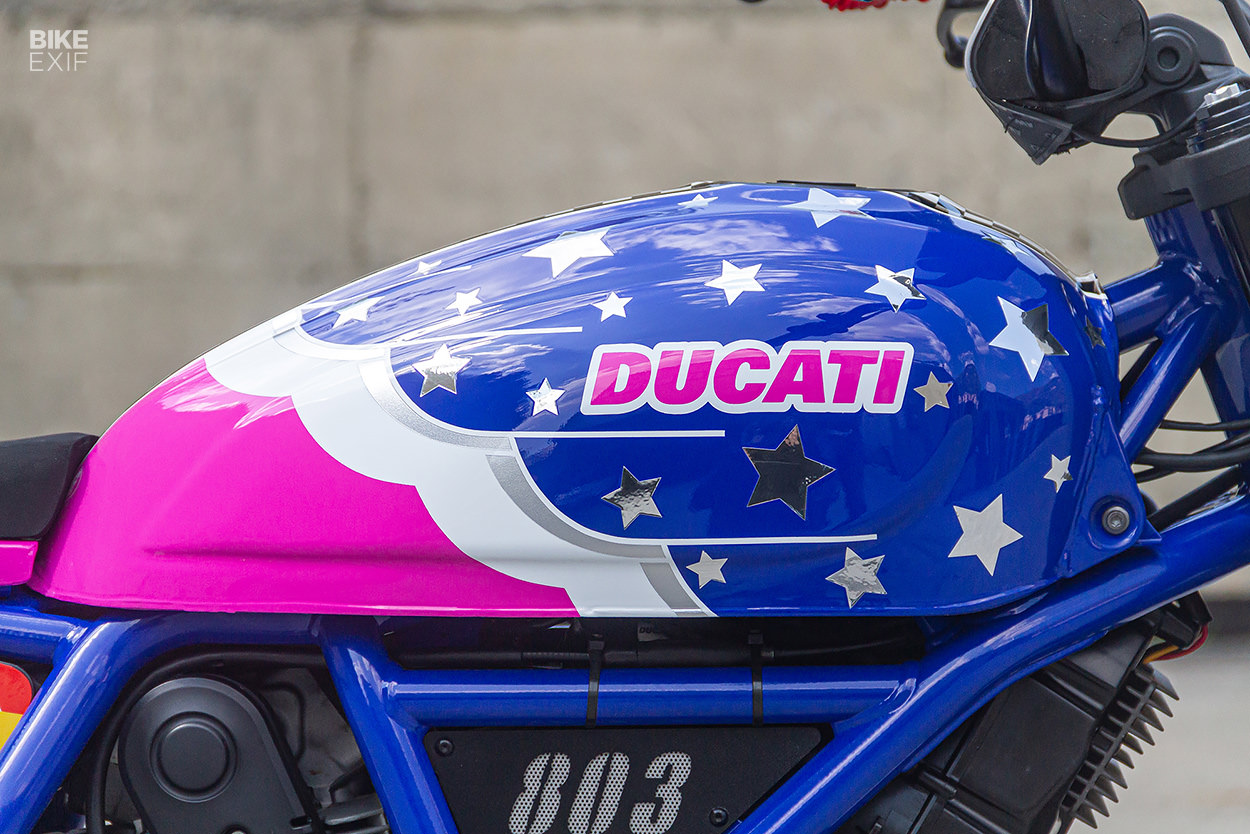
To nail the vibe, Matteo created sketches, then digital renders of the final livery. The blue and magenta sections are punctuated by hits of white and chrome silver. From the 70s-style checkers on top of the tank to the array of stars on the side, it feels chaotic … but it’s actually all very considered.
“The stylized wings on the tank sides are an ommagio to the old Ducati logo,” explains Matteo. “Together with the silver shades and chrome stars, they give the bike a USA flavor, in honor of the country where this type of racing became famous. We tried to create something faithful to the heritage of the sport, that also could incorporate contemporary inspirations and ideas.”
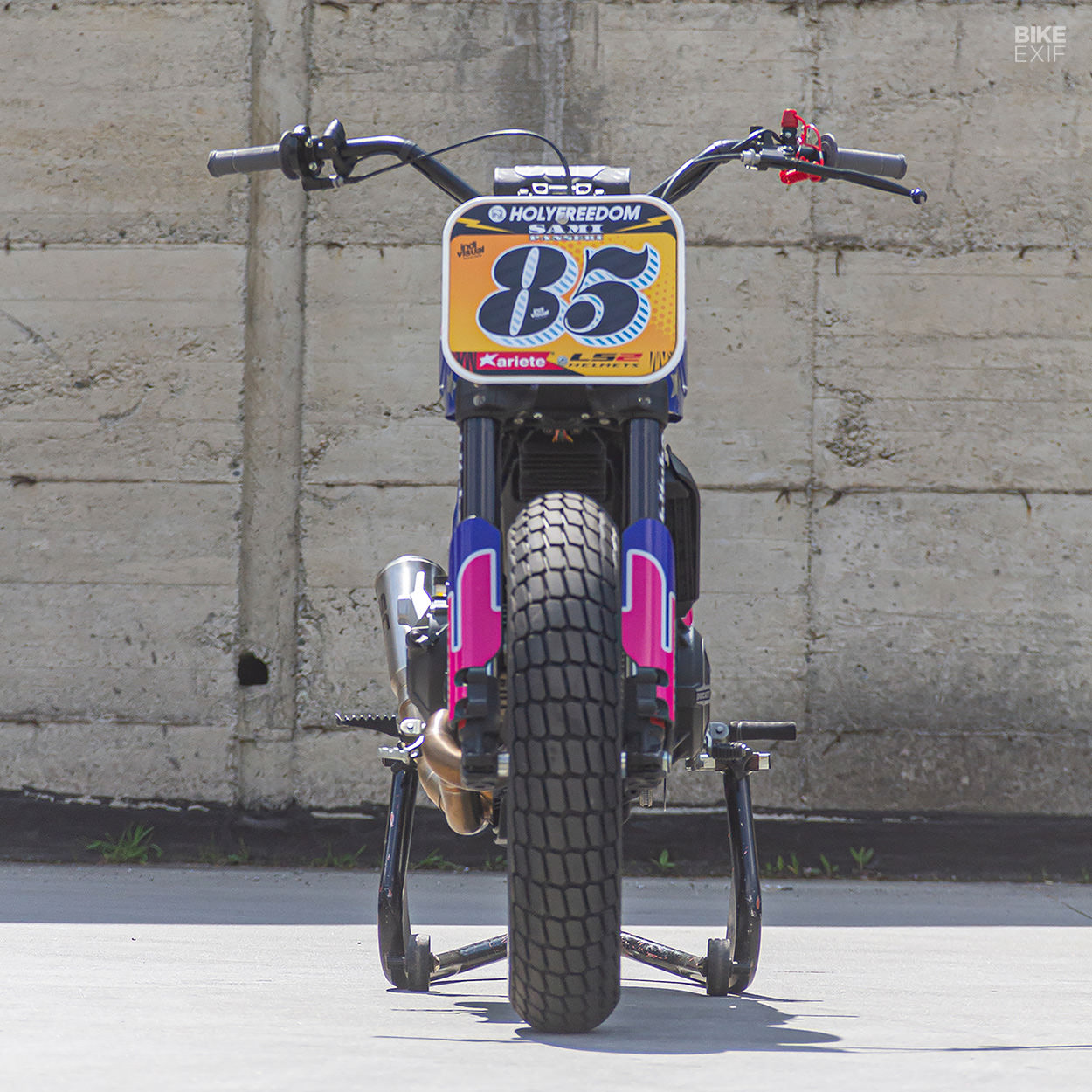
Of course, Sami’s Ducati is more than just a design exercise. Lurking under those radical graphics is a whole spread of tasty racing upgrades.
For starters, Sami’s Scrambler is the basic ‘803’ model, so it needed new wheels out the box. Using the stock hubs and a pair of 19” Ducati Scrambler Desert Sled front rims, he laced up a new set of wheels and wrapped them in Maxxis dirt track tires. He removed the front brake too, obviously.
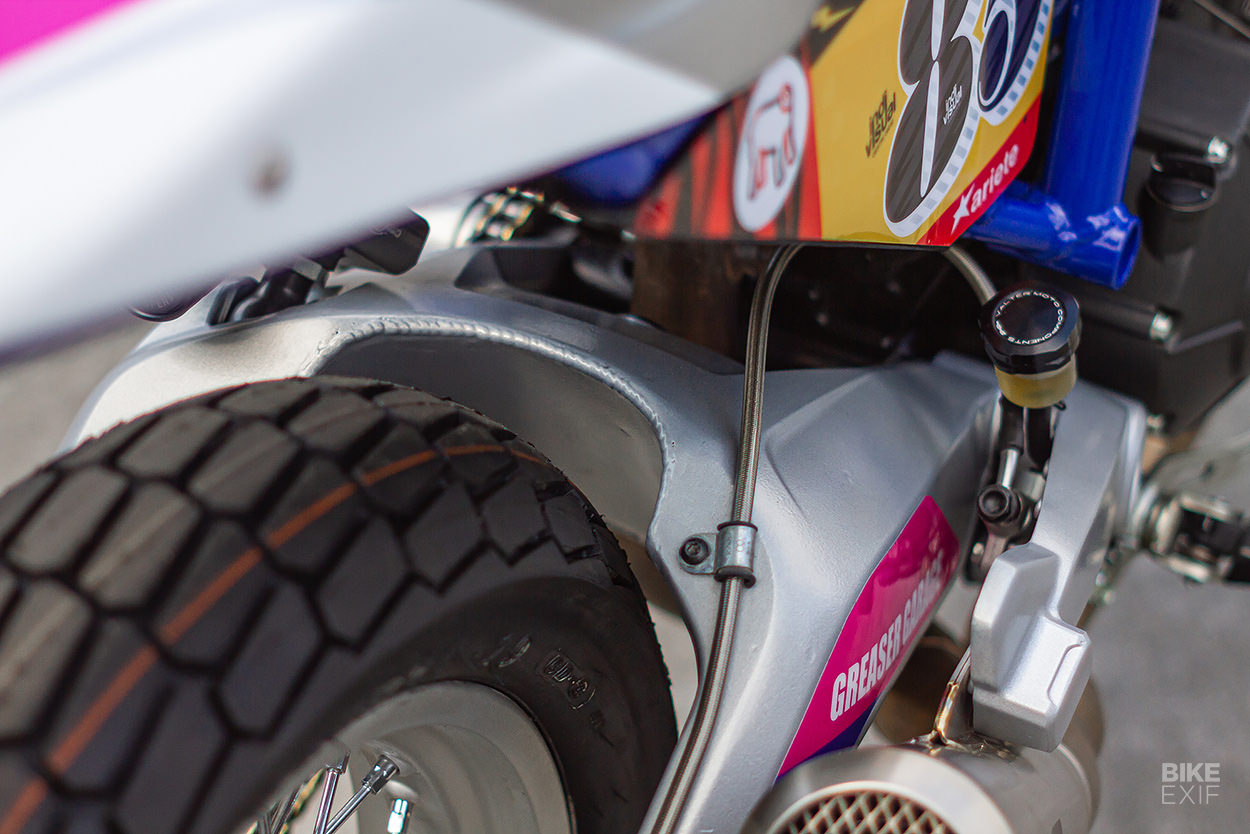
Getting the 19” rear tire to fit was a challenge though, since Sami didn’t want to change the bike’s wheelbase by extending the swing arm. Instead, he modified the swing arm with a cutaway to add clearance, calling in a specialist to weld it shut afterwards. It’s a tight fit, but it works.
Moving to suspension, Sami installed a fork cartridge kit and a new rear shock—both from Bitubo. He also modified the frame to remove the steering stops for maximum slide-ability, and cut and looped it at the back.
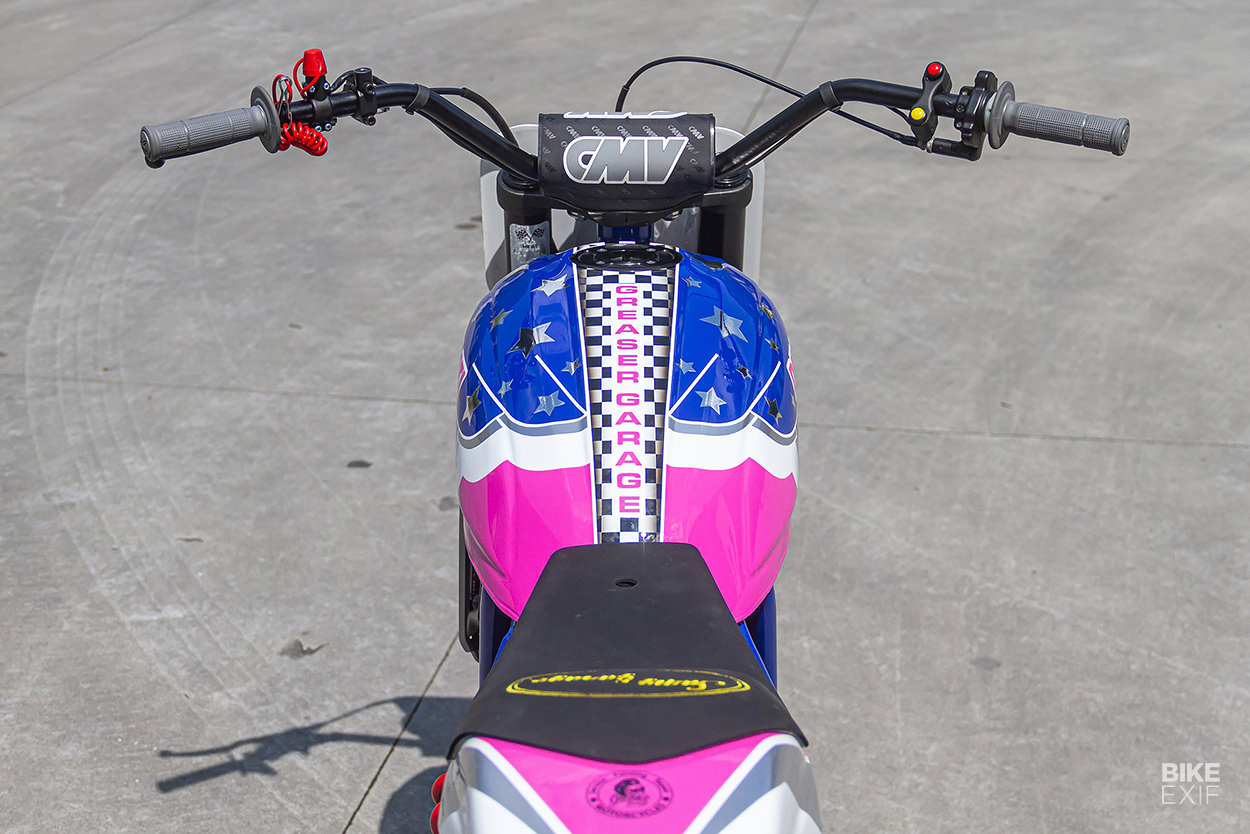
Up top is the stock fuel tank, followed by a replica Bultaco Astro flat track tailpiece. It’s capped off with a neoprene seat pad, adorned with the Samy Garage logo in yellow. Peak around the side and under the tail, and you’ll spot custom-made panels to keep the wiring hidden away.
Sami rewired the bike to ditch all the street legal bits he didn’t need. The cockpit’s extremely simple now: a set of custom bars from CMV on set-back risers, the essential switches, and a mandatory lanyard kill-switch. A front number board finishes things off, with decals from another collaborator, Indivisual.
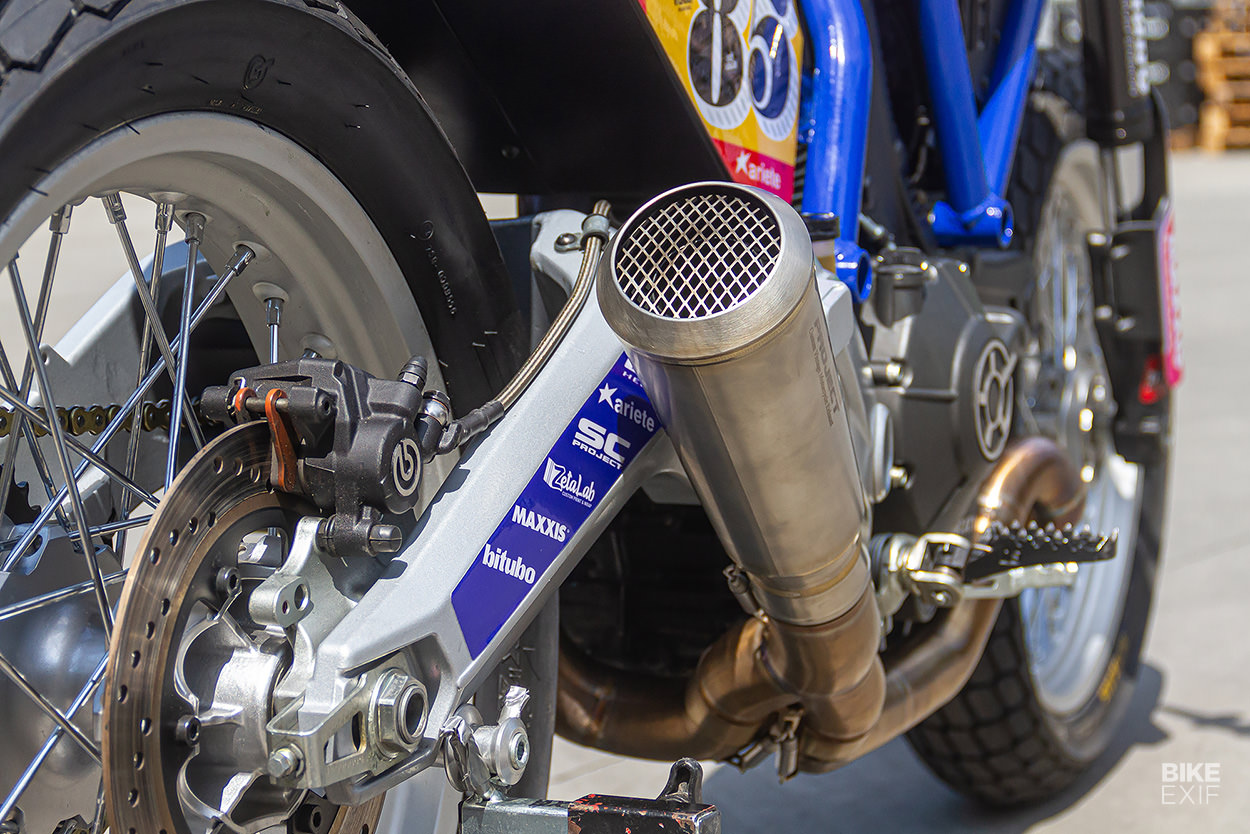
Under the hood, Sami’s boosted the Ducati’s output with a new intake kit from Starace and a new ECU map from Up Map. The exhaust consists of an SC Project muffler, mated to custom oversized headers.
This zany Scrambler is now ready to tear up the track. Sami will be piloting it at the German Krowdrace event, in the Hooligan class, and at the Coppa Italia race in Italy. Then he’ll race it wherever else he can, as the pandemic permits.
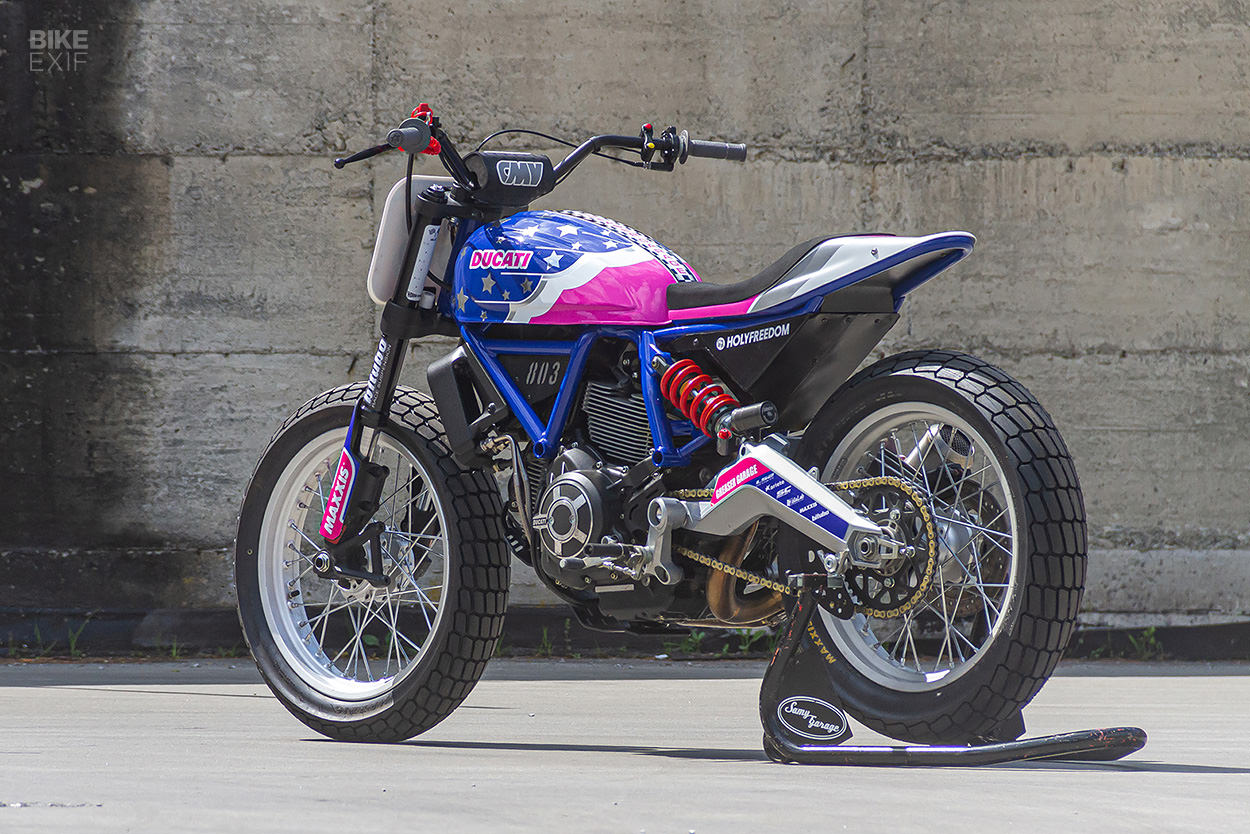
“We followed the ‘go big or go home’ rule,” says Matteo, “so we didn’t leave anything on the line. This Scrambler must be visible, even from space—and since everything will be immediately be covered by dirt and dust as soon as the bike hits the track, we’re pretty sure Sami will still be recognizable.”
Samy Garage Facebook | Instagram | Greaser Garage | Facebook | Instagram
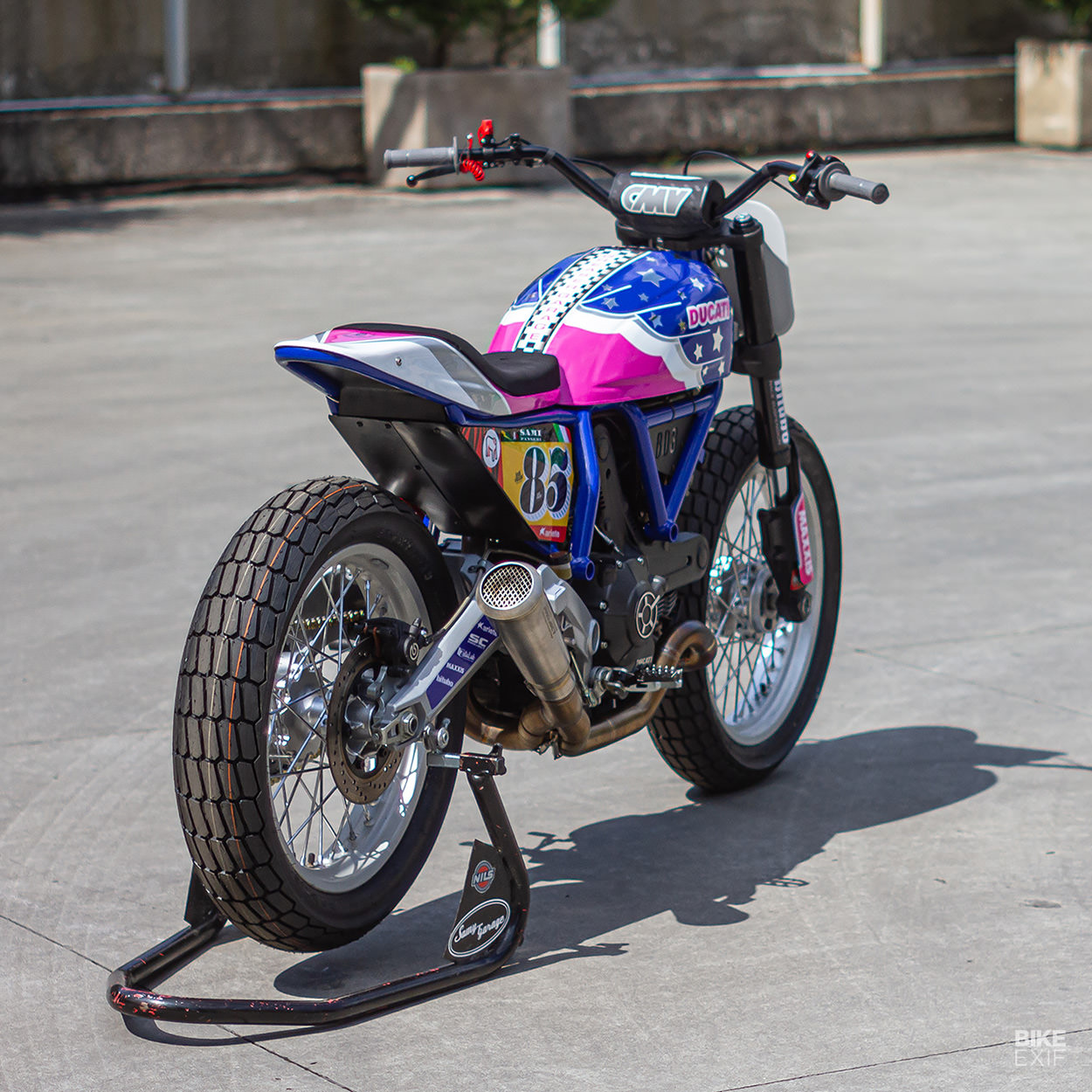
Continue reading...

Paint is the last thing that happens on a custom job, but it’s the first thing that people notice. And the livery on this race-ready Ducati Scrambler is unmissable. A zany combination of blue, magenta and reflective silver, it’s about as subtle as a Tarantino flick.
Built in Italy, this Scrambler is the product of a collaboration between Samy Garage and Greaser Garage. Samy Garage is the moniker for flat track racer Sami Panseri, who spins spanners in his home garage about 25 miles outside Milan. And Greaser Garage is a full service custom shop based in Genoa.

This is Sami’s personal race bike, so he needed it to go fast rather than to just look pretty. The Greaser guys got the call to come up with a race-worthy paint scheme, and Sami gave them free rein. So naturally, they went wild.
“We only told Sami that some blue would be involved in the process, but we kept our mouths shut about all the rest,” says Greaser team member and photographer, Matteo Scarsi. “So he had his frame painted in this blue tone, to match the work that was simultaneously going on in our workshop.”

To nail the vibe, Matteo created sketches, then digital renders of the final livery. The blue and magenta sections are punctuated by hits of white and chrome silver. From the 70s-style checkers on top of the tank to the array of stars on the side, it feels chaotic … but it’s actually all very considered.
“The stylized wings on the tank sides are an ommagio to the old Ducati logo,” explains Matteo. “Together with the silver shades and chrome stars, they give the bike a USA flavor, in honor of the country where this type of racing became famous. We tried to create something faithful to the heritage of the sport, that also could incorporate contemporary inspirations and ideas.”

Of course, Sami’s Ducati is more than just a design exercise. Lurking under those radical graphics is a whole spread of tasty racing upgrades.
For starters, Sami’s Scrambler is the basic ‘803’ model, so it needed new wheels out the box. Using the stock hubs and a pair of 19” Ducati Scrambler Desert Sled front rims, he laced up a new set of wheels and wrapped them in Maxxis dirt track tires. He removed the front brake too, obviously.

Getting the 19” rear tire to fit was a challenge though, since Sami didn’t want to change the bike’s wheelbase by extending the swing arm. Instead, he modified the swing arm with a cutaway to add clearance, calling in a specialist to weld it shut afterwards. It’s a tight fit, but it works.
Moving to suspension, Sami installed a fork cartridge kit and a new rear shock—both from Bitubo. He also modified the frame to remove the steering stops for maximum slide-ability, and cut and looped it at the back.

Up top is the stock fuel tank, followed by a replica Bultaco Astro flat track tailpiece. It’s capped off with a neoprene seat pad, adorned with the Samy Garage logo in yellow. Peak around the side and under the tail, and you’ll spot custom-made panels to keep the wiring hidden away.
Sami rewired the bike to ditch all the street legal bits he didn’t need. The cockpit’s extremely simple now: a set of custom bars from CMV on set-back risers, the essential switches, and a mandatory lanyard kill-switch. A front number board finishes things off, with decals from another collaborator, Indivisual.

Under the hood, Sami’s boosted the Ducati’s output with a new intake kit from Starace and a new ECU map from Up Map. The exhaust consists of an SC Project muffler, mated to custom oversized headers.
This zany Scrambler is now ready to tear up the track. Sami will be piloting it at the German Krowdrace event, in the Hooligan class, and at the Coppa Italia race in Italy. Then he’ll race it wherever else he can, as the pandemic permits.

“We followed the ‘go big or go home’ rule,” says Matteo, “so we didn’t leave anything on the line. This Scrambler must be visible, even from space—and since everything will be immediately be covered by dirt and dust as soon as the bike hits the track, we’re pretty sure Sami will still be recognizable.”
Samy Garage Facebook | Instagram | Greaser Garage | Facebook | Instagram

Continue reading...
Speed Read, 25 April 2021
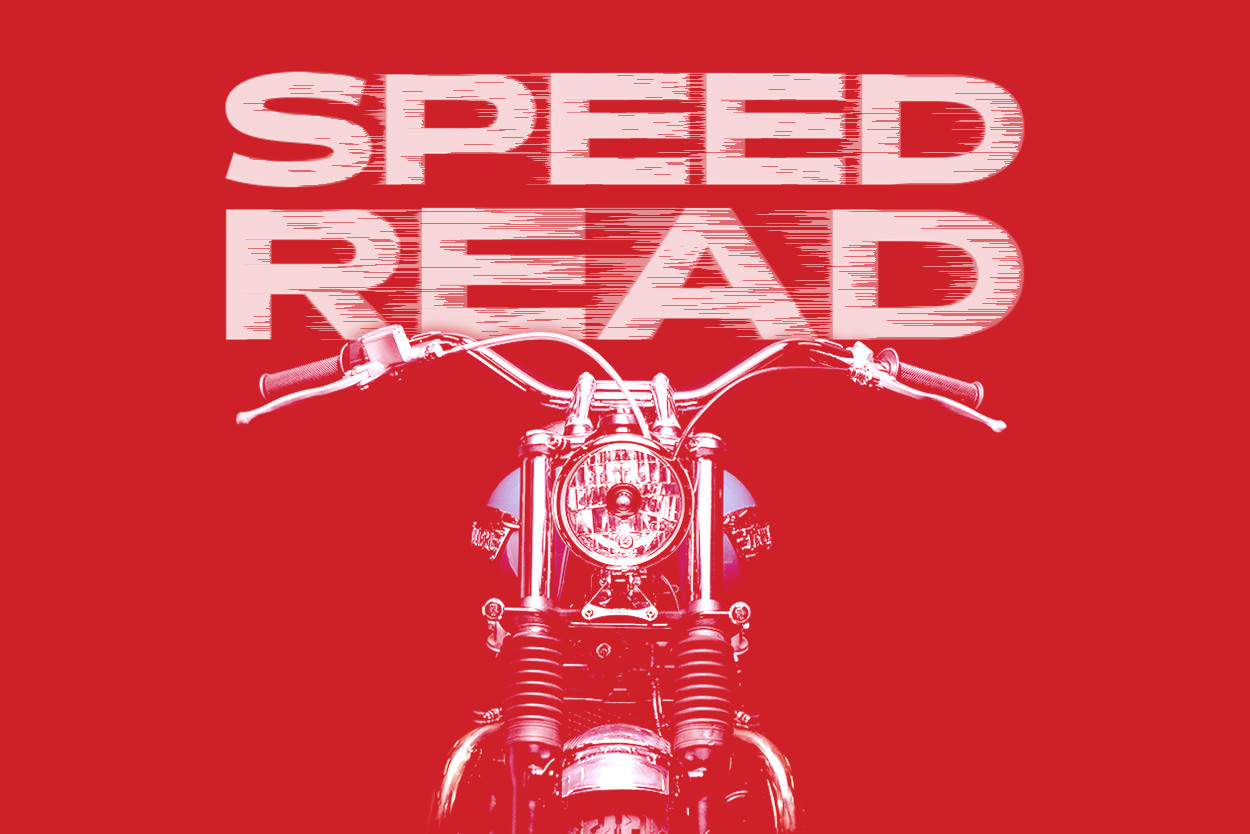
We’re kicking things off this week with a chic Triumph Street Twin from FCR Original. We’ve also got a BMW R nineT from Gas & Oil, a Yamaha XT600 street tracker, Arai’s new ECE 22.06 approved helmet, and a look inside Thronton Hundred’s workshop.
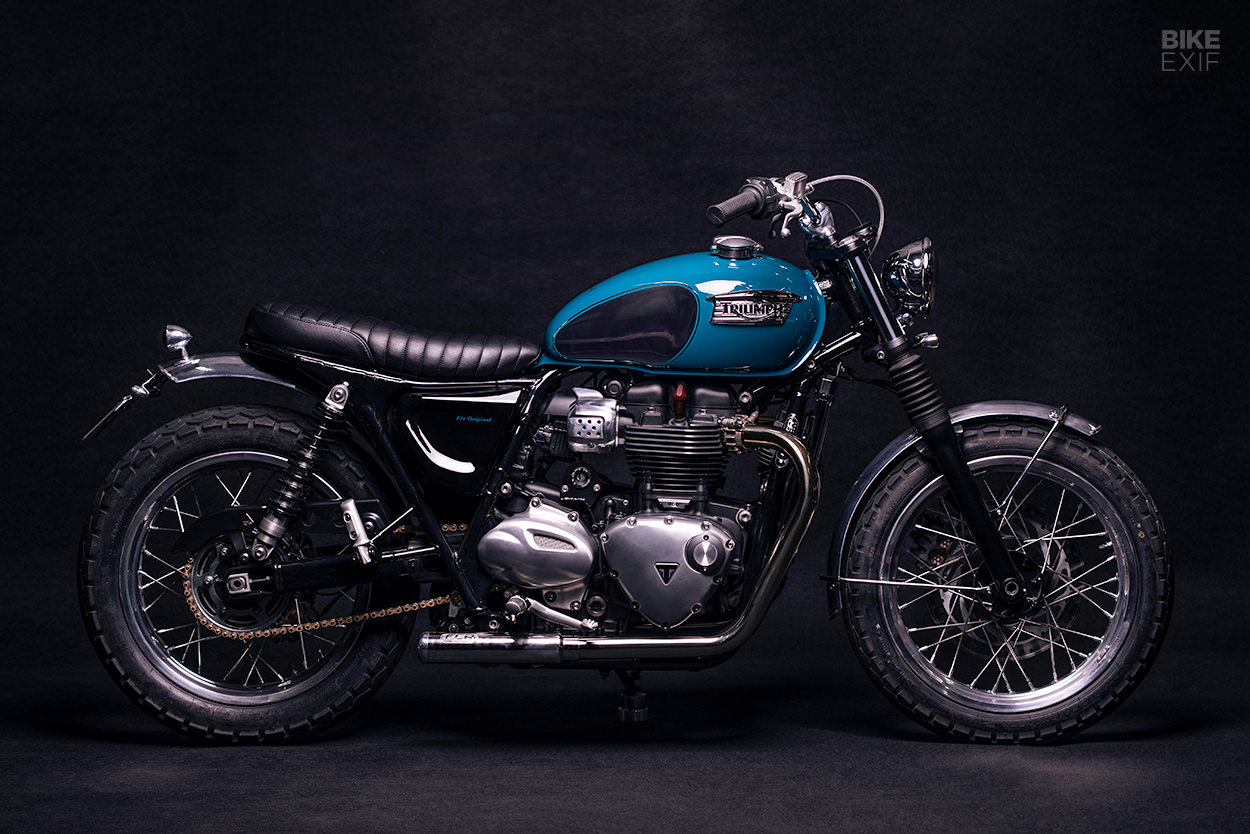
Triumph Street Twin by FCR Original Thanks to its mag wheels and upswept exhausts, the Street Twin is the least retro-looking motorcycle in Triumph’s range of modern classics. But this custom from the French shop FCR Original has such a classic vibe, we didn’t realize it was a Street Twin until shop boss Sébastien Guillemot told us.
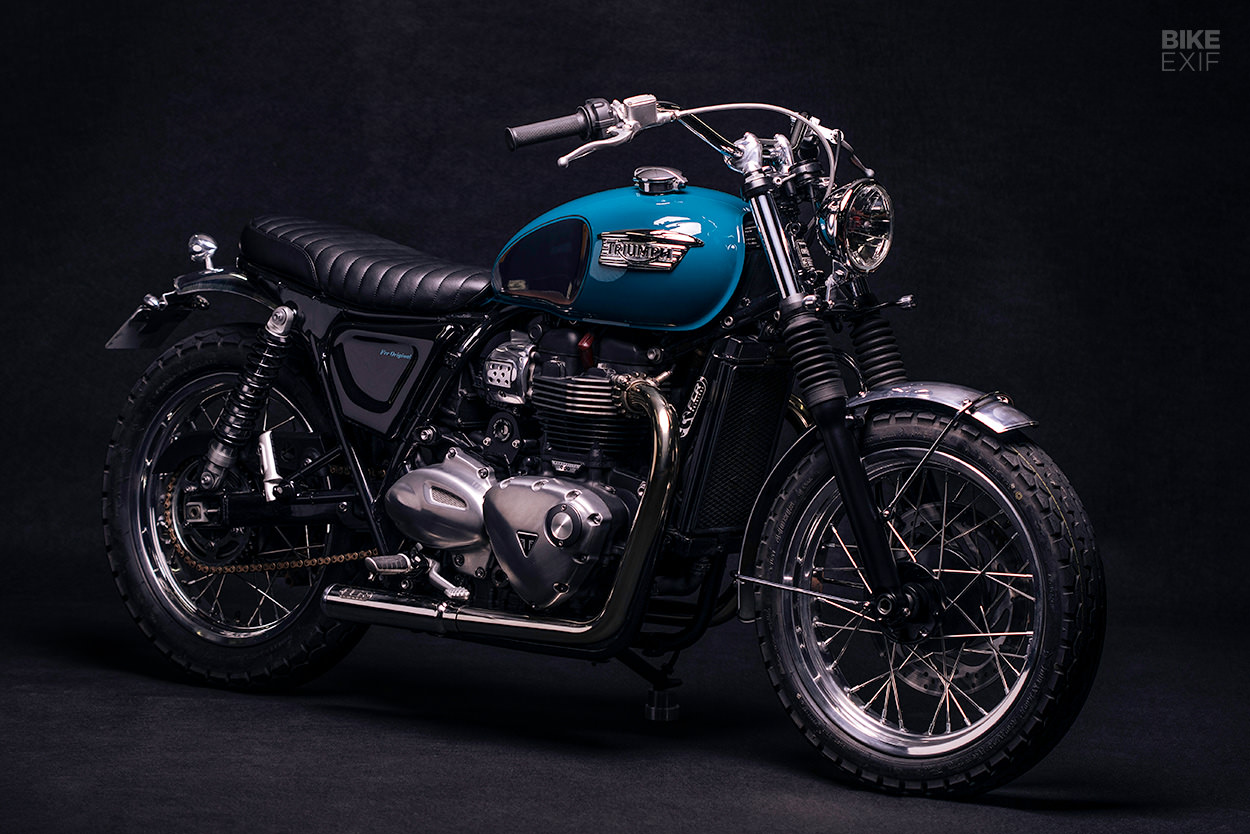
FCR Original have a way with neo-retro Triumphs, so it’s no surprise that this is their work. The biggest hit here is the duck blue paint on the tank—along with the chrome knee indents and period-correct tank badges. The shop has also traded the mudguards for classic alloy units, and swapped out the saddle.
The other big change is the wheels: FCR swapped the 18F/17R wheels for a pair of 18” spoked items, using aluminum Morad rims and Dunlop TT100 and K81 tires.
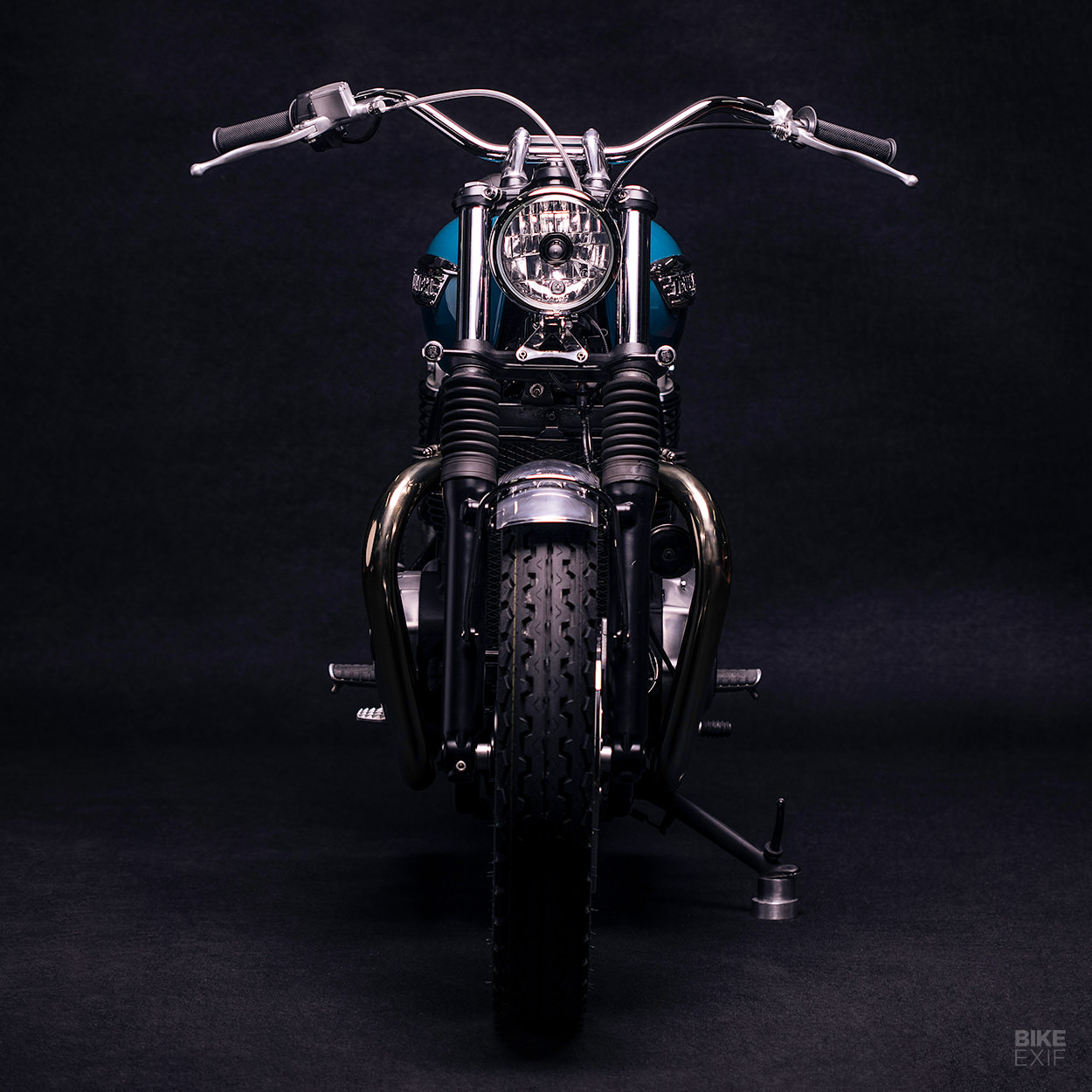
The new rear suspenders are from Shock Factory, and the exhaust mufflers are from FCR’s own catalog of Triumph-specific parts.The build’s finished off with a host of subtle tweaks—like vintage lighting, new turn signals and an FCR plate holder.
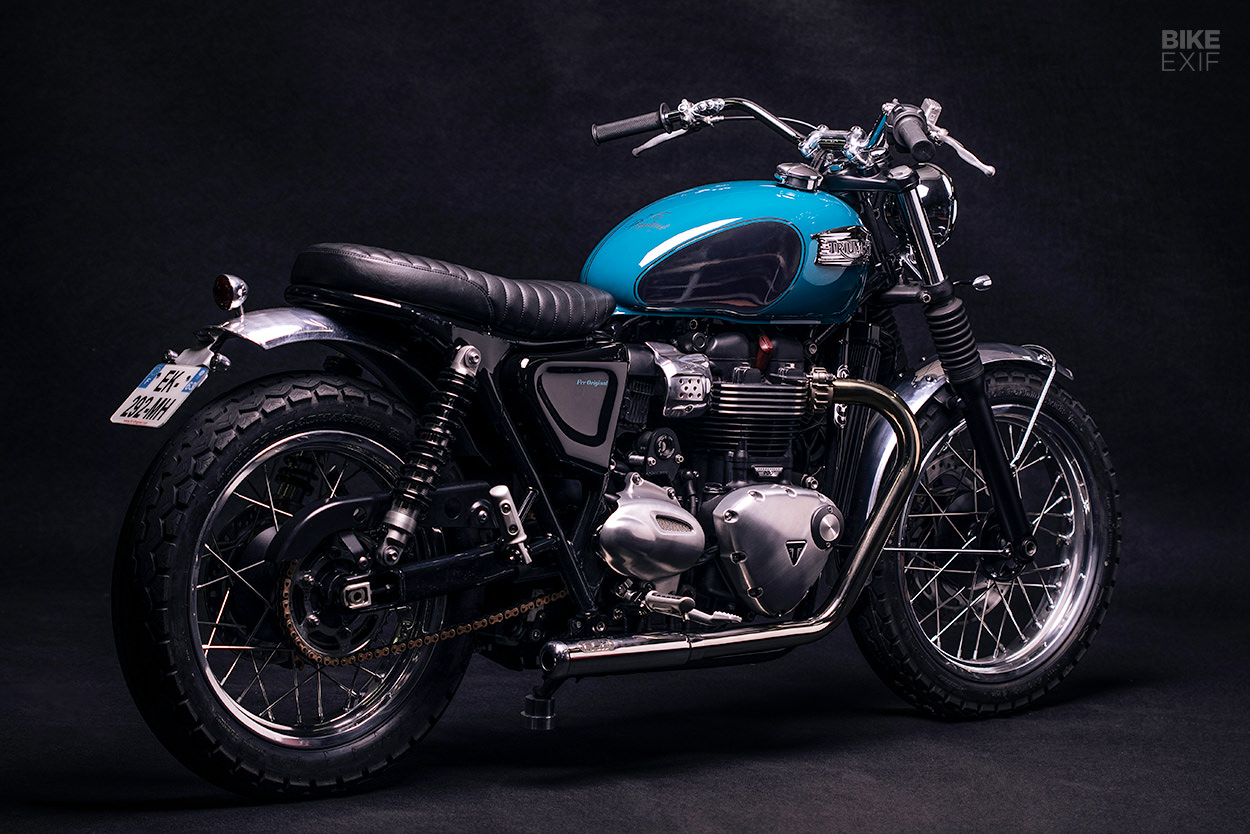
The chromed handlebars are from FCR’s shop too, and wear Kustom Tech brake and clutch controls. There’s also a Monza gas cap, new side covers, and brushed Triumph engine covers.
The best part is where the commission came from: the owner already has one FCR Original Triumph, and wanted a second so that he and his wife can ride together. [FCR Original | Images by Mitch Canon]
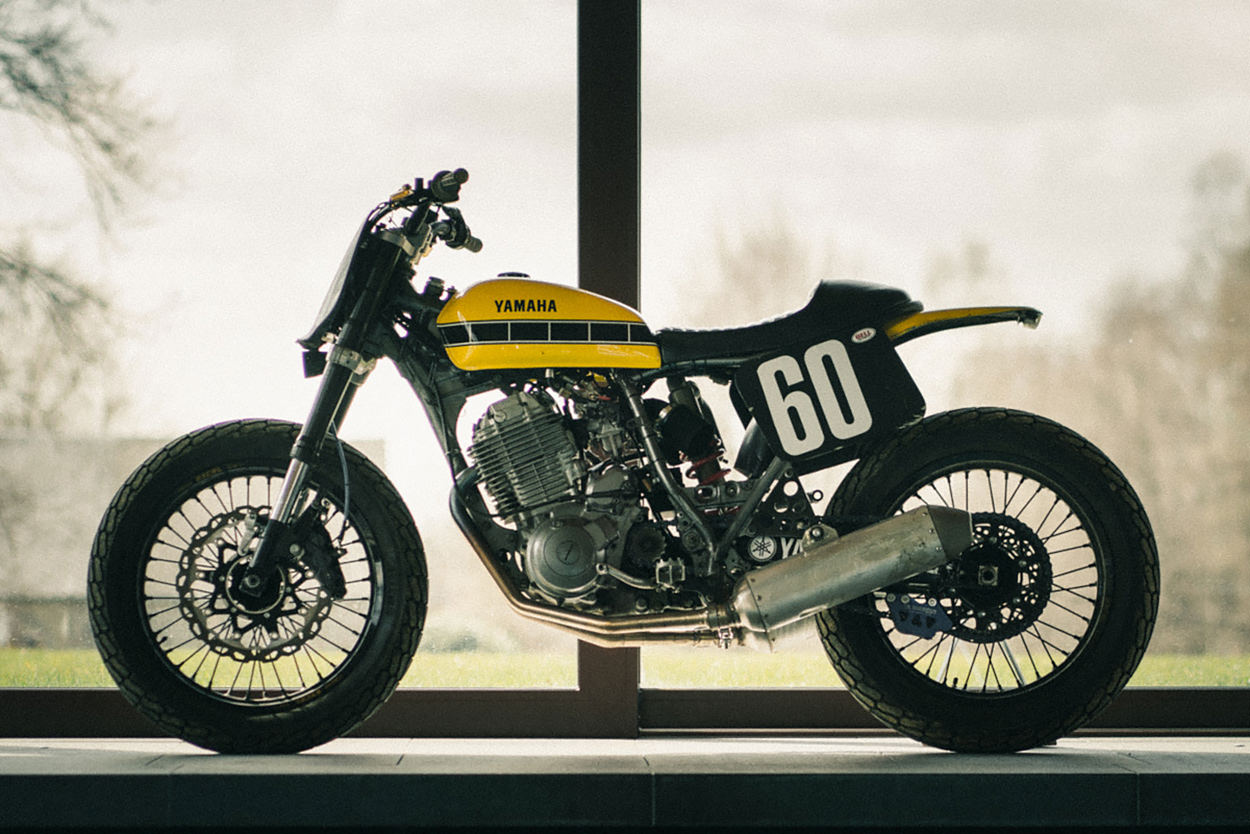
Yamaha XT600 by Wayders It’s almost clichéd to build a Yamaha street tracker and slap ‘Speedblocks’ on it, but we’re absolute suckers for the look. And this XT600 from Didier Hermann and Oliver Nadrin at Wayders is hard to fault. It’s neatly put together with an impressive mashup of parts, and just enough rough edges to make it interesting.
Wayders is a newcomer to the custom scene. Didier founded the car chip company Tuning Box; now retired, his focus is on motorcycles. Olivier is an experienced photographer and videographer, and concentrates on Wayders’ marketing and their upcoming clothing line.
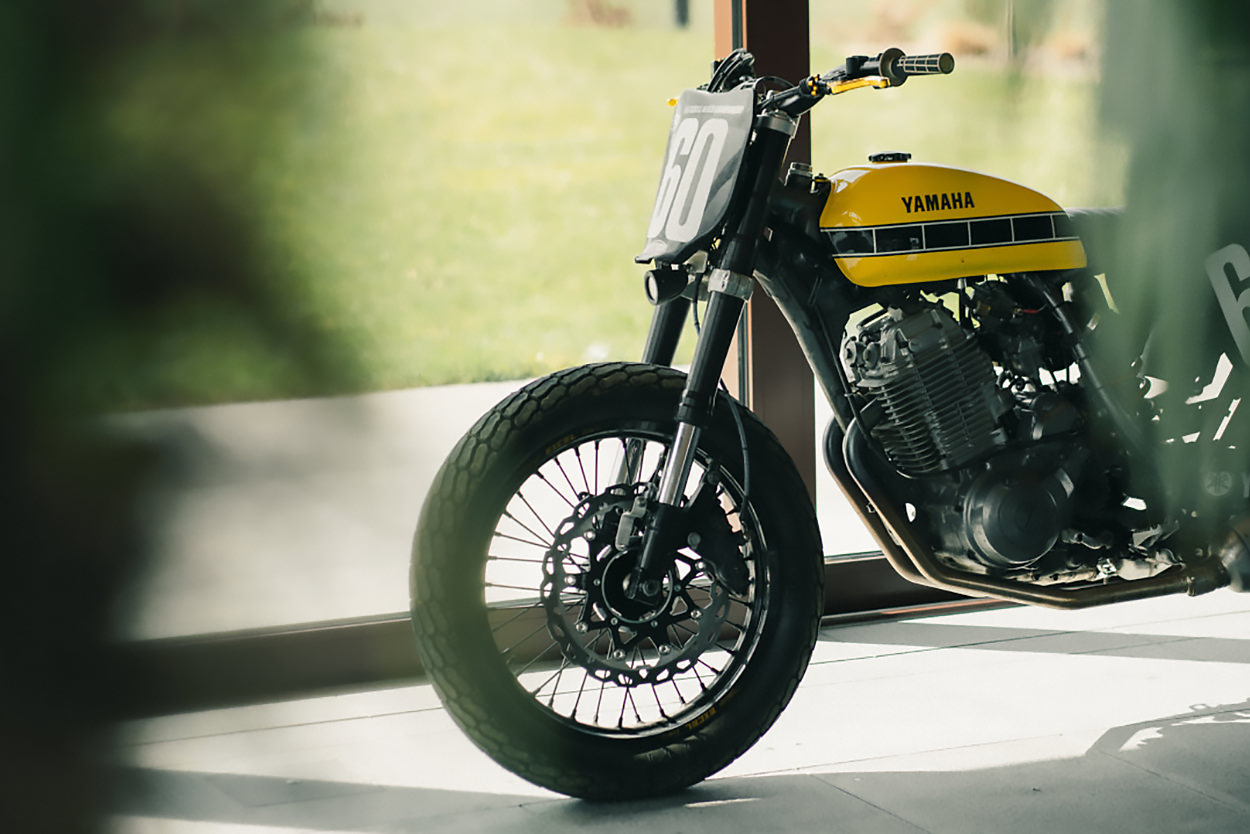
This project started off as a 1990-model Yamaha XT600, a pair of 19” flat track wheels with Excel rims, and no clear way forward. But the ideas snowballed, and it quickly evolved into something a lot more special.
Wayders installed the yokes and forks from a 1995 Yamaha YZ750R in front, and the swingarm, linkages and shock from a 2010 YZ250F out back. The YZ250F also donated its exhaust and handlebars.
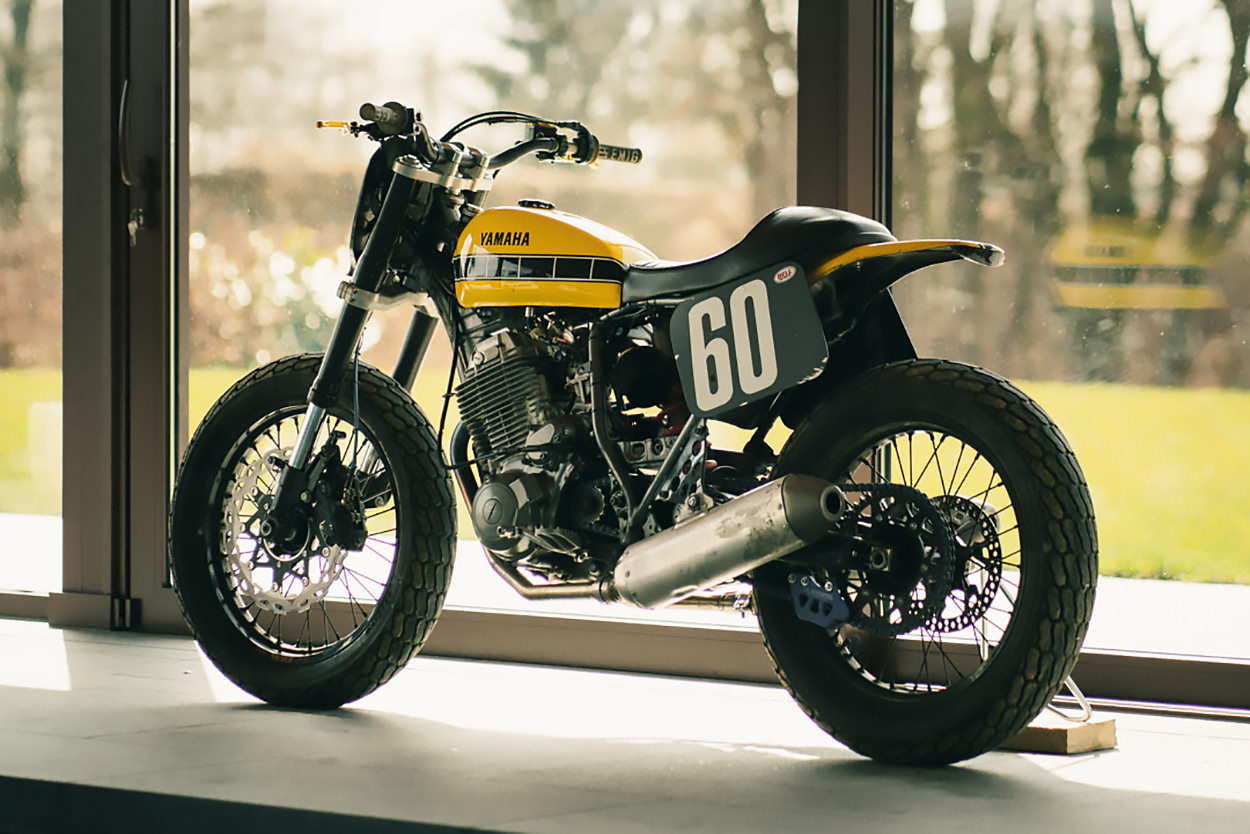
Up top is a vintage fuel tank, matched to a cafe racer-style seat and a surprisingly generous rear fender. The number boards are custom aluminum parts, and the air box has been ditched for a pair of foam filters.
This is the first we’ve seen from Wayders… but we’ll be watching closely from now on. [More]
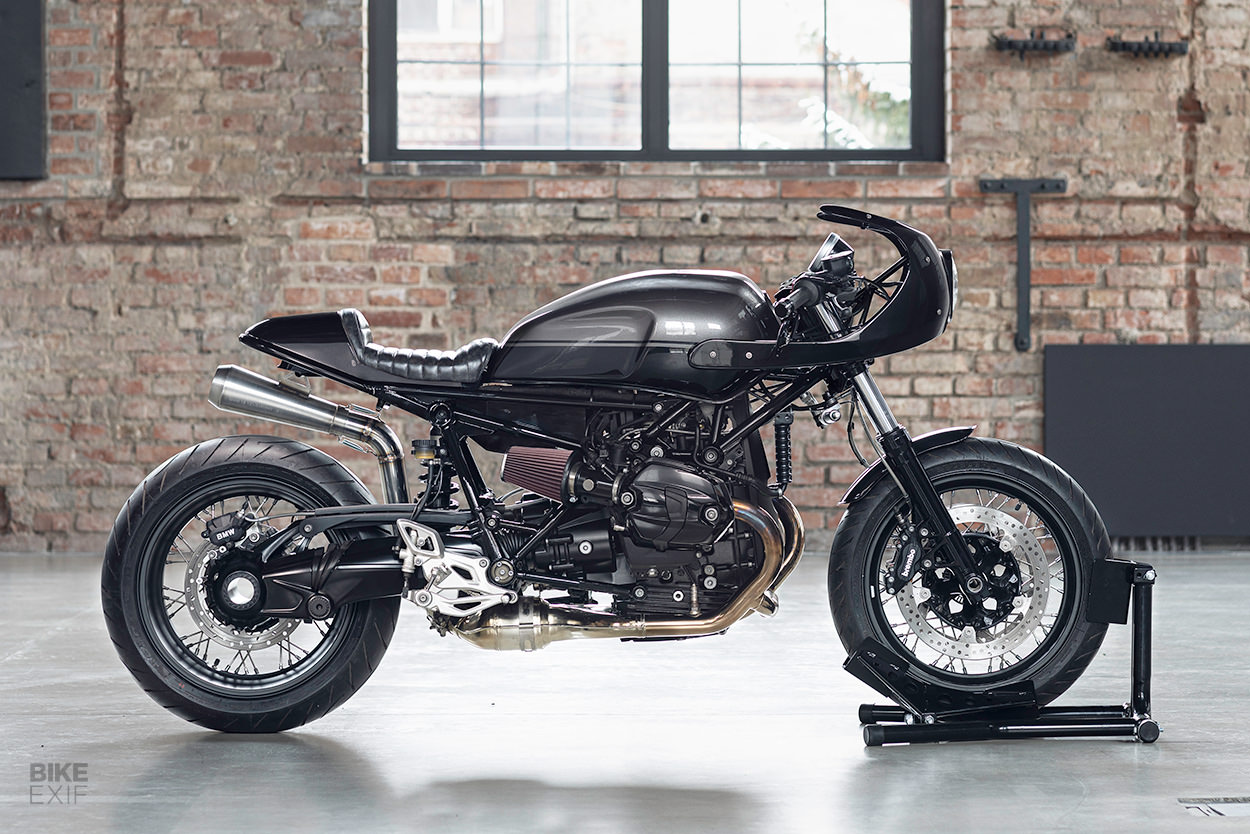
BMW R nineT by Gas & Oil Bespoke Motorcycles The R nineT has been around long enough to make it hard to put a fresh spin on it. But this BMW cafe racer from Gas & Oil in the Czech Republic has a number of unique touches on it, and lives up to the company’s ballsy slogan: “F*ck Establishment.”
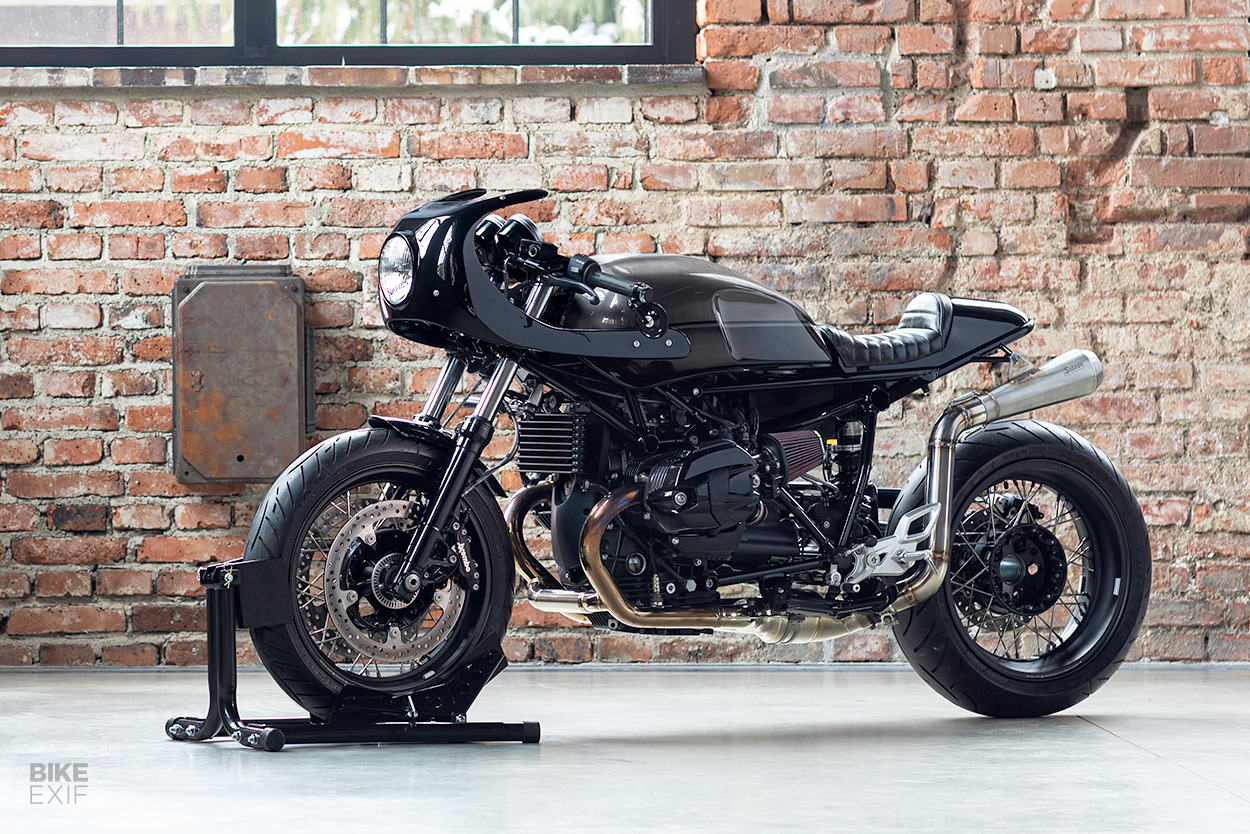
The project came via a client who offered up a brand new bike, a budget, and full faith in the shop. Gas & Oil then set out to build something that would not only be unique, but elegant too, with inspiration from the AMA Superbike racers of the 70s. The mix of bodywork is inspired, with each piece requiring a different process to produce.
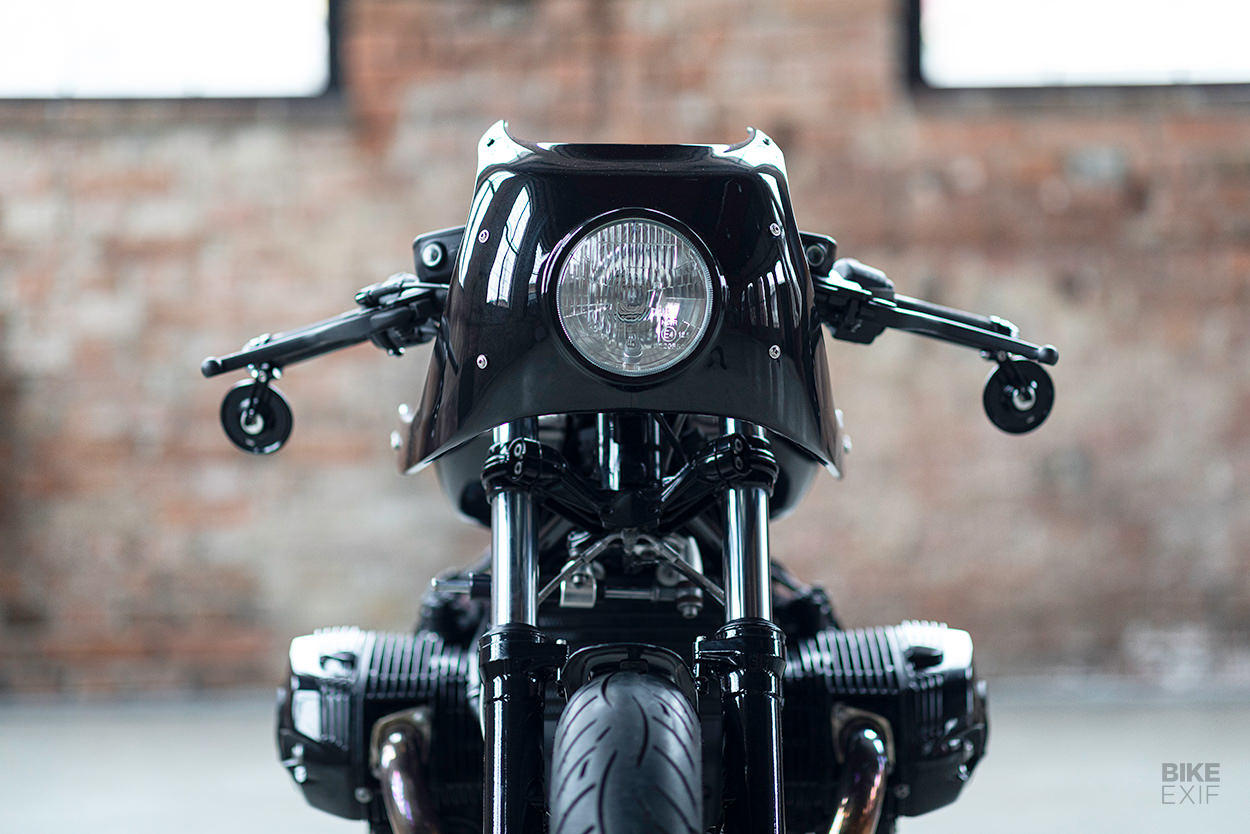
The centerpiece is a Yamaha XJR fuel tank, adapted to fit the nineT and modified to work with the BMW’s stock fuel pump. In front of it is a completely custom fairing—3D designed and printed, and mounted onto a one-off metal framework.
The tail unit’s been formed from aluminum, and sits on a custom subframe.
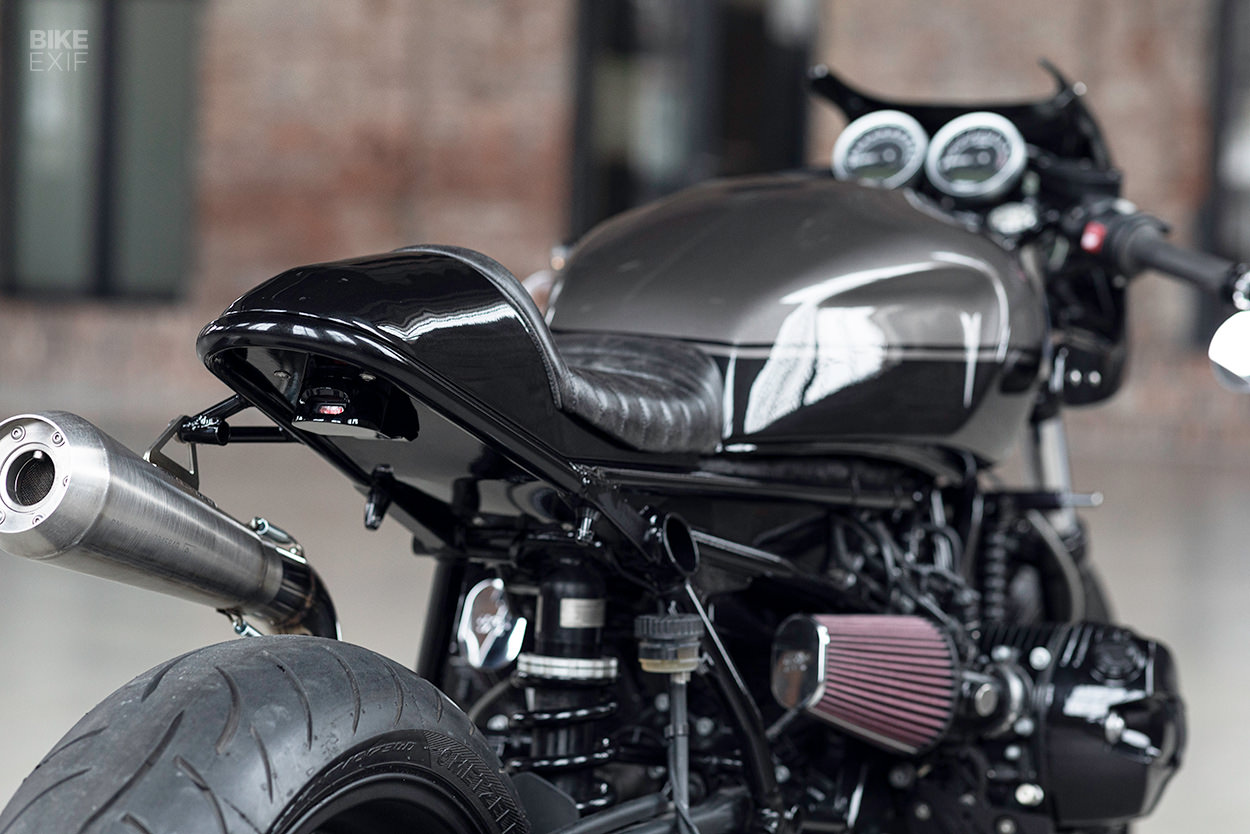
Gas & Oil worked with the Czech brand Sharon to create the exhaust system, then installed K&N filters and a Power Commander to boost the power by 12%. Clip-ons, Motogadget mirrors and bar-end turn signals, and an LED taillight under the tail round out the parts spec.
Finished off in a stealthy black and grey color scheme, with a touch of leather on the seat, it’s a stylish new take on BMW’s new/old boxer. [Gas & Oil Bespoke Motorcycles | Images by Ondrej Zdichynec]
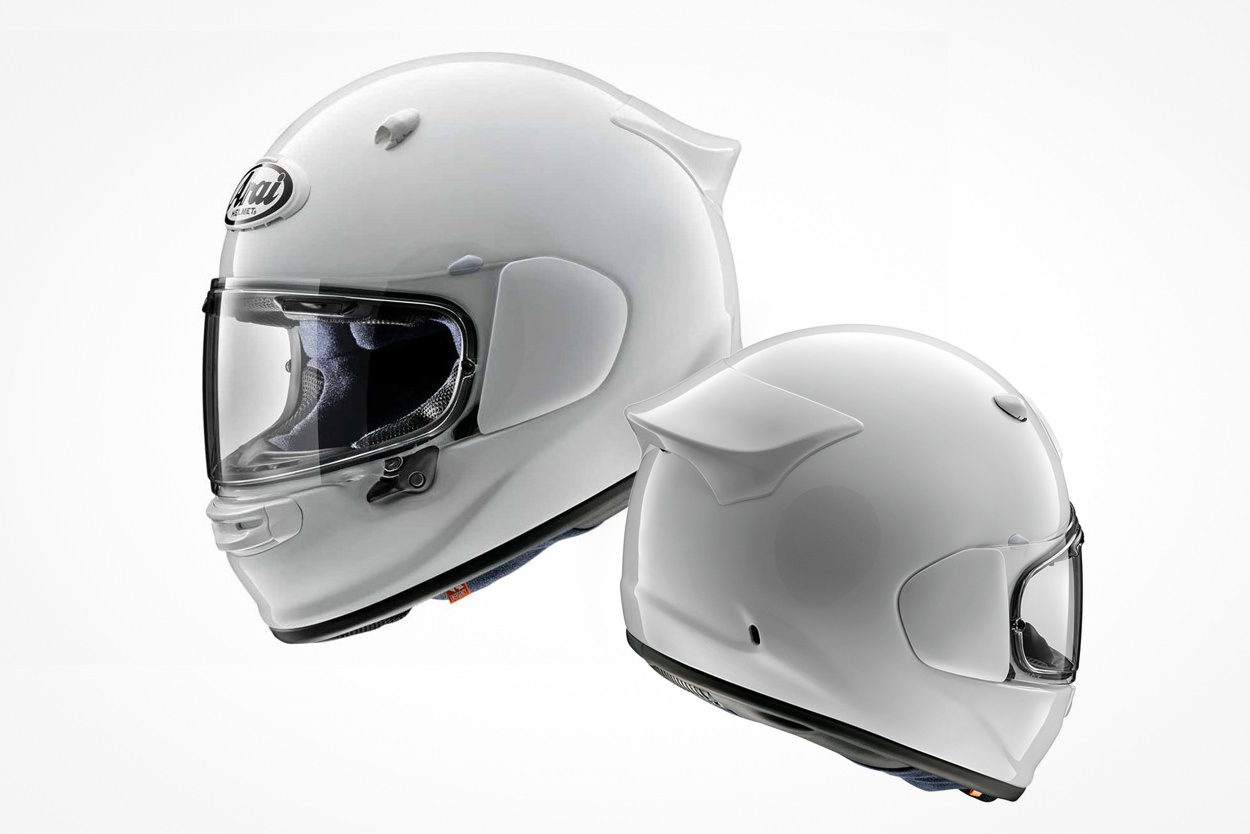
Arai’s ECE 22.06 approved Quantic helmet Check the sticker on the back of any ECE-approved lid on the market right now, and you’ll notice that it meets the ECE 22.05 standard. But there’s a new standard called 22.06 that’s set to replace .05 by 2023, and it’s far more stringent. Right now, there’s only one helmet that conforms to it: Arai’s new Quantic.
Web Bike World reports that the new test involves dropping a weighted anvil on the helmet at speeds of 7.5, 8.2 and 6 meters per second—whereas the 22.05 test only required one vertical drop, at 7.5 m/s. It also requires a 45-degree impact at 8 m/s to test the effect of rotational forces on the helmet, similar to the type of impacts that MIPS technology is design to mitigate. The new standard also uses 12 live-tracking sensors—twice as many as before.
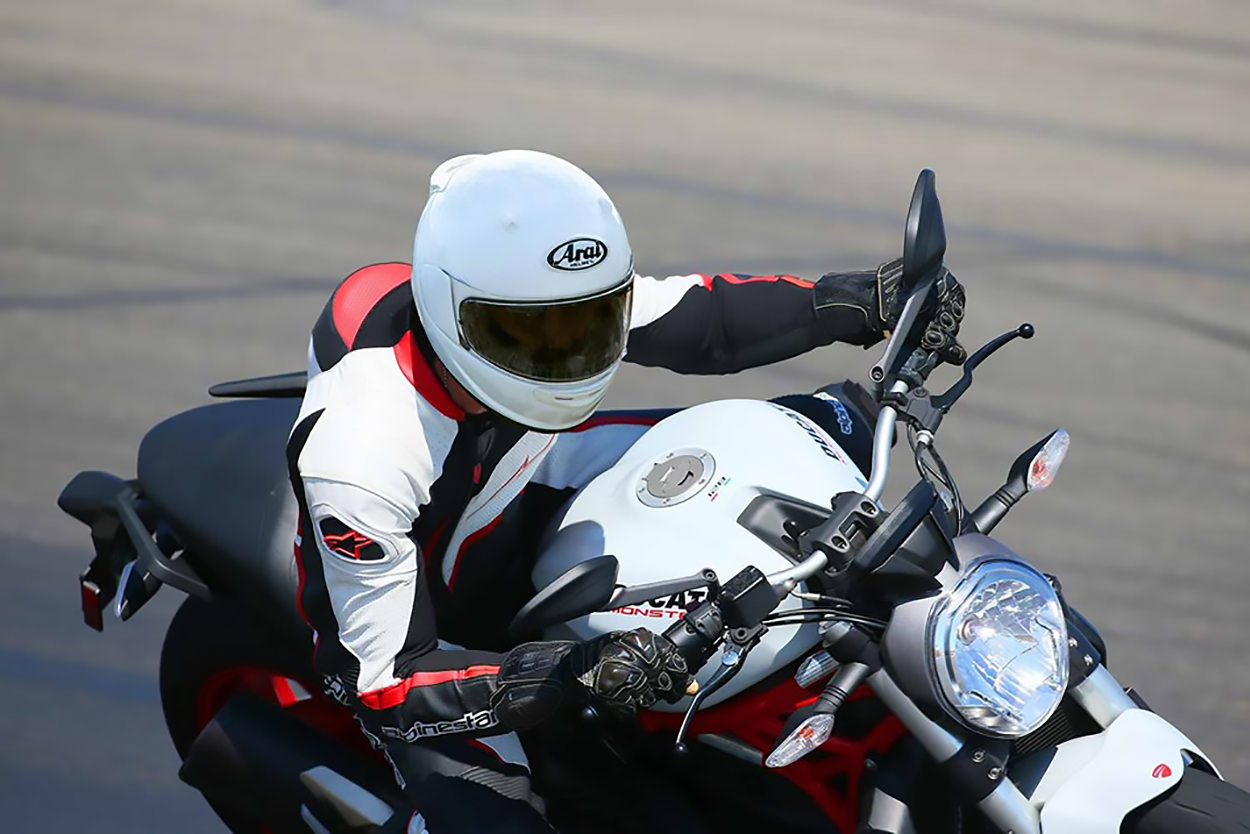
To pass the test, Arai designed the Quantic with an all-new impact absorbing EPS liner, and a shell shape that they say helps to spread impact forces in side-on knocks. And they have also included a ‘super fiber’ reinforcement belt, using a design borrowed from their F1 helmets. Aimed at the sports touring market, the Quantic also includes a Pinlock-equipped visor and weighs 2.6 lbs. It’s currently only listed on Arai’s European website, but we’re sure it’ll reach other markets too. [Source | Arai Quantic]
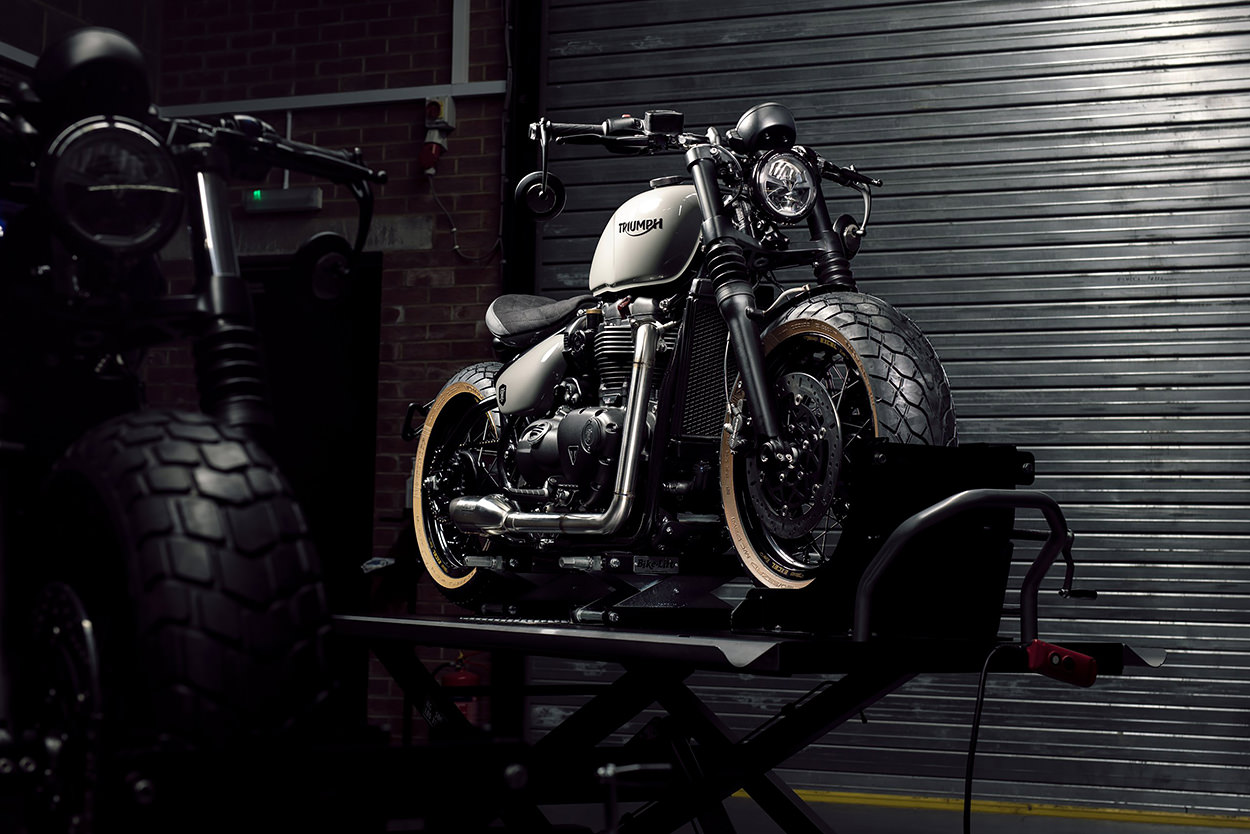
Behind the scenes with Thornton Hundred Fitness author and YouTuber, Joe Wicks, has no less than three custom Triumphs in his garage. And they’re all from the same shop: Thornton Hundred Motorcycles in Milton Keynes, UK.
Now The Body Coach has commissioned a fourth custom from Jody Millhouse and his crew. This time it’s a Triumph Thruxton RS, and the guys are documenting the build in a YouTube series. Episode one [below] focuses on Jody designing and refining a 3D-printed electronics tray for the Thruxton’s vast array of gadgetry. It’s a great look inside a top-shelf custom shop—so grab the popcorn and tune in. [Thornton Hundred]
Continue reading...

We’re kicking things off this week with a chic Triumph Street Twin from FCR Original. We’ve also got a BMW R nineT from Gas & Oil, a Yamaha XT600 street tracker, Arai’s new ECE 22.06 approved helmet, and a look inside Thronton Hundred’s workshop.

Triumph Street Twin by FCR Original Thanks to its mag wheels and upswept exhausts, the Street Twin is the least retro-looking motorcycle in Triumph’s range of modern classics. But this custom from the French shop FCR Original has such a classic vibe, we didn’t realize it was a Street Twin until shop boss Sébastien Guillemot told us.

FCR Original have a way with neo-retro Triumphs, so it’s no surprise that this is their work. The biggest hit here is the duck blue paint on the tank—along with the chrome knee indents and period-correct tank badges. The shop has also traded the mudguards for classic alloy units, and swapped out the saddle.
The other big change is the wheels: FCR swapped the 18F/17R wheels for a pair of 18” spoked items, using aluminum Morad rims and Dunlop TT100 and K81 tires.

The new rear suspenders are from Shock Factory, and the exhaust mufflers are from FCR’s own catalog of Triumph-specific parts.The build’s finished off with a host of subtle tweaks—like vintage lighting, new turn signals and an FCR plate holder.

The chromed handlebars are from FCR’s shop too, and wear Kustom Tech brake and clutch controls. There’s also a Monza gas cap, new side covers, and brushed Triumph engine covers.
The best part is where the commission came from: the owner already has one FCR Original Triumph, and wanted a second so that he and his wife can ride together. [FCR Original | Images by Mitch Canon]

Yamaha XT600 by Wayders It’s almost clichéd to build a Yamaha street tracker and slap ‘Speedblocks’ on it, but we’re absolute suckers for the look. And this XT600 from Didier Hermann and Oliver Nadrin at Wayders is hard to fault. It’s neatly put together with an impressive mashup of parts, and just enough rough edges to make it interesting.
Wayders is a newcomer to the custom scene. Didier founded the car chip company Tuning Box; now retired, his focus is on motorcycles. Olivier is an experienced photographer and videographer, and concentrates on Wayders’ marketing and their upcoming clothing line.

This project started off as a 1990-model Yamaha XT600, a pair of 19” flat track wheels with Excel rims, and no clear way forward. But the ideas snowballed, and it quickly evolved into something a lot more special.
Wayders installed the yokes and forks from a 1995 Yamaha YZ750R in front, and the swingarm, linkages and shock from a 2010 YZ250F out back. The YZ250F also donated its exhaust and handlebars.

Up top is a vintage fuel tank, matched to a cafe racer-style seat and a surprisingly generous rear fender. The number boards are custom aluminum parts, and the air box has been ditched for a pair of foam filters.
This is the first we’ve seen from Wayders… but we’ll be watching closely from now on. [More]

BMW R nineT by Gas & Oil Bespoke Motorcycles The R nineT has been around long enough to make it hard to put a fresh spin on it. But this BMW cafe racer from Gas & Oil in the Czech Republic has a number of unique touches on it, and lives up to the company’s ballsy slogan: “F*ck Establishment.”

The project came via a client who offered up a brand new bike, a budget, and full faith in the shop. Gas & Oil then set out to build something that would not only be unique, but elegant too, with inspiration from the AMA Superbike racers of the 70s. The mix of bodywork is inspired, with each piece requiring a different process to produce.

The centerpiece is a Yamaha XJR fuel tank, adapted to fit the nineT and modified to work with the BMW’s stock fuel pump. In front of it is a completely custom fairing—3D designed and printed, and mounted onto a one-off metal framework.
The tail unit’s been formed from aluminum, and sits on a custom subframe.

Gas & Oil worked with the Czech brand Sharon to create the exhaust system, then installed K&N filters and a Power Commander to boost the power by 12%. Clip-ons, Motogadget mirrors and bar-end turn signals, and an LED taillight under the tail round out the parts spec.
Finished off in a stealthy black and grey color scheme, with a touch of leather on the seat, it’s a stylish new take on BMW’s new/old boxer. [Gas & Oil Bespoke Motorcycles | Images by Ondrej Zdichynec]

Arai’s ECE 22.06 approved Quantic helmet Check the sticker on the back of any ECE-approved lid on the market right now, and you’ll notice that it meets the ECE 22.05 standard. But there’s a new standard called 22.06 that’s set to replace .05 by 2023, and it’s far more stringent. Right now, there’s only one helmet that conforms to it: Arai’s new Quantic.
Web Bike World reports that the new test involves dropping a weighted anvil on the helmet at speeds of 7.5, 8.2 and 6 meters per second—whereas the 22.05 test only required one vertical drop, at 7.5 m/s. It also requires a 45-degree impact at 8 m/s to test the effect of rotational forces on the helmet, similar to the type of impacts that MIPS technology is design to mitigate. The new standard also uses 12 live-tracking sensors—twice as many as before.

To pass the test, Arai designed the Quantic with an all-new impact absorbing EPS liner, and a shell shape that they say helps to spread impact forces in side-on knocks. And they have also included a ‘super fiber’ reinforcement belt, using a design borrowed from their F1 helmets. Aimed at the sports touring market, the Quantic also includes a Pinlock-equipped visor and weighs 2.6 lbs. It’s currently only listed on Arai’s European website, but we’re sure it’ll reach other markets too. [Source | Arai Quantic]

Behind the scenes with Thornton Hundred Fitness author and YouTuber, Joe Wicks, has no less than three custom Triumphs in his garage. And they’re all from the same shop: Thornton Hundred Motorcycles in Milton Keynes, UK.
Now The Body Coach has commissioned a fourth custom from Jody Millhouse and his crew. This time it’s a Triumph Thruxton RS, and the guys are documenting the build in a YouTube series. Episode one [below] focuses on Jody designing and refining a 3D-printed electronics tray for the Thruxton’s vast array of gadgetry. It’s a great look inside a top-shelf custom shop—so grab the popcorn and tune in. [Thornton Hundred]
Continue reading...
OLD SCHOOL COOL: 1955 Harley-Davidson Panhead by Prism Supply Co.
Put on the spot and asked to describe a traditional American custom motorcycle, this is exactly what I’ve always had in mind. But for a brief and frightening period it seemed that over the top, theme style choppers were going to take over. The last time we touched base with North Carolina’s Prism Supply Co. we wondered out loud if, “maybe, just maybe, the general public is moving away from God...
Source
Put on the spot and asked to describe a traditional American custom motorcycle, this is exactly what I’ve always had in mind. But for a brief and frightening period it seemed that over the top, theme style choppers were going to take over. The last time we touched base with North Carolina’s Prism Supply Co. we wondered out loud if, “maybe, just maybe, the general public is moving away from God...
Source
Tokyo Drifter: A Yamaha XV750 street tracker from Japan
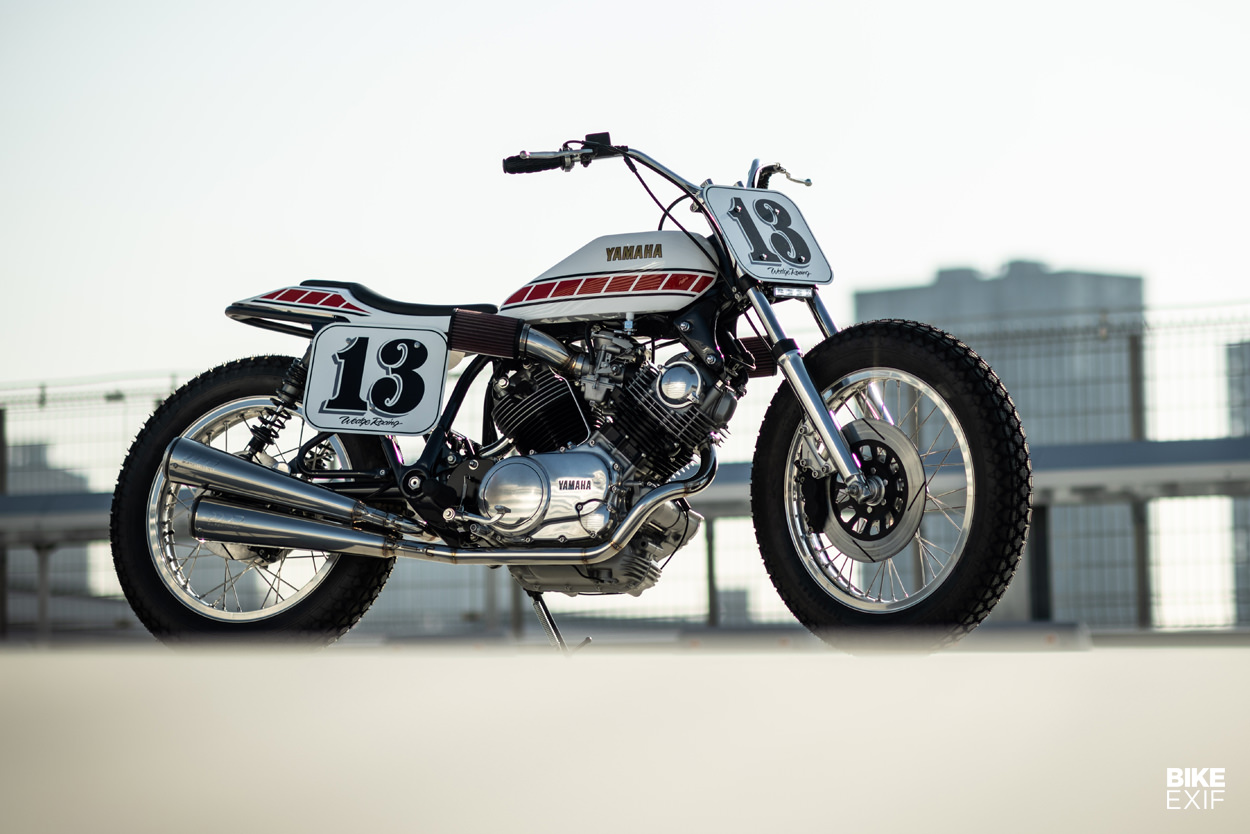
Forty years ago, Yamaha made a brief foray into the flat track scene in the States with its XV750 race bike. Like most go-fast, turn-left machines, it was a bit of a looker—and provided inspiration for this phenomenal street tracker from Takashi Nihira.
Nihira-san runs Wedge Motorcycle, one of the top Japanese custom shops. He’s won multiple awards at the Yokohama Hot Rod Custom Show and was tapped by BMW to participate in their G310R custom project.
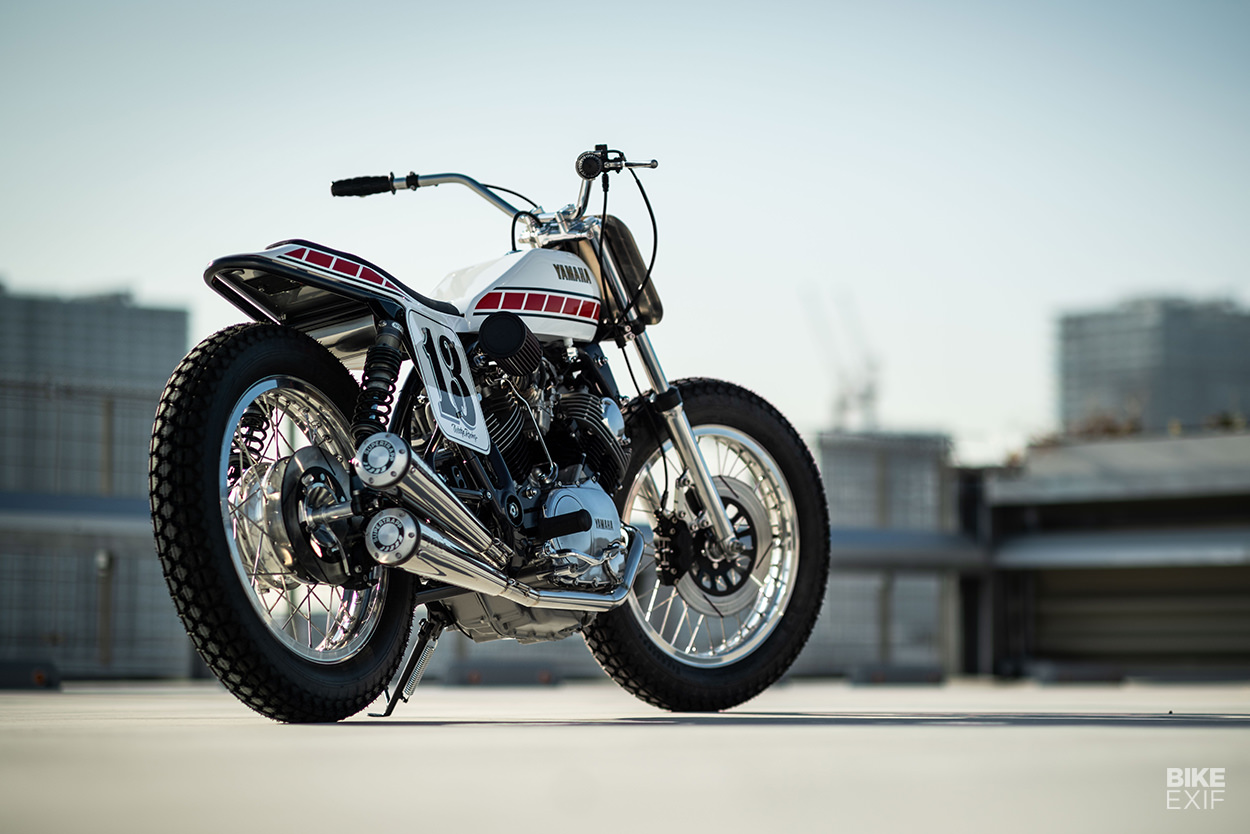
This XV750 is a commission, from a customer who’s a fan of the XV750 flat tracker that Yamaha campaigned in the AMA Grand National Championship in the early 1980s.
That race project lasted just a couple of years, despite Yamaha shipping 75 engines to the States. They made them available to privateers for just $2,000, and hired Kenny Roberts and Mert Lawwill for the team.
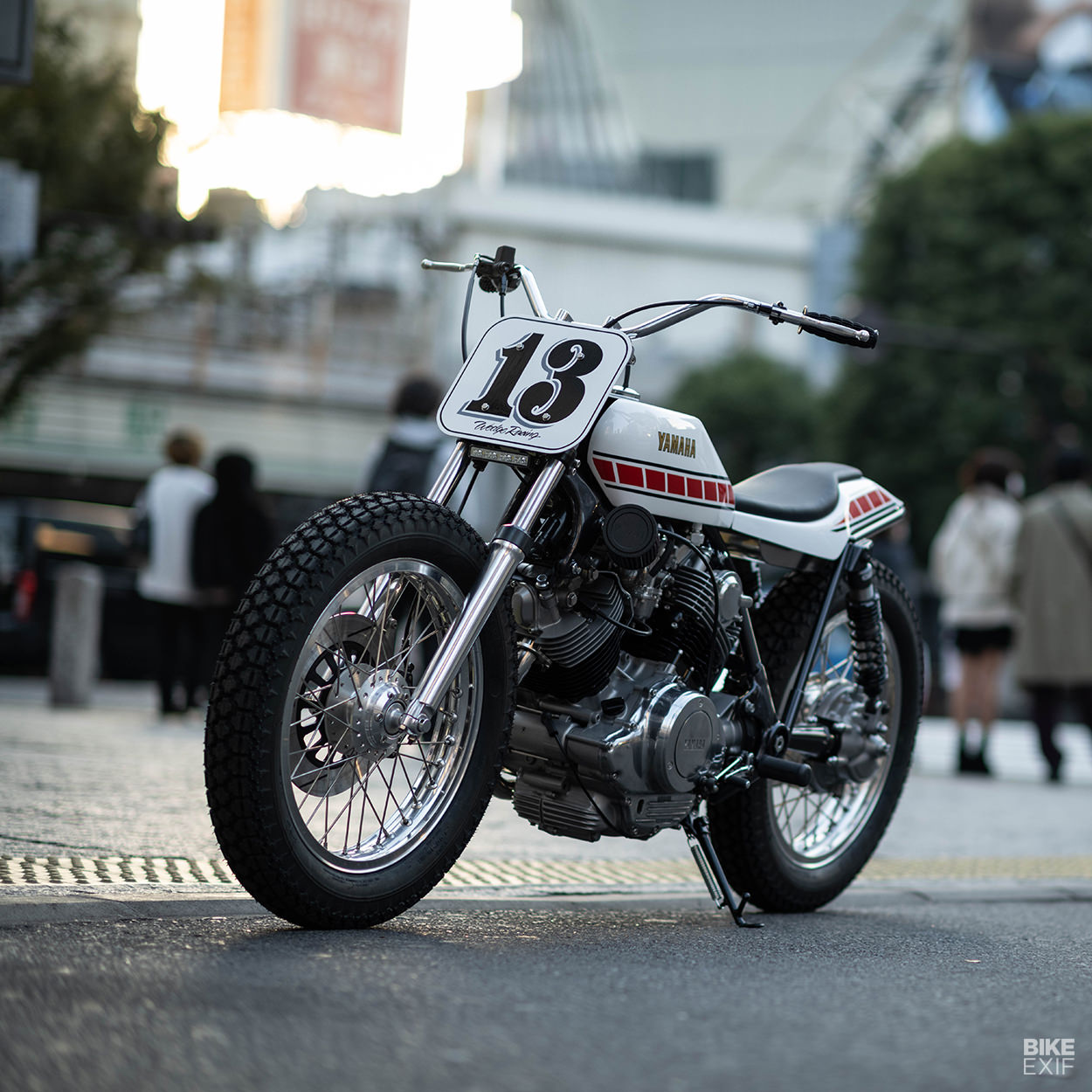
The engines were not short of grunt, and were rumored to be in the same 80 hp ballpark as contemporary XR750s.
The donor bike for this build was a 1981 Yamaha XV750 Special. In stock form this model is a slightly ungainly ‘custom’ V-twin with shaft drive, and bloated bodywork that sends wet weight into the region of 500 pounds—a far cry from the low and lithe machine that Wedge have created.
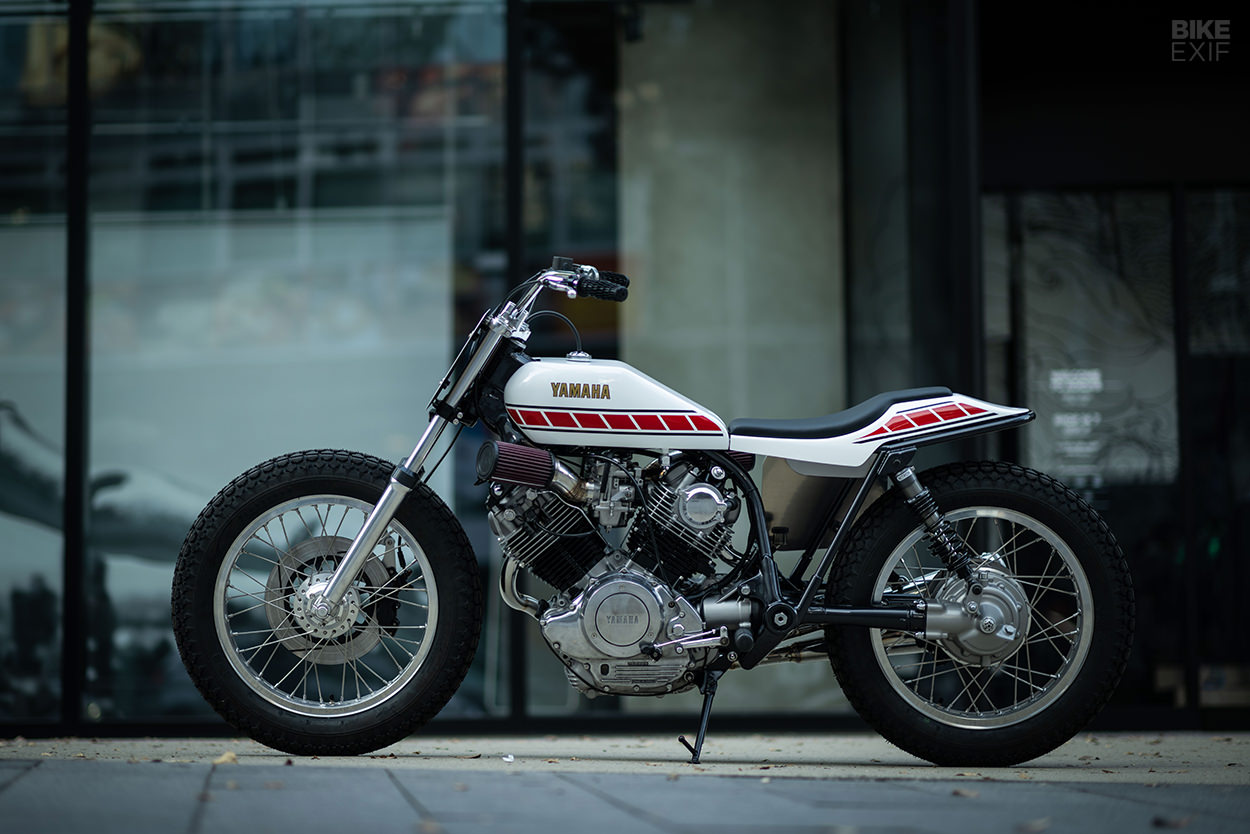
Wedge’s customer already owned the XV750 before he dropped it off at the workshop in the western suburbs of Tokyo. To make the build easier, the client also helped search for hard-to-find parts in the USA, and imported those parts into Japan himself.
Wedge started with an engine teardown to reverse four decades of use. New pistons are matched to a refurbished bottom end and cylinder heads, and the Hitachi carbs have been treated to K&N filter pods.
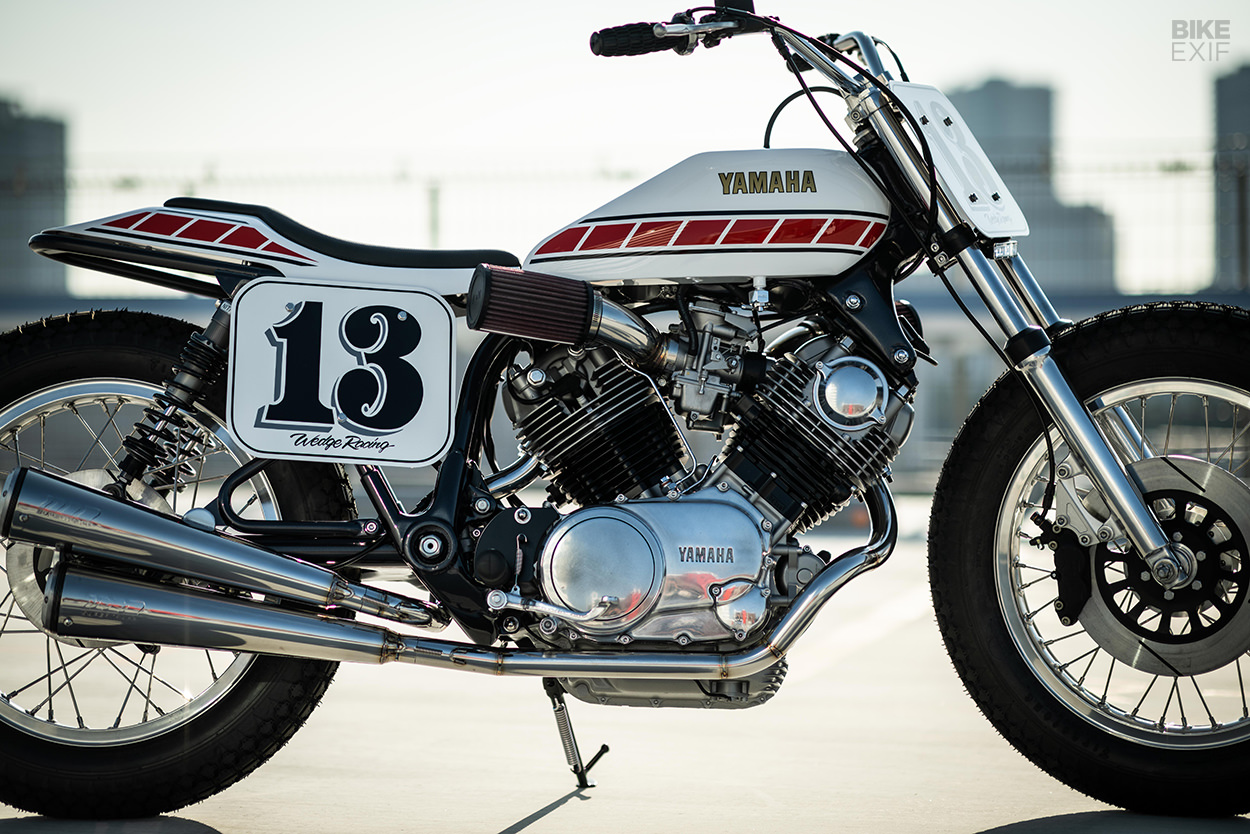
New exhaust pipework hugs the contours of the engine and frame, terminating in a pair of SuperTrapp megaphone mufflers.
Wedge have also fabricated a new seat rail at the back, and topped it off with a slim flat track tail/seat unit. But that was a simple exercise compared to the swingarm. The XV750 Special was an early example of a monoshock bike, but the flat track look requires conventional twin shocks.
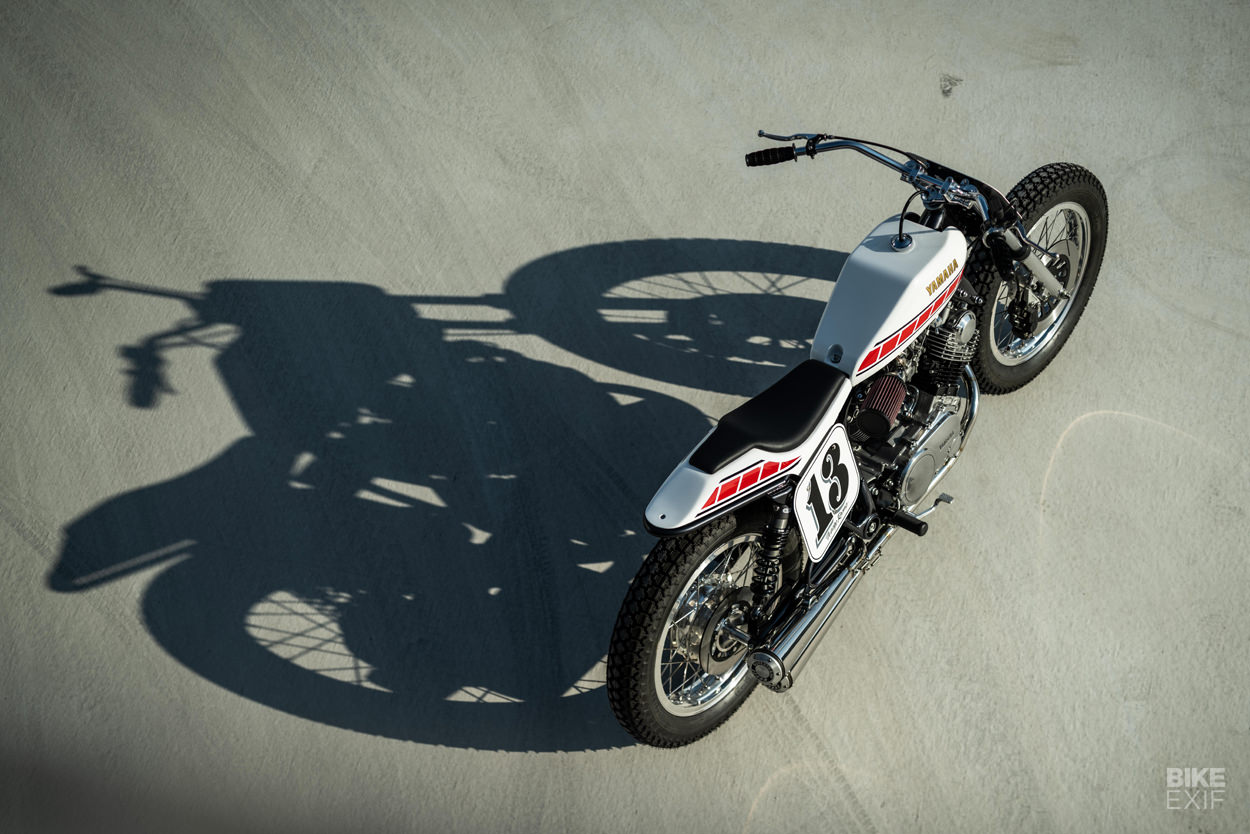
So Nihira-san has modified the swingarm from an XV750 Virago, which had twin shocks and therefore the essential mounting points. “It did not work well as a simple replacement, so I modified the mounting positions and the swingarm pivot. It now moves smoothly.” The new shocks are UK-built Nitrons.
The front suspension is a mix of Yamaha parts to suit the style of the bike. Wedge have taken the forks and steering neck from an XS650, and mated them to a modified top yoke from an SR400.
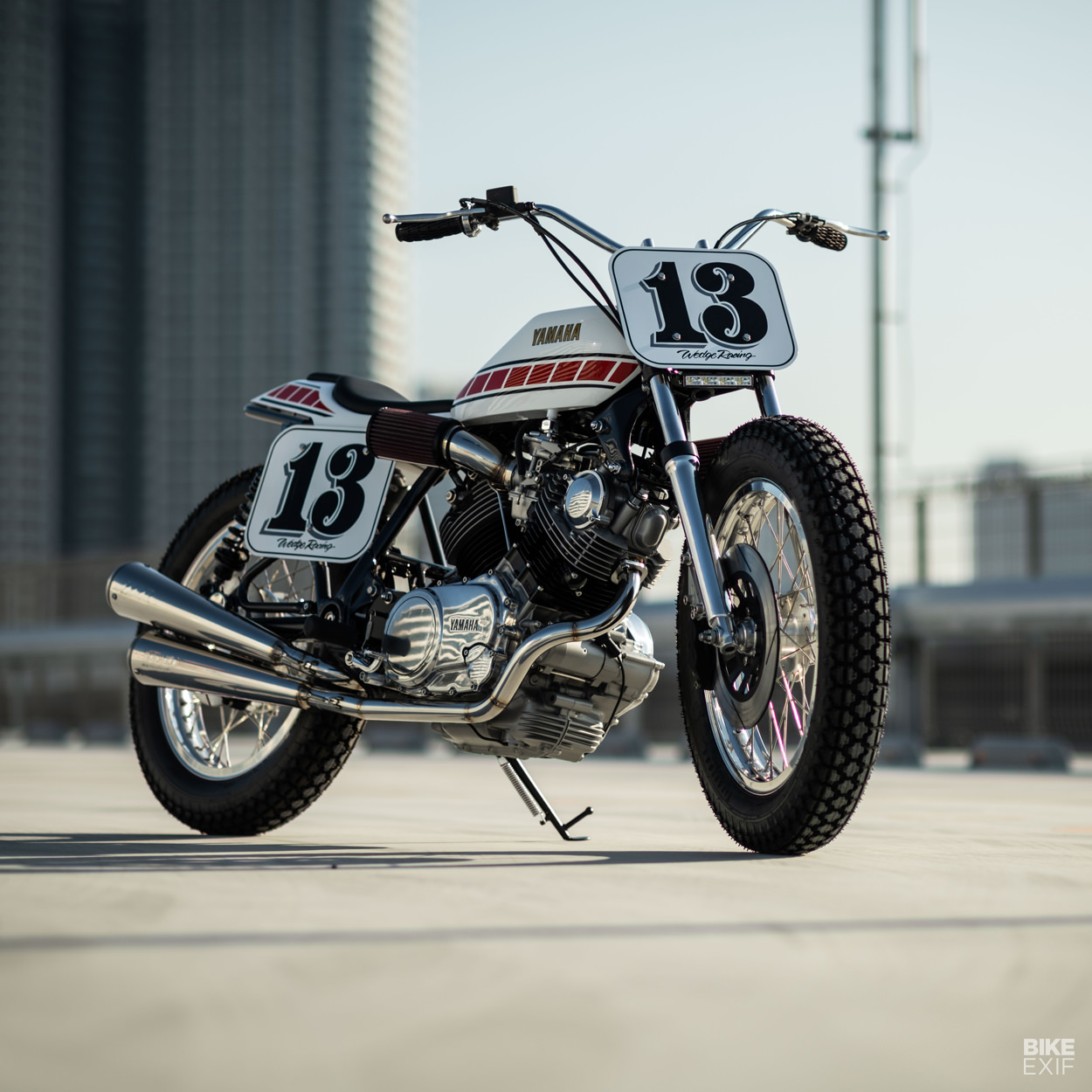
Just ahead is Motogadget’s smallest speedo, the Motoscope Mini, and tucked under the classic square number is a simple rectangular LED headlight. The turn signals are tiny Kellermann units.
A Sunstar rotor is hooked up to the front hub, with Brembo four-pot calipers activated by a Grimeca master cylinder. The 19-inch wheels have classic high-shouldered ‘H’ profile rims, and the tubed tires are Firestone’s modern update of the iconic ANS tread pattern, at 4.00 section both front and back.
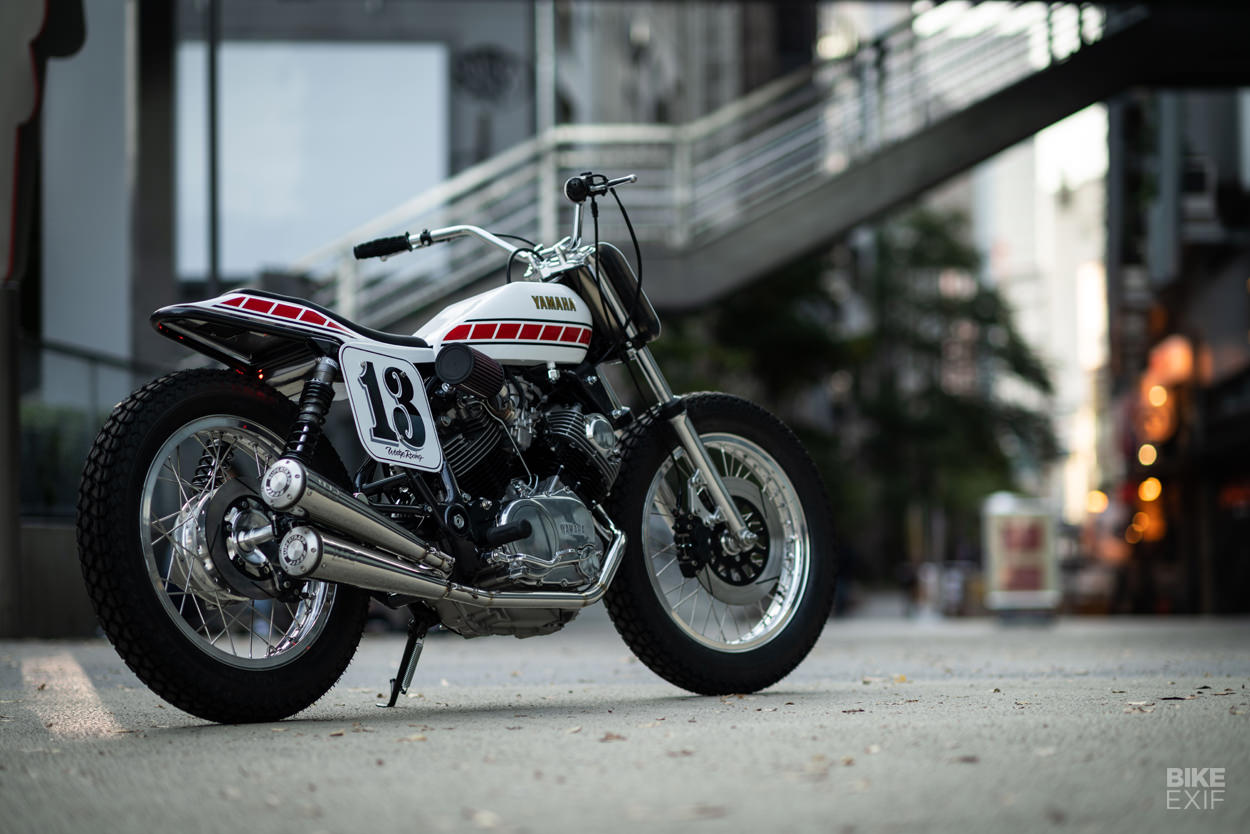
Rear braking is handled by a new Sunstar rotor and Brembo two-pot calipers, this time plumbed up to a Nissin cylinder.
The cream on the cake is the new tank, hand-shaped out of steel and crafted so expertly, it could be a factory fitment. Wedge are renowned for their paint, and have finished off the bodywork in understated solid white—plus the iconic Yamaha ‘speed blocks.’
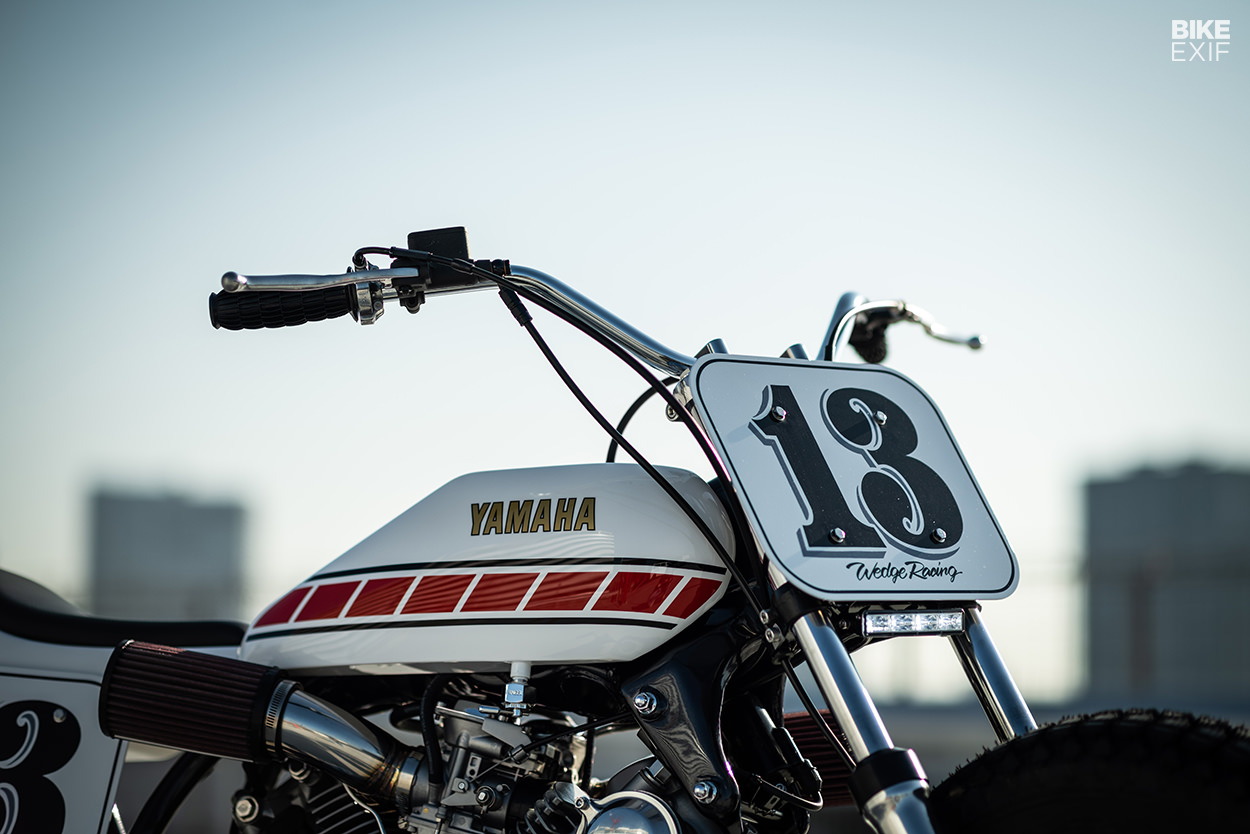
Wedge’s XV750 is not the most radical custom build we’ve ever seen, but it caused a sharp intake of breath as soon as we saw the images—and that doesn’t happen often.
We’d park this baby in the EXIF garage in a heartbeat.
Wedge Motorcycle | Facebook | Instagram | Images by Hiromitsu Yasui | With thanks to Tadashi Kohno
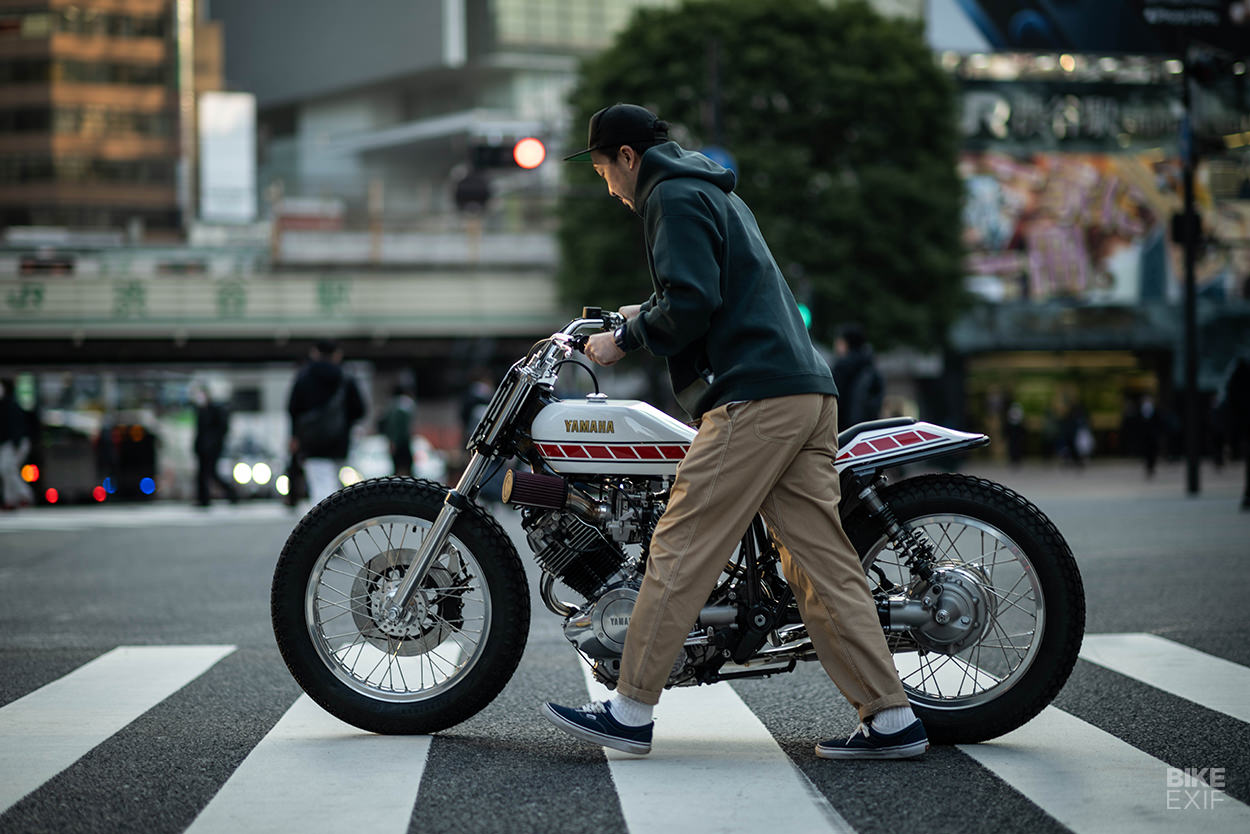
Continue reading...

Forty years ago, Yamaha made a brief foray into the flat track scene in the States with its XV750 race bike. Like most go-fast, turn-left machines, it was a bit of a looker—and provided inspiration for this phenomenal street tracker from Takashi Nihira.
Nihira-san runs Wedge Motorcycle, one of the top Japanese custom shops. He’s won multiple awards at the Yokohama Hot Rod Custom Show and was tapped by BMW to participate in their G310R custom project.

This XV750 is a commission, from a customer who’s a fan of the XV750 flat tracker that Yamaha campaigned in the AMA Grand National Championship in the early 1980s.
That race project lasted just a couple of years, despite Yamaha shipping 75 engines to the States. They made them available to privateers for just $2,000, and hired Kenny Roberts and Mert Lawwill for the team.

The engines were not short of grunt, and were rumored to be in the same 80 hp ballpark as contemporary XR750s.
The donor bike for this build was a 1981 Yamaha XV750 Special. In stock form this model is a slightly ungainly ‘custom’ V-twin with shaft drive, and bloated bodywork that sends wet weight into the region of 500 pounds—a far cry from the low and lithe machine that Wedge have created.

Wedge’s customer already owned the XV750 before he dropped it off at the workshop in the western suburbs of Tokyo. To make the build easier, the client also helped search for hard-to-find parts in the USA, and imported those parts into Japan himself.
Wedge started with an engine teardown to reverse four decades of use. New pistons are matched to a refurbished bottom end and cylinder heads, and the Hitachi carbs have been treated to K&N filter pods.

New exhaust pipework hugs the contours of the engine and frame, terminating in a pair of SuperTrapp megaphone mufflers.
Wedge have also fabricated a new seat rail at the back, and topped it off with a slim flat track tail/seat unit. But that was a simple exercise compared to the swingarm. The XV750 Special was an early example of a monoshock bike, but the flat track look requires conventional twin shocks.

So Nihira-san has modified the swingarm from an XV750 Virago, which had twin shocks and therefore the essential mounting points. “It did not work well as a simple replacement, so I modified the mounting positions and the swingarm pivot. It now moves smoothly.” The new shocks are UK-built Nitrons.
The front suspension is a mix of Yamaha parts to suit the style of the bike. Wedge have taken the forks and steering neck from an XS650, and mated them to a modified top yoke from an SR400.

Just ahead is Motogadget’s smallest speedo, the Motoscope Mini, and tucked under the classic square number is a simple rectangular LED headlight. The turn signals are tiny Kellermann units.
A Sunstar rotor is hooked up to the front hub, with Brembo four-pot calipers activated by a Grimeca master cylinder. The 19-inch wheels have classic high-shouldered ‘H’ profile rims, and the tubed tires are Firestone’s modern update of the iconic ANS tread pattern, at 4.00 section both front and back.

Rear braking is handled by a new Sunstar rotor and Brembo two-pot calipers, this time plumbed up to a Nissin cylinder.
The cream on the cake is the new tank, hand-shaped out of steel and crafted so expertly, it could be a factory fitment. Wedge are renowned for their paint, and have finished off the bodywork in understated solid white—plus the iconic Yamaha ‘speed blocks.’

Wedge’s XV750 is not the most radical custom build we’ve ever seen, but it caused a sharp intake of breath as soon as we saw the images—and that doesn’t happen often.
We’d park this baby in the EXIF garage in a heartbeat.
Wedge Motorcycle | Facebook | Instagram | Images by Hiromitsu Yasui | With thanks to Tadashi Kohno

Continue reading...
PRECIOUS METAL: BMW R100 by Incerum Customs.
Located in eastern Croatia is a city named Požega, known as the Golden Valley. The region is famous for its rich place in the history of the Roman Empire and its rare copper and bronze archaeological finds. So it’s fitting that Incerum Customs are based in this historic tourist town, using the ancient skills of metalworking to resurrect vintage motorcycles. The latest build to roll out of their...
Source
Located in eastern Croatia is a city named Požega, known as the Golden Valley. The region is famous for its rich place in the history of the Roman Empire and its rare copper and bronze archaeological finds. So it’s fitting that Incerum Customs are based in this historic tourist town, using the ancient skills of metalworking to resurrect vintage motorcycles. The latest build to roll out of their...
Source
TWO-ARMED BANDIT: Suzuki GSF650 by Crooked Motorcycles.
A custom bike building business can have all the tools in the world, the best technicians and decades of experience, but when the customer wants you to focus their build on their current bike, you’re at the mercy of their chosen machine. Some clients will turn up with a BMW R or Honda CB and it’s smooth sailing, others want their Kawasaki ZZR turned into something cool and the headaches soon turn...
Source
A custom bike building business can have all the tools in the world, the best technicians and decades of experience, but when the customer wants you to focus their build on their current bike, you’re at the mercy of their chosen machine. Some clients will turn up with a BMW R or Honda CB and it’s smooth sailing, others want their Kawasaki ZZR turned into something cool and the headaches soon turn...
Source
MASTER AT WORK: BMW R100RS by Wedge Motorcycle.
If you’ve seen the documentary series “Our Guy in Japan”, you would have witnessed the sheer childlike delight that Guy Martin had when spending time with an 83-year-old engineering grandmaster and 70-year-old master swordsmith. It’s the same giddy joy that we get at Pipeburn HQ when a bike comes in from one of Japan’s best builders, so astonished that one man can possess so much talent and skill...
Source
If you’ve seen the documentary series “Our Guy in Japan”, you would have witnessed the sheer childlike delight that Guy Martin had when spending time with an 83-year-old engineering grandmaster and 70-year-old master swordsmith. It’s the same giddy joy that we get at Pipeburn HQ when a bike comes in from one of Japan’s best builders, so astonished that one man can possess so much talent and skill...
Source
NO GUZZ, NO GLORY: Moto Guzzi V65 by JM Customs.
Summon a Moto Guzzi into your mind and you tend to think of a large motorcycle with even bigger cylinders hanging out the side and something that’s carrying a bit of weight. So while they’ve played with small bikes and mopeds in the past, they have at their heart a big bike philosophy, hell they even built a V8 engine to go Grand Prix racing. But in amongst the bruisers have been some lightweight...
Source
Summon a Moto Guzzi into your mind and you tend to think of a large motorcycle with even bigger cylinders hanging out the side and something that’s carrying a bit of weight. So while they’ve played with small bikes and mopeds in the past, they have at their heart a big bike philosophy, hell they even built a V8 engine to go Grand Prix racing. But in amongst the bruisers have been some lightweight...
Source
SUPER SCRAMBLER: KTM Duke 690 by KickMoto.
The riding season in Nova Scotia, Canada, is a pretty short one compared to other parts of the world. So when the weather is good, the good get going. With hundreds of miles of beautiful blacktop on the legendary Cabot Trail to enjoy, you’d want to make the most of it on the right bike. Jeff Shaw, who is one half of Halifax-based KickMoto, knows the area well. After spending the last year riding a...
Source
The riding season in Nova Scotia, Canada, is a pretty short one compared to other parts of the world. So when the weather is good, the good get going. With hundreds of miles of beautiful blacktop on the legendary Cabot Trail to enjoy, you’d want to make the most of it on the right bike. Jeff Shaw, who is one half of Halifax-based KickMoto, knows the area well. After spending the last year riding a...
Source
BOLT-ON BEAUTY: Royal Enfield Continental GT 650 by Mark ‘FKN’ Hawwa.
The man, the myth, the legend; he’s still got his full set of ears and an even fuller beard, so make way Mark ‘Chopper’ Read, it’s our very own and slightly more attractive Aussie knockabout, Mark ‘FKN’ Hawwa. The big man with the even bigger heart is the brains behind events like the famed Distinguished Gentleman’s Ride, which has raised millions of dollars from every corner of the globe for...
Source
The man, the myth, the legend; he’s still got his full set of ears and an even fuller beard, so make way Mark ‘Chopper’ Read, it’s our very own and slightly more attractive Aussie knockabout, Mark ‘FKN’ Hawwa. The big man with the even bigger heart is the brains behind events like the famed Distinguished Gentleman’s Ride, which has raised millions of dollars from every corner of the globe for...
Source
RIGHT ROYAL: ‘ICARUS’ Bullet 500 by Kromworks.
The term genius is one that gets thrown around far too often and should be reserved for those who truly deserve the title. One such man is Indonesia’s Andika Pratama, who simply does incredible things with motorcycles that nobody else is doing and often haven’t even considered, let alone tried. So when a call came in from the other side of the globe, Andi saw it not only as a chance to build...
Source
The term genius is one that gets thrown around far too often and should be reserved for those who truly deserve the title. One such man is Indonesia’s Andika Pratama, who simply does incredible things with motorcycles that nobody else is doing and often haven’t even considered, let alone tried. So when a call came in from the other side of the globe, Andi saw it not only as a chance to build...
Source
The art of speed: The Raisch x Ram Katzir Triumph
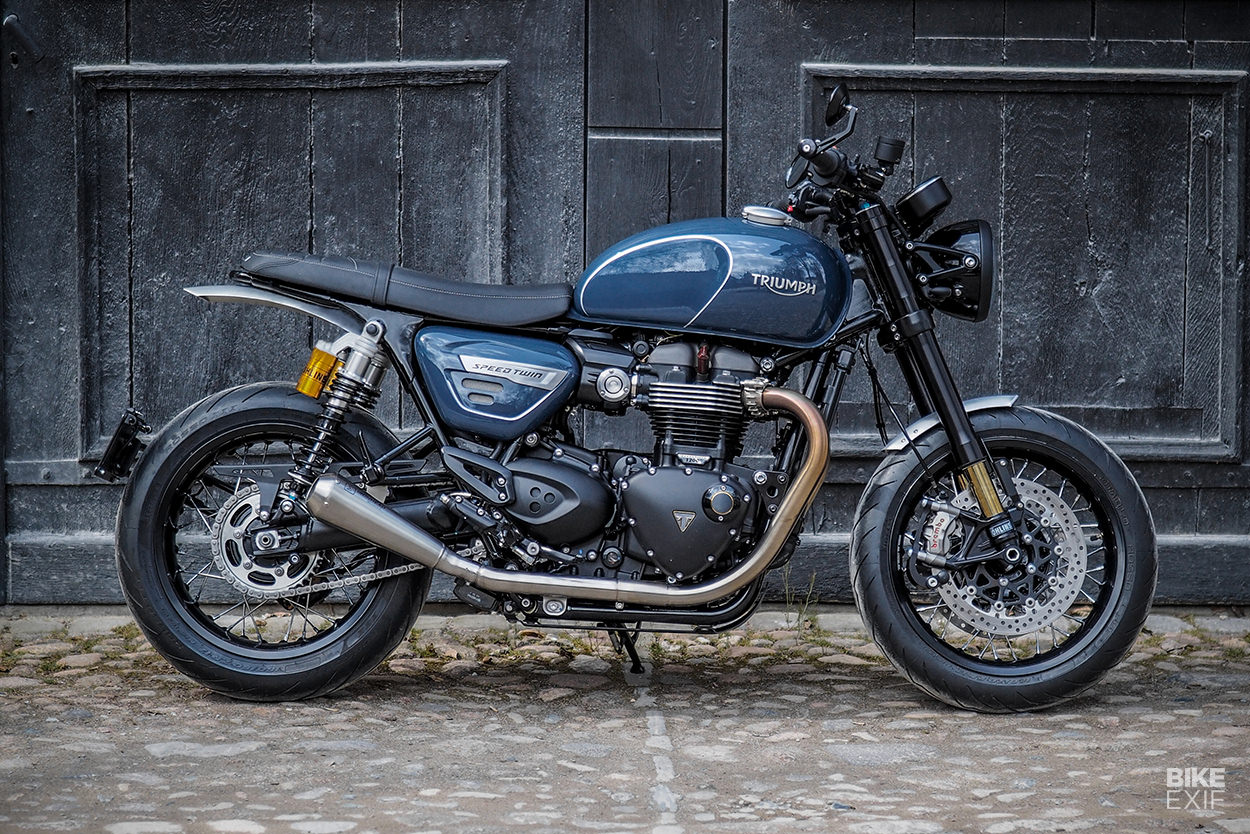
Amsterdam-based sculptor Ram Katzir captures still life when he’s at work, but when he’s on two wheels, he likes to travel very fast indeed. His current ride is this ballistic Triumph Speed Twin, which he designed with the help of German bike builder and racer Chris Raisch.
This is second time that Ram has worked with Chris: the first was upgrading the engine on a smart Street Twin built by Motokouture in Belgium.
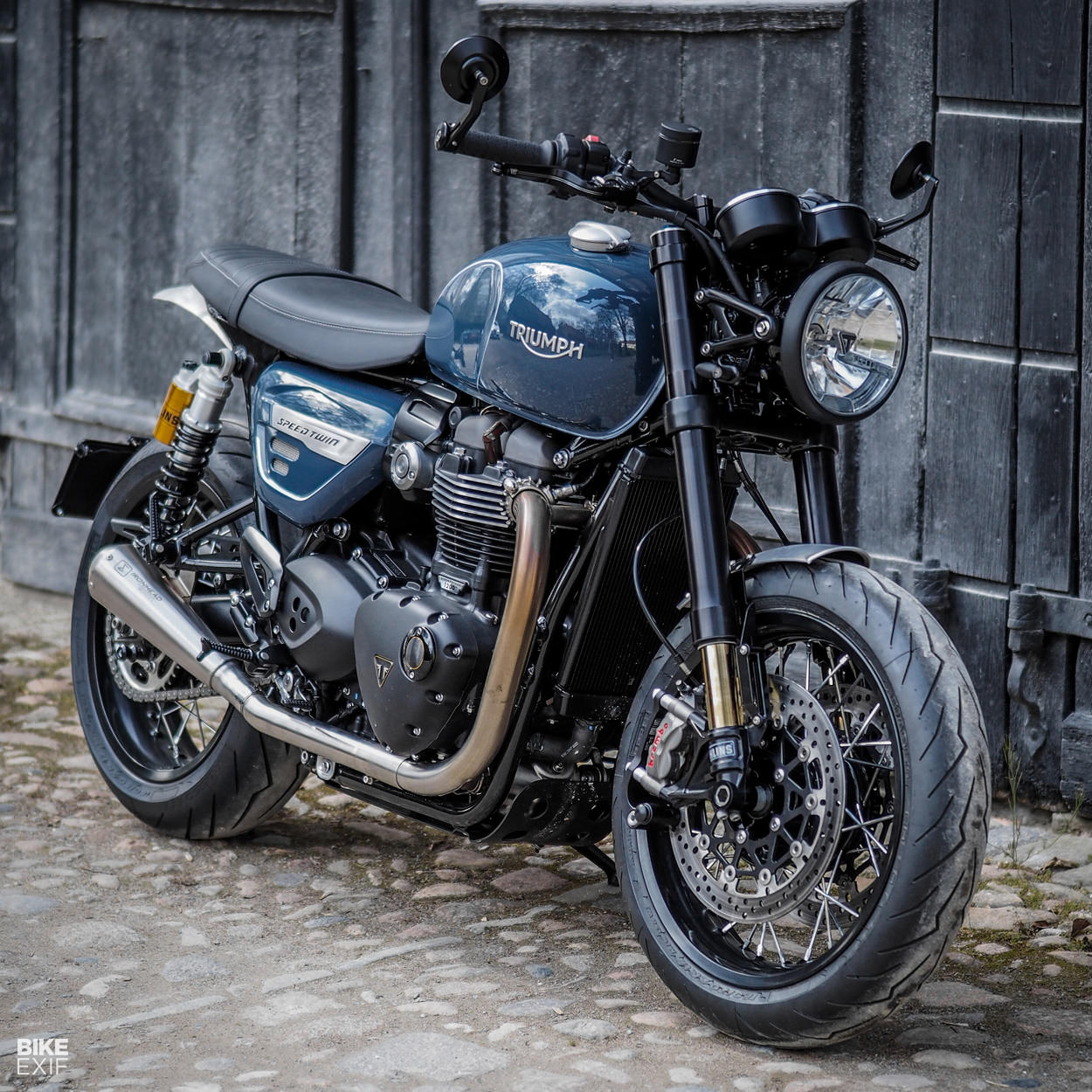
We’re fans of Triumph’s even sportier Speed Twin, because it matches classic looks and rider-friendly ergonomics to thoroughly modern performance.
It’s no slouch when it leaves the factory: the 1,200 cc 8-valve motor pumps out a hefty 96 hp from the crank. But there’s always room for improvement—on both the power and weight fronts.
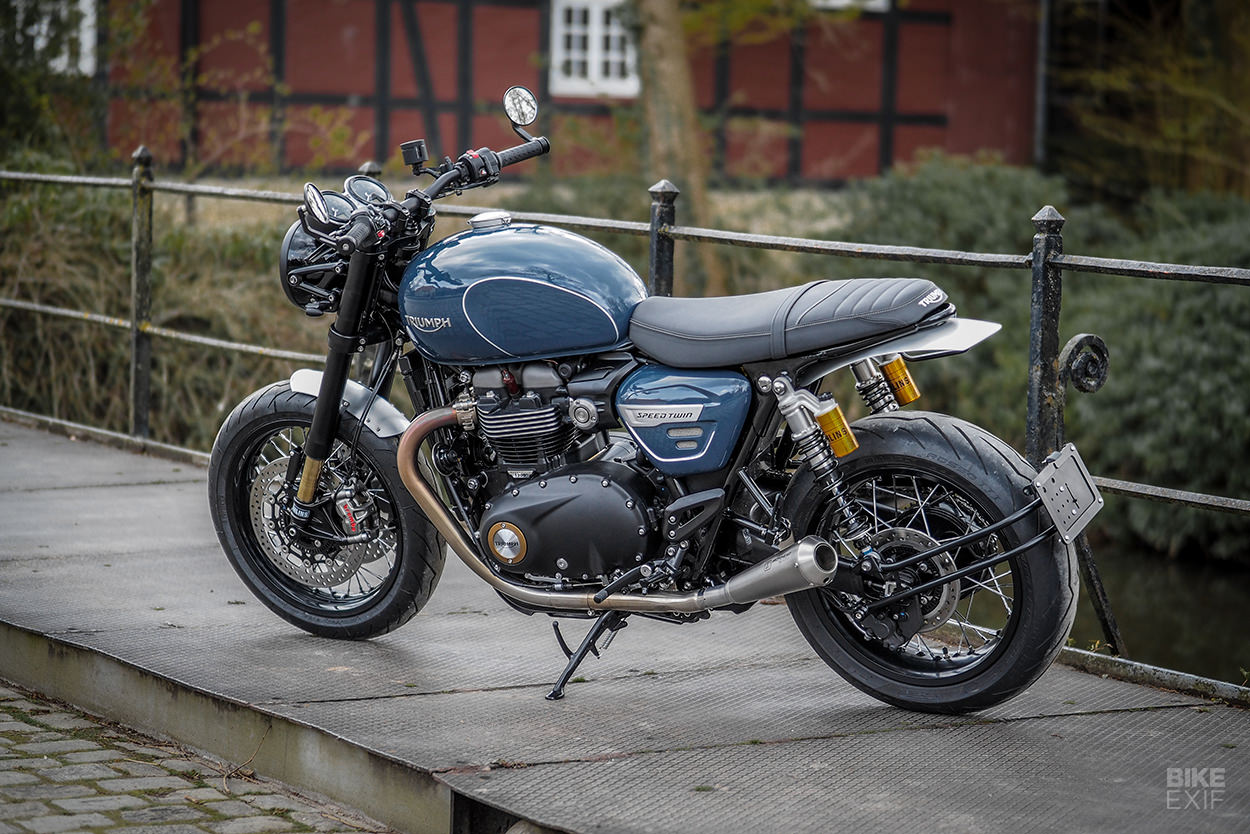
There are so many mods on this good-looking 2021 Speed Twin, it’s hard to know where to start. Chris has installed his own Stage 2 Speed Twin kit, which includes an X-pipe, a custom milled air filter cover with larger inlet, and a Dynojet Power Commander 5 with a custom Raisch map developed on the dyno.
Straight out of the box, in the key speed range of 4600 to 4700 rpm, this kit bumps power up by 11 horses at the back wheel, with a useful 17 Nm boost in torque. The exhaust system is an Ixil Ironhead, modified at the muffler end with Chris’ own race-style dB killers.
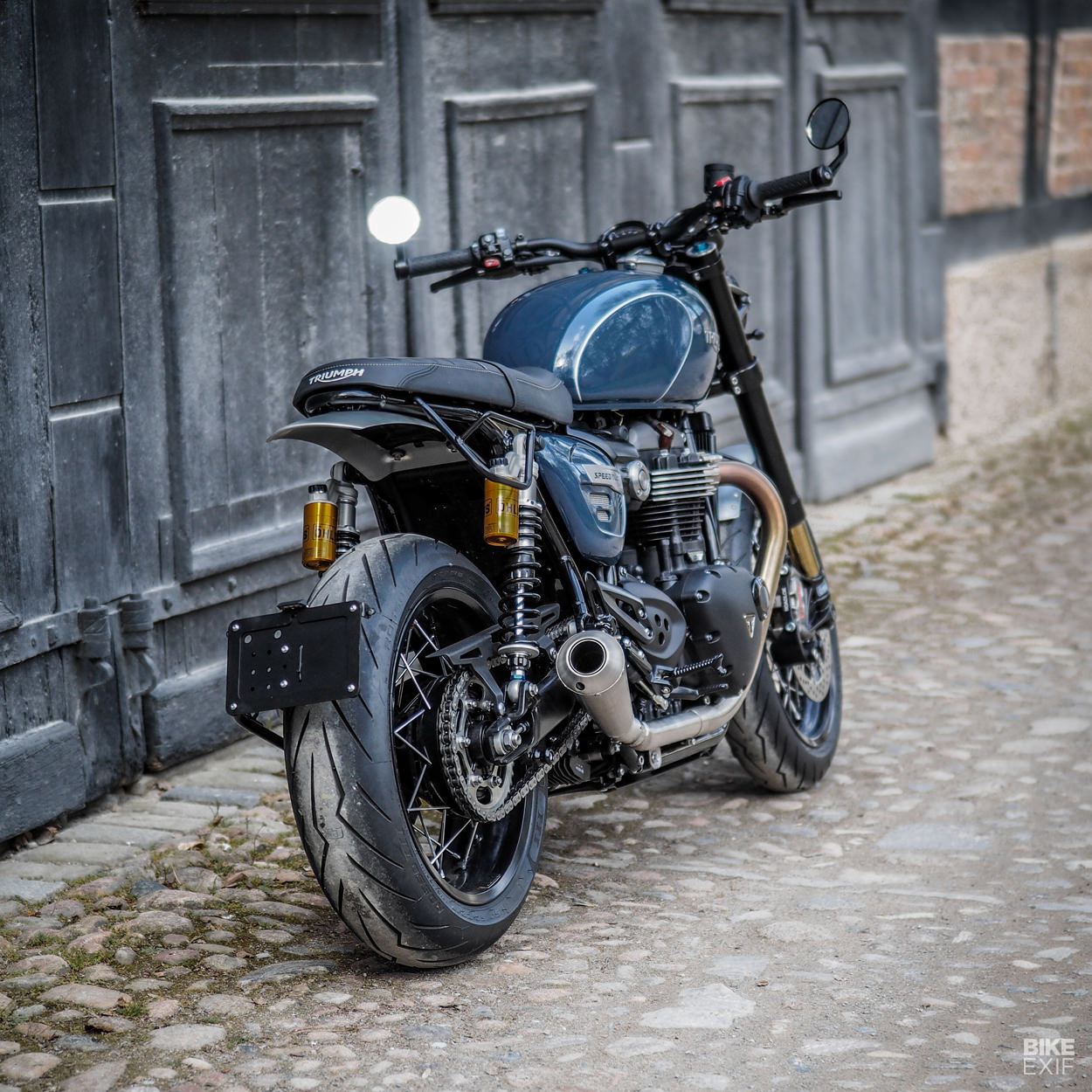
When the engine is serviced at the 16,000 km mark, Chris will add a Stage 4 cam and retune for even more wallop. But for the initial round of mods, he left the engine internals alone and switched his attention to the suspension.
The Thruxton forks are from the Triumph Factory Custom range, which means they’re Öhlins 43 mm NIX30 USD units with 120 mm of travel. The tubes have been anodized in matt black, for a more subdued effect than the usual Öhlins gold.
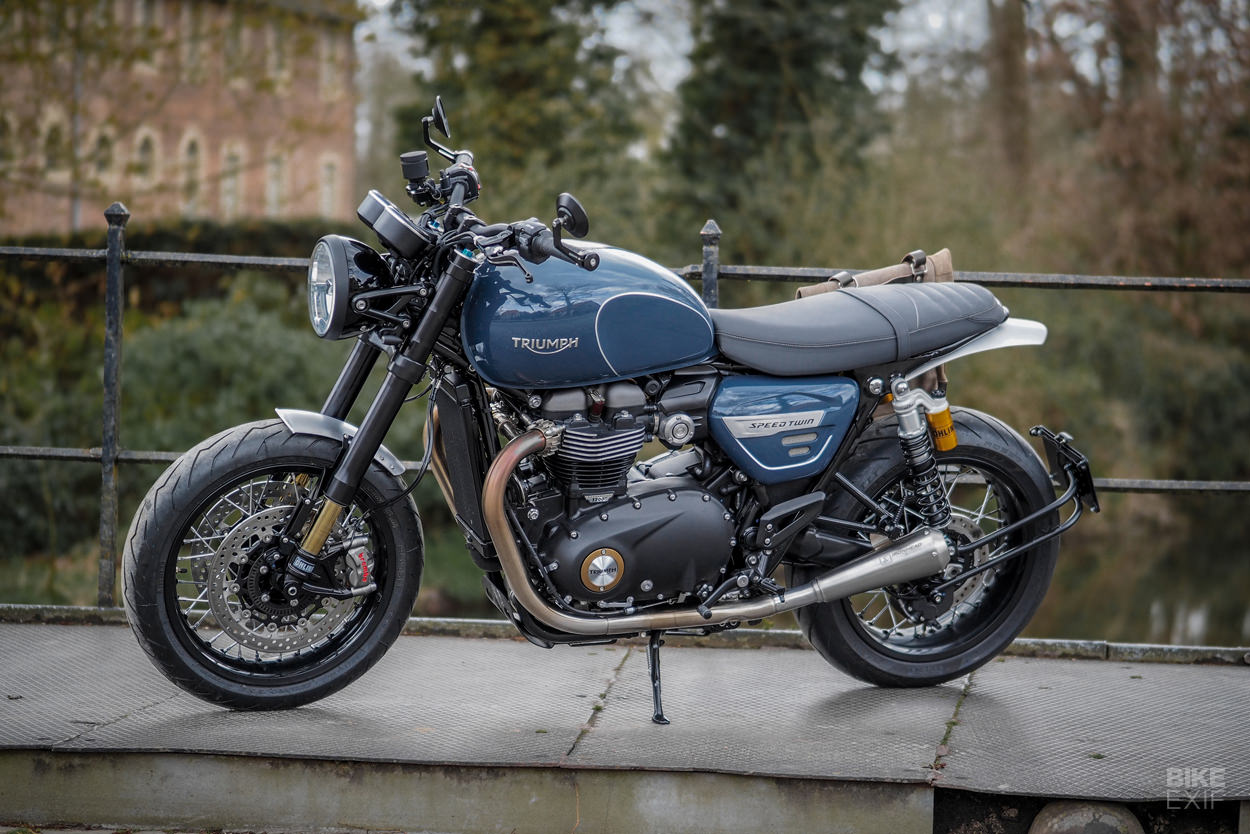
The twin shocks have been upgraded to fully adjustable Öhlins STX 36 units, and the front brakes now use cast aluminum Brembo M50 monobloc calipers.
Eagle eyes will also spot the Roadlok bolted onto the caliper for extra security when the bike is parked up, and the 17-inch aluminum rims have been lifted from a Thruxton R.
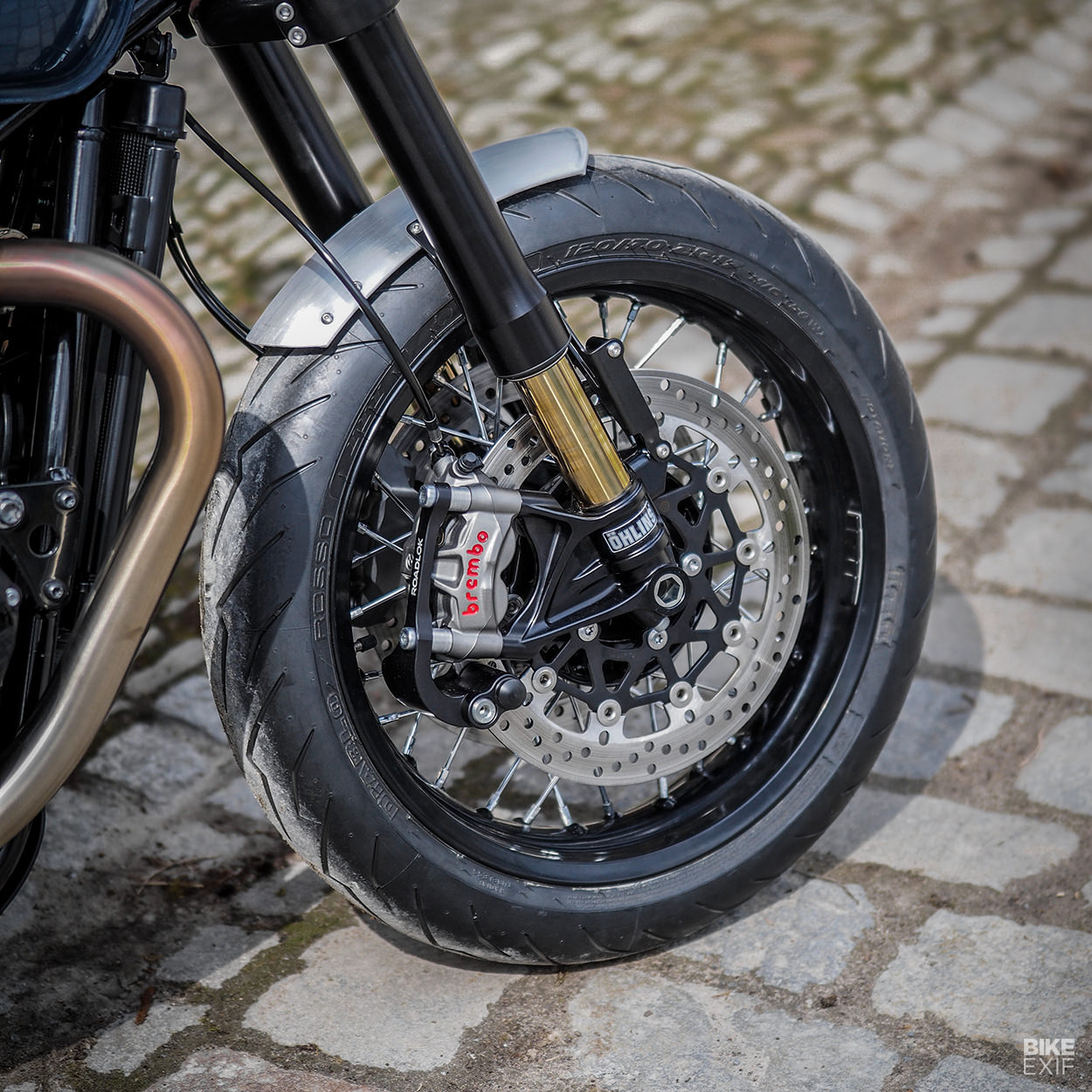
The cockpit gets tasty upgrades too. The levers on the LSL Superbike bars are top-shelf ABM Wunderkinds, the brake reservoir is a classy machined number from Rizoma, and bar-end mirrors keep everything clean.
Triumph’s own heated grips keep Ram’s hands warm during chilly Dutch winters, and Ducati spacers take the slop out of the ride by wire throttle system.
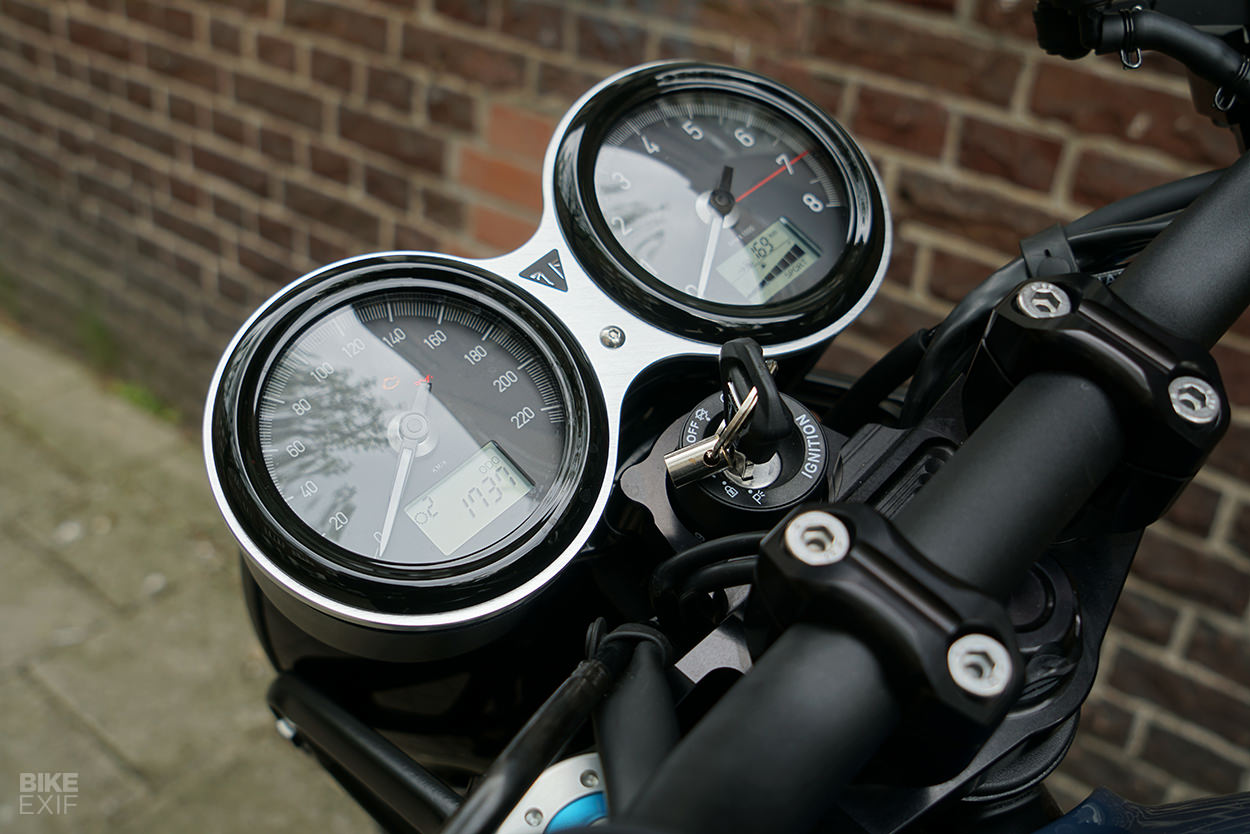
Little details are everywhere: Ram and Chris have even swapped out the original instrument faces, replacing them with new overlays from Arton Works that have simpler graphics and a vintage racing vibe.
Custom fabrication includes a new front fender in brushed aluminum, which is supported by Triumph Factory Custom struts. Chris also modified the stock rear fender, moving it closer to the frame and removing the factory light fitment.
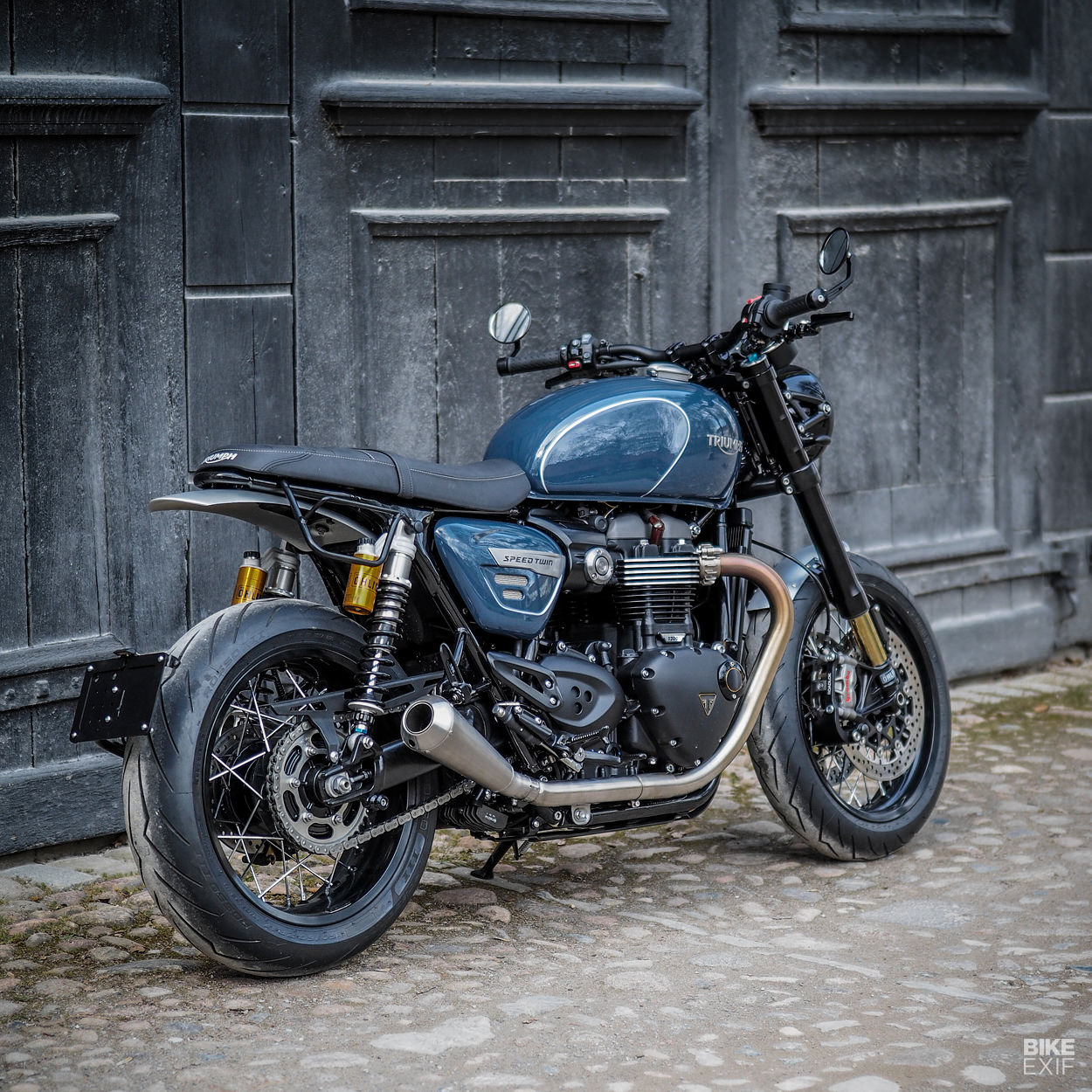
A custom made licence plate holder—attached to the swingarm—carries Motogadget mo.blaze tens3 blinkers. These are the smallest 3-in-1 blinkers in the world, handling turn signal, rear light and brake light duties in one element.
At the front end, the stock blinkers have been swapped out for Rizoma bullet indicators.
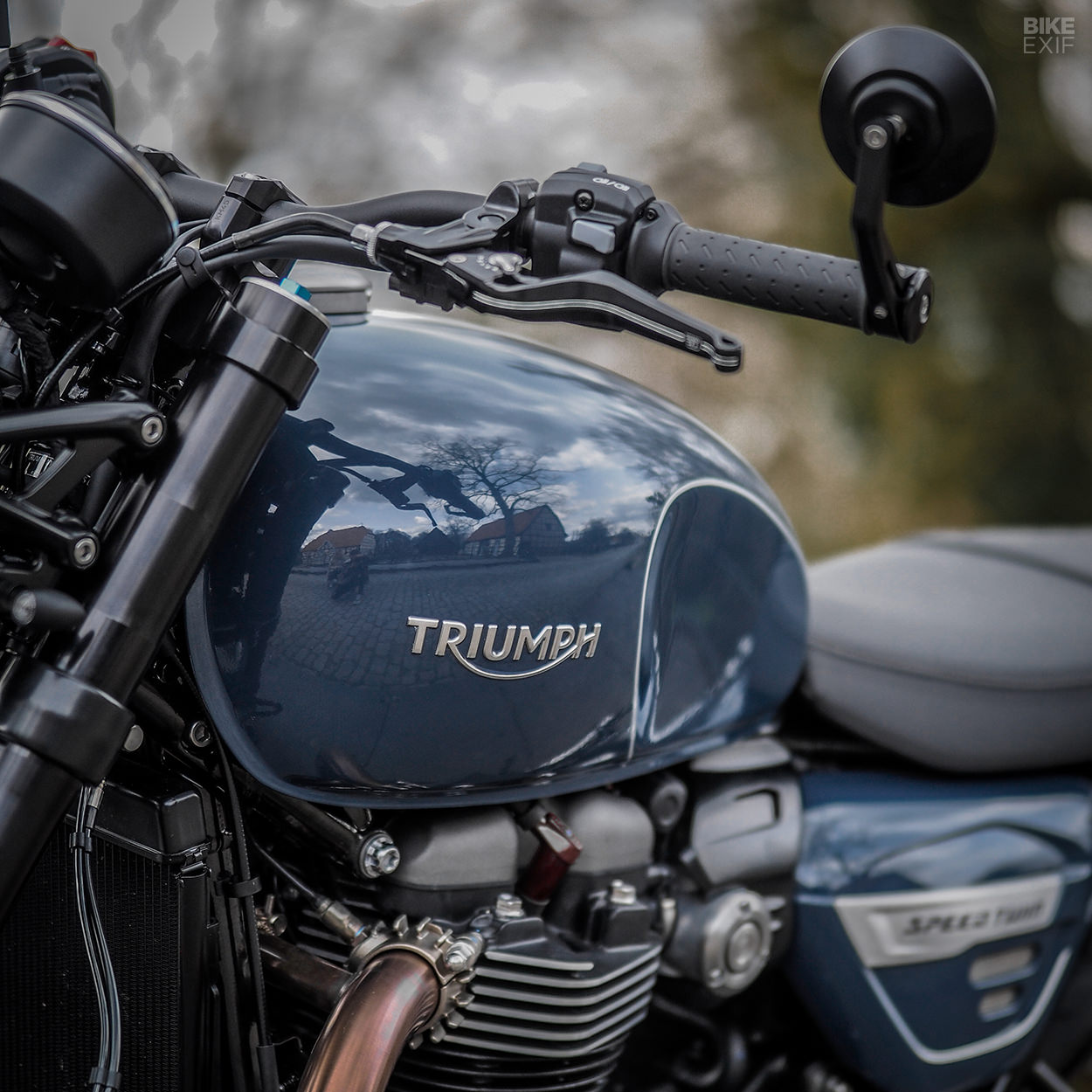
After applying powder to the swing arm, lamp brackets, rear sets and selected engine parts, Chris sent the Speed Twin off to TopCoating in Tilburg for a custom paint job.
That workshop handles the paint for Ram’s sculptures, and they finished off the Triumph with a custom blend of cobalt blue and slate grey. The silver pin striping on the tank and side covers has a brushed aluminum look, and there’s a layer of matt varnish on top of everything to add depth to the vintage color scheme.
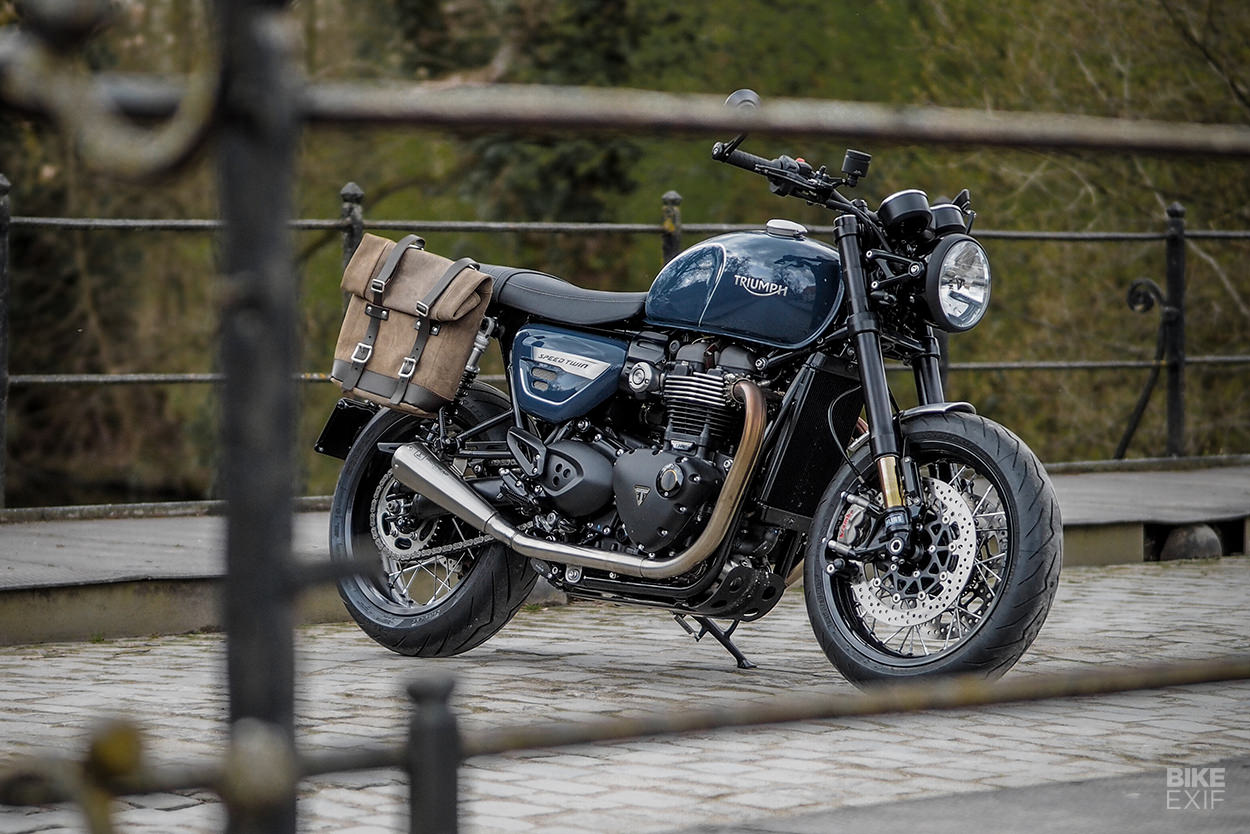
It’s the kind of bike we’d love to take on a long weekend trip, and it looks like Ram is thinking along those lines too. He’s installed a waterproof waxed suede pannier from Unit Garage, which comes with a quick-release subframe that fixes to the right side of the Speed Twin.
Despite this addition, Chris reports that the bike is around ten kilos lighter than stock, with a dry weight of 185 kilos (408 pounds). And with the engine tuning, performance will be edging into Speed Triple territory. Which has to be an intriguing proposition if you have 1200c modern classic in your garage …
Classicbike Raisch | Facebook | Instagram | Ram Katzir | Studio Ram Katzir Instagram | Images by Yannic Raisch
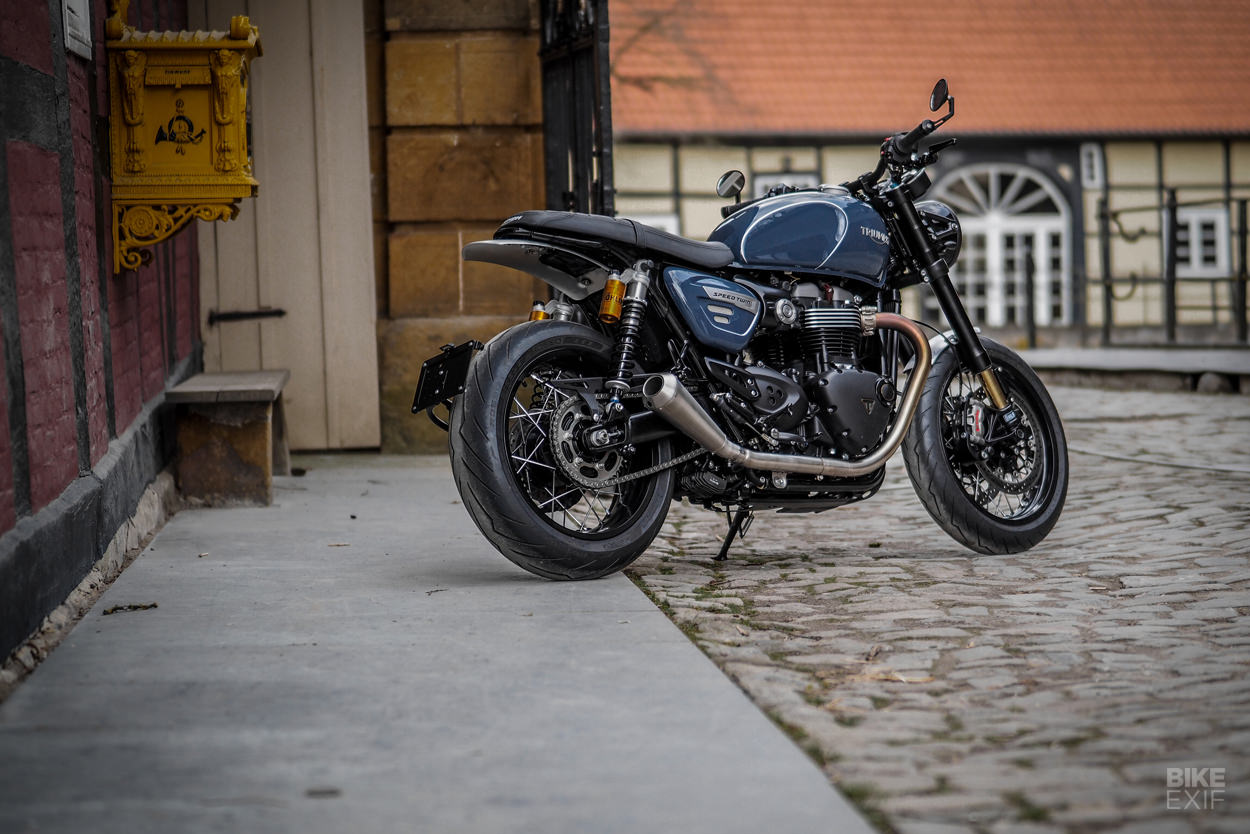
Continue reading...

Amsterdam-based sculptor Ram Katzir captures still life when he’s at work, but when he’s on two wheels, he likes to travel very fast indeed. His current ride is this ballistic Triumph Speed Twin, which he designed with the help of German bike builder and racer Chris Raisch.
This is second time that Ram has worked with Chris: the first was upgrading the engine on a smart Street Twin built by Motokouture in Belgium.

We’re fans of Triumph’s even sportier Speed Twin, because it matches classic looks and rider-friendly ergonomics to thoroughly modern performance.
It’s no slouch when it leaves the factory: the 1,200 cc 8-valve motor pumps out a hefty 96 hp from the crank. But there’s always room for improvement—on both the power and weight fronts.

There are so many mods on this good-looking 2021 Speed Twin, it’s hard to know where to start. Chris has installed his own Stage 2 Speed Twin kit, which includes an X-pipe, a custom milled air filter cover with larger inlet, and a Dynojet Power Commander 5 with a custom Raisch map developed on the dyno.
Straight out of the box, in the key speed range of 4600 to 4700 rpm, this kit bumps power up by 11 horses at the back wheel, with a useful 17 Nm boost in torque. The exhaust system is an Ixil Ironhead, modified at the muffler end with Chris’ own race-style dB killers.

When the engine is serviced at the 16,000 km mark, Chris will add a Stage 4 cam and retune for even more wallop. But for the initial round of mods, he left the engine internals alone and switched his attention to the suspension.
The Thruxton forks are from the Triumph Factory Custom range, which means they’re Öhlins 43 mm NIX30 USD units with 120 mm of travel. The tubes have been anodized in matt black, for a more subdued effect than the usual Öhlins gold.

The twin shocks have been upgraded to fully adjustable Öhlins STX 36 units, and the front brakes now use cast aluminum Brembo M50 monobloc calipers.
Eagle eyes will also spot the Roadlok bolted onto the caliper for extra security when the bike is parked up, and the 17-inch aluminum rims have been lifted from a Thruxton R.

The cockpit gets tasty upgrades too. The levers on the LSL Superbike bars are top-shelf ABM Wunderkinds, the brake reservoir is a classy machined number from Rizoma, and bar-end mirrors keep everything clean.
Triumph’s own heated grips keep Ram’s hands warm during chilly Dutch winters, and Ducati spacers take the slop out of the ride by wire throttle system.

Little details are everywhere: Ram and Chris have even swapped out the original instrument faces, replacing them with new overlays from Arton Works that have simpler graphics and a vintage racing vibe.
Custom fabrication includes a new front fender in brushed aluminum, which is supported by Triumph Factory Custom struts. Chris also modified the stock rear fender, moving it closer to the frame and removing the factory light fitment.

A custom made licence plate holder—attached to the swingarm—carries Motogadget mo.blaze tens3 blinkers. These are the smallest 3-in-1 blinkers in the world, handling turn signal, rear light and brake light duties in one element.
At the front end, the stock blinkers have been swapped out for Rizoma bullet indicators.

After applying powder to the swing arm, lamp brackets, rear sets and selected engine parts, Chris sent the Speed Twin off to TopCoating in Tilburg for a custom paint job.
That workshop handles the paint for Ram’s sculptures, and they finished off the Triumph with a custom blend of cobalt blue and slate grey. The silver pin striping on the tank and side covers has a brushed aluminum look, and there’s a layer of matt varnish on top of everything to add depth to the vintage color scheme.

It’s the kind of bike we’d love to take on a long weekend trip, and it looks like Ram is thinking along those lines too. He’s installed a waterproof waxed suede pannier from Unit Garage, which comes with a quick-release subframe that fixes to the right side of the Speed Twin.
Despite this addition, Chris reports that the bike is around ten kilos lighter than stock, with a dry weight of 185 kilos (408 pounds). And with the engine tuning, performance will be edging into Speed Triple territory. Which has to be an intriguing proposition if you have 1200c modern classic in your garage …
Classicbike Raisch | Facebook | Instagram | Ram Katzir | Studio Ram Katzir Instagram | Images by Yannic Raisch

Continue reading...
Speed Read, 9 May 2021

This week’s custom motorcycles come in all shapes and sizes—from a pint-sized flat tracker, to a stylish BMW R18. Plus we take a look at a tidy BSA bobber, and a Norton Atlas with a Harley-Davidson WLA motor.
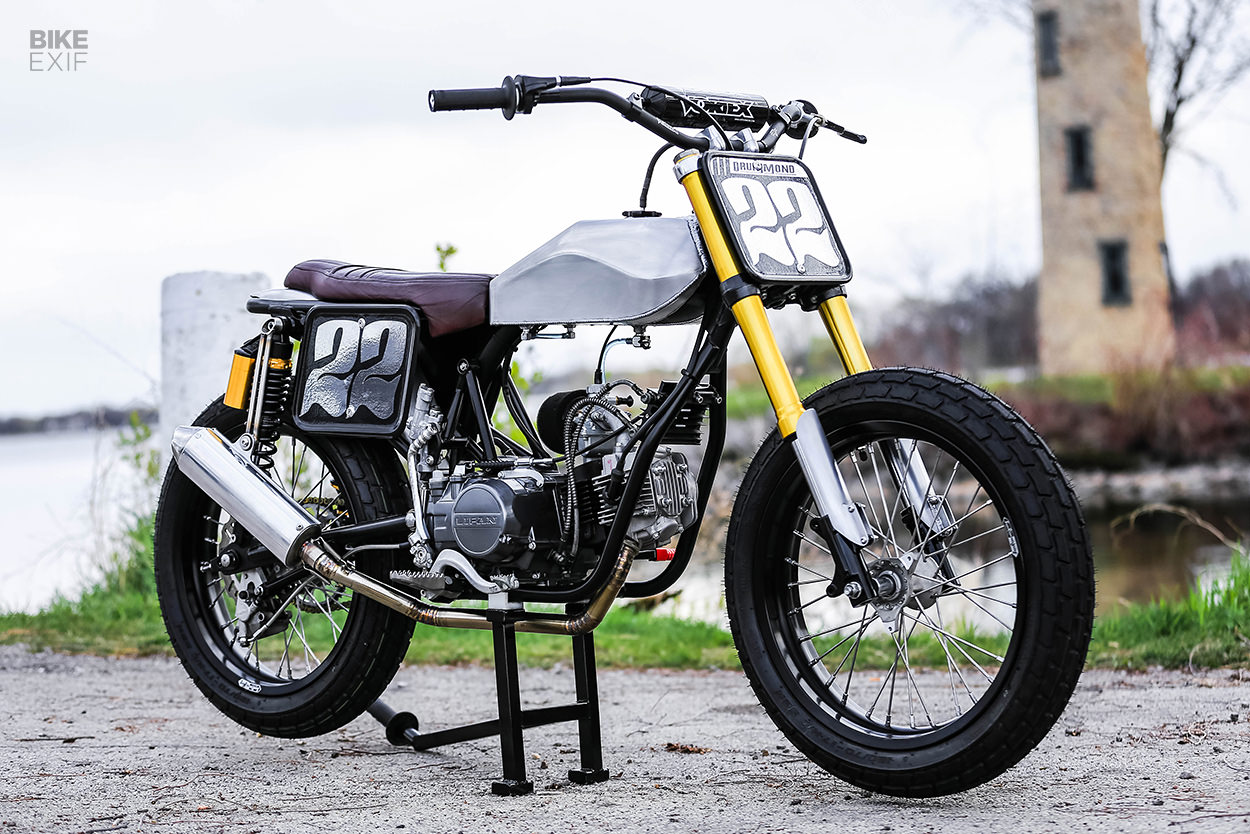
Jake Drummond’s Mini Tracker Jake Drummond has some rather crazy skills, but for his latest project, he went small, cheap and cheerful. This mini flat tracker took him three months to build and cost just $1,800, but it’s just as cool as any bike twice its size.
Jake started with a 1968 Yamaha YCS1 rolling chassis he found on Facebook, then sourced a four-speed 140 cc Lifan motor off eBay. Then he built a custom motor cradle, mounts, and a new rear loop to bring it all together.
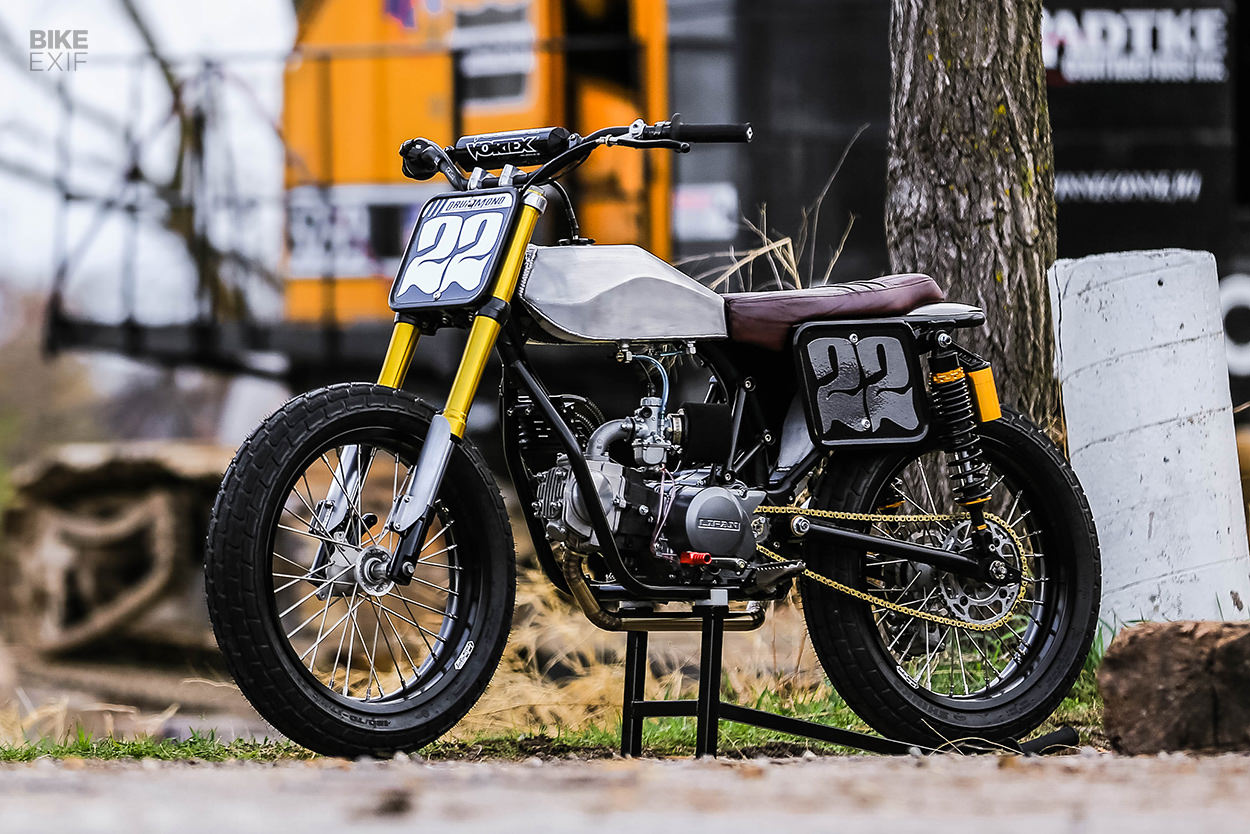
The front forks are Honda Grom units, and the rear shocks are generic aftermarket items. The wheels are 17” Sun rims, laced to Suzuki RM85 hubs with Buchanan’s spokes, and wrapped in Shinko rubber. And the rear brake is from a 2010 Yamaha YZ250F, with a custom caliper bracket and pedal linkage.
Jake also added a custom aluminum Champion-style gas tank, with an aluminum rear fender and aluminum fork guards. The pleated leather seat is custom too, as are the vacuum-formed number plates.
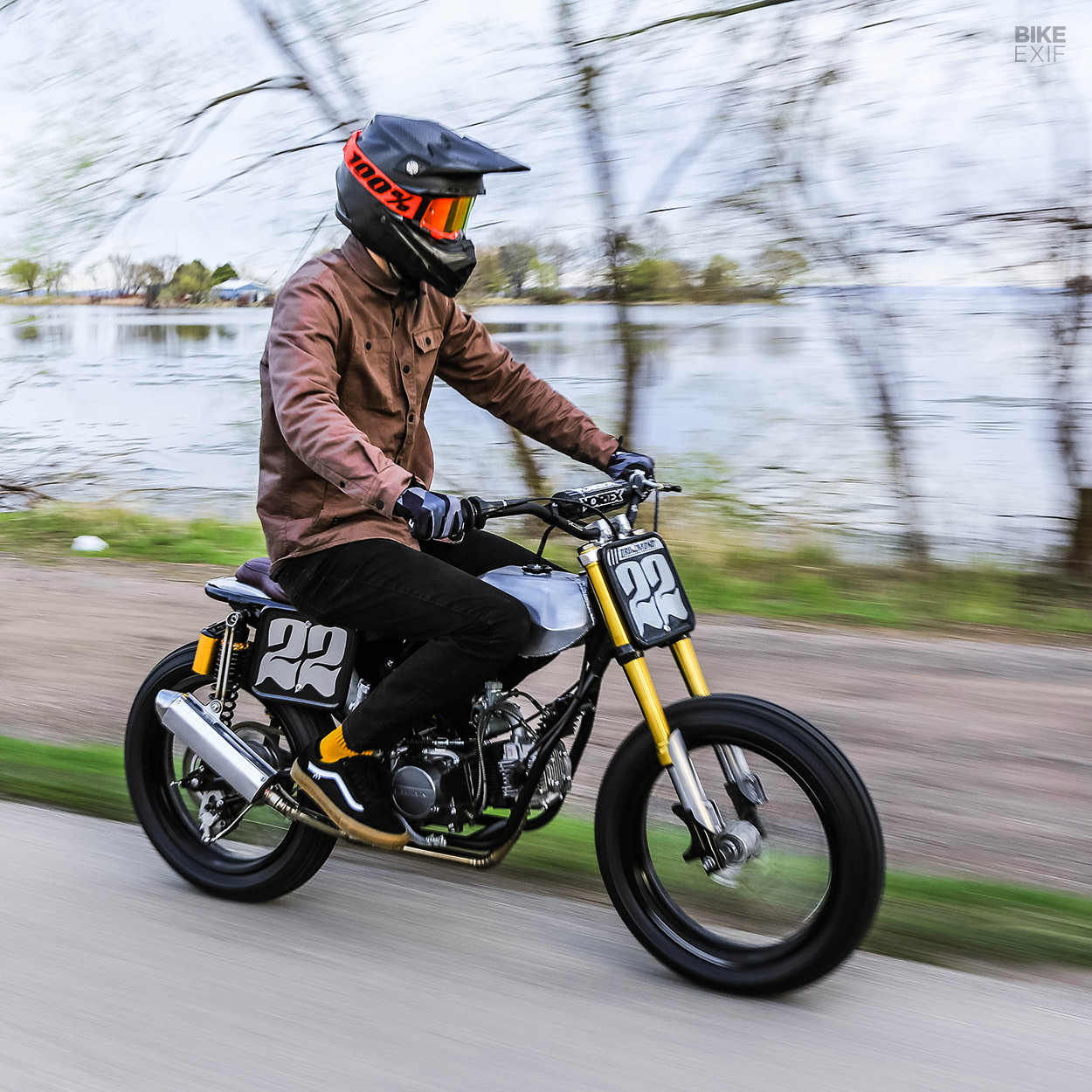
Up in the cockpit are Vortex handlebars with a BBR throttle and ODI grips. Lower down are the titanium foot pegs from a Suzuki RMZ450.
Jake’s mini-tracker looks cute as a button, and should be wild fun to ride. Let’s hope he races it too—because there’s actually a flat track class for it. [Jake Drummond Instagram | Images by Zach Visser]
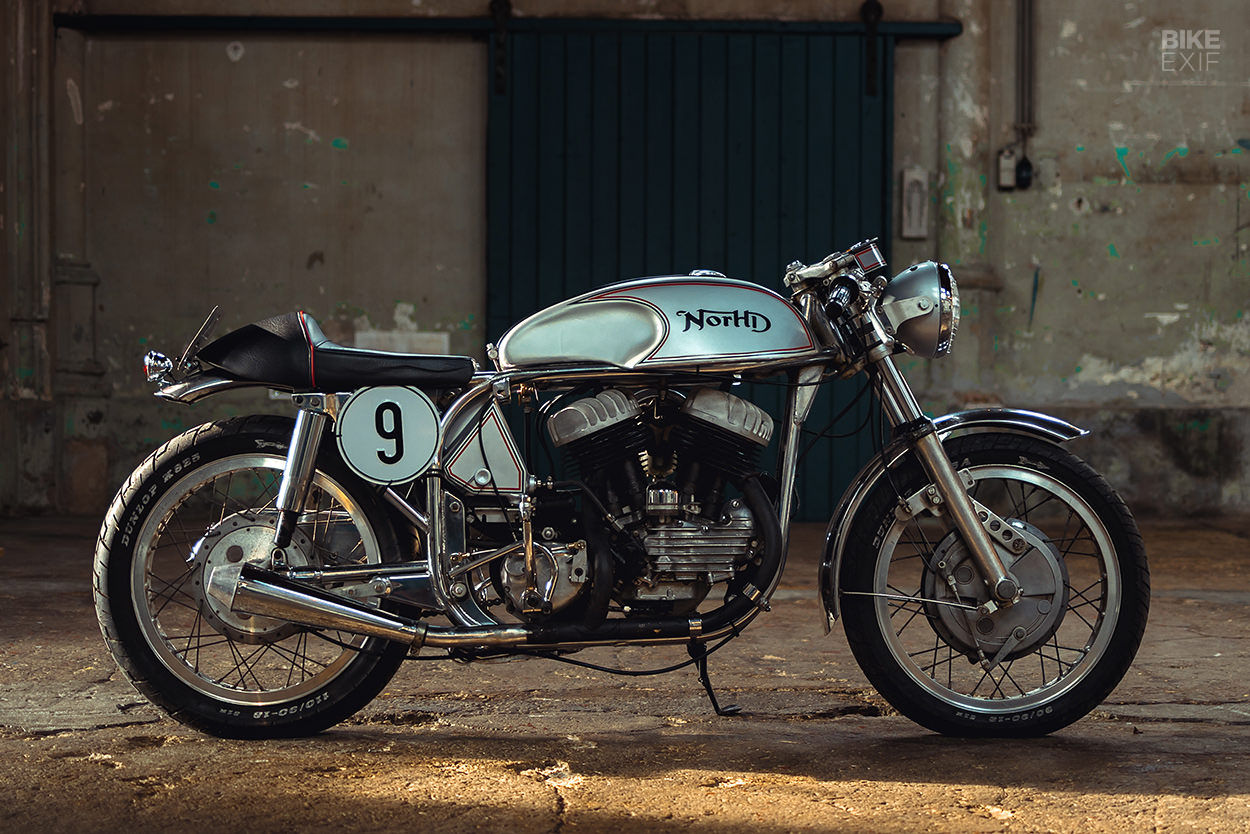
Makai Wink’s NorHD 20-year-old Dutchman Makai Wink grew up with his grandparents and parents riding motorcycles, so getting onto two wheels himself was inevitable. His first major project is a doozy: a 1942 Harley-Davidson WLA Liberator motor stuck into a 1967 Norton Atlas frame. And best of all, it was a family project.
Makai’s dad and granddad have been collecting bike parts since they were young, so many of the parts were simply dragged out of the garage.
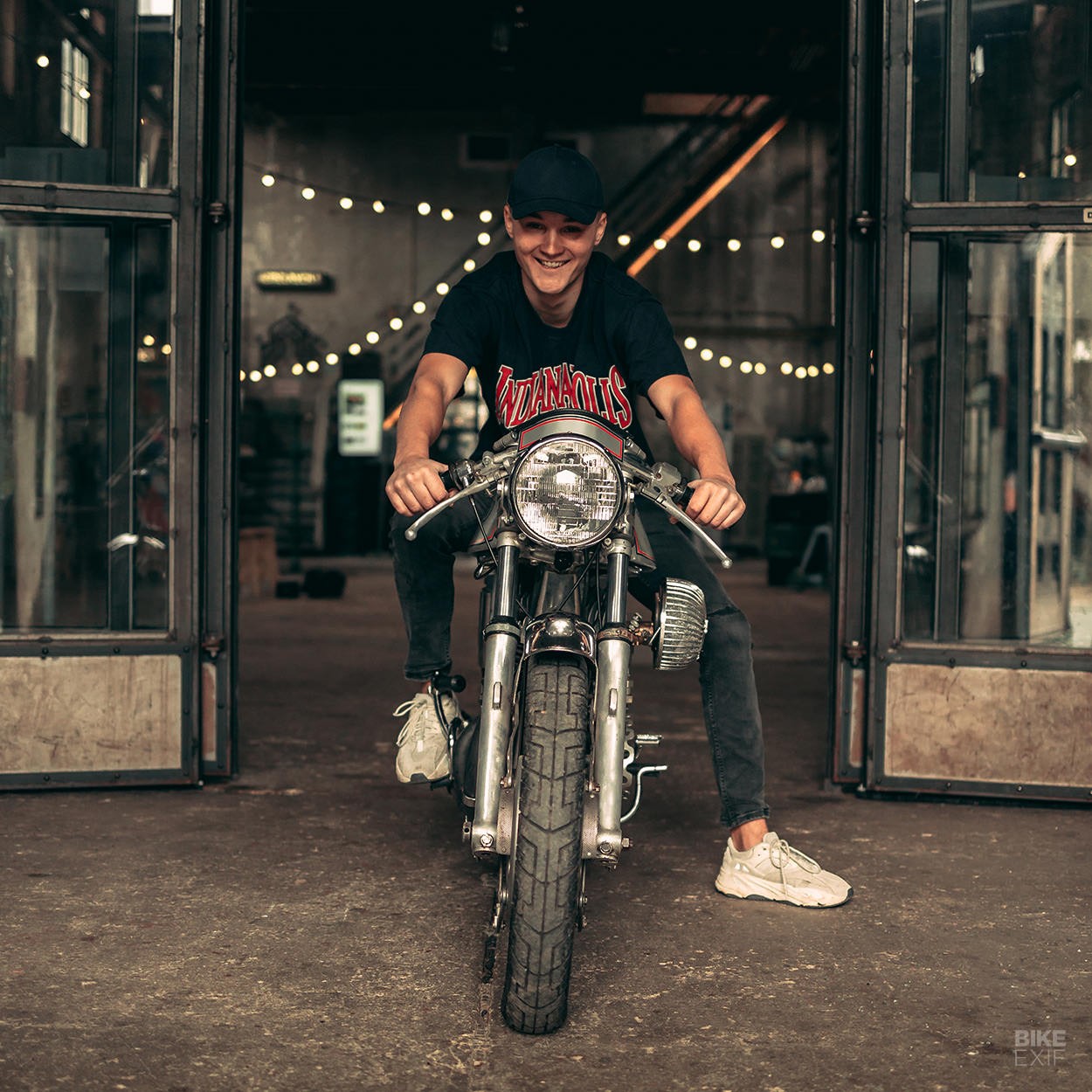
“We actually call the bike ‘SO’,” says Makai. “It stands for schuur opruiming, sloop onderdelen, which translates to ‘barn clearance, demolition parts’.” But despite it’s bitsa nature, it looks like a million bucks.
The project actually kicked off when Makai was 15. His granddad was selling his house, and found the Harley motor while cleaning out the garage. Makai came up with the idea of sticking it in an Atlas frame—and spent the next winter making that happen. He bought the motor and frame combo off his granddad, and carried on the project with continuous help from both his granddad and his father.
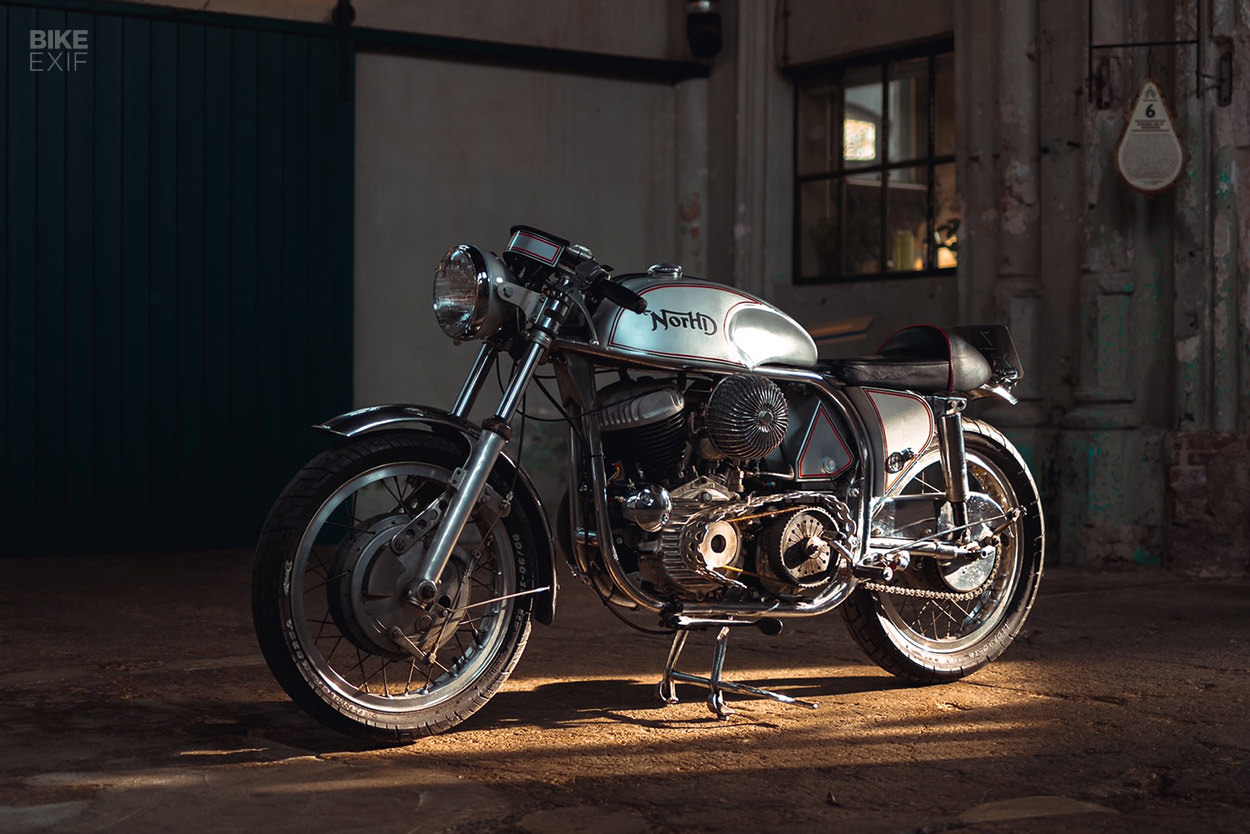
The motor consists of a modified Liberator block, with 1200 inlet valves and KR750 exhaust valves, a 1200 carb, and a balanced crankshaft. There’s a custom pulley system mating the engine to the gearbox.
Makai’s dad helped with the electrics, which were definitely not a walk in the park. “You could throw away the scheme for the wiring harness,” says Makai, “because it’s an American engine in an English bike. And for the English bike it’s a ‘+’ on the frame, and for an American bike it’s a ‘–‘ … we call it ‘swearing in church’.”
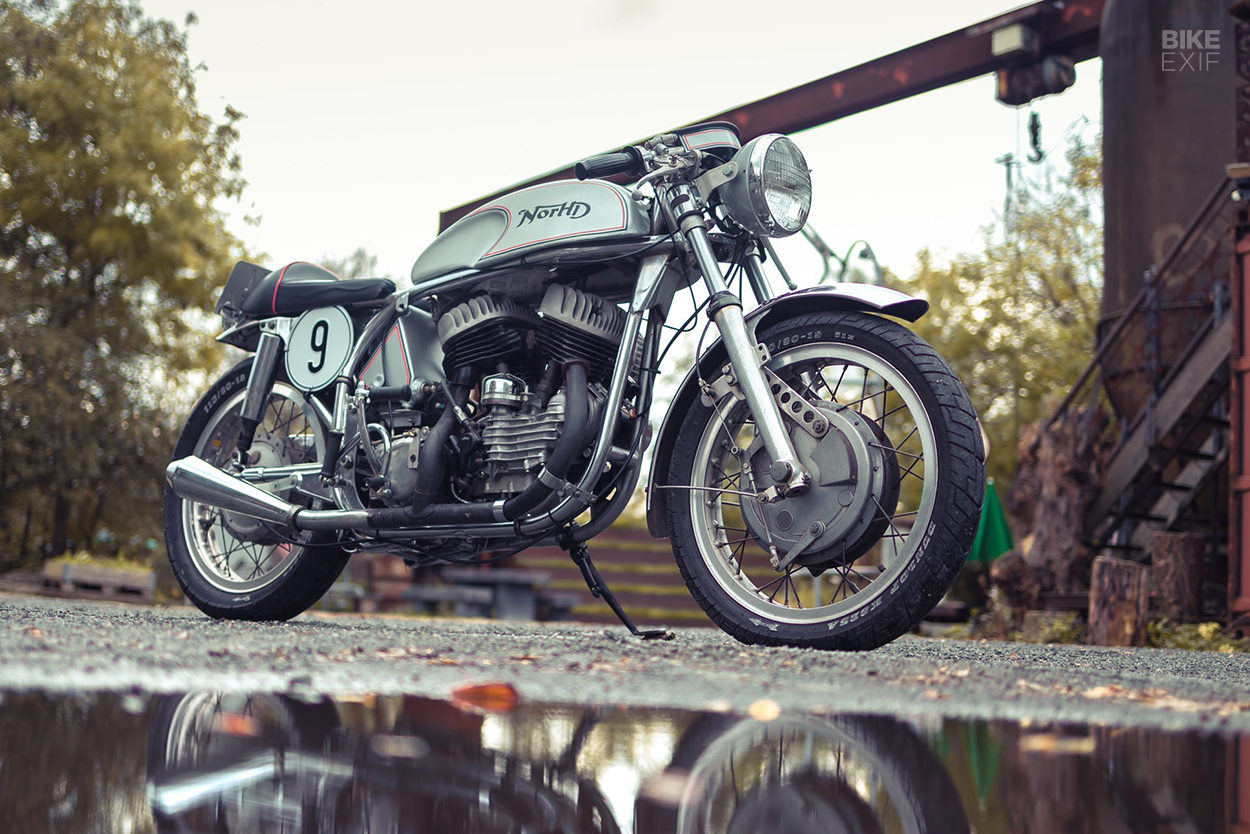
Other features include original Norton drum brakes, a restored Smiths clock, and a custom dashboard and battery box. Makai did all the paint and pin-striping himself, redoing some parts four or five times, “because I’m crazy for precision.”
The bike’s finally done, but Makai can’t ride it yet. The Netherlands has a tiered licensing system, and at 20 years old, he’s on his first tier. We bet he can’t wait for that license upgrade. [Makai Wink Instagram | Images by Noortje Blokland]
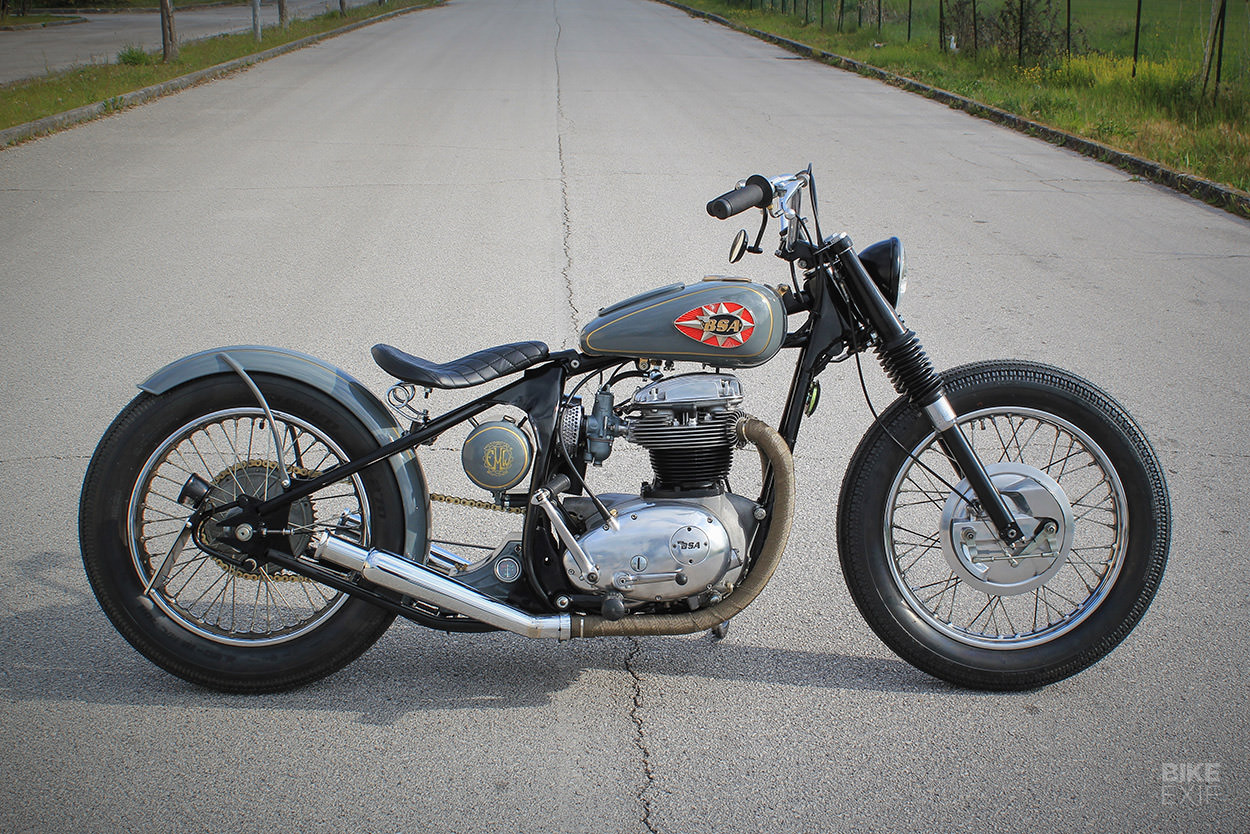
BSA Thunderbolt by FMW Motorcycles Some of the bikes that have rolled out of Lorenzo Fugaroli’s FMW Motorcycles over the years have been pretty ‘out there.’ But the Italian builder also knows how to play the classics—and the evidence is this flawless BSA hardtail. It’s probably because Lorenzo’s craft was handed down to him from his father, who’s been manipulating metal since 1969.
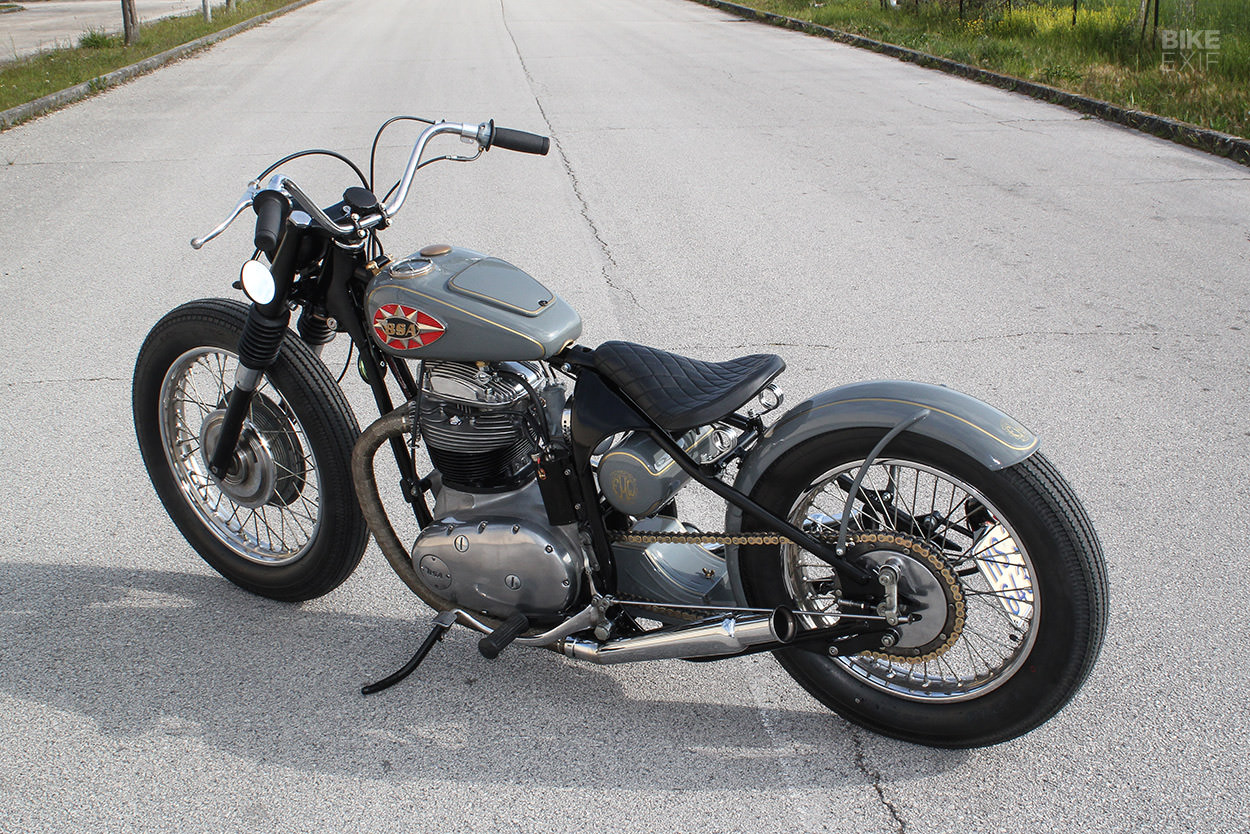
The donor for this project was a 1970-model Thunderbolt A65T, and it was commissioned by a client. Lorenzo’s turned it into a timeless bobber, but he’s also brought it up to date—with tweaks to help it run lead-free fuel. So it’s sporting updated electrics, a Wassel carb and new valve seats.
Lorenzo fabricated the hardtail frame himself, along with smaller details like the aluminum oil tank and battery box. The fuel tank’s been modified with an embedded classic Smiths speedo, and it sits on custom brass supports.
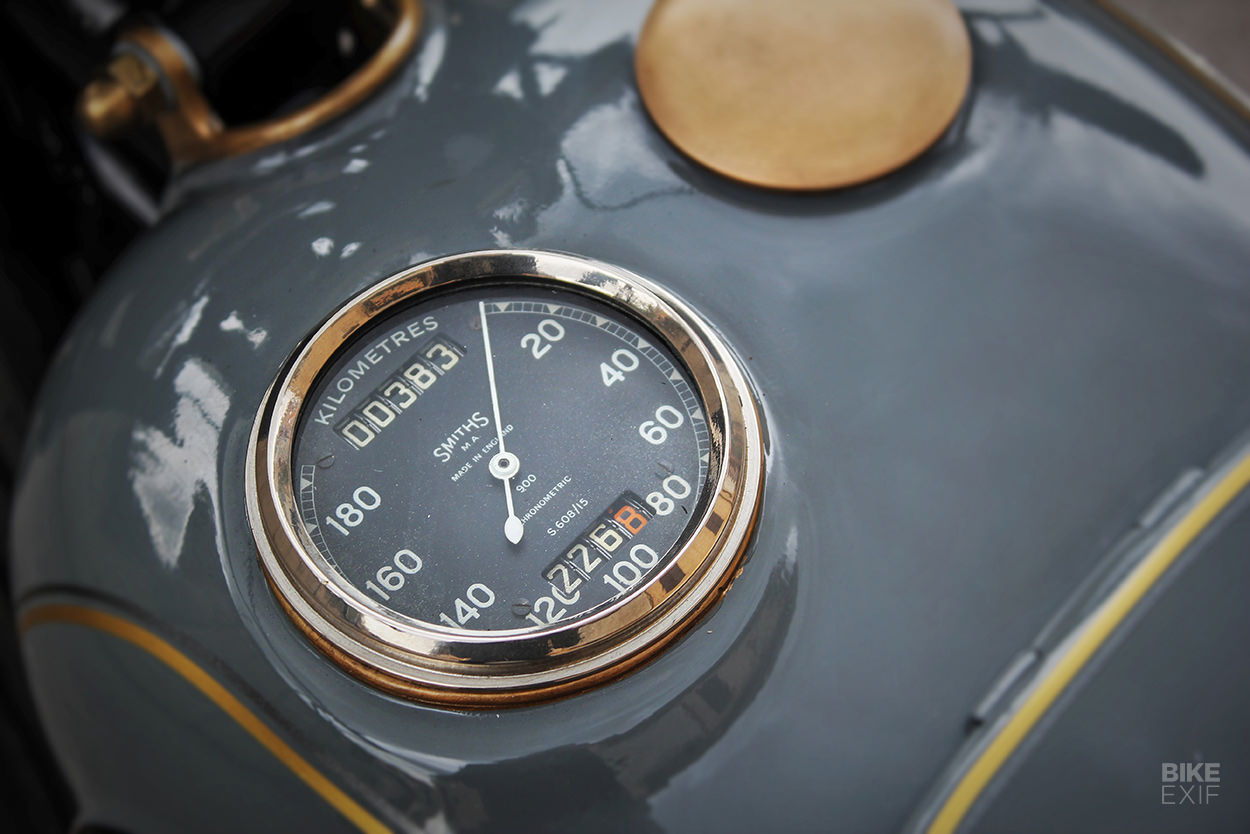
Details include a sprung solo seat and a tightly mounted rear fender. Every part looks like it belongs—from the tracker-style bars and grips to the side-mounted stop light and cocktail shaker exhausts. It’s a simple, but highly effective, build. [FMW Motorcycles]
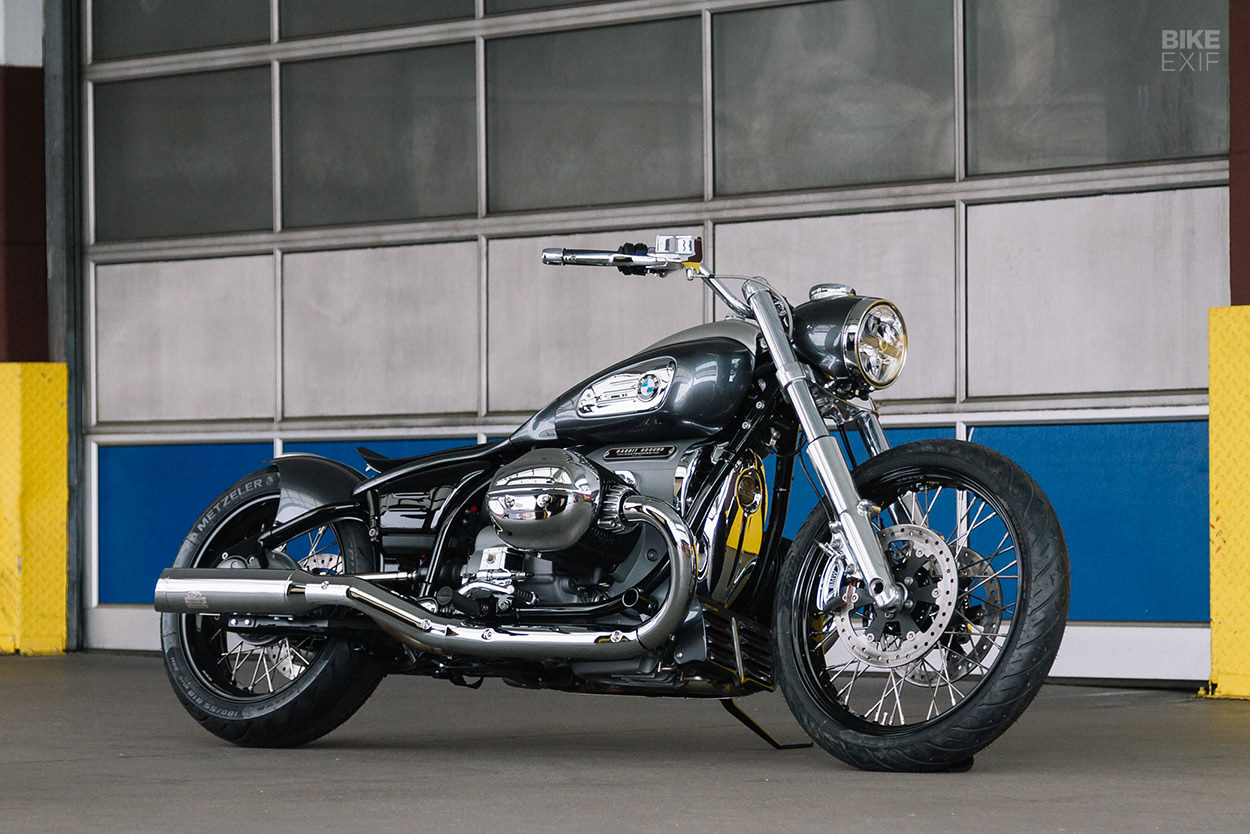
BMW R18 by Rabbit Ground Customizing BMW’s gambit of pitching the R18 as a platform for customization has paid off. We’re seeing more and more custom spins on the king-sized boxer, and the bar is being raised at an alarming pace. This latest R18 custom comes from a BMW specialist in Rüsselsheim, Germany and it’s a total banger.
Since RGC is part of a 40-year-old BMW dealership, they decided to pay homage to the iconic /5 ‘toaster tank’ model. So they called in an expert to help hammer out some custom bodywork: Udo Kohse from Unikat-Werk / Bike-Project.
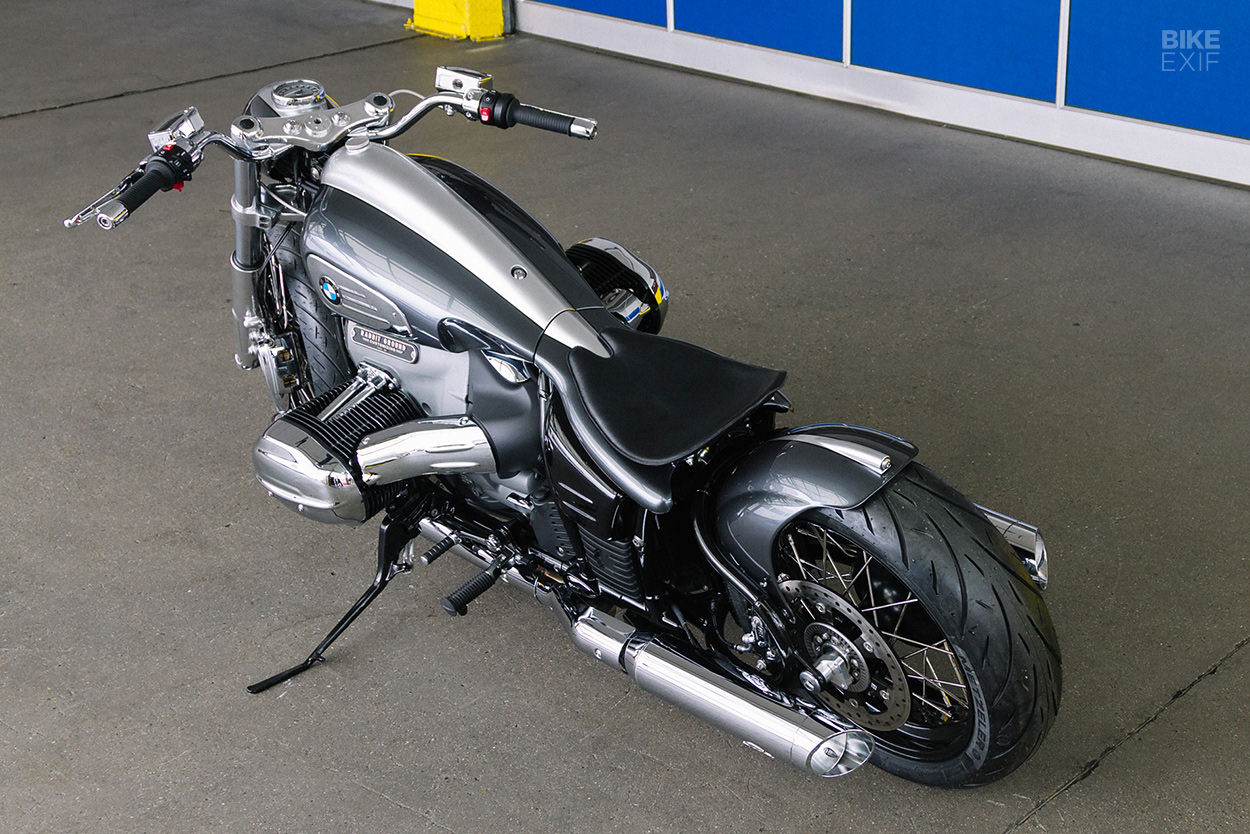
Udo added a ridge atop the R18’s fuel tank, beat in a pair of knee indents, and added a pair of chrome ‘toaster’ panels to the sides. There’s a new seat too, and the frame beneath it is wrapped in a custom piece of bodywork to improve the flow.
Out back is a custom fender, with a ridge that ends with a small embedded taillight. Up front, Udo’s shaped a new enclosure for the OEM headlight that now also houses the speedo.
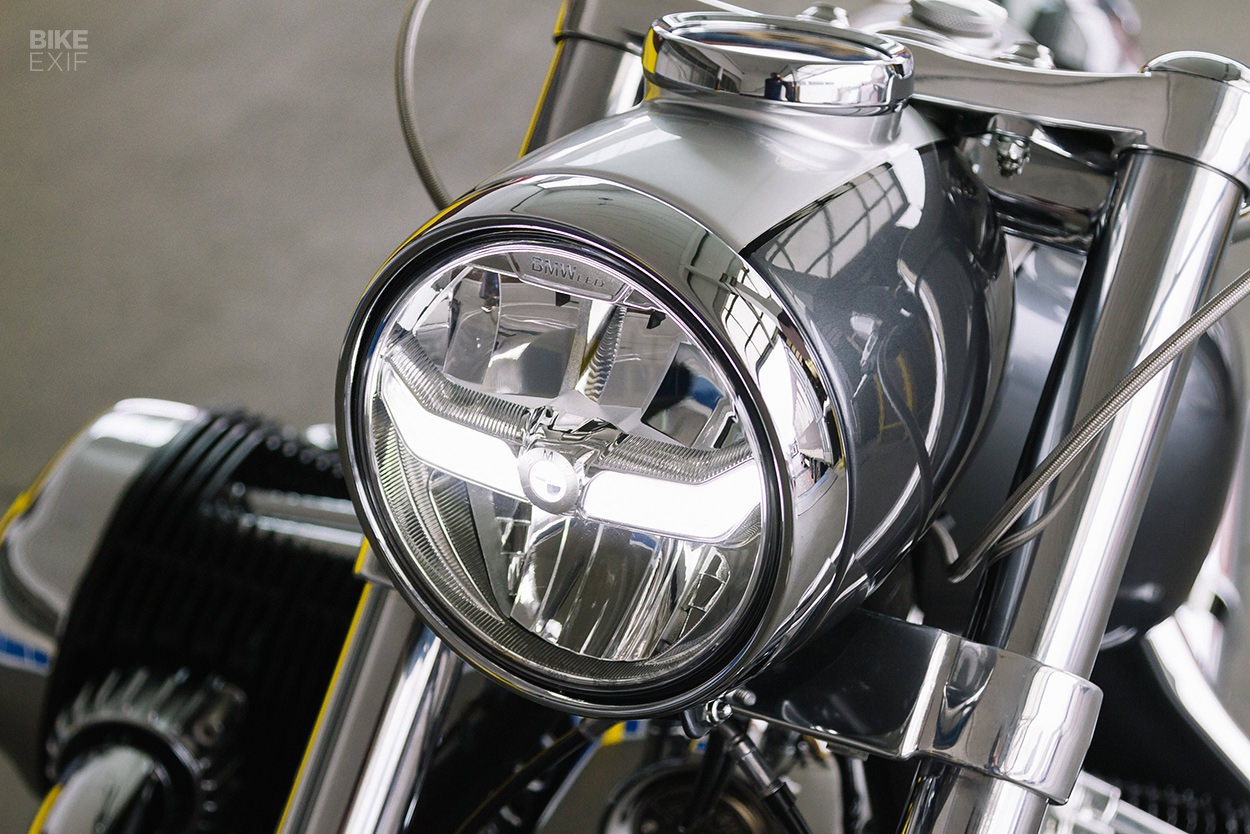
Other changes include a switch to 21F/18R wheels, custom handlebars, and a set of Kellermann Atto turn signals. The exhaust is a prototype from the Dutch specialist Dr. Jekill & Mr. Hyde and Rabbit Ground have kept the paint classy with a simple grey and silver livery.
It’s an exceptionally well-packaged custom, and another stylish entry into a fast-growing list of R18 customs. [Rabbit Ground Customizing]
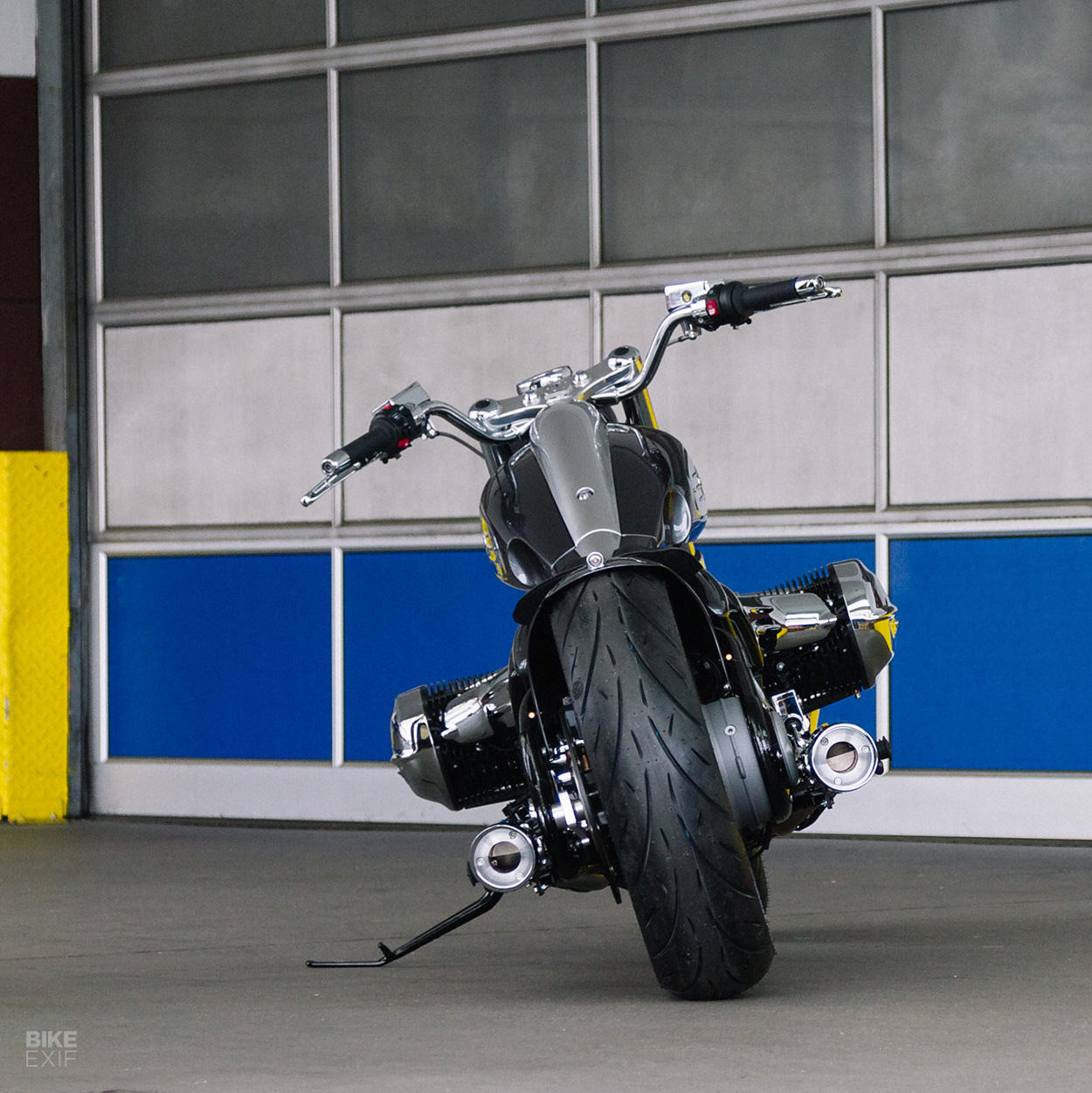
Continue reading...

This week’s custom motorcycles come in all shapes and sizes—from a pint-sized flat tracker, to a stylish BMW R18. Plus we take a look at a tidy BSA bobber, and a Norton Atlas with a Harley-Davidson WLA motor.

Jake Drummond’s Mini Tracker Jake Drummond has some rather crazy skills, but for his latest project, he went small, cheap and cheerful. This mini flat tracker took him three months to build and cost just $1,800, but it’s just as cool as any bike twice its size.
Jake started with a 1968 Yamaha YCS1 rolling chassis he found on Facebook, then sourced a four-speed 140 cc Lifan motor off eBay. Then he built a custom motor cradle, mounts, and a new rear loop to bring it all together.

The front forks are Honda Grom units, and the rear shocks are generic aftermarket items. The wheels are 17” Sun rims, laced to Suzuki RM85 hubs with Buchanan’s spokes, and wrapped in Shinko rubber. And the rear brake is from a 2010 Yamaha YZ250F, with a custom caliper bracket and pedal linkage.
Jake also added a custom aluminum Champion-style gas tank, with an aluminum rear fender and aluminum fork guards. The pleated leather seat is custom too, as are the vacuum-formed number plates.

Up in the cockpit are Vortex handlebars with a BBR throttle and ODI grips. Lower down are the titanium foot pegs from a Suzuki RMZ450.
Jake’s mini-tracker looks cute as a button, and should be wild fun to ride. Let’s hope he races it too—because there’s actually a flat track class for it. [Jake Drummond Instagram | Images by Zach Visser]

Makai Wink’s NorHD 20-year-old Dutchman Makai Wink grew up with his grandparents and parents riding motorcycles, so getting onto two wheels himself was inevitable. His first major project is a doozy: a 1942 Harley-Davidson WLA Liberator motor stuck into a 1967 Norton Atlas frame. And best of all, it was a family project.
Makai’s dad and granddad have been collecting bike parts since they were young, so many of the parts were simply dragged out of the garage.

“We actually call the bike ‘SO’,” says Makai. “It stands for schuur opruiming, sloop onderdelen, which translates to ‘barn clearance, demolition parts’.” But despite it’s bitsa nature, it looks like a million bucks.
The project actually kicked off when Makai was 15. His granddad was selling his house, and found the Harley motor while cleaning out the garage. Makai came up with the idea of sticking it in an Atlas frame—and spent the next winter making that happen. He bought the motor and frame combo off his granddad, and carried on the project with continuous help from both his granddad and his father.

The motor consists of a modified Liberator block, with 1200 inlet valves and KR750 exhaust valves, a 1200 carb, and a balanced crankshaft. There’s a custom pulley system mating the engine to the gearbox.
Makai’s dad helped with the electrics, which were definitely not a walk in the park. “You could throw away the scheme for the wiring harness,” says Makai, “because it’s an American engine in an English bike. And for the English bike it’s a ‘+’ on the frame, and for an American bike it’s a ‘–‘ … we call it ‘swearing in church’.”

Other features include original Norton drum brakes, a restored Smiths clock, and a custom dashboard and battery box. Makai did all the paint and pin-striping himself, redoing some parts four or five times, “because I’m crazy for precision.”
The bike’s finally done, but Makai can’t ride it yet. The Netherlands has a tiered licensing system, and at 20 years old, he’s on his first tier. We bet he can’t wait for that license upgrade. [Makai Wink Instagram | Images by Noortje Blokland]

BSA Thunderbolt by FMW Motorcycles Some of the bikes that have rolled out of Lorenzo Fugaroli’s FMW Motorcycles over the years have been pretty ‘out there.’ But the Italian builder also knows how to play the classics—and the evidence is this flawless BSA hardtail. It’s probably because Lorenzo’s craft was handed down to him from his father, who’s been manipulating metal since 1969.

The donor for this project was a 1970-model Thunderbolt A65T, and it was commissioned by a client. Lorenzo’s turned it into a timeless bobber, but he’s also brought it up to date—with tweaks to help it run lead-free fuel. So it’s sporting updated electrics, a Wassel carb and new valve seats.
Lorenzo fabricated the hardtail frame himself, along with smaller details like the aluminum oil tank and battery box. The fuel tank’s been modified with an embedded classic Smiths speedo, and it sits on custom brass supports.

Details include a sprung solo seat and a tightly mounted rear fender. Every part looks like it belongs—from the tracker-style bars and grips to the side-mounted stop light and cocktail shaker exhausts. It’s a simple, but highly effective, build. [FMW Motorcycles]

BMW R18 by Rabbit Ground Customizing BMW’s gambit of pitching the R18 as a platform for customization has paid off. We’re seeing more and more custom spins on the king-sized boxer, and the bar is being raised at an alarming pace. This latest R18 custom comes from a BMW specialist in Rüsselsheim, Germany and it’s a total banger.
Since RGC is part of a 40-year-old BMW dealership, they decided to pay homage to the iconic /5 ‘toaster tank’ model. So they called in an expert to help hammer out some custom bodywork: Udo Kohse from Unikat-Werk / Bike-Project.

Udo added a ridge atop the R18’s fuel tank, beat in a pair of knee indents, and added a pair of chrome ‘toaster’ panels to the sides. There’s a new seat too, and the frame beneath it is wrapped in a custom piece of bodywork to improve the flow.
Out back is a custom fender, with a ridge that ends with a small embedded taillight. Up front, Udo’s shaped a new enclosure for the OEM headlight that now also houses the speedo.

Other changes include a switch to 21F/18R wheels, custom handlebars, and a set of Kellermann Atto turn signals. The exhaust is a prototype from the Dutch specialist Dr. Jekill & Mr. Hyde and Rabbit Ground have kept the paint classy with a simple grey and silver livery.
It’s an exceptionally well-packaged custom, and another stylish entry into a fast-growing list of R18 customs. [Rabbit Ground Customizing]

Continue reading...
Cop this: Sinroja’s ex-police BMW R80 café racer
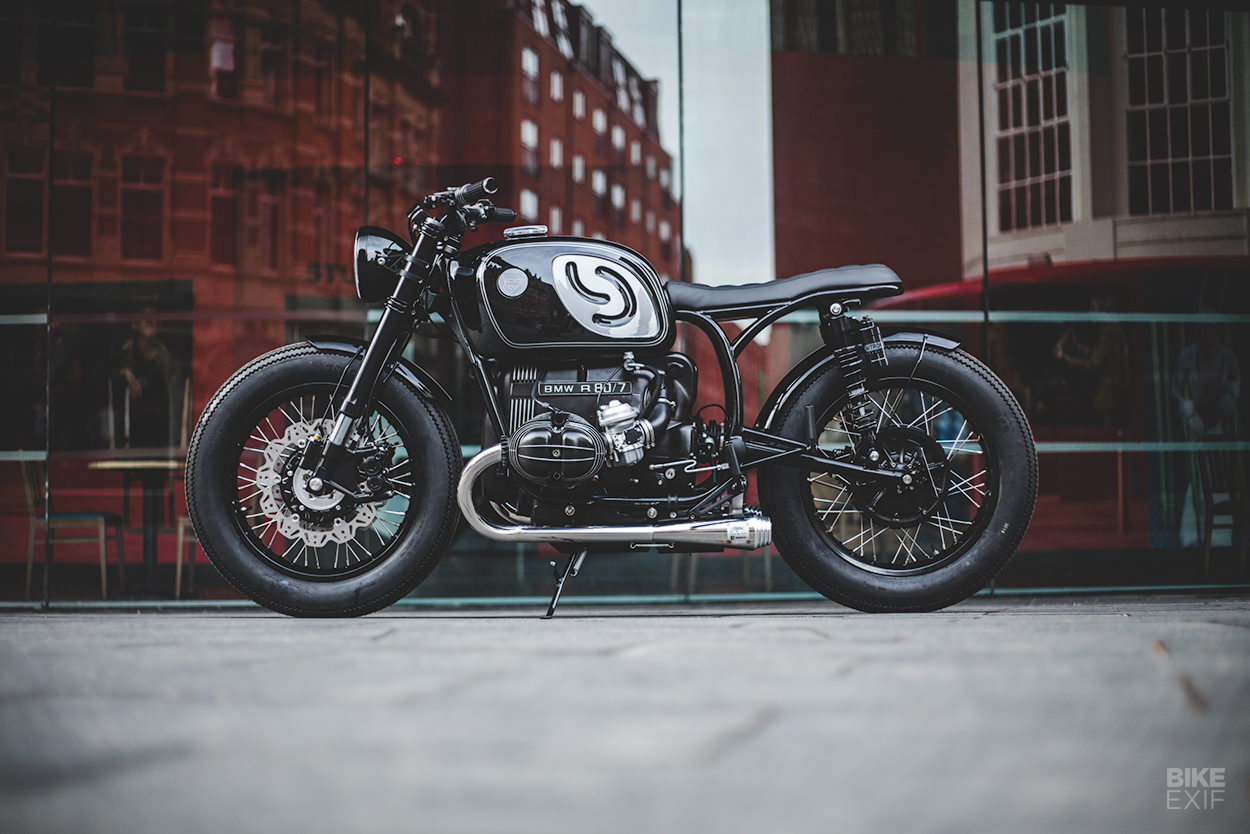
Sinroja Motorcycles have been producing sublime customs from their Leicestershire, England workshop for the past five years. This BMW R80 is their 17th build, and started life two years ago with a very simple brief.
“I want a classic BMW in true Sinroja style, with a good mixture of modern and vintage details,” said the client. For builder Birju Sinroja, this was the perfect commission—offering free reign, and scope to provide a high level of attention to detail.
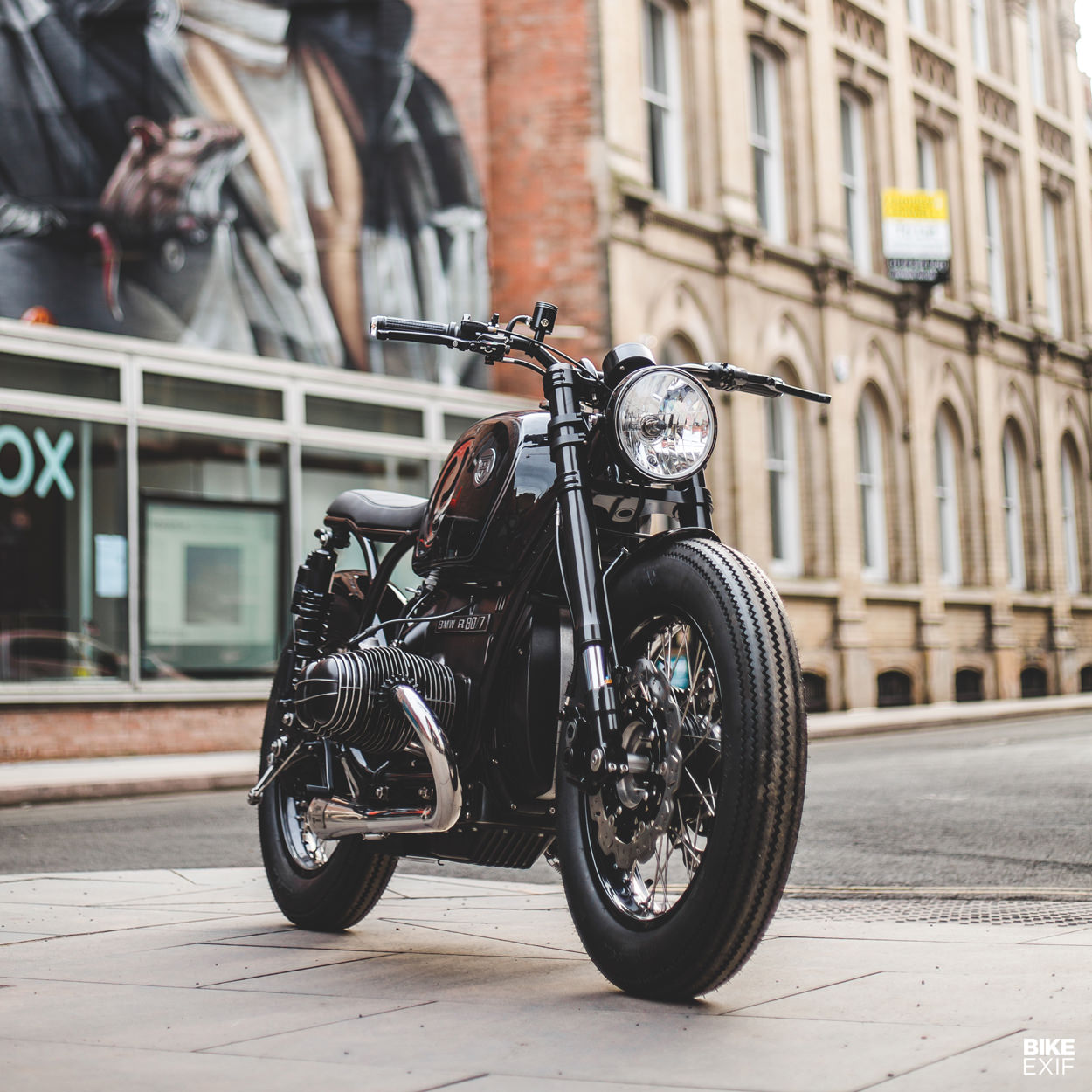
We always have time for a top-drawer airhead custom, and this is up there with the best. The donor bike was a BMW R80 TIC, which means it was built to police specification. (‘TIC’ is reputed to mean ‘Touring Integral Cockpit.’) Rahul Sinroja recalls it being “a true barn find,” but the brothers were unfazed by the condition.
The first step was to strip the whole bike, taking it back to bare metal by sand blasting the frame, and then cleaning up any unnecessary tabs and bracketry.
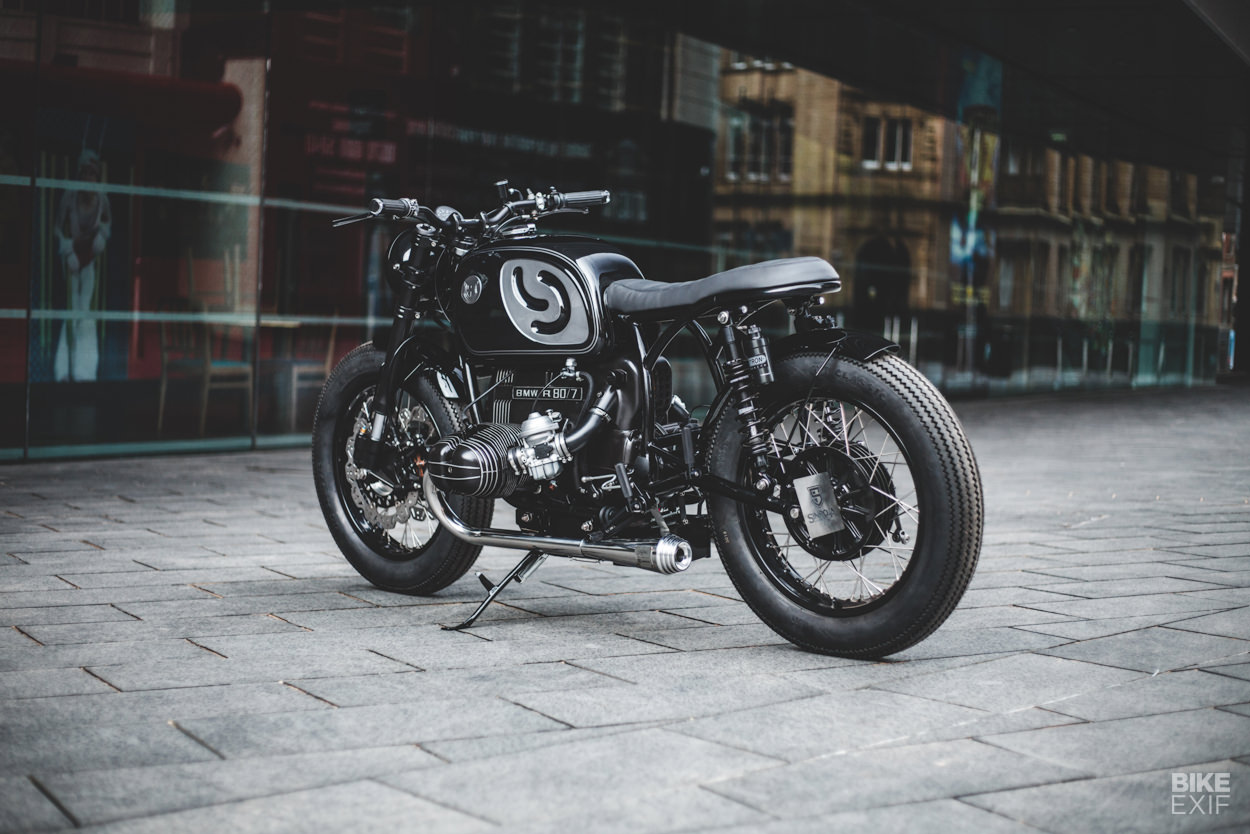
Then Sinroja fabricated and welded on a redesigned subframe, to create a clean line at the back. New footpegs were also fabricated, and positioned to suit the slightly revised ergonomics.
All classic customs that leave the Sinroja workshop get a full engine rebuild and this R80 was no exception. “We stripped the almost 40-year-old powertrain all the way to the crank,” says Birju. “We replaced the key components, like the big end bearings, chains, guides, pushrod tubes and so on, and rebuilt it to better-than-factory standards.”
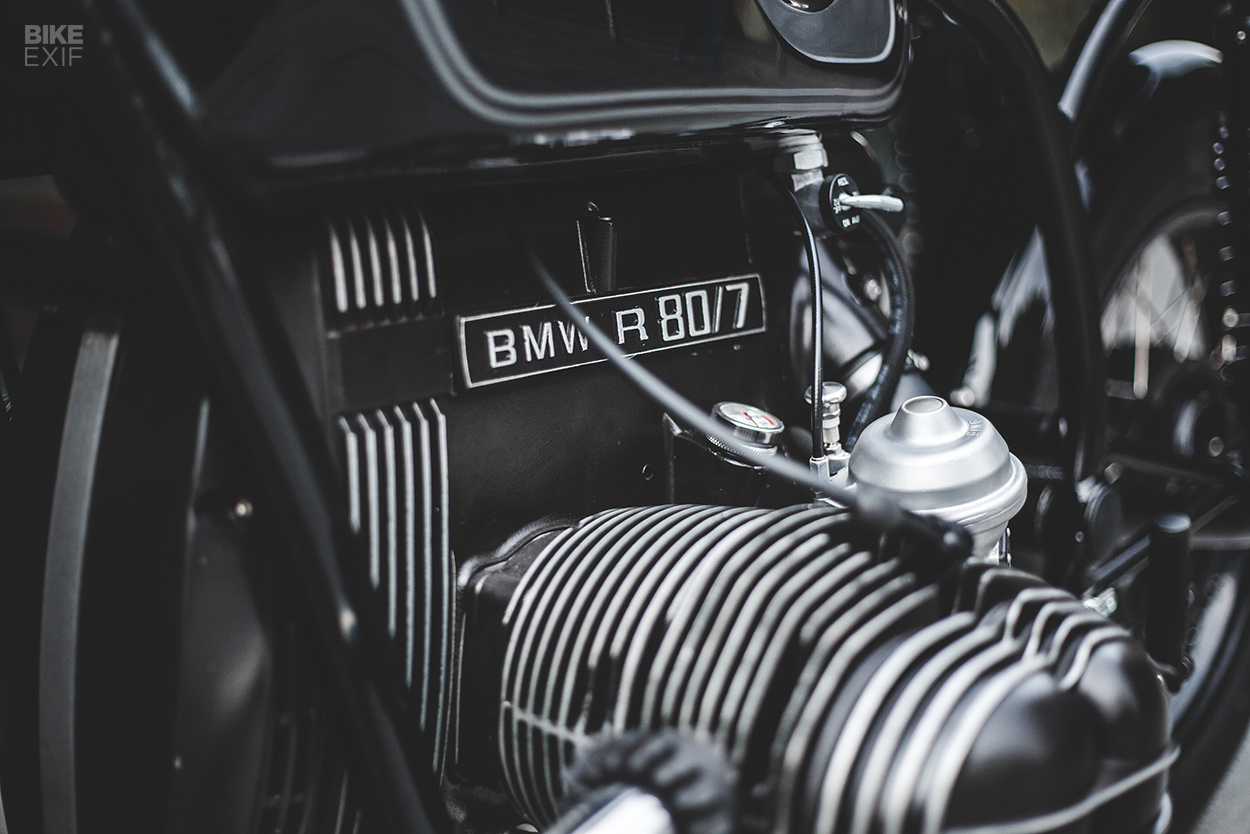
The 797cc boxer engine has also been bumped up to 1000cc, with machined and ported heads and high compression pistons to boost the power higher still. It’s pristine on the outside too, with vapor-blasted cases, black paint and polished fins.
The gearbox and bevel drive got fresh bearings, seals and gaskets, and the carburetors were rebuilt with bigger jets to suit the upgraded engine. The exhaust pipework was fabricated in-house, and then finished off with custom end cans from Motone.
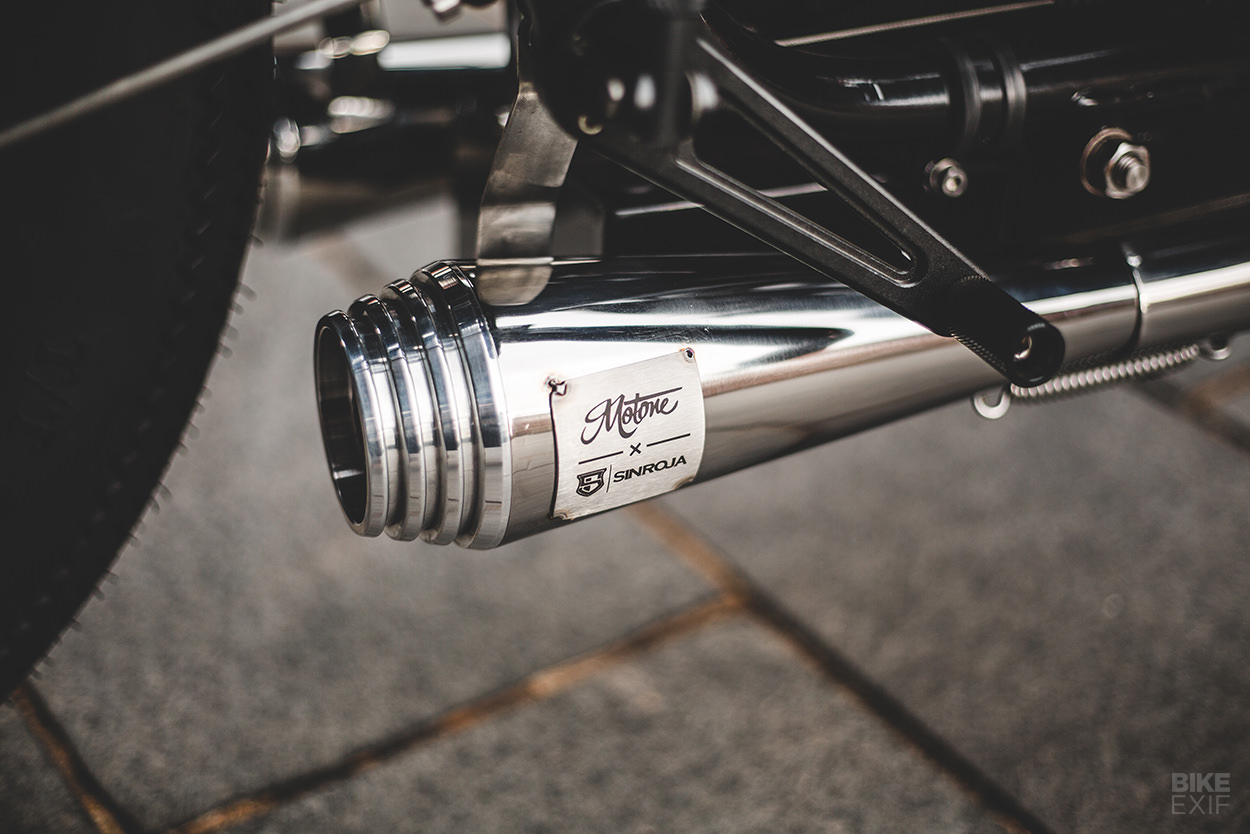
Handling is vastly improved with a custom suspension set-up: Birju has reworked a set of Yamaha R6 forks with race-spec Nitron cartridges, and installed fully adjustable Nitron rear shocks.
The forks retain the R6 calipers for improved braking performance, and they’re hooked up to the frame via custom yokes, billet machined by Fastec Racing (and hosting a Motogadget Chronoclassic speedo). Then Hagon built up a pair of 18-inch wire wheels, using custom-made rims and stainless spokes.
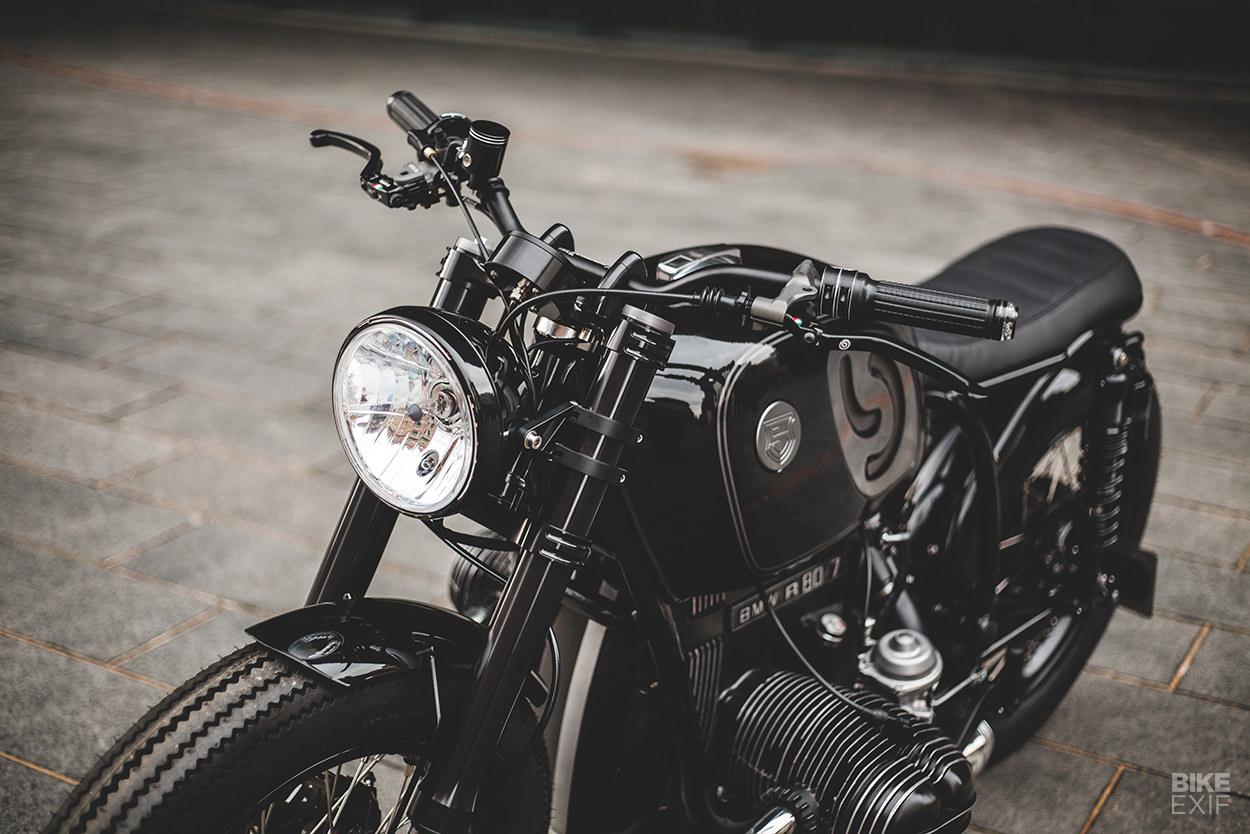
There are handmade fenders front and back—a wise decision in rainy England—and they’re neatly suspended with discreet struts.
Even more discreet is the brand-new wiring loom, from the motorcycle wiring specialist TowzaTronics. At the heart of the loom sits a Motogadget m.unit Blue control box, which has a Bluetooth phone connection for diagnostics and a keyless ignition system controlled by the owner’s phone.
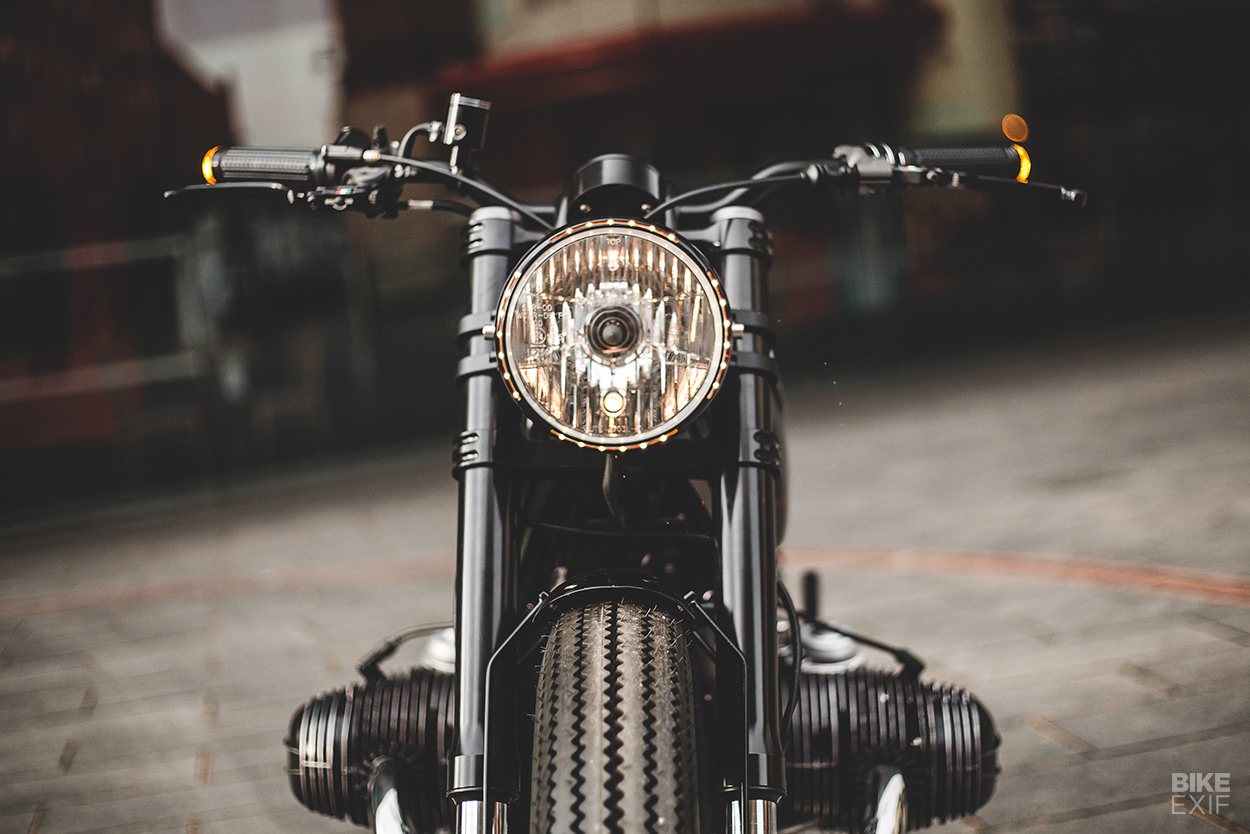
The R80 is also fitted with Motogadget switches, bar end indicators and grips, plus a 7-inch halo-style headlight. The rear indicators are from Rizoma and double up as brake and running lights.
The paint is by GD Design: a stunning black and Land Rover ‘Corris Grey’ livery, drawing inspiration from the client’s love of Britain’s iconic 4WD brand. The seat stitching mirrors that of the cars, and even the saddle leather came from a Land Rover.
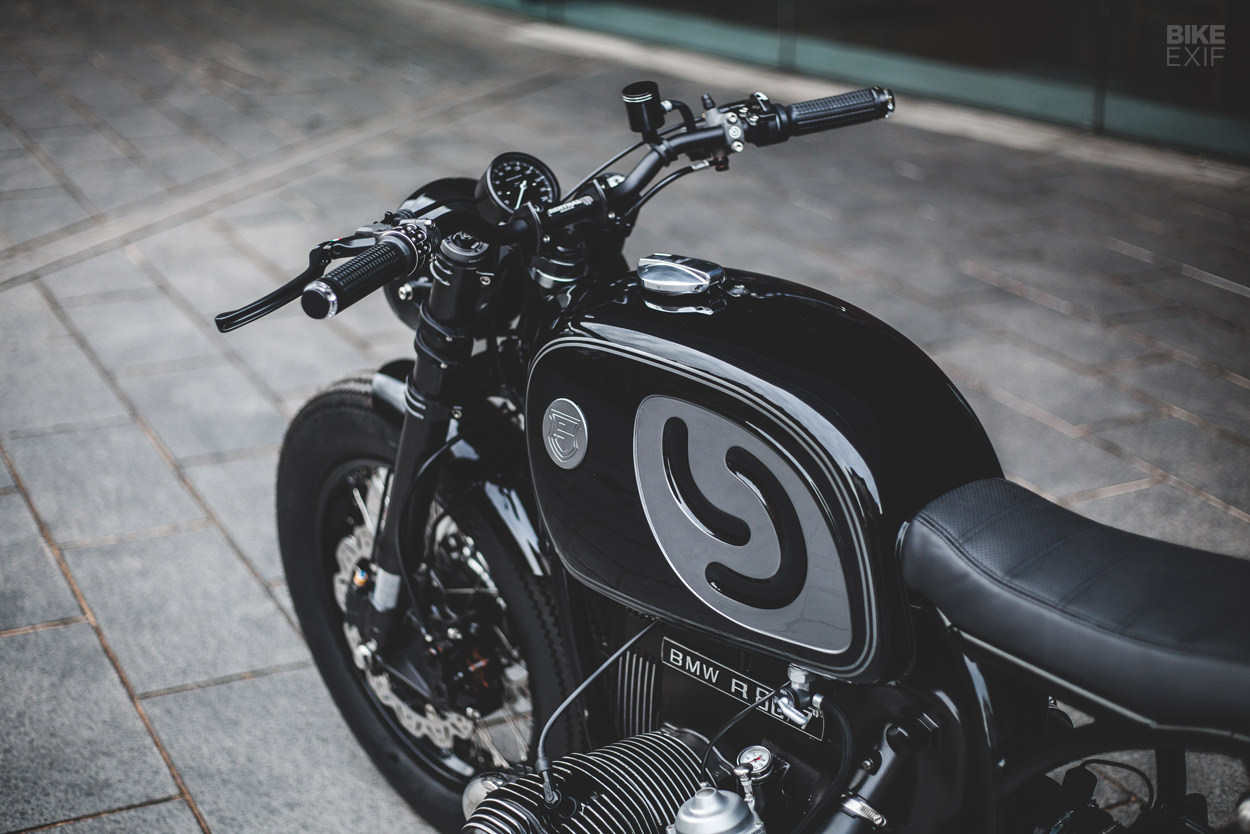
The aesthetics are finished off with machined Sinroja emblems that sit on the tank where you’d normally find kneepads.
‘R17’ is one of the best examples of the custom airhead genre we’ve seen recently, but Birju is quick to point out that it’s a joint effort between client and builder. “It’s great to be in a place where customers just let you do what you want, and have trust and faith in the skills we have.”
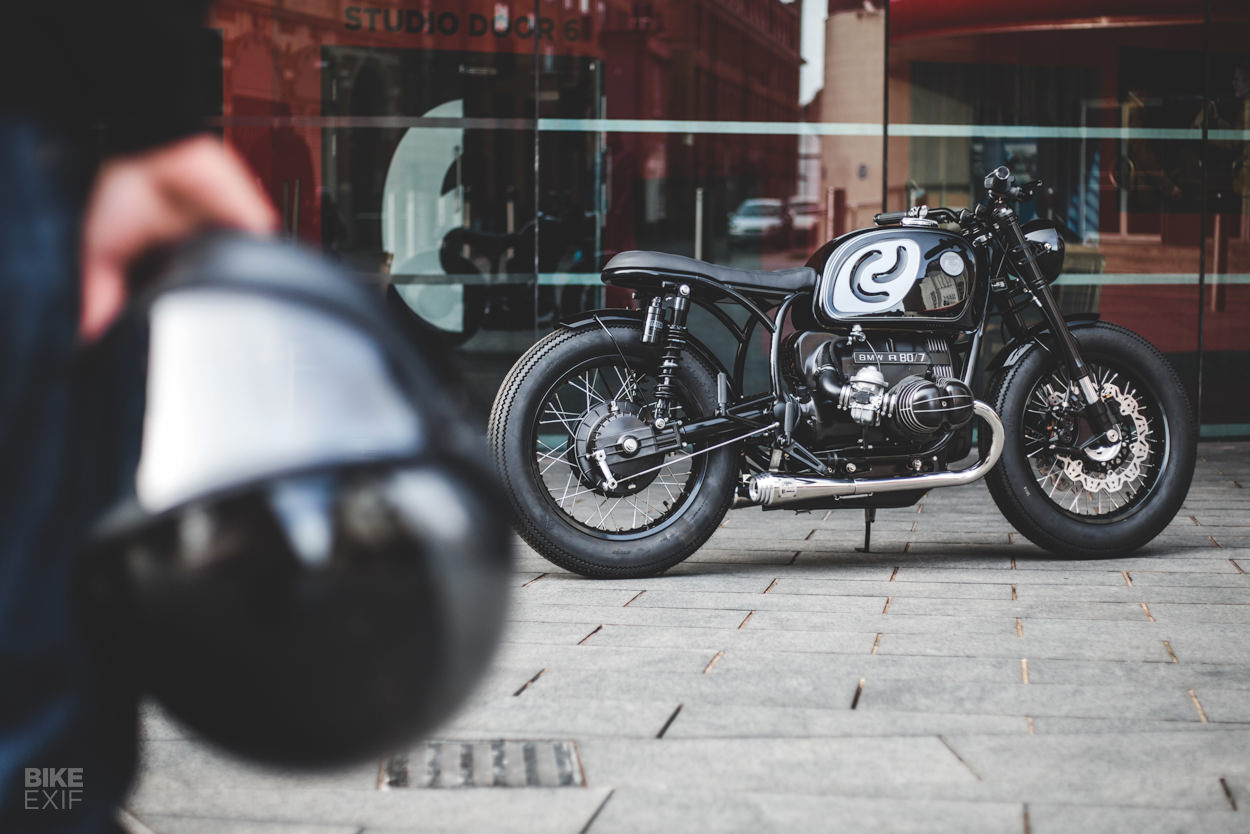
“Giving rebirth to an old airhead that had been neglected for years in a barn is just a great feeling.”
We reckon the owner had a great feeling too, when he saw the result. It’s proof that choosing a skilled workshop and putting your trust in them will pay dividends.
Sinroja Motorcycles | Facebook | Instagram | Images by Tom Horna
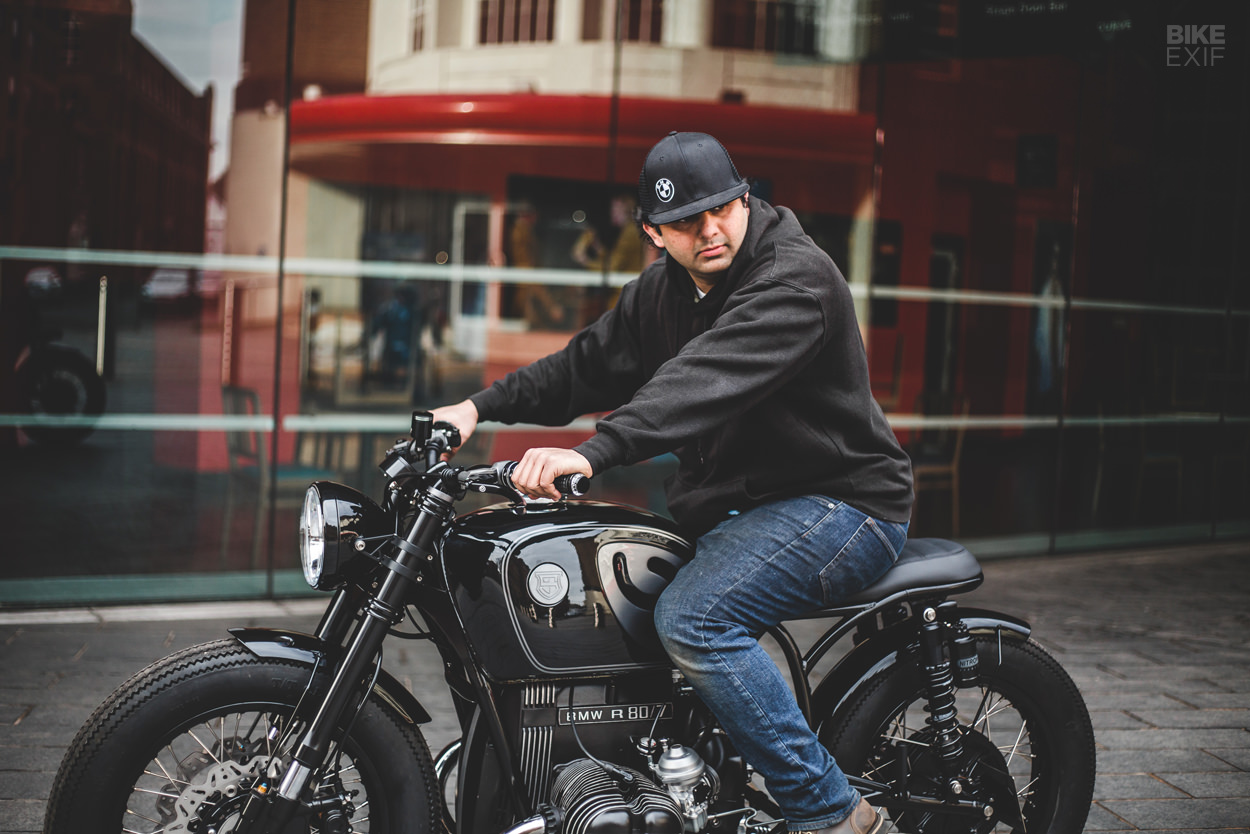
Continue reading...

Sinroja Motorcycles have been producing sublime customs from their Leicestershire, England workshop for the past five years. This BMW R80 is their 17th build, and started life two years ago with a very simple brief.
“I want a classic BMW in true Sinroja style, with a good mixture of modern and vintage details,” said the client. For builder Birju Sinroja, this was the perfect commission—offering free reign, and scope to provide a high level of attention to detail.

We always have time for a top-drawer airhead custom, and this is up there with the best. The donor bike was a BMW R80 TIC, which means it was built to police specification. (‘TIC’ is reputed to mean ‘Touring Integral Cockpit.’) Rahul Sinroja recalls it being “a true barn find,” but the brothers were unfazed by the condition.
The first step was to strip the whole bike, taking it back to bare metal by sand blasting the frame, and then cleaning up any unnecessary tabs and bracketry.

Then Sinroja fabricated and welded on a redesigned subframe, to create a clean line at the back. New footpegs were also fabricated, and positioned to suit the slightly revised ergonomics.
All classic customs that leave the Sinroja workshop get a full engine rebuild and this R80 was no exception. “We stripped the almost 40-year-old powertrain all the way to the crank,” says Birju. “We replaced the key components, like the big end bearings, chains, guides, pushrod tubes and so on, and rebuilt it to better-than-factory standards.”

The 797cc boxer engine has also been bumped up to 1000cc, with machined and ported heads and high compression pistons to boost the power higher still. It’s pristine on the outside too, with vapor-blasted cases, black paint and polished fins.
The gearbox and bevel drive got fresh bearings, seals and gaskets, and the carburetors were rebuilt with bigger jets to suit the upgraded engine. The exhaust pipework was fabricated in-house, and then finished off with custom end cans from Motone.

Handling is vastly improved with a custom suspension set-up: Birju has reworked a set of Yamaha R6 forks with race-spec Nitron cartridges, and installed fully adjustable Nitron rear shocks.
The forks retain the R6 calipers for improved braking performance, and they’re hooked up to the frame via custom yokes, billet machined by Fastec Racing (and hosting a Motogadget Chronoclassic speedo). Then Hagon built up a pair of 18-inch wire wheels, using custom-made rims and stainless spokes.

There are handmade fenders front and back—a wise decision in rainy England—and they’re neatly suspended with discreet struts.
Even more discreet is the brand-new wiring loom, from the motorcycle wiring specialist TowzaTronics. At the heart of the loom sits a Motogadget m.unit Blue control box, which has a Bluetooth phone connection for diagnostics and a keyless ignition system controlled by the owner’s phone.

The R80 is also fitted with Motogadget switches, bar end indicators and grips, plus a 7-inch halo-style headlight. The rear indicators are from Rizoma and double up as brake and running lights.
The paint is by GD Design: a stunning black and Land Rover ‘Corris Grey’ livery, drawing inspiration from the client’s love of Britain’s iconic 4WD brand. The seat stitching mirrors that of the cars, and even the saddle leather came from a Land Rover.

The aesthetics are finished off with machined Sinroja emblems that sit on the tank where you’d normally find kneepads.
‘R17’ is one of the best examples of the custom airhead genre we’ve seen recently, but Birju is quick to point out that it’s a joint effort between client and builder. “It’s great to be in a place where customers just let you do what you want, and have trust and faith in the skills we have.”

“Giving rebirth to an old airhead that had been neglected for years in a barn is just a great feeling.”
We reckon the owner had a great feeling too, when he saw the result. It’s proof that choosing a skilled workshop and putting your trust in them will pay dividends.
Sinroja Motorcycles | Facebook | Instagram | Images by Tom Horna

Continue reading...
AMERICAN GRAFFITI: Indian FTR 1200 S by Church of Choppers.
It’s true that there is a lot to learn from a name and Church Of Choppers has been producing some of the scenes best Harley’s for a very long time. But don’t let it fool you, when it comes to motorcycles there is almost nothing that Iowa’s Jeff Wright can’t do. From incredible Choppers and Bobbers to modern machines and re-imagining Sport Bikes, his ability to build custom cool is among the world’...
Source
It’s true that there is a lot to learn from a name and Church Of Choppers has been producing some of the scenes best Harley’s for a very long time. But don’t let it fool you, when it comes to motorcycles there is almost nothing that Iowa’s Jeff Wright can’t do. From incredible Choppers and Bobbers to modern machines and re-imagining Sport Bikes, his ability to build custom cool is among the world’...
Source
Second wind: A Yamaha DT175 reconfigured for the road
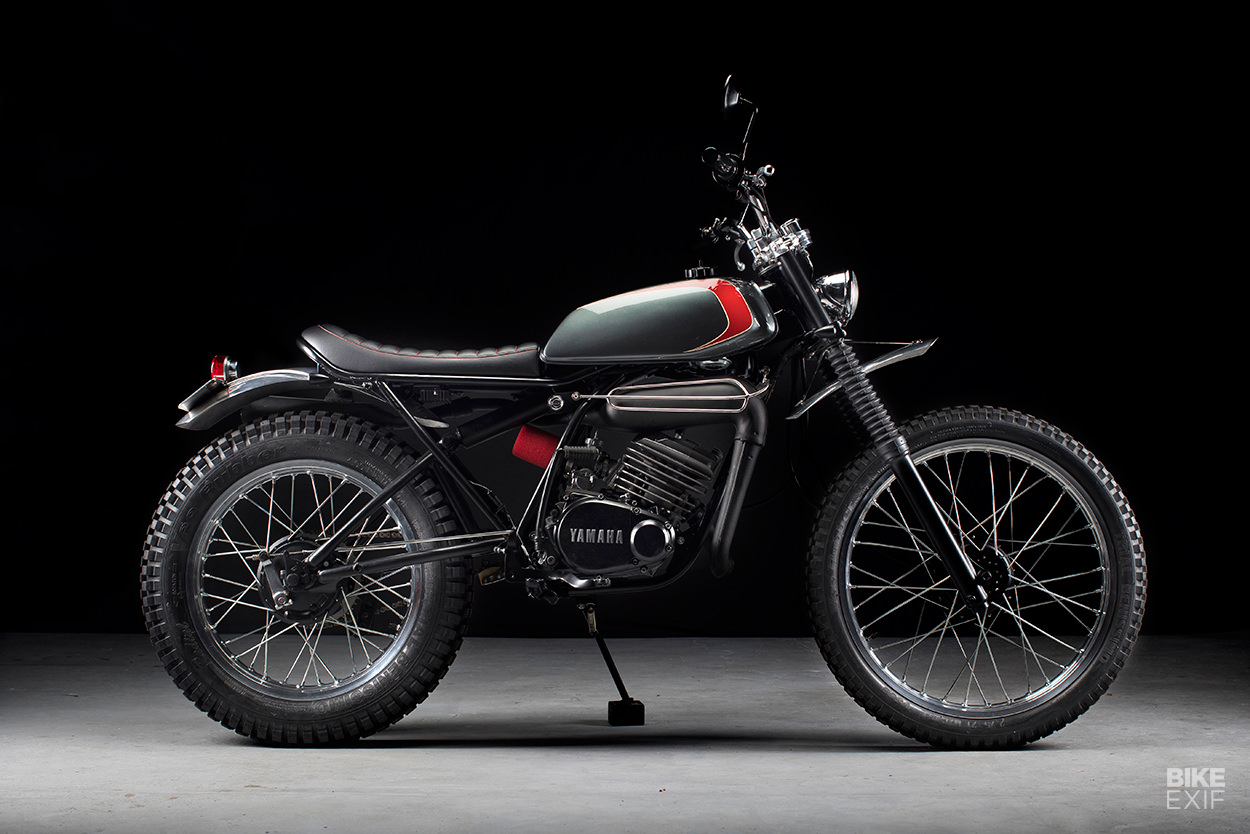
The Yamaha DT175 is one of those classic bikes that look ‘just right.’ With a small tank, fat seat and raised fenders, it’s a pint-sized enduro machine that screams fun.
The DT175 we’ve got here, however, was most definitely not looking good when it rolled into the workshop of Sabotage Motorcycles in Sydney, New South Wales. It was rough around the edges and very tired—as you’d expect of a two-stroke that’s almost half a century old.
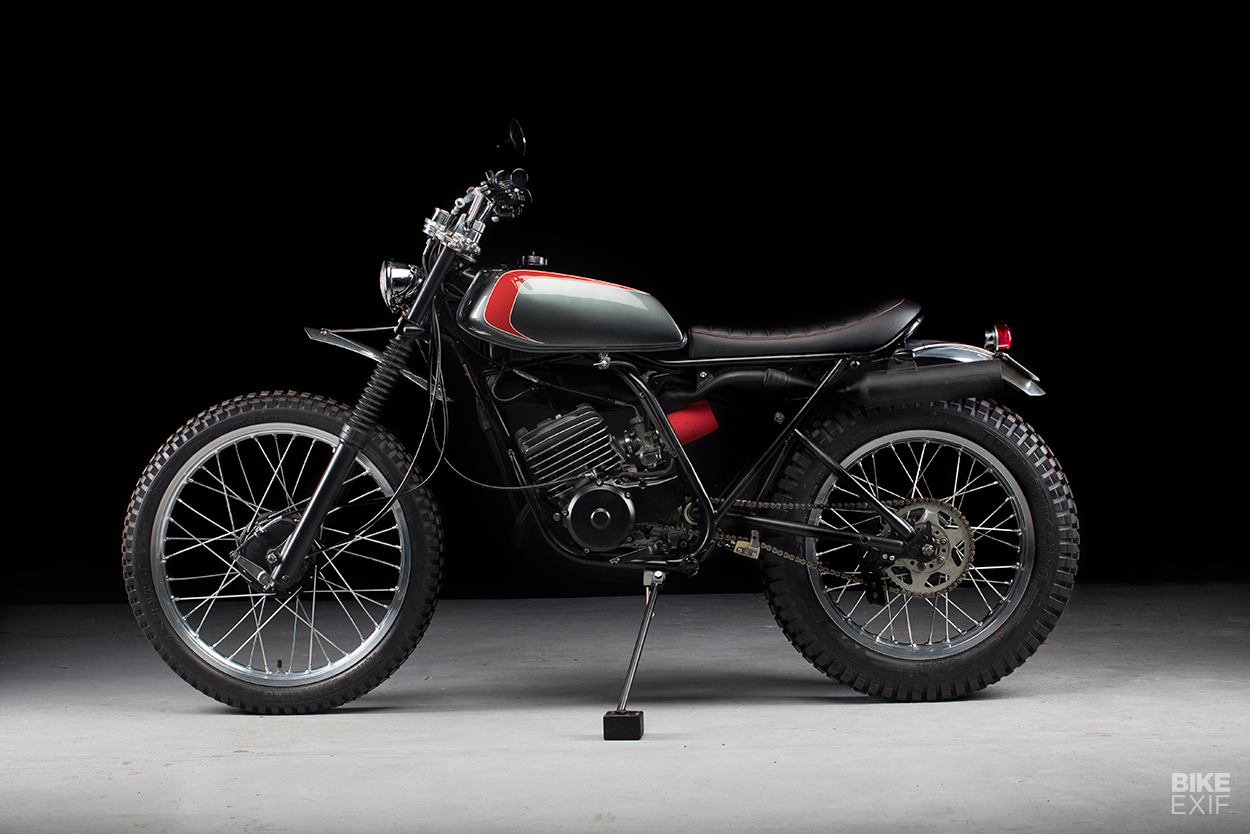
This didn’t faze Giles Colliver and Andy Dorr, who have been running Sabotage for the past five years. It’s their bread and butter, because they focus on restorations and restomods, mostly on pre-80s Japanese bikes.
As well as engine work and metal fabrication, they’re happy to tackle electrics and wiring too—an aspect that many shops prefer to farm out.
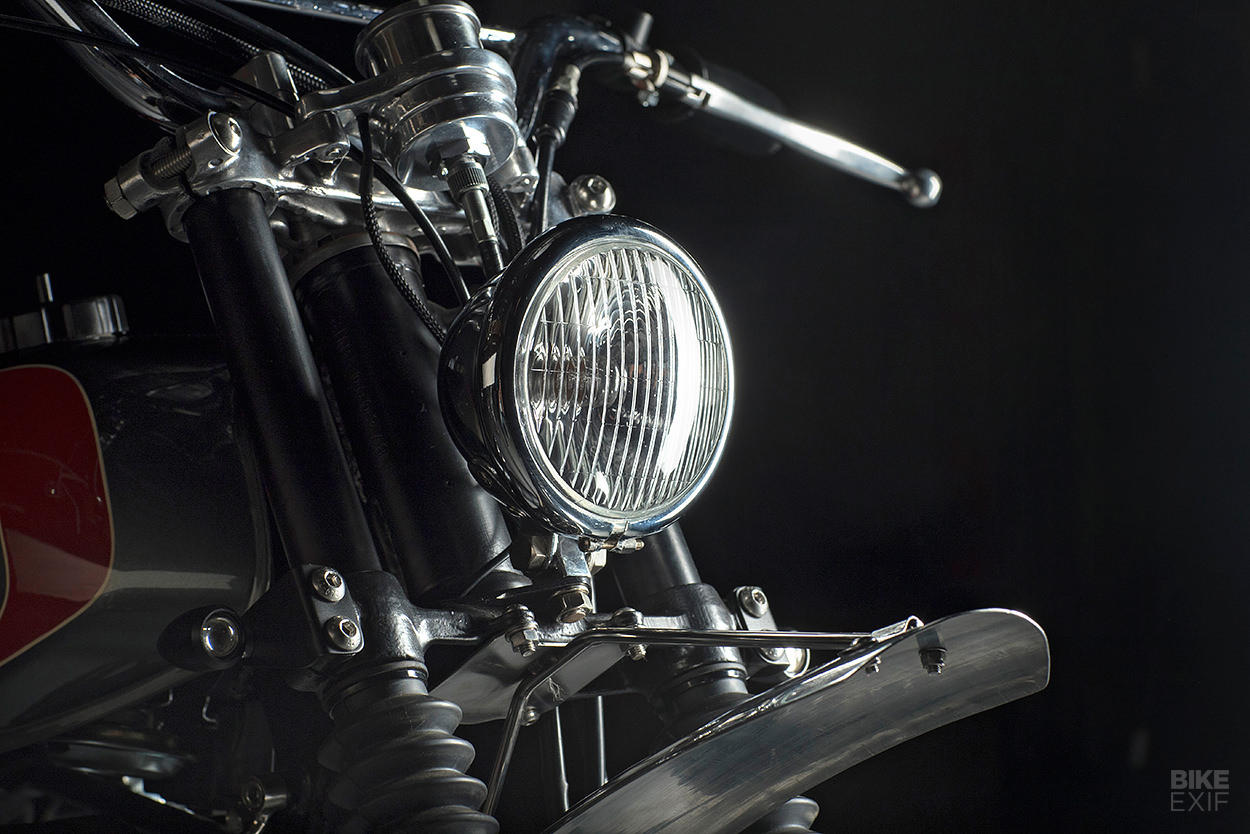
“We were contacted by a guy who wanted his DT175 made road legal, and more exciting to look at,” says Giles. “He loved the fact that we only do vintage motorcycle builds, and thought we had a slightly ‘different’ approach to things. So this 1978 Yamaha fitted that bill nicely.”
Sabotage’s client is ex-military, and had to leave the service due to PTSD. “He has a very creative side to him,” Giles says. “He now builds custom cruiser bicycles, and converts some of them to e-bikes.
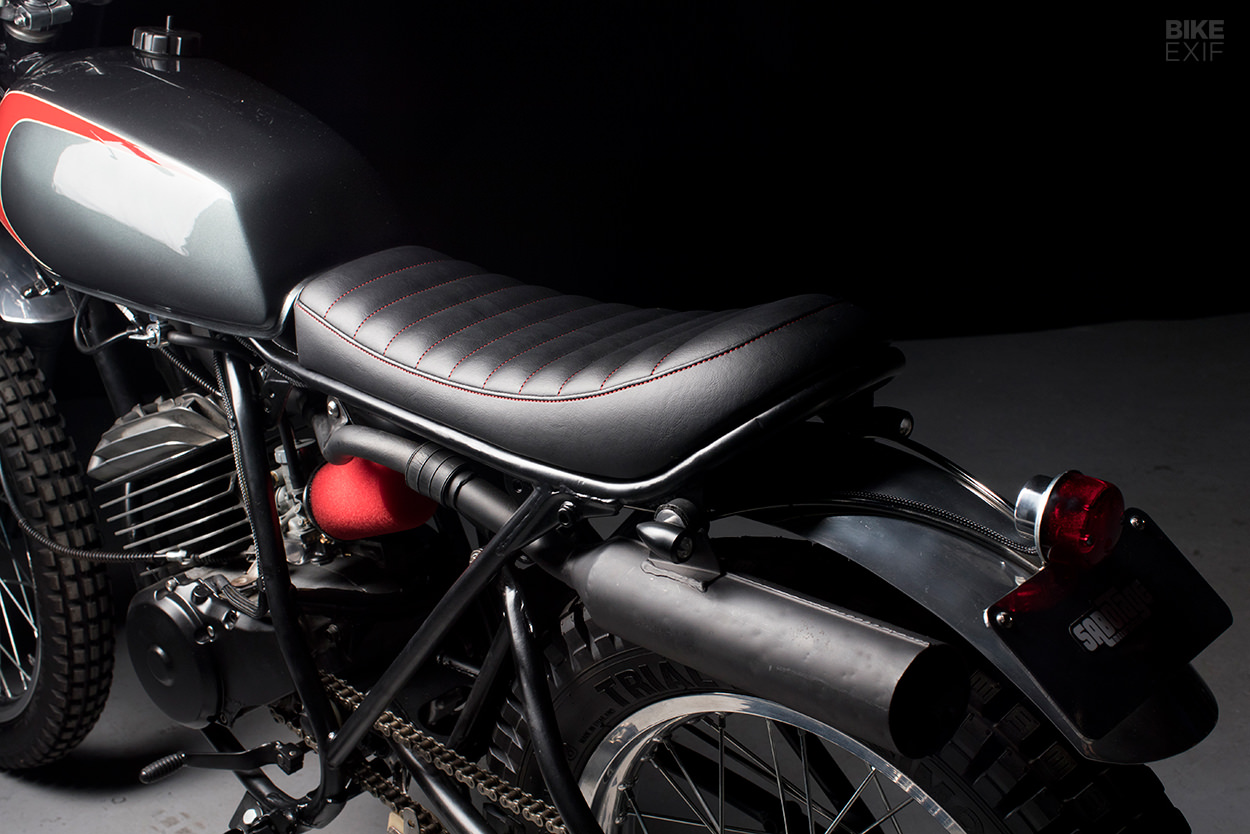
“He knew what he wanted with the DT175, but still gave us plenty of freedom with the design. Which is very important to us, because our process for building bikes is quite fluid.”
With the Yamaha in the workshop, Giles and Andy had to tackle plenty of rust, and figure out which bits were missing. But the single cylinder two-stroke engine ran beautifully.
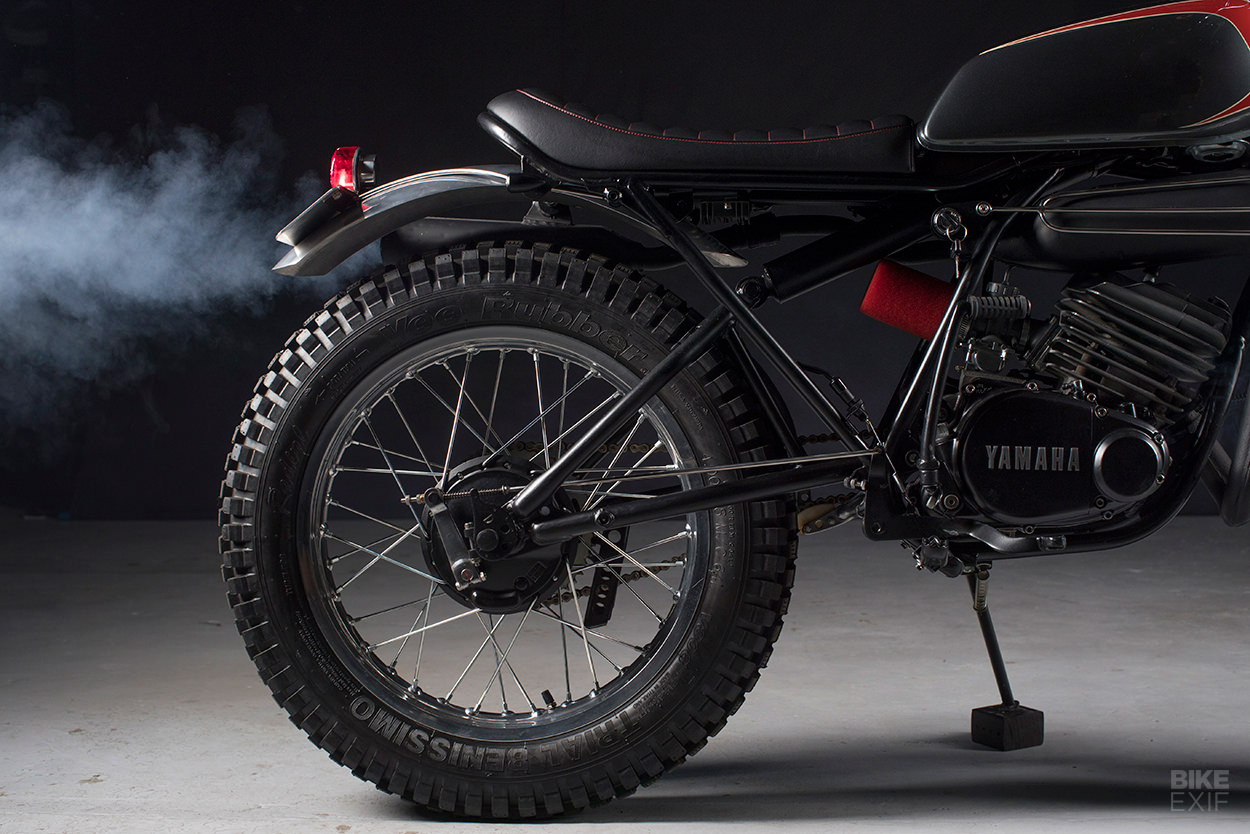
The most glaring issue was the tank. It wasn’t the original DT tank, so it didn’t sit properly on the frame. “We adapted the frame quite a bit so the tank would sit securely, and level. Which then led to the seat design.”
Sabotage have retained the slight upkick of the stock DT175 bread loaf seat, but the new pad is slightly slimmer and shorter. Upholstered by Sydney specialist Bad Arse Trim, it fits snugly into a shortened new rear frame loop—which improves the proportions of the bike without sacrificing practicality.
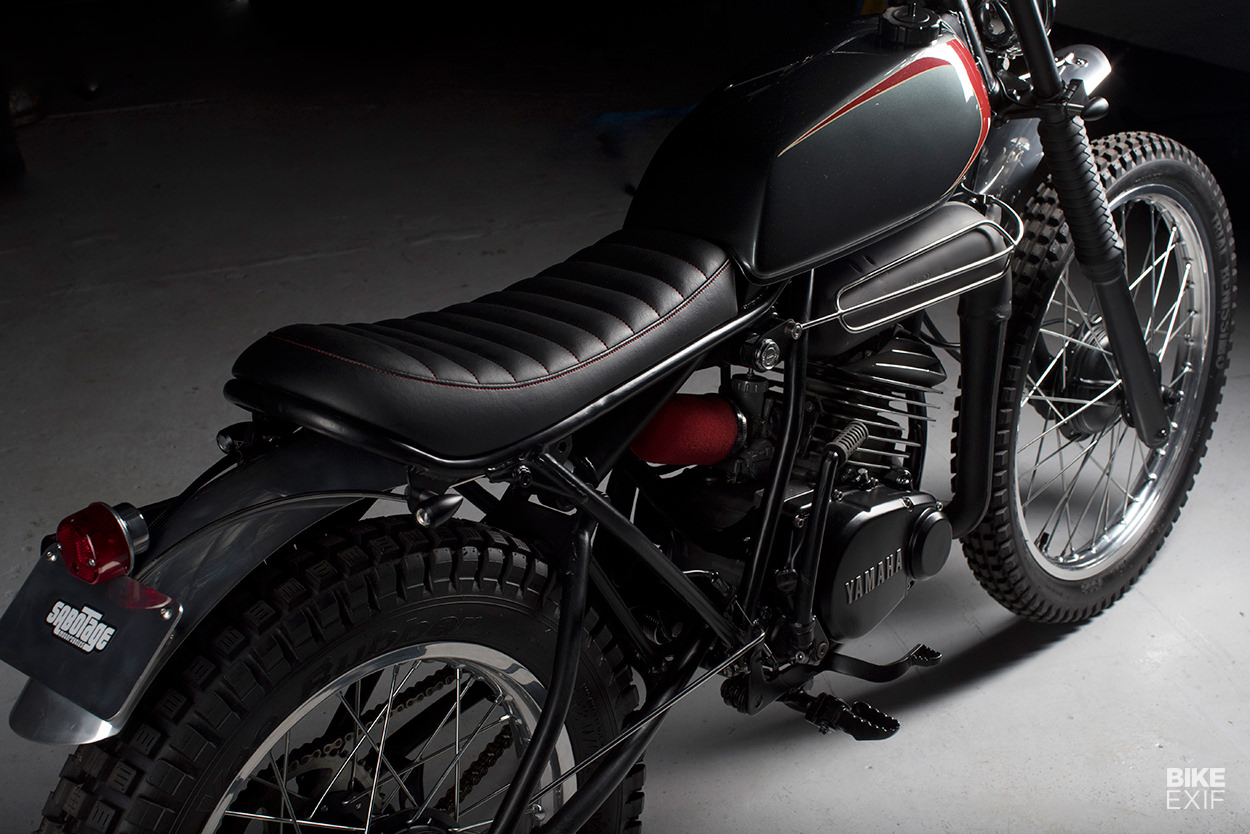
The original chrome rims were rusted through, so the guys replaced them with new aluminum rims and spokes, and reconditioned and painted the original hubs.
The fenders and mounts are hand-made, and look much more integrated than the 1970s originals. “We spent a while working out the correct radius of the fenders, and the correct height for them to sit,” says Giles.
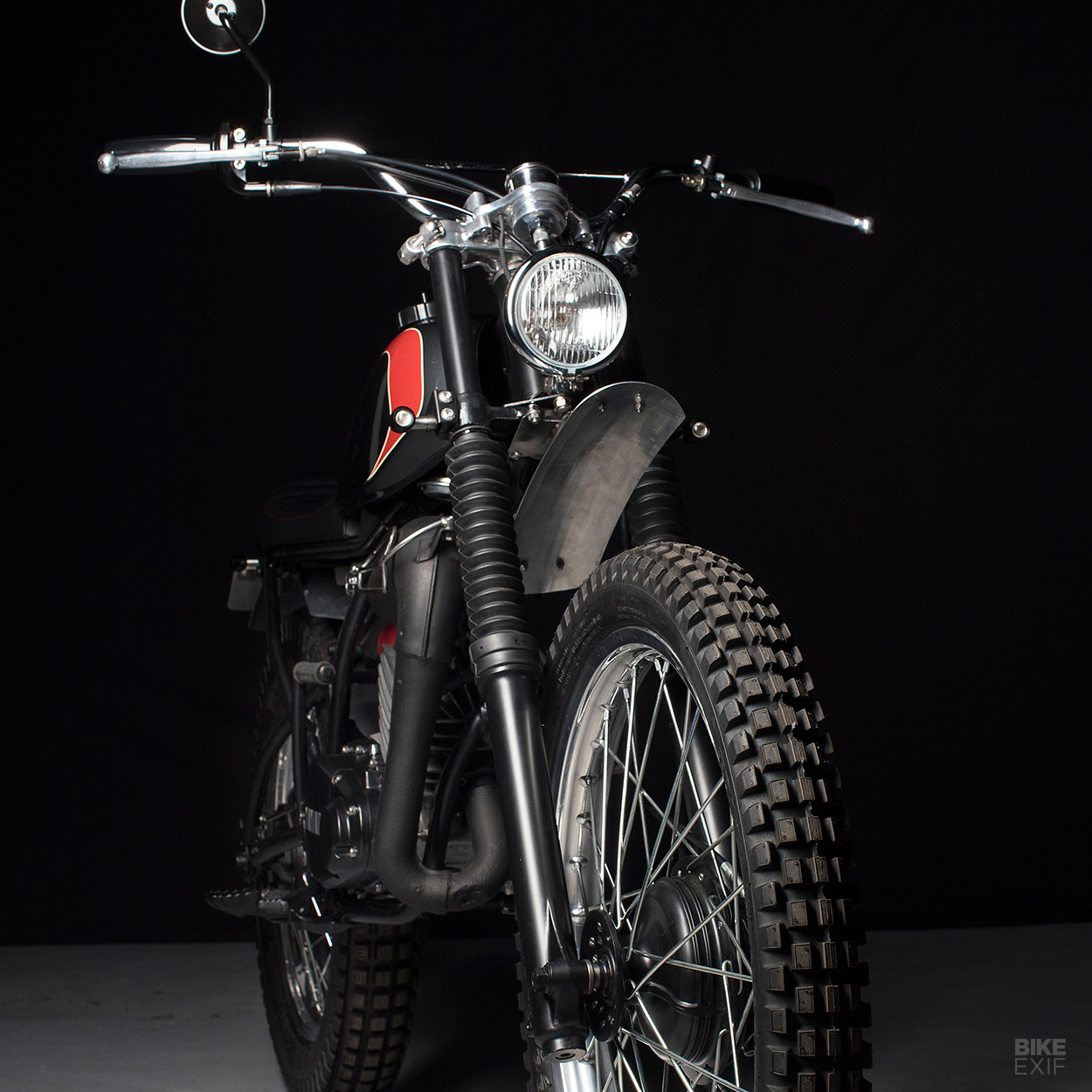
“This is a bike meant more for road use, so we didn’t want the fenders sitting too high—we wanted to blur the dirt bike/road bike image of this DT.” The raw metal finish looks much classier than thick plastic, too.
In keeping with the new road registration, Sabotage stiffened the rear monoshock to give a more stable ride. Then they rebuilt the tired forks to take out the slop and keep the damping smooth. Right above them is a new speedo, embedded into a hand-made aluminum housing. Wiring now runs through the bars for a super-sano look.
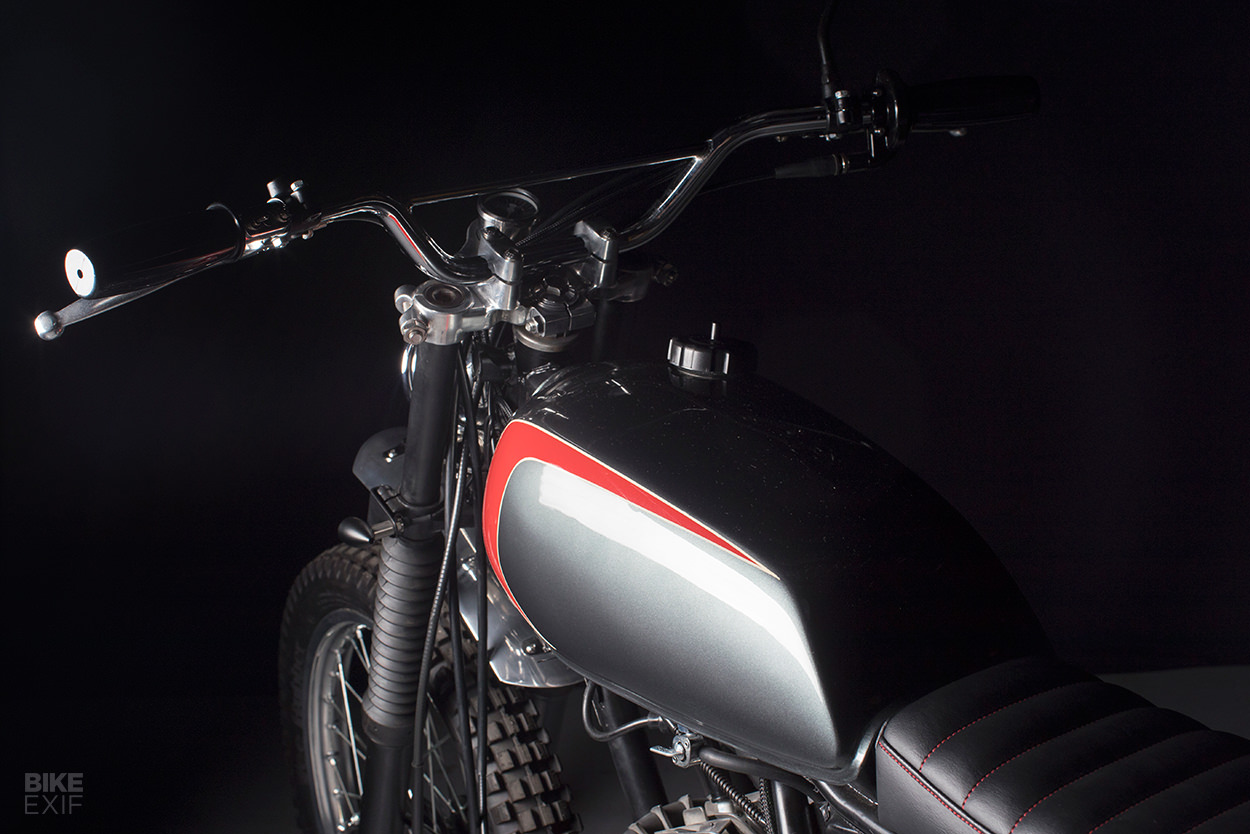
The engine was strong, so the internals are unmolested. It has plenty of two-stroke punch to push the featherweight Yammie around—contemporary reports put the dry weight of the stock bike at just 220 pounds (100 kg).
Sabotage have reconditioned the exhaust though, refinishing it with matt black heat resistant ceramic paint, and made a new heat shield from stainless steel.
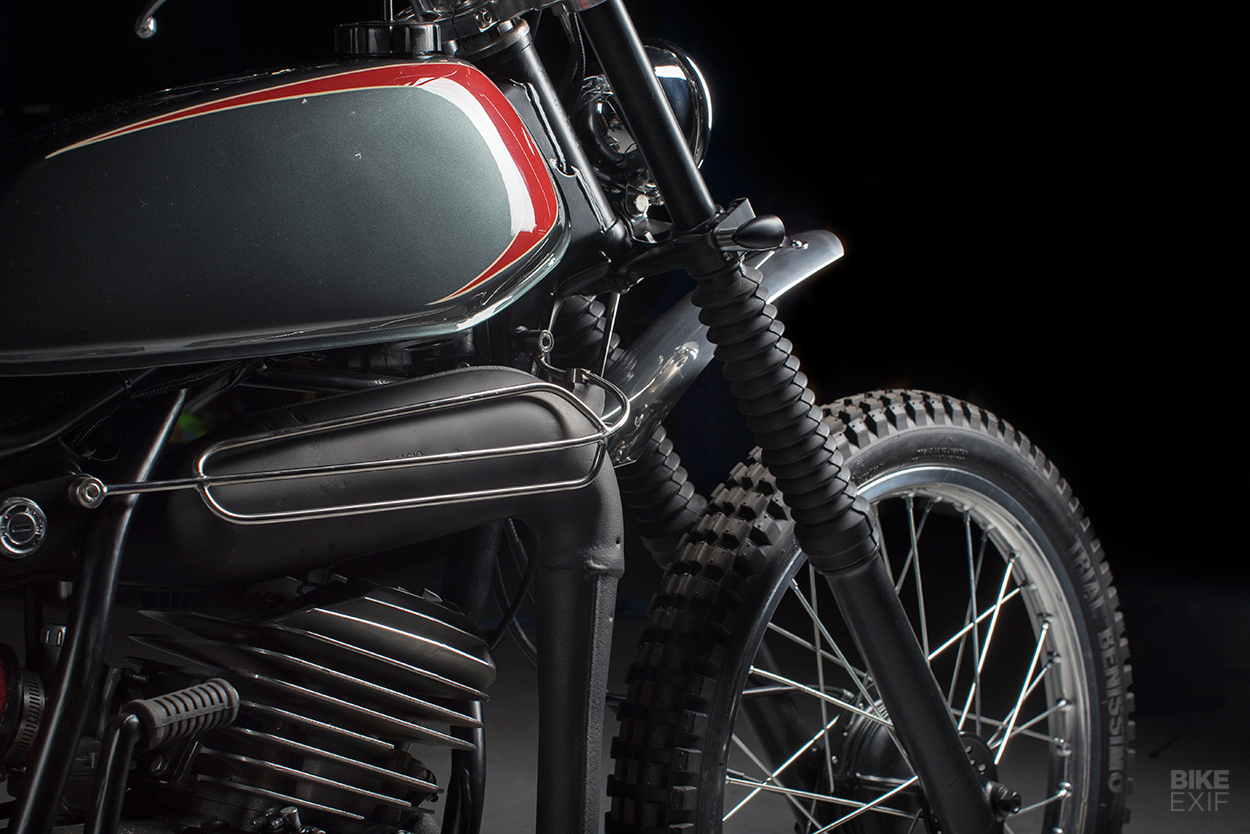
The final touch is a discreet one: the enormous rear light cluster of the stock DT175 has gone. “We made an aluminum housing for a brake light, making sure the position of the light was not only legal, but also proportionally correct,” says Giles.
With crisp new paint by Smith Concepts—one of Australia’s top custom car and bike paint shops—the little DT was finally ready to hit the road.
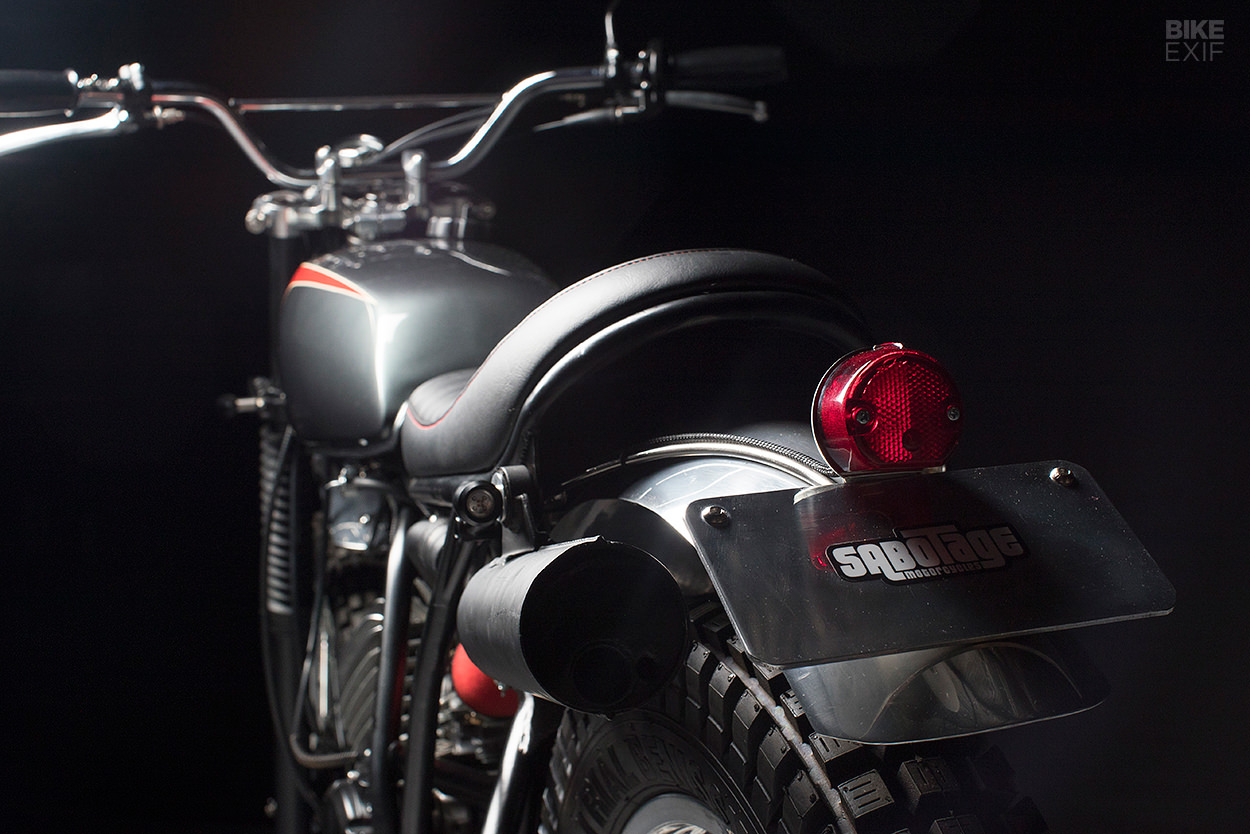
“We set out to make this bike usable, minimal, and functional,” says Giles. “And lots of fun. I think we achieved that.”
We reckon they did too. This little two-stroke probably won’t see much mud in the future—but blasting around the streets of Sydney is a mighty fine way to enjoy a second wind.
Sabotage Motorcycles | Facebook | Instagram | Photos by Brent Lewin
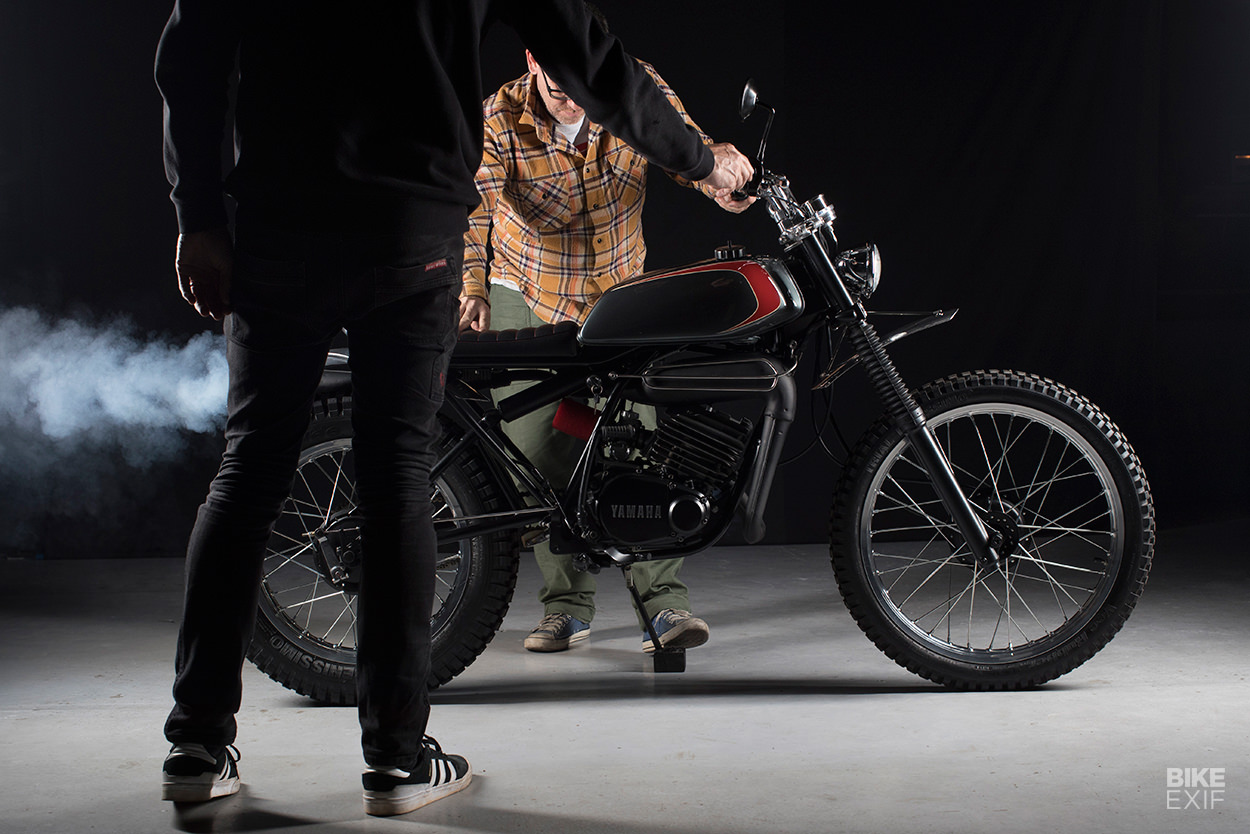
Continue reading...

The Yamaha DT175 is one of those classic bikes that look ‘just right.’ With a small tank, fat seat and raised fenders, it’s a pint-sized enduro machine that screams fun.
The DT175 we’ve got here, however, was most definitely not looking good when it rolled into the workshop of Sabotage Motorcycles in Sydney, New South Wales. It was rough around the edges and very tired—as you’d expect of a two-stroke that’s almost half a century old.

This didn’t faze Giles Colliver and Andy Dorr, who have been running Sabotage for the past five years. It’s their bread and butter, because they focus on restorations and restomods, mostly on pre-80s Japanese bikes.
As well as engine work and metal fabrication, they’re happy to tackle electrics and wiring too—an aspect that many shops prefer to farm out.

“We were contacted by a guy who wanted his DT175 made road legal, and more exciting to look at,” says Giles. “He loved the fact that we only do vintage motorcycle builds, and thought we had a slightly ‘different’ approach to things. So this 1978 Yamaha fitted that bill nicely.”
Sabotage’s client is ex-military, and had to leave the service due to PTSD. “He has a very creative side to him,” Giles says. “He now builds custom cruiser bicycles, and converts some of them to e-bikes.

“He knew what he wanted with the DT175, but still gave us plenty of freedom with the design. Which is very important to us, because our process for building bikes is quite fluid.”
With the Yamaha in the workshop, Giles and Andy had to tackle plenty of rust, and figure out which bits were missing. But the single cylinder two-stroke engine ran beautifully.

The most glaring issue was the tank. It wasn’t the original DT tank, so it didn’t sit properly on the frame. “We adapted the frame quite a bit so the tank would sit securely, and level. Which then led to the seat design.”
Sabotage have retained the slight upkick of the stock DT175 bread loaf seat, but the new pad is slightly slimmer and shorter. Upholstered by Sydney specialist Bad Arse Trim, it fits snugly into a shortened new rear frame loop—which improves the proportions of the bike without sacrificing practicality.

The original chrome rims were rusted through, so the guys replaced them with new aluminum rims and spokes, and reconditioned and painted the original hubs.
The fenders and mounts are hand-made, and look much more integrated than the 1970s originals. “We spent a while working out the correct radius of the fenders, and the correct height for them to sit,” says Giles.

“This is a bike meant more for road use, so we didn’t want the fenders sitting too high—we wanted to blur the dirt bike/road bike image of this DT.” The raw metal finish looks much classier than thick plastic, too.
In keeping with the new road registration, Sabotage stiffened the rear monoshock to give a more stable ride. Then they rebuilt the tired forks to take out the slop and keep the damping smooth. Right above them is a new speedo, embedded into a hand-made aluminum housing. Wiring now runs through the bars for a super-sano look.

The engine was strong, so the internals are unmolested. It has plenty of two-stroke punch to push the featherweight Yammie around—contemporary reports put the dry weight of the stock bike at just 220 pounds (100 kg).
Sabotage have reconditioned the exhaust though, refinishing it with matt black heat resistant ceramic paint, and made a new heat shield from stainless steel.

The final touch is a discreet one: the enormous rear light cluster of the stock DT175 has gone. “We made an aluminum housing for a brake light, making sure the position of the light was not only legal, but also proportionally correct,” says Giles.
With crisp new paint by Smith Concepts—one of Australia’s top custom car and bike paint shops—the little DT was finally ready to hit the road.

“We set out to make this bike usable, minimal, and functional,” says Giles. “And lots of fun. I think we achieved that.”
We reckon they did too. This little two-stroke probably won’t see much mud in the future—but blasting around the streets of Sydney is a mighty fine way to enjoy a second wind.
Sabotage Motorcycles | Facebook | Instagram | Photos by Brent Lewin

Continue reading...
Similar threads
- Replies
- 0
- Views
- 27
- Replies
- 4
- Views
- 41
- Replies
- 0
- Views
- 9
- Replies
- 0
- Views
- 15